
Admin
-
Posts
7,487 -
Joined
-
Last visited
Content Type
Profiles
Forums
Events
Store
Gallery
Community Map
Posts posted by Admin
-
-
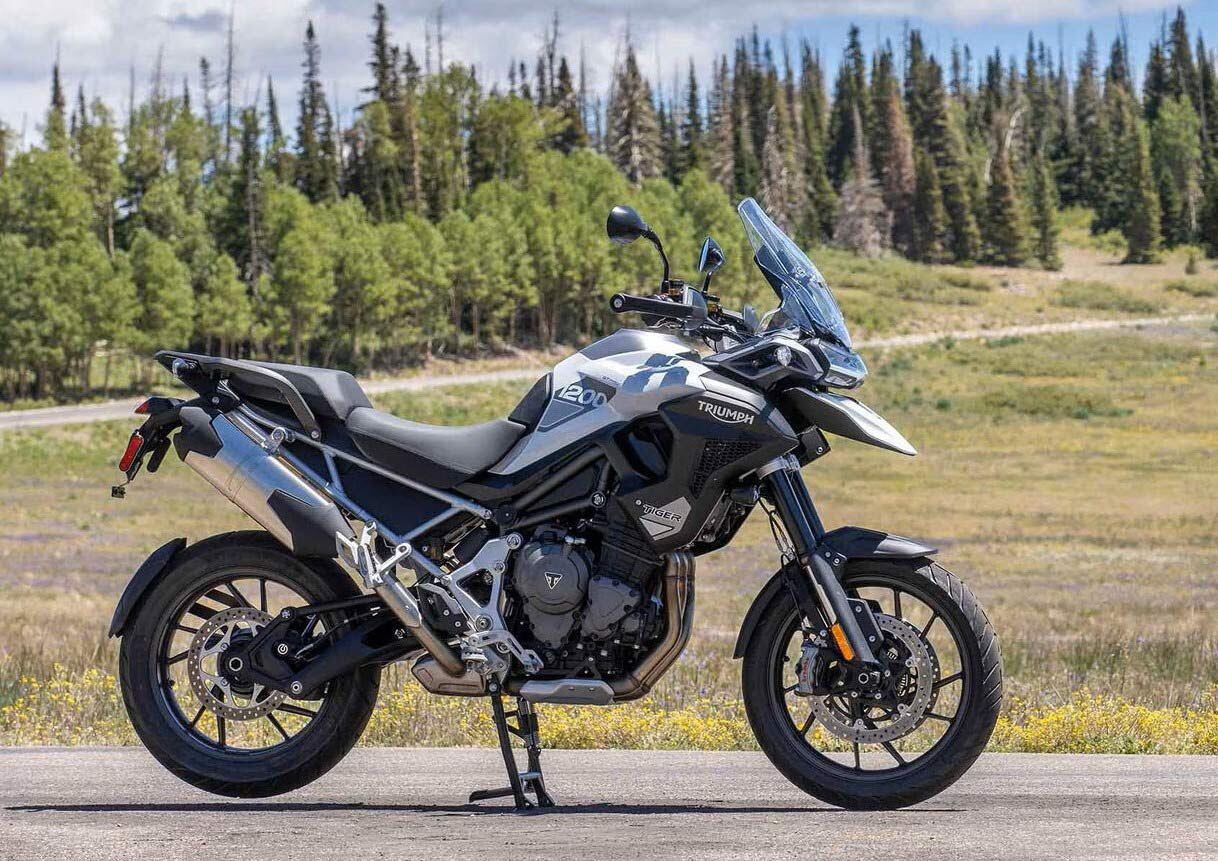
Triumph is rolling out a new seat-lowering suspension feature for its Tiger 1200 range: 2023 Triumph Tiger 1200 GT Pro pictured. (Jeff Allen/)When Harley introduced the industry’s first adaptive ride height feature on the Pan America 1250 Special in 2021, you knew the competition was watching for clues on how to develop its own seat-lowering tech. Sure enough — in a clear shot across H-D’s bow —-Triumph Motorcycles has released a similar seat-lowering feature to the Showa semi-active suspension found on its current Tiger 1200 series.
Called Active Preload Reduction, Triumph’s tech has been developed to lower resting seat height by reducing the rear suspension preload as the bike slows. The feature will go a long way toward making the Tiger 1200 GT, GT Pro, and GT Explorer models with their fairly tall 33.46 and 34.52 inch seat heights more accessible to shorter riders. The Tiger 1200 Rally Pro and Rally Explorer models sit even higher, at 34.44 and 35.23 inches.
The Active Preload Reduction lowers those seat heights by up to .78 of an inch when the bike comes to a standstill, depending on the combined weight of the rider, passenger, and luggage, according to Triumph. That’s not a massive reduction, but the company says that if you fit the aforementioned bikes with accessory low seats (an extra-cost option), you can go an additional .78 of inch lower, for a lowest setting of less than 32 inches on the GT family and under 33 inches on the Rally bikes.
Related: 2022 Triumph Tiger 1200 First Ride
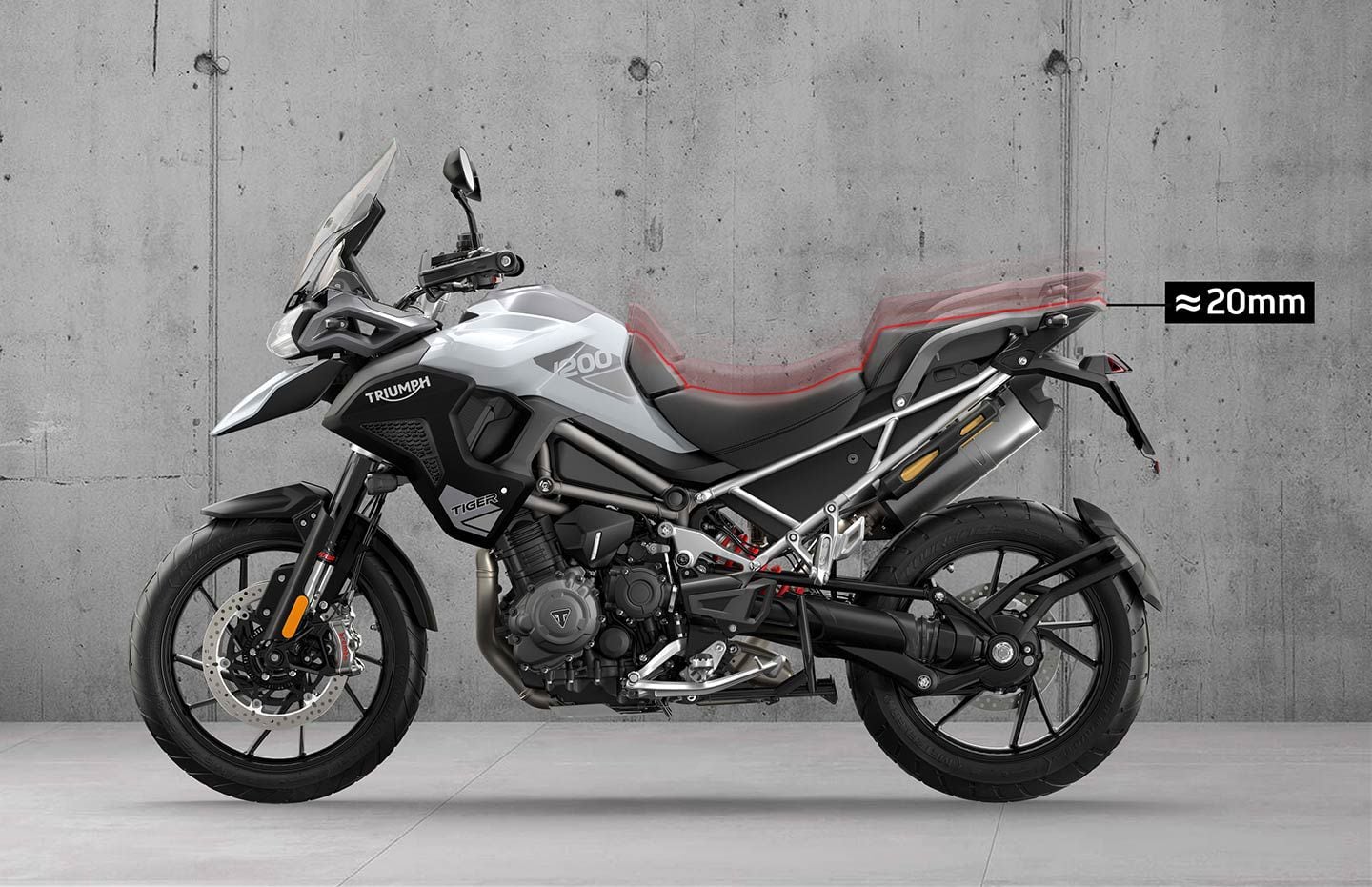
The company says the new system will lower seat height by .78 inches (20mm) as the bike comes to a standstill. (Triumph/)As with the Pan America, Triumph utilizes Showa suspension components on its Tiger 1200s, but to Triumph’s credit, the system isn’t a $1200 option like it is on the Special; the preload reduction feature will be standard on all new Tiger 1200 motorcycles, and can be accessed by pressing the ‘Home’ button on the right switch cube for one second. (Triumph didn’t specify whether stock suspension settings automatically re-engage as the bike accelerates and whether there are additional settings). For existing 2023 Tiger 1200 owners, the feature can be added via a software update done at an authorized Triumph dealership, with no upgrade fee for those customers (though standard dealership labor rates will apply).
Related: Carmichael and Cervantes Testing Triumph Prototypes
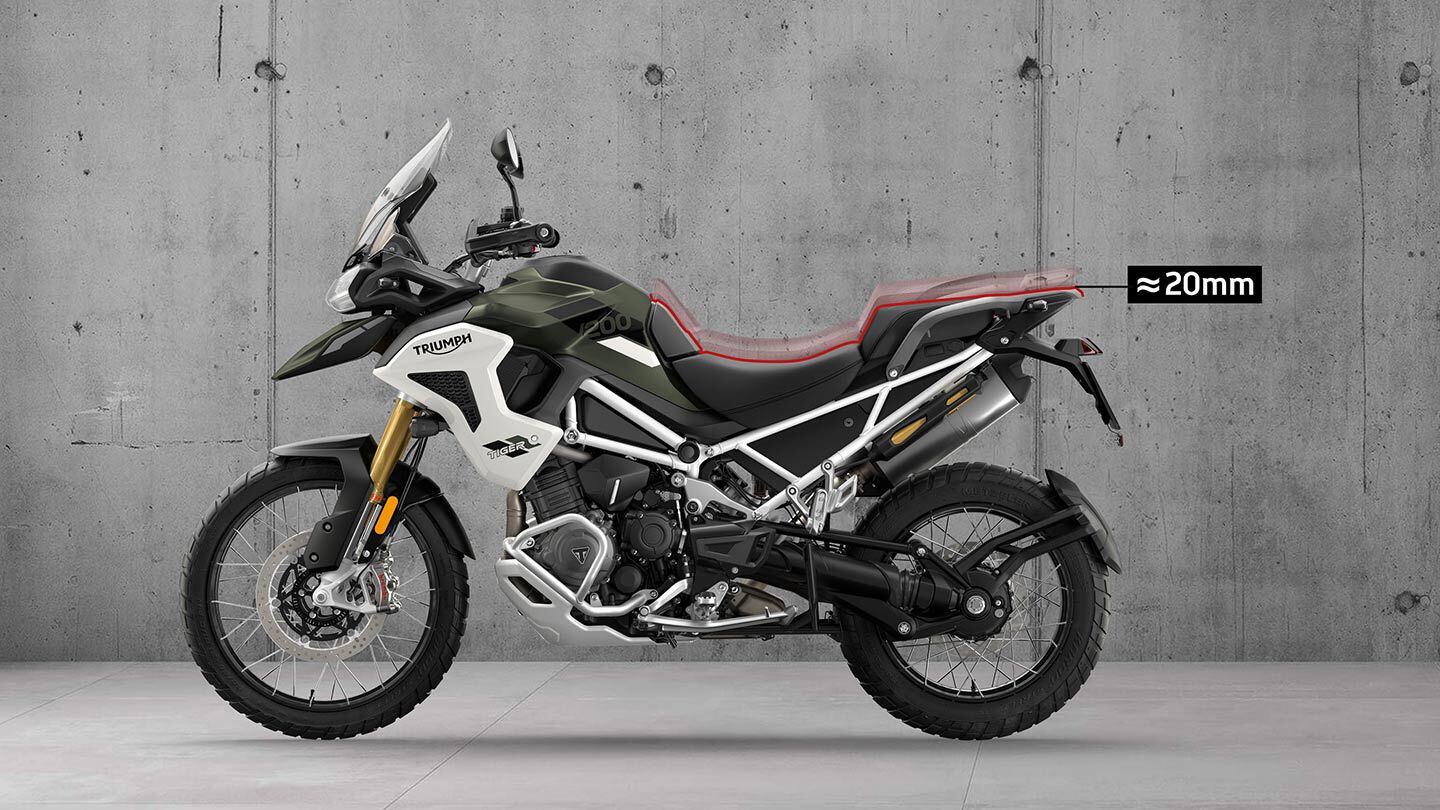
The new Tiger 1200 Rally Pro also receives the suspension feature as standard equipment. (Triumph/)As Chief Product Officer Steve Sargent added, “The new [Tiger 1200] feature can be enabled on the fly, lowering the center of gravity at slower speeds, making it even more accessible, offering riders more confidence at slow speeds and better contact with the ground as they come to a stop.”
Vertically challenged riders, rejoice.
-
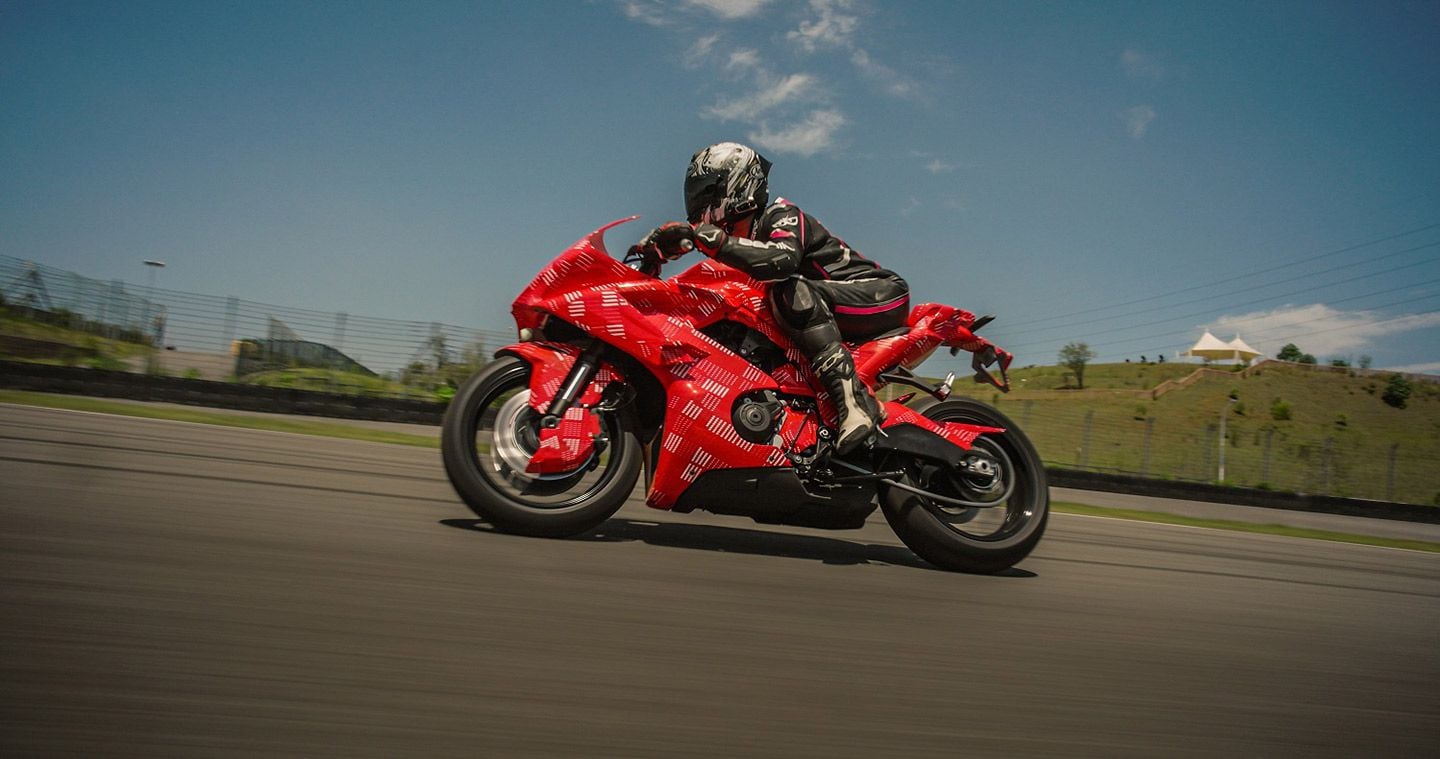
CFMoto revealed its new 675SR to fans of the brand at the Zhuzhou International Circuit in China recently. The bike is powered by a new 675cc triple. (CFMoto/)Not long ago, the idea of a Chinese-made motorcycle that could compete head-on with the Japanese and European rivals seemed somewhere between a distant prospect and an outright joke. But the Chinese motorcycle industry has developed at a breakneck pace and now CFMoto is on the verge of launching a pair of sportbikes that look set to raise our expectations once again.
The two bikes were unveiled in prototype form at the CFMoto Day at the 2.3-mile Zhuzhou International Circuit, where they lapped in front of an audience of CFMoto fans. Both bikes were shrink-wrapped in colored plastic to hide their styling details, but even so it’s clear they follow the same family resemblance as the 450SS, with similar frontal features and lights. Both have winglets that curve down to form tunnels against the side panels (a little like the Honda CBR1000RR-R), as well as MotoGP-style cowls around the front brake discs to draw cooling air toward the calipers. While elements like the mirrors were removed to make it easier to wrap the bikes, their mounting points can be seen under the plastic, hinting that these prototypes are nearly production-ready.
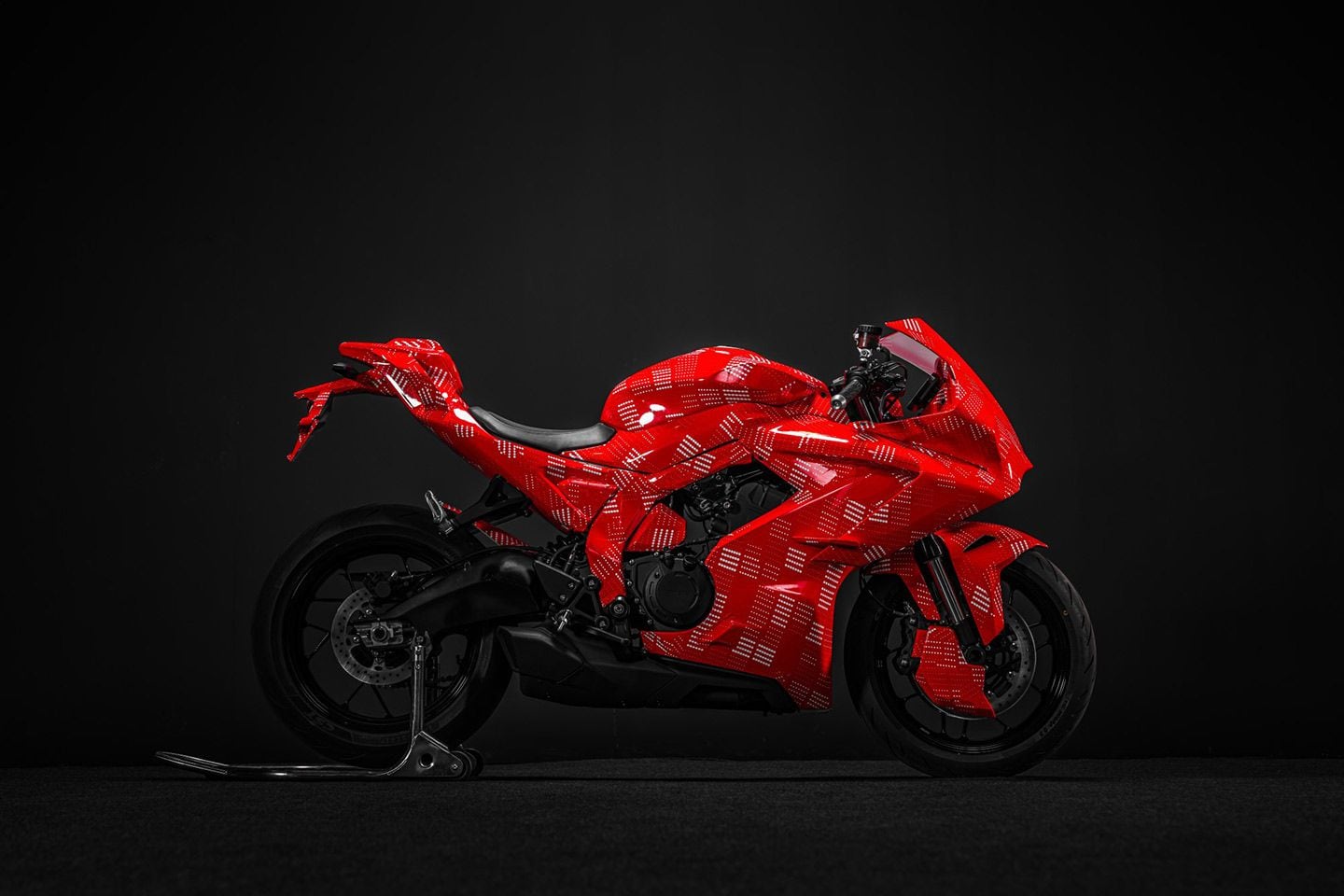
The 675SR has been disguised to hide its final styling (CFMoto/)The 675SR is a three-cylinder supersport machine using the inline-triple engine that we first revealed back in March. Patents for the engine show it’s closely related to the 450cc twin used in the 450SS (which is sold as the 450SR outside the US, matching the “SR” designation of the new 675) with an extra cylinder to bring it to 675cc. That’s a favored capacity for triples, largely due to old racing regulations that let 675cc three-cylinder bikes compete against 600cc fours but also because it hits a sweet spot between size and performance. Assuming the same bore and stroke as the 450SR is used—72mm x 55.1mm—its actual capacity will be 673cc, and the bore/stroke ratio will be slightly less oversquare than the old Triumph Daytona 675 and MV Agusta F3.
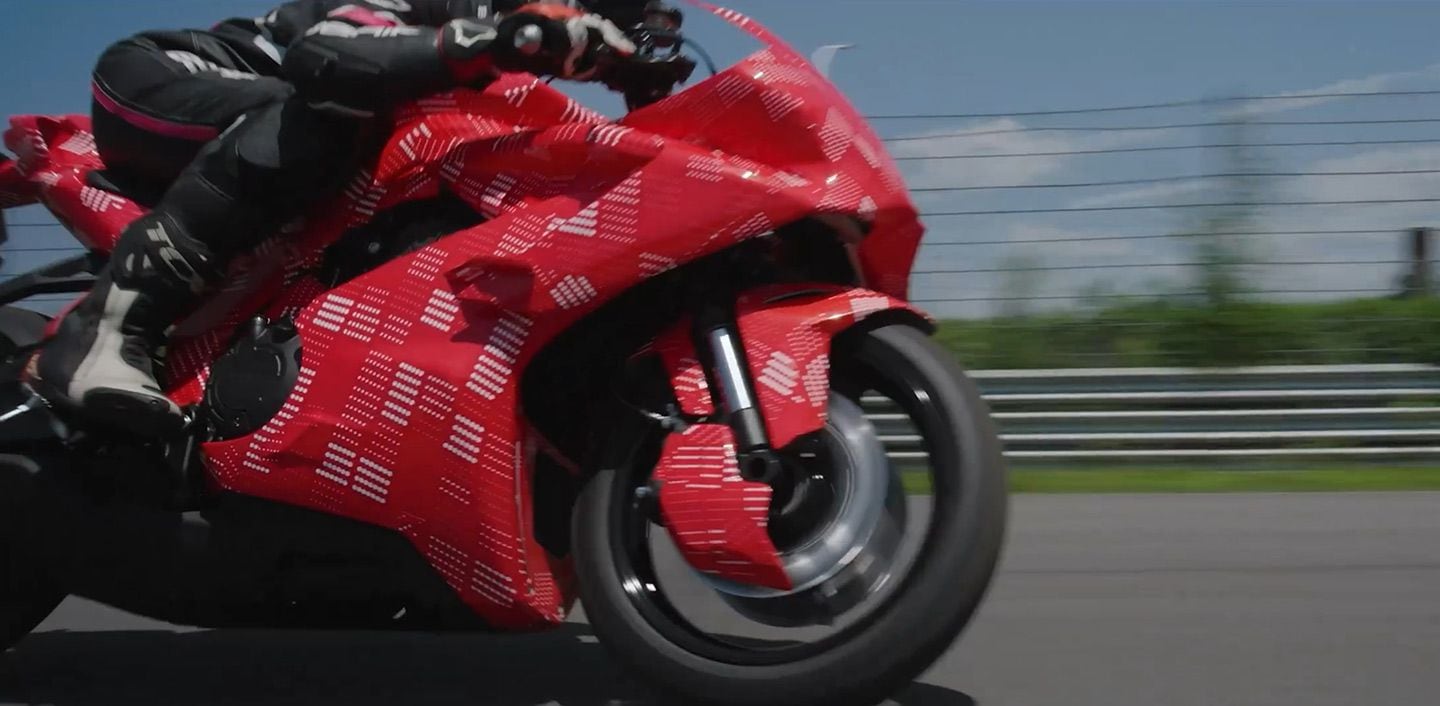
MotoGP-style brake ducts are used to cool the braking components. Whether these will make it to production remains to be seen. (CFMoto/)In terms of specs, CFMoto is only saying that it makes more than 100 hp (well, actually the global press information says “over 100 hp per cylinder” but since that would be 300-plus horsepower, we’ll go with “over 100 hp” for the engine), and more than 100 Nm of torque per liter. That works out to more that 50 lb.-ft. from a 675cc engine, very close to the output of the MV Agusta F3 675, which made 52 lb.-ft., and the Daytona 675, which managed 53 lb.-ft. That suggests if CFMoto can make its engine rev as high as those other triples, it will achieve a similar power output of around 125 hp.
It looks like the 675SR has an aluminum-alloy swingarm—a conventional, dual-sided design—but the plastic cladding means we can’t see if it also has an aluminum frame or a tubular steel design. As expected, the visible parts of the engine, like the clutch and generator covers, look much the same as those of the 450SS and 450NK. When it comes to components, CFMoto only says that it has “first-class features when it comes to brakes, chassis, equipment, design, and all aspects needed for a thrilling ride on the road and a sharp tool for the track.”
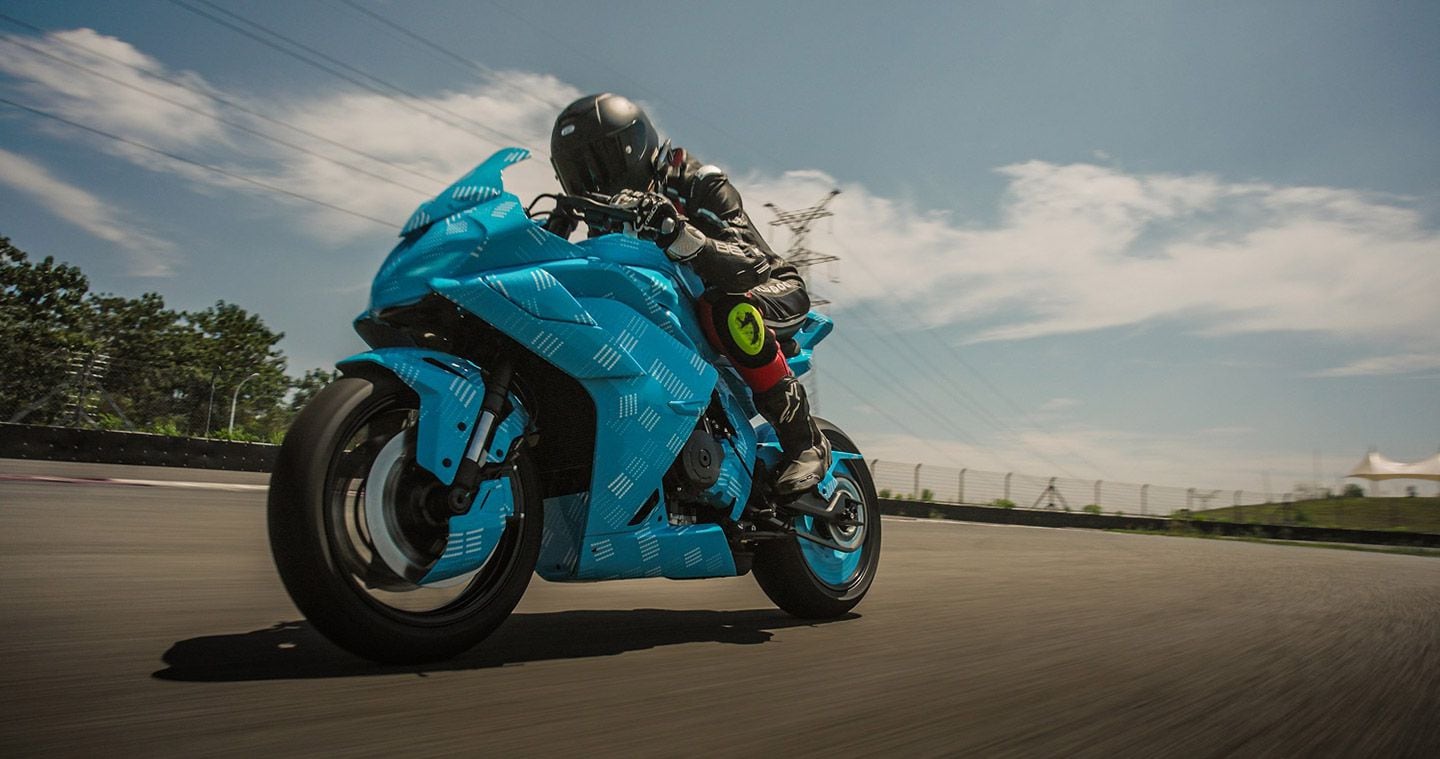
The CFMoto 500SR looks to take aim at the middleweight supersport category with its 500cc inline-four engine said to have a top speed in excess of 143 mph. (CFMoto/)The 500SR might have a smaller-capacity engine, and be a less powerful bike, but it’s even more intriguing from a technical perspective as it uses a four-cylinder engine—making it a rival to the Kawasaki Ninja ZX-4RR, but with a 100cc-capacity advantage. CFMoto hasn’t given a power figure, but says the top speed is in excess of 143 mph. The company says the engine was developed in secret three years ago, using “forged aluminum pistons, stretch-bolt connecting rods, and a low-inertia crankshaft.” It also features ram air to improve its power output at higher speeds.
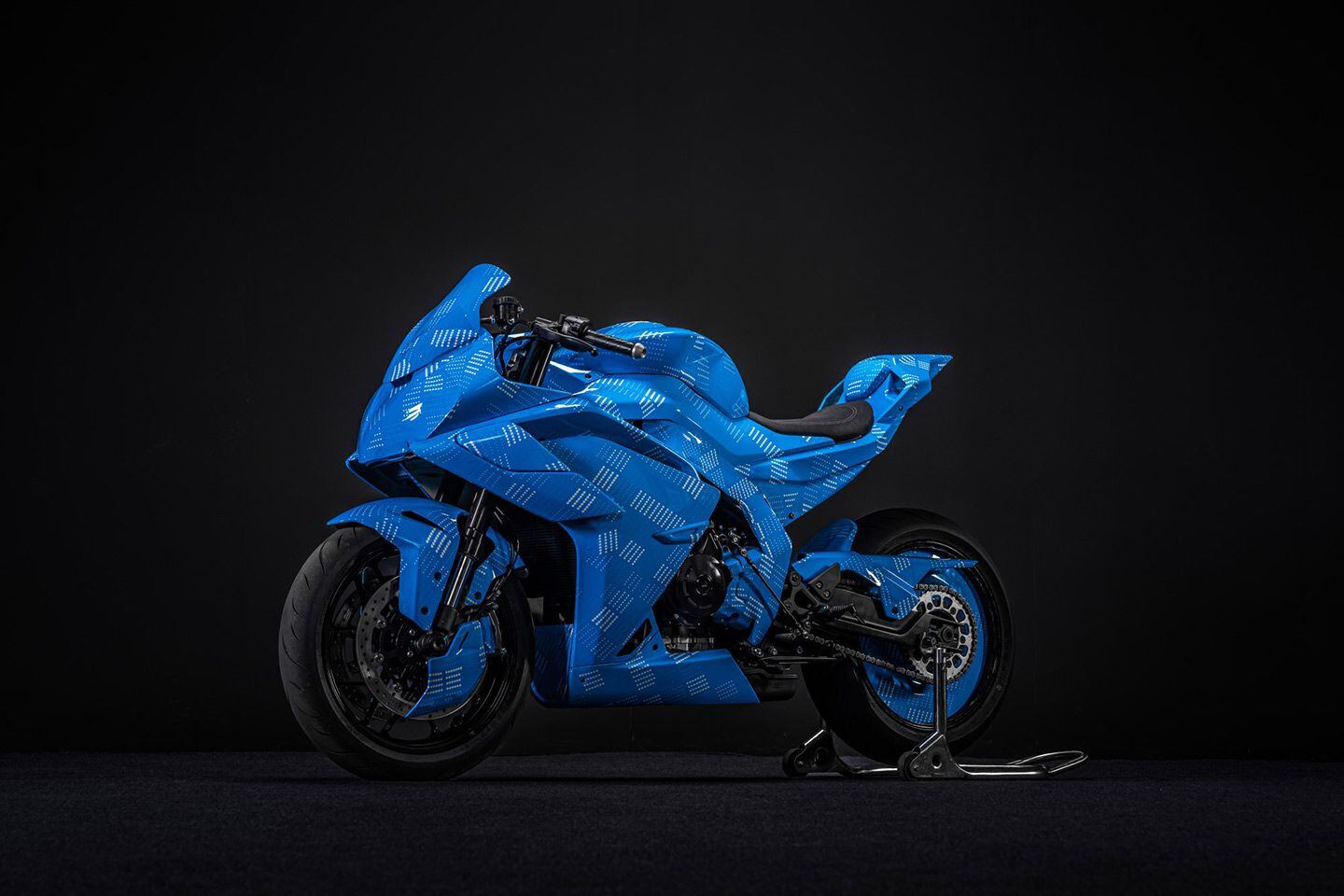
The cloaked 500SR has very modern aerodynamic elements on the side panels and brake discs. (CFMoto/)Video of the bike on track confirms exactly the sort of high-revving sound you’d expect from that capacity and layout, but as with the 675SR the plastic disguise means we can’t see details of the chassis beyond the upside-down fork and aluminum swingarm. Like the 675SR it has dual front discs, largely hidden behind air intakes, and styling akin to the 450SS.
Although there’s no official statement about CFMoto’s plans for these new bikes, the fact that the information has been released in English on the company’s global website is a strong hint that they’re not going to be limited to the Chinese market. CFMoto also confirmed its long-term intention is to compete at the top level of MotoGP competition, having already entered the Moto3 series with the PruestelGP team. The company has set up a “CFMoto Talent Trophy” series to help develop Chinese riders, and is known to be developing a 1,000cc V-4 superbike as well as a GP machine with a similar configuration.
-
 1
1
-
-
Team Red's newest middleweight adventure bike (and engine) is finally coming to the US.
-
The photo shows the newest GS artfully splashing through some water so we can't quite see it clearly.
-

Kevin Cameron has been writing about motorcycles for nearly 50 years, first for <em>Cycle magazine</em> and, since 1992, for <em>Cycle World</em>. (Robert Martin/)I have heard skeptical motorists say, “I never buy a new model in its first year of production.” This is just a specialized way of saying, “No plan survives contact with the enemy.”
The “plan” is the new model—a gamble that preproduction testing will discover any significant design or manufacturing problems before buyers roll out of showrooms on the new product. The “enemy” is the conditions encountered in use.
Wright Aeronautical first ran its 18-cylinder R-3350 prototype aircraft engine in late 1936, but some 3,000 engineering changes were required to push it through the standard 150-hour Type Test to qualify it for flight. It was chosen to power the B-29 bomber of World War II.
At the beginning of the R-3350 program Wright had every reason to be confident, as it was having a long run of success in developing the single-row nine-cylinder R-1820 (which later powered sky-darkening numbers of B-17s). Its power increased rapidly, it cooled acceptably, and it displayed good reliability. Further, Wright had on December 1, 1935, begun development of the 14-cylinder two-row R-2600, whose progress was equally rapid and uneventful.
Having thus proven the all-important cylinder-and-head units on these two designs, and showing it could rapidly scale a single-row nine into a two-row 14, the 18-cylinder version’s success seemed assured. Yet it suffered one fundamental trouble after another—overheating, backfiring, catching fire internally, suffering unreliability from vibration, and digesting its propeller reduction gearing. These problems delayed production by at least nine months, despite the highest of program priorities. When WWII ended, the troubled wartime design was quietly terminated. In its place came an all-new design, sharing nothing with the B-29′s engine but its bore and stroke, number and arrangement of cylinders, and the designation R-3350.
While third-party testing of the wartime 3350 revealed that its claimed 2,200 takeoff horsepower was actually more like 2,050, the redesigned postwar engines went on to achieve 3,400–3,700 takeoff horsepower and set records for cruising fuel economy, permitting for the first time direct flights from NYC to London or Paris. The postwar engine, incorporating what had been learned from the wartime engine’s failures and shortcomings, achieved design maturity.
When Honda’s long-serving Superbike, the V-4 RC30 (World Superbike championships in 1988 and 1989), had been developed as far as was practicable, it was replaced in 1994 (some say years too late) by the RC45, which won its single World Superbike championship three years later, in the hands of John Kocinski. Both bikes were “homologation specials,” which means they were designed and produced for the sole purpose of homologating them as eligible for a production-based racing class. Only 3,000 RC30s were produced, and 578 RC45s.
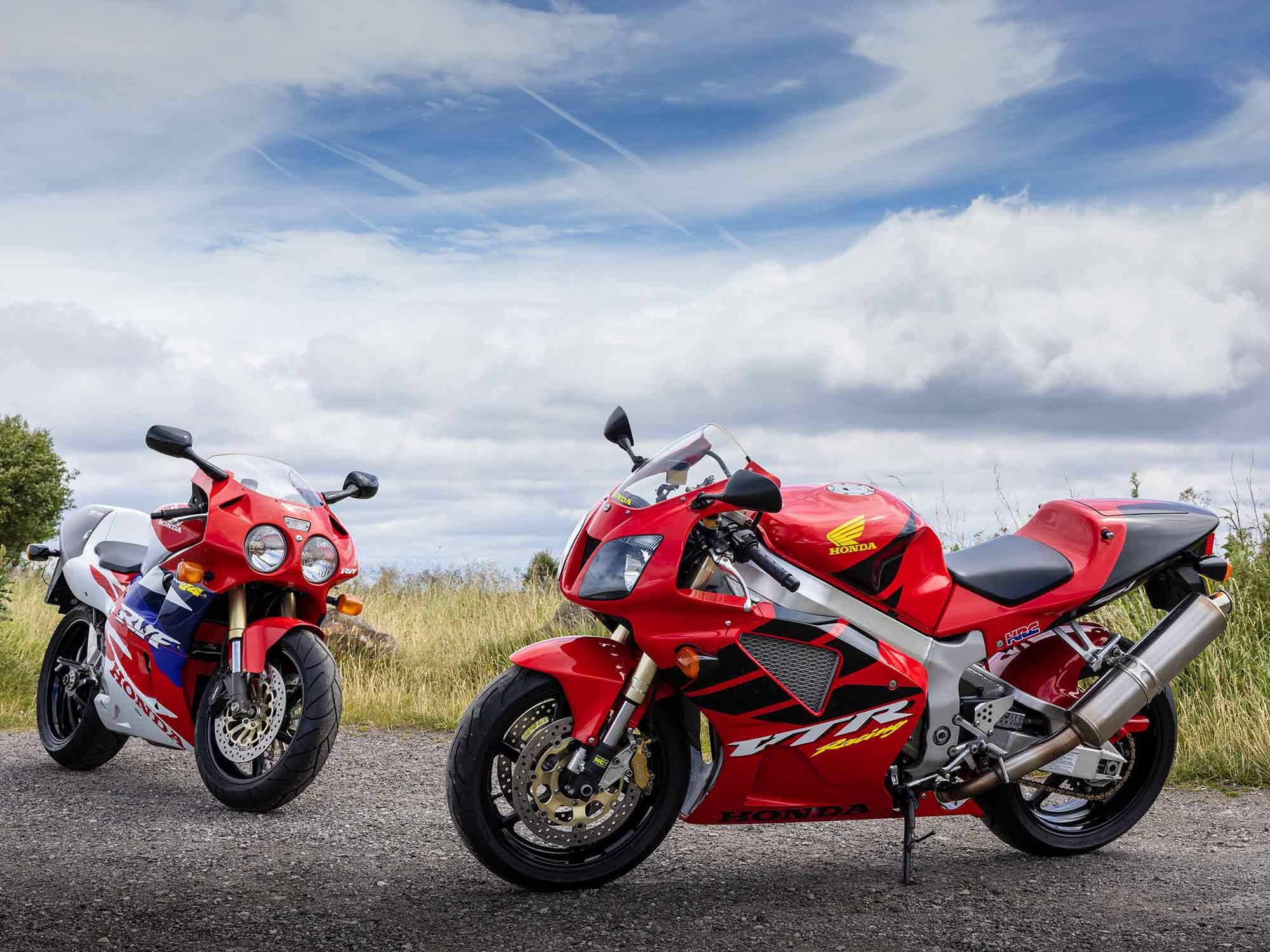
Honda’s RC45 on the left and RC51 on the right. ( Phil Steinhardt/)RC45 came into being with a strange fuel-injection system controlled by a number of tiny switches—a system that had to be replaced by a much more sophisticated digital controller delivering fuel through (then) new multi-hole injectors. Its chassis began life with the RC30′s “vague” and very stiff front end, but was toward the end given the “engineered flex” treatment that would later transform Honda’s V-twin RC51 Superbike. Inheriting RC30′s marginal original oiling system (con-rod big-end bearing shells showing ominous dark streaks but never actually becoming a disaster) in its final year, the RC45′s crankshaft was switched to end-feed. The dark streaks disappeared and oil pressure could be safely reduced to 12 psi. In 2020 the new Fireblade 1,000cc inline-four’s engine (again, a homologation special for use in World Superbike) was given end-feed oiling at both crank ends. Further, the final RC45 gained about 4 hp by operating its crankcase at low pressure to enable use of low-pressure oil scraper rings.
The RC45 program, despite producing only a single world championship, proved a body of technology whose value extended far beyond its 585 produced examples—and it had achieved design maturity.
-
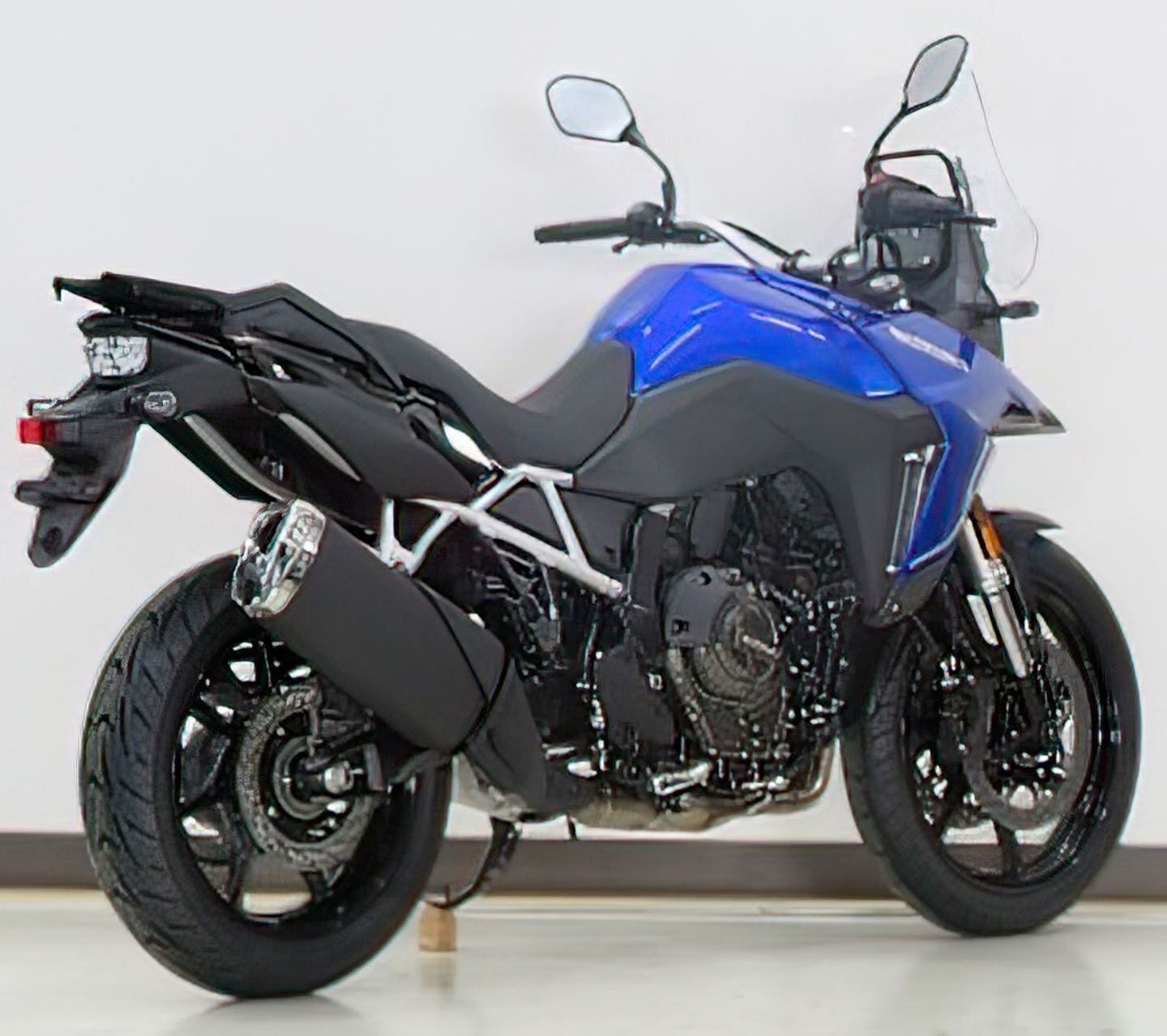
The new V-Strom 800 will have street-oriented tires, suspension, and brakes. (Suzuki/)Back in July we were able to confirm that Suzuki is bringing a less expensive, street-biased version of the V-Strom 800 to its 2024 lineup after US emissions filings and European type-approval information were published. Now similar approvals have been filed in Australia—but with images of the bike.
The original images are extremely low-resolution but they confirm all the details we’d expect from a base V-Strom 800 model, including the use of cast-alloy wheels instead of spoked, with a 19-inch front rather than the V-Strom 800DE’s 21-incher, along with a simpler spec that removes some of the off-road features of the DE.
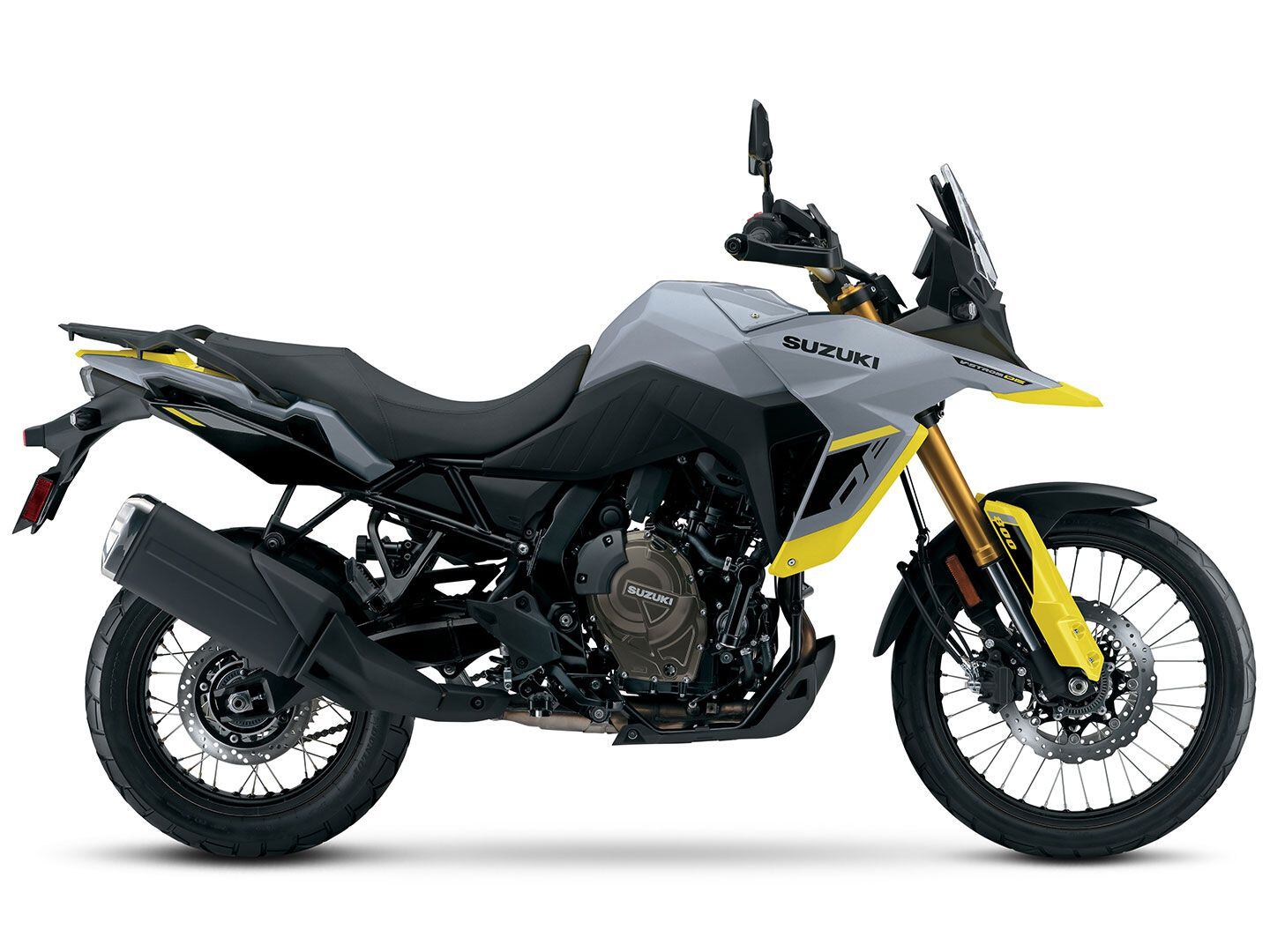
Suzuki’s V-Strom 800DE is the more off-road-oriented version of the 800 lineup. (Suzuki/)As expected, the bike has a new fork, losing the gold finish of the DE in favor of a more subdued silver, and they appear to have less travel, contributing to a small decrease in wheelbase from 61.8 inches to 59.6 inches. What the original type approvals didn’t show, though, was that the V-Strom 800 also gets dual, radial-mount, four-piston front brake calipers in place of the DE’s axial-mount design. There’s also a new front fender to suit the 110/80-19 tire, and the V-Strom 800 has a touring windshield that accounts for an overall height that’s 2.5 inches taller than the V-Strom 800DE, despite the smaller front wheel.
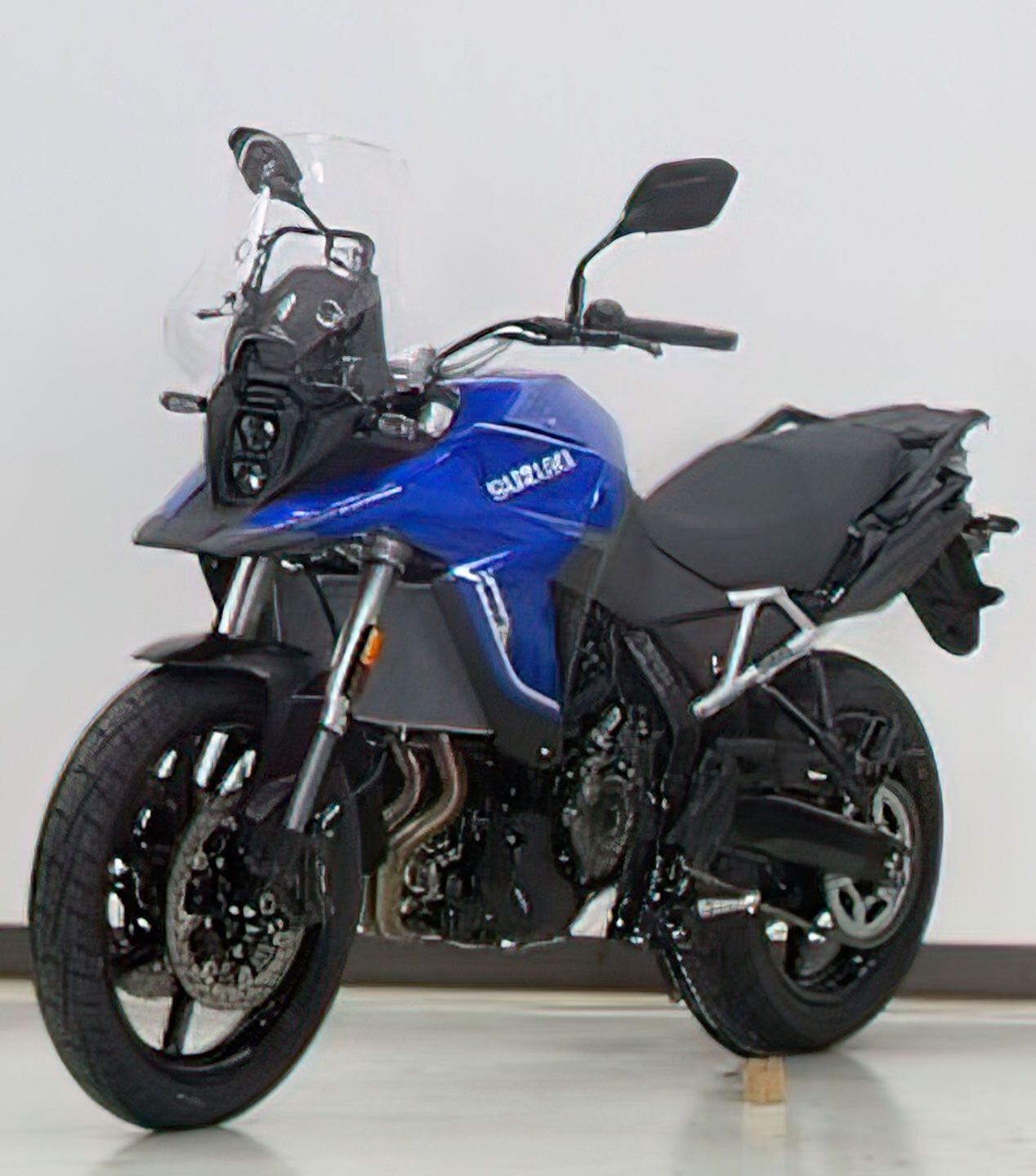
The V-Strom 800 gets radial-mount brake calipers and a 19-inch front wheel/tire combo. (Suzuki/)There’s no change to the engine spec, with 83 hp at 8,500 rpm and 57.5 lb.-ft. of torque at 6,800 rpm from the 776cc parallel twin. However, the V-Strom 800 is 15.5 pounds lighter than the DE, some of which is due to the smaller front wheel, but other parts have also been removed. The hand guards, for instance, are gone, as is the under-engine protection and the steel frame that it attaches to. If you’re only riding on the street, the stickier tires, steeper rake, and reduced weight could make the base V-Strom 800 more fun than the 800DE, even though it’s sure to be the cheaper machine.
It’s a fraction faster, too, with a rated top speed of 119.3 mph, up from 118 mph, probably thanks to slightly better aerodynamics.
We’ve enhanced the images to get a better look at the bike and it’s clear that most of the main elements of the V-Strom 800DE, including the TFT instruments, are carried over to the base model. Its entry-level status is reflected in the simple, single-color paintwork and lack of graphics. We’ll have to wait a little longer to find out precisely how much less expensive the base V-Strom 800 is, but the approval documents filed with CARB and the EPA leave no doubt it’s heading for the US market in 2024 where we’d expect it to undercut the DE’s $11,349 MSRP by several hundred dollars. For an indication, the larger V-Strom 1050 is 5.5 percent less expensive than the V-Strom 1050DE. A similar percentage reduction on the V-Strom 800DE would give the V-Strom 800 a tag of about $10,700.
-
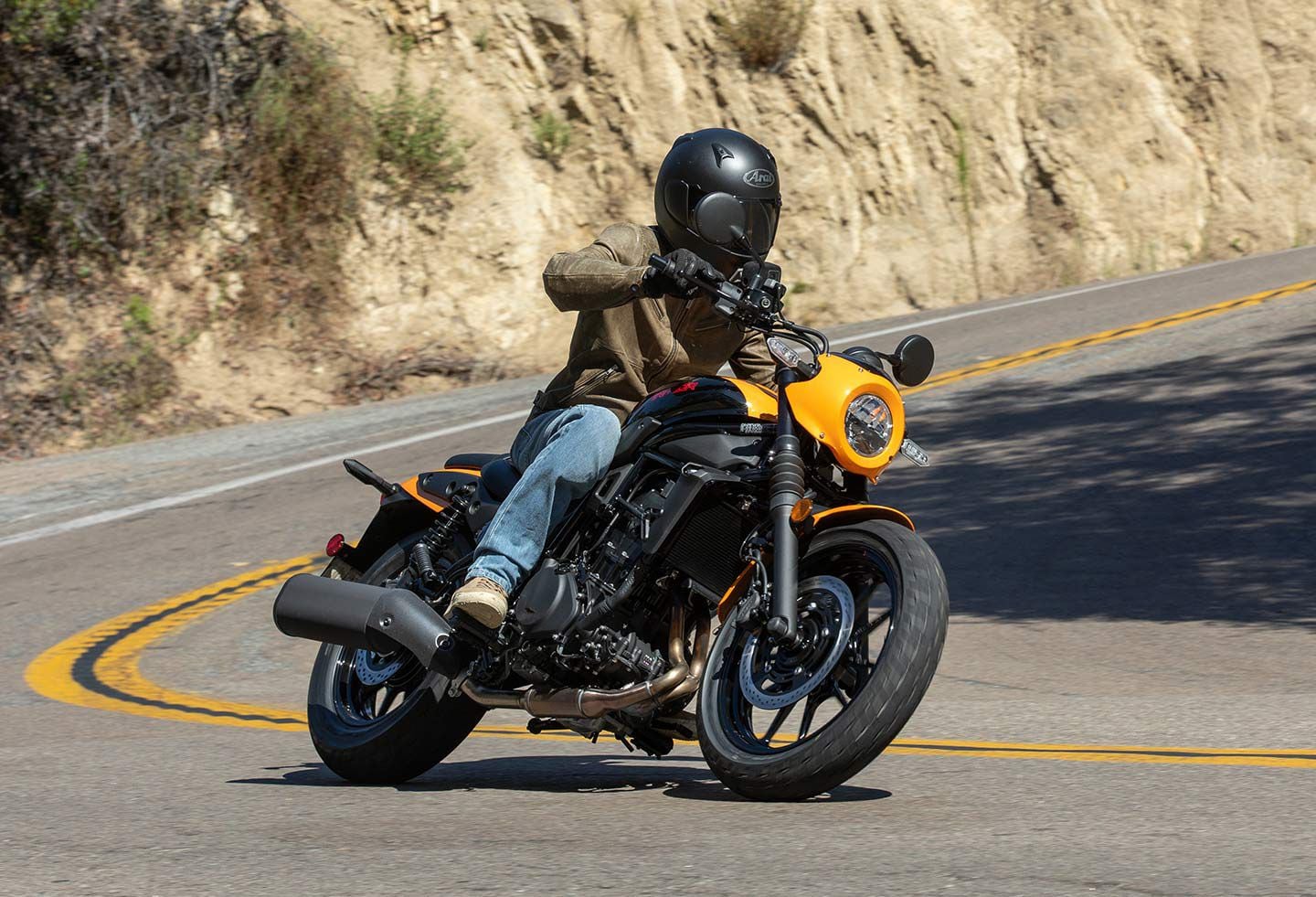
Kawasaki’s all-new Eliminator is just as comfortable on twisty backroads as it is in city traffic. (Kevin Wing/)Market research shows that many motorcycle sales are won and lost on the dealership floor. New and beginning riders value two things more than any other: engine size and seat height. Kawasaki found that entry-level riders prefer 500cc and below. Understanding that research and realizing a gap in its model lineup below the Vulcan S, Kawasaki reintroduced the Eliminator badge as a lightweight cruiser.
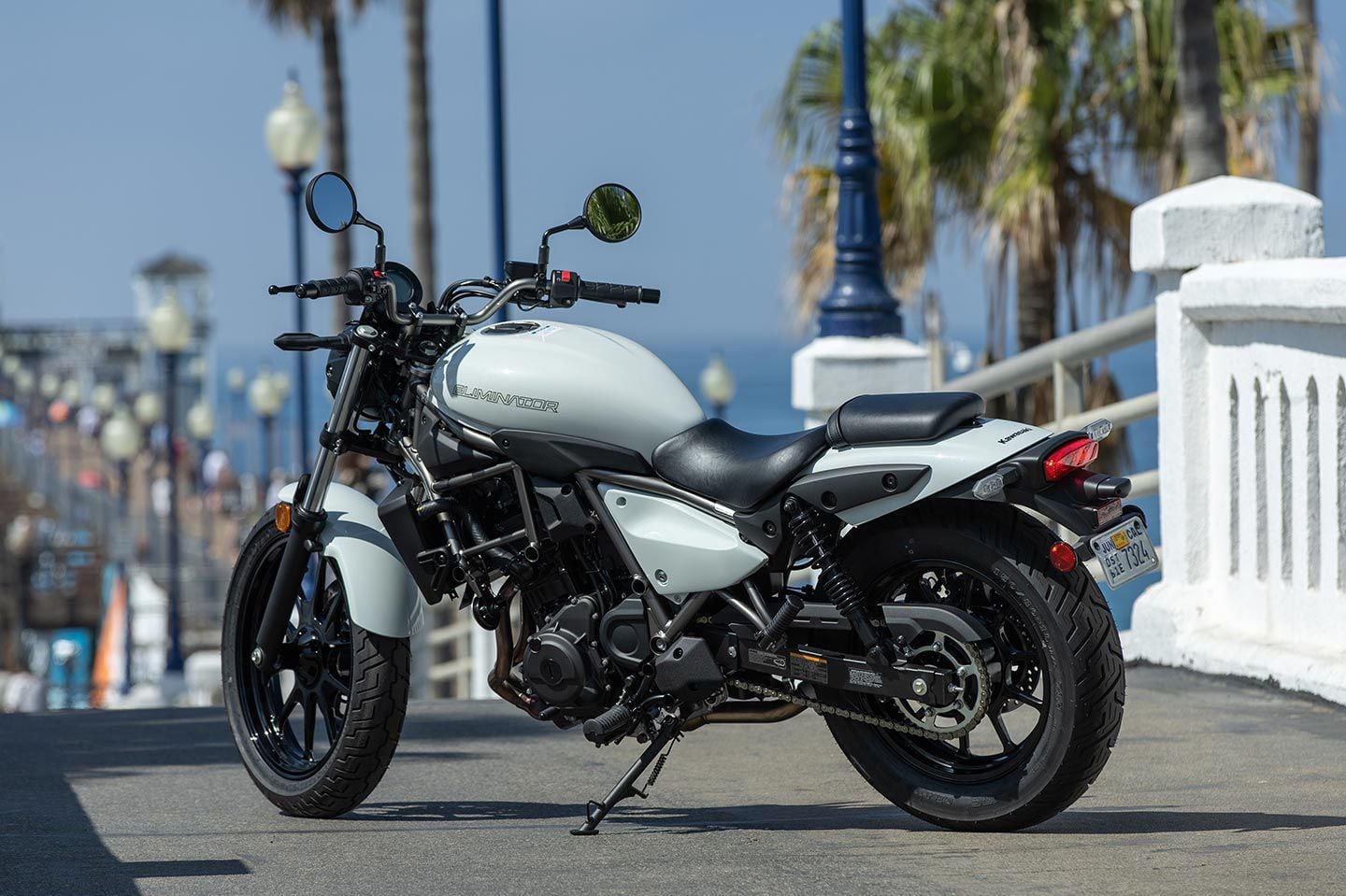
The 2024 Kawasaki Eliminator in Pearl Robotic White. (Kevin Wing/)Kawasaki’s 2024 Eliminator can be described as a mix between a standard and a cruiser. Derived from the Ninja 400 and Z400 streetbikes, the new Eliminator utilizes the same engine, but with a larger displacement of 451cc. The parallel-twin engine found in the Eliminator has the same bore (70.0mm) as its sporty siblings, but with a 6.8mm larger stroke (58.6mm) for increased low-end torque. Its steel trellis frame is inspired by the Ninja 400 platform but has revisions to achieve a 28.9-inch seat height and a 59.8-inch wheelbase, giving the Eliminator its cruiser stance.
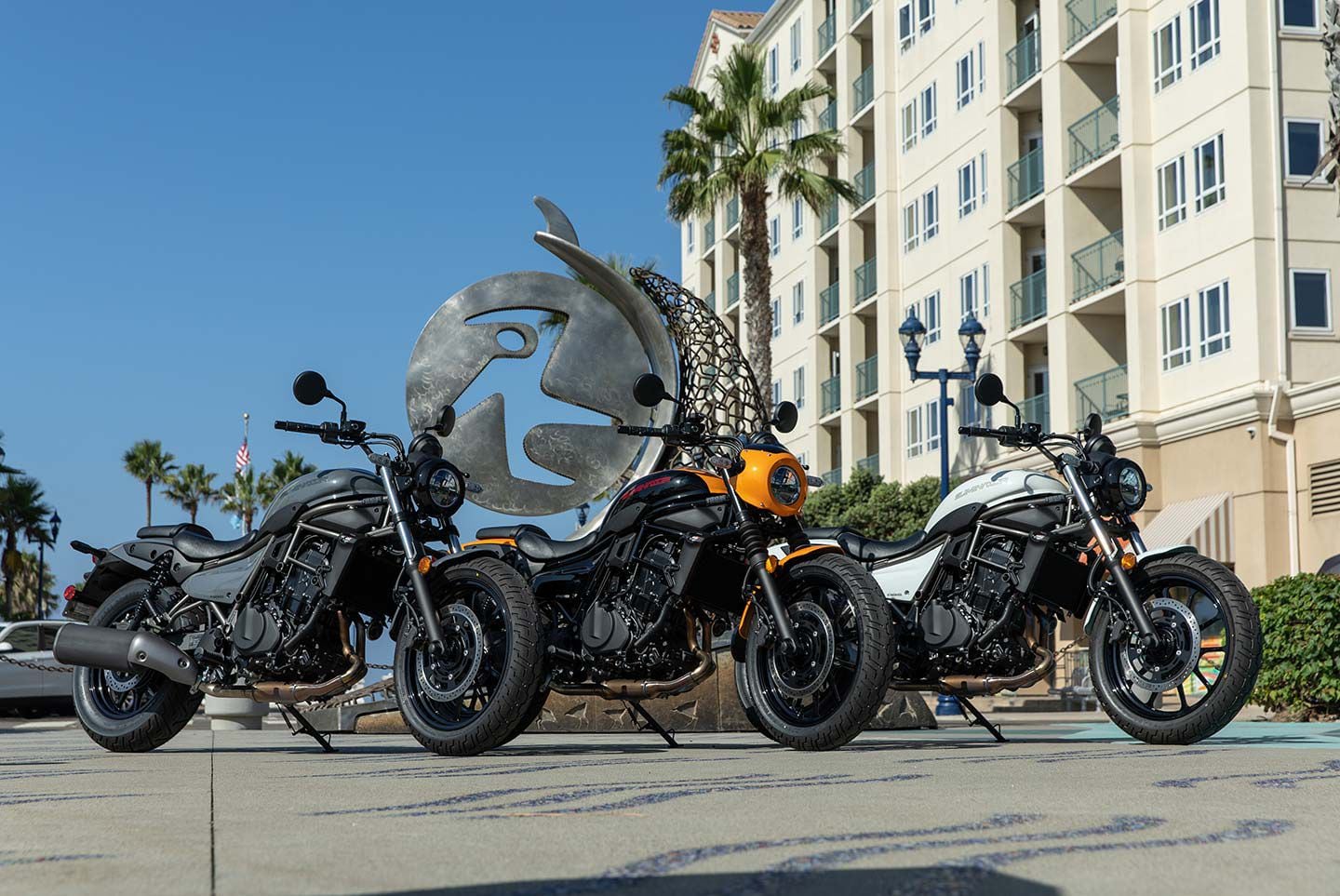
The 2024 Kawasaki Eliminator lineup. (Kevin Wing/)When the Kawasaki Eliminator was originally introduced in 1985, it was a large-displacement power cruiser—a drag bike. Now, the Eliminator name returns as an entry-level, “easy rider” cruiser.
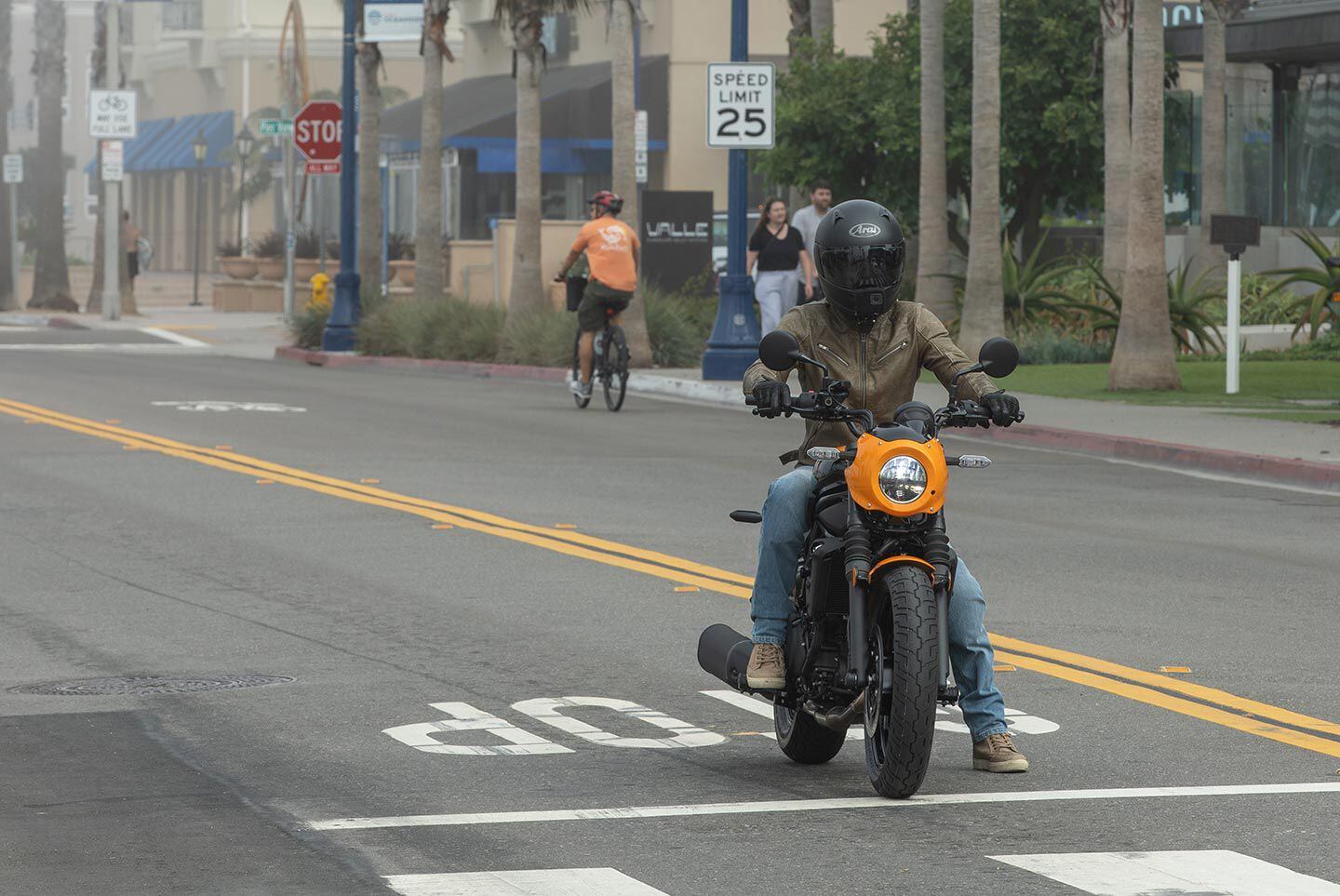
At 28.9 inches, the Eliminator has a lower seat height than the Z125 Pro (31.7-inch seat height). (Kevin Wing/)“Just Ride.” That’s Kawasaki’s motto with the 2024 Eliminator. Designed with beginner-friendly features such as a manageable engine, low seat height, agile chassis, and a neutral rider triangle, the Eliminator is aimed to be one of the easiest riding motorcycles on the market. Although labeled as “new rider friendly,” it has enough charm to please experienced riders as well.
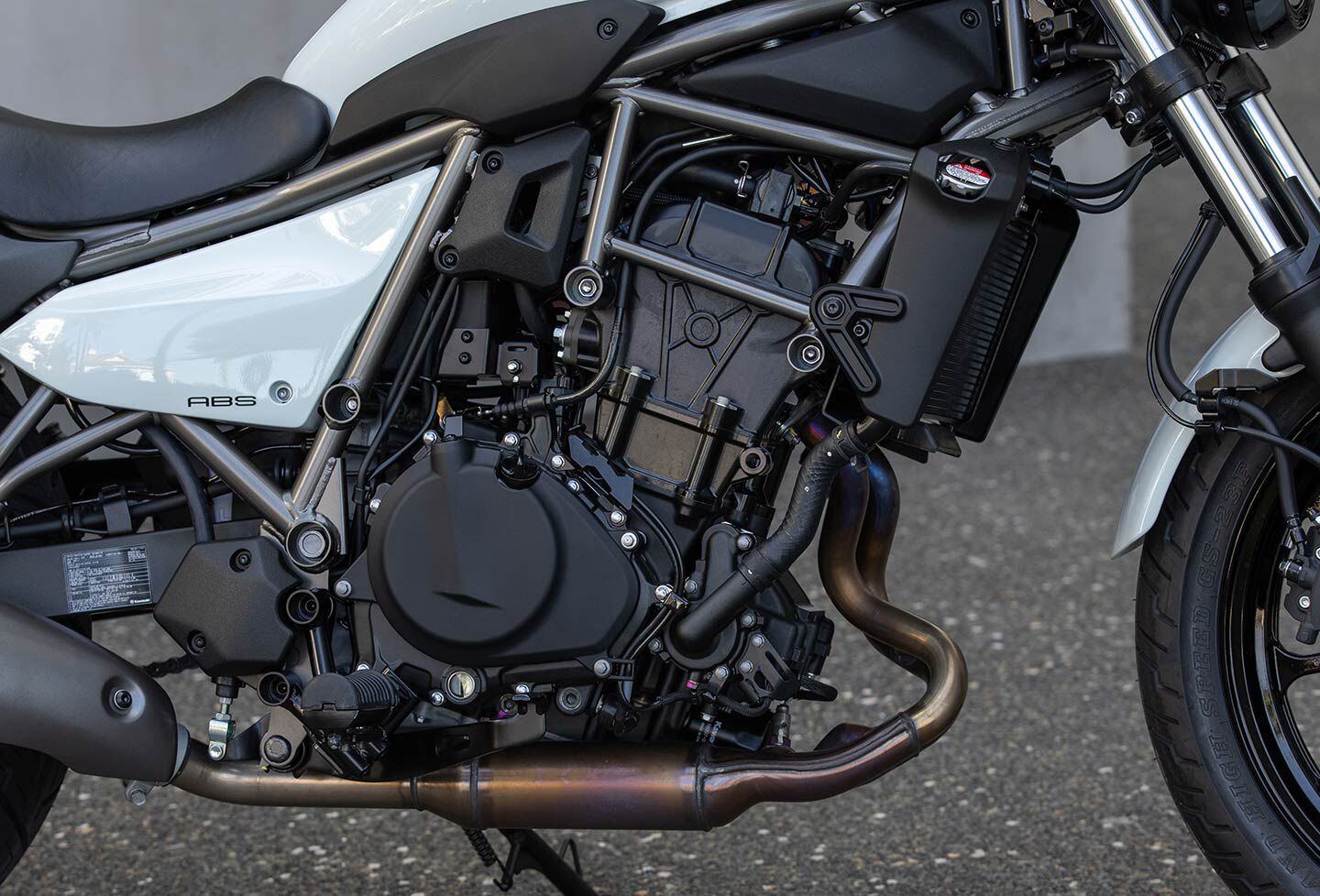
The Eliminator’s 451cc parallel twin is derived from the Ninja 400 and Z400. To achieve a larger displacement over its cousins, the Eliminator received a larger stroke of 58.6mm. (Kevin Wing/)The 451cc parallel twin utilizes a downdraft intake in a space under the seat to improve cylinder-filling efficiency. Intake funnels on the 5.8L airbox have different heights to tune out torque valleys throughout the rpm range for smooth engine response. A lightweight flywheel enables the engine to rev quickly and the exhaust system is designed for low- to midrange power.
The Eliminator’s six-speed transmission has close gear ratios for optimized power delivery with a final gear ratio of 43/14. Further adding to the Eliminator’s ease of use is an assist and slipper clutch which provides a superlight lever pull and prevents the rear tire from hopping during excessive engine-braking.
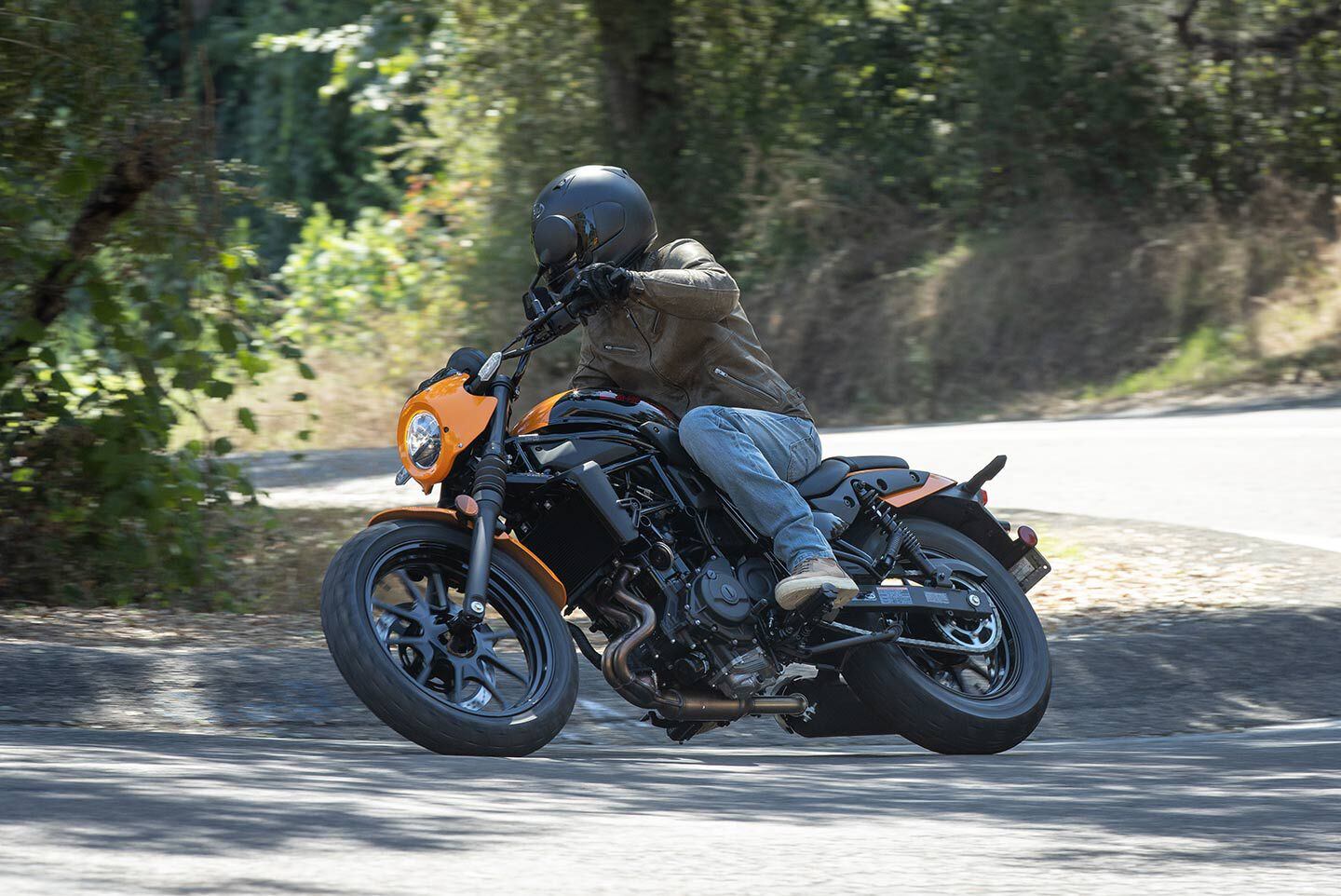
The 41mm fork and dual shocks provided a great balance of performance and comfort. (Kevin Wing/)In an effort to reduce weight, Kawasaki utilizes the engine as a stressed member. The square-tube-construction swingarm mounts to a die-cast aluminum plate that is bolted to the back of the motor. A nonadjustable 41mm telescopic fork offers 4.7 inches of travel while twin shocks with preload adjustment provide 3.1 inches of travel in the rear. The braking system utilizes a 310mm disc with a dual-piston caliper up front and a 220mm disc and single-piston caliper slows the rear. The 2024 Kawasaki Eliminator is available without ABS for $6,649, with ABS for $6,949, and the upscale SE model is only available with ABS for $7,249.
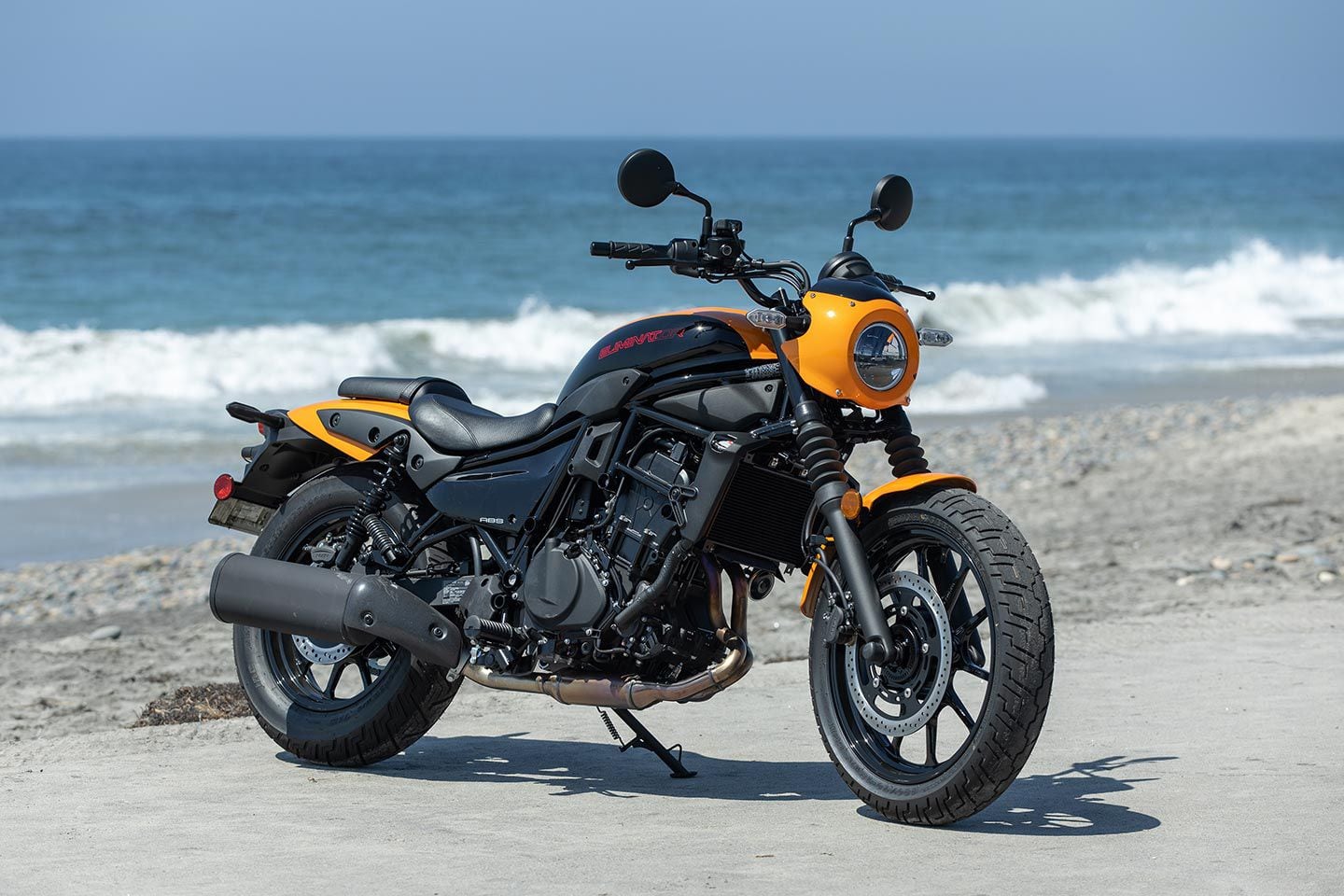
The Kawasaki Eliminator SE ABS in Candy Steel Furnace Orange/Ebony ($7,249). (Kevin Wing/)Emphasizing the Eliminator’s cruiser looks is a stretched gas tank with a fuel capacity of 3.4 gallons and a pair of 10-spoke wheels. Where the rubber meets the road, the Eliminator features an 18-inch front and 16-inch rear wheel sizes wrapped in IRC Grand High Speed GS-23F tires. Maintaining a strong balance between form and function, the Eliminator features full LED lighting, a digital instrument panel with a gear position indicator, and has Bluetooth connectivity through the Kawasaki Rideology app which allows riders to check vehicle information, record their routes via GPS, and receive phone notifications.
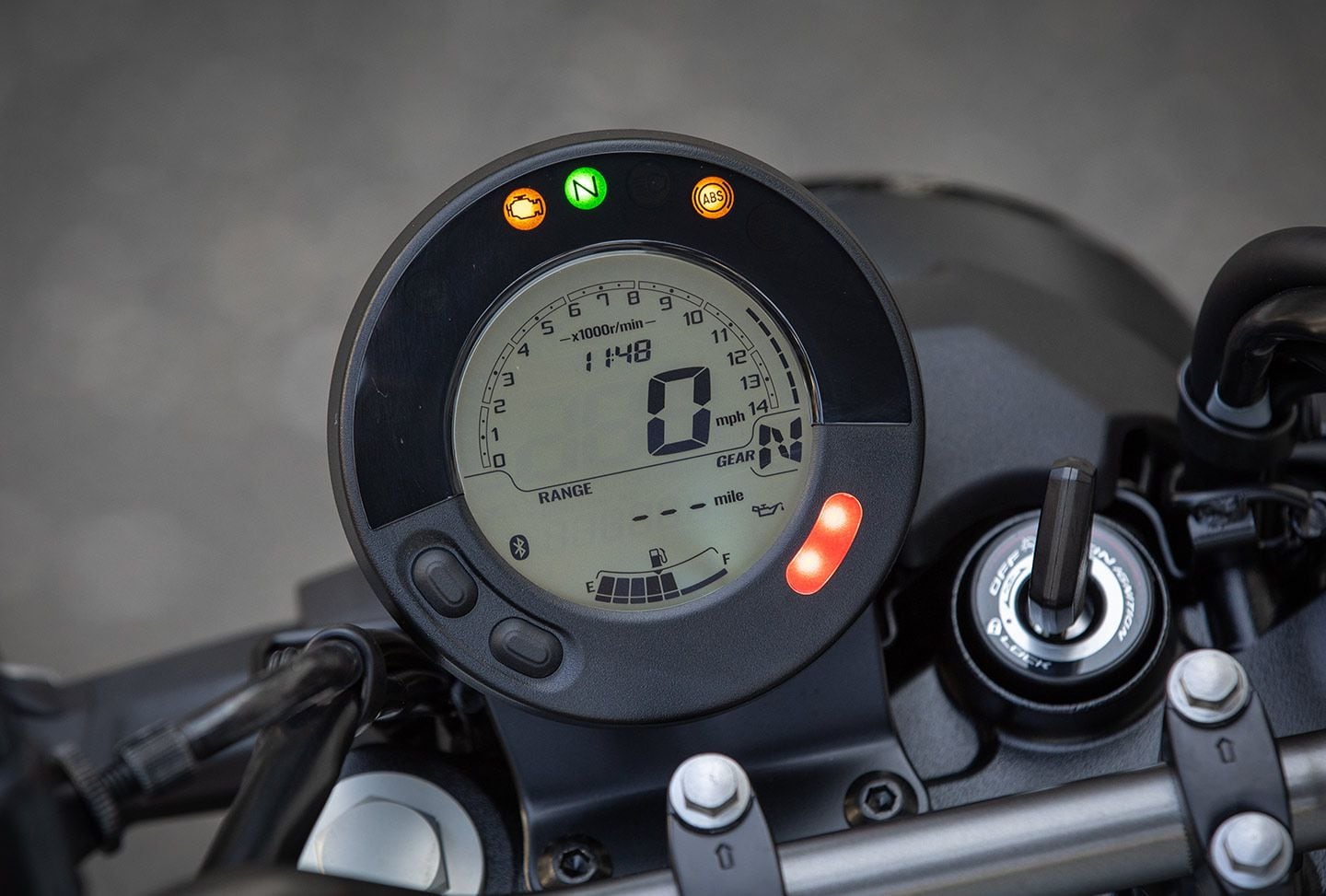
The digital instrument panel provides a gear position indicator, Bluetooth indicator, current and average fuel consumption, maintenance reminders, and smartphone notifications along with all the other standard information. (Kevin Wing/)Swinging a leg over the Kawasaki Eliminator for the first time, what’s instantly apparent is just how manageable this motorcycle is. The 28.9-inch seat height gives confidence knowing it is easy to keep the bike upright at a stop, regardless of the surface beneath. With an inseam of 28 inches, I find there are very few motorcycles that allow me to plant both feet flat on the ground. This is one of them. Rolling away from a stop is easy and repeatable with the help of the assist and slipper clutch. The tractable engine ensures the bike won’t get away from the rider but is lively enough to make the ride exciting.
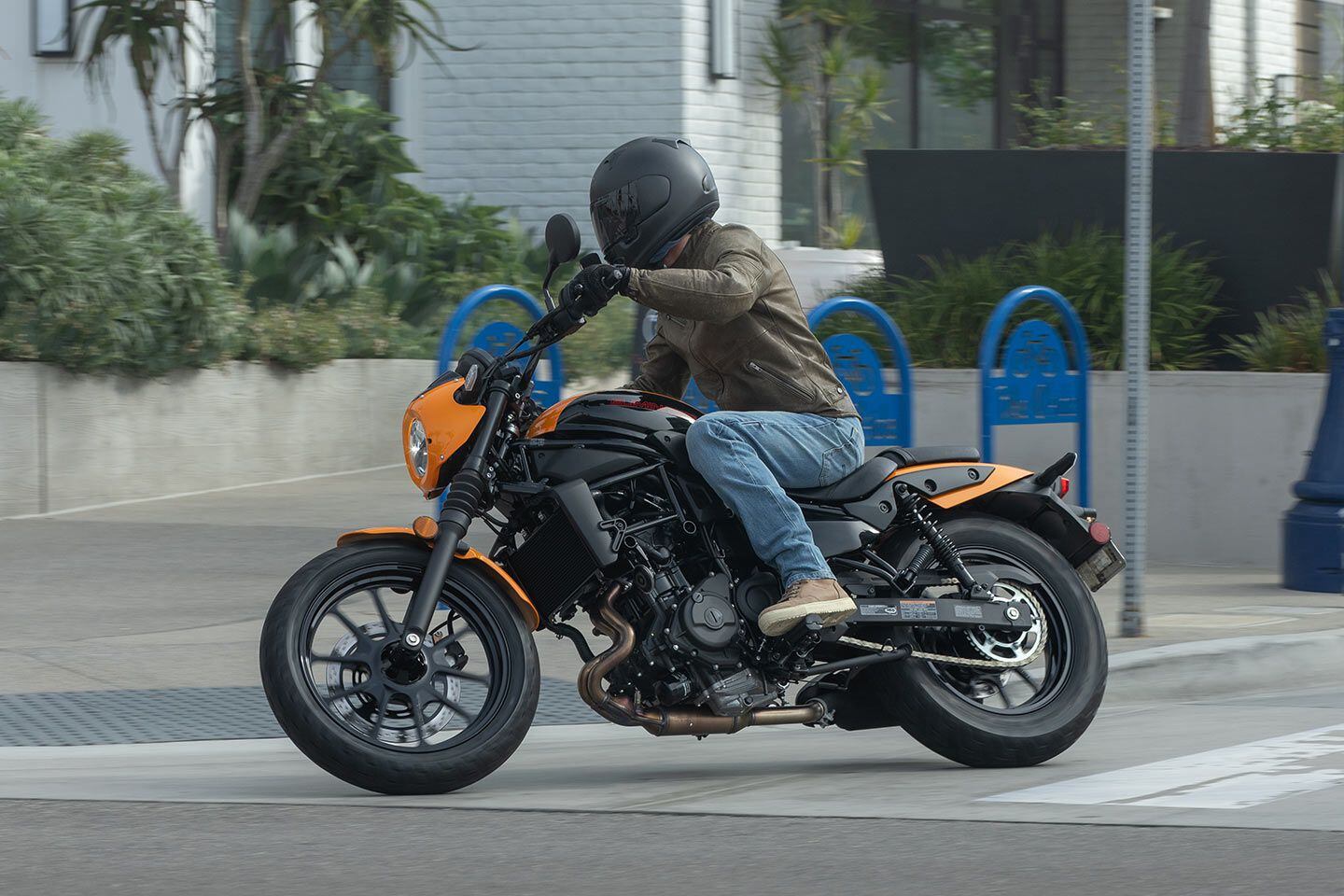
Pulling away from a stop is easy and repeatable with the help of the assist and slipper clutch. (Kevin Wing/)Cruising down Pacific Coast Highway in Oceanside, California, the low-end power provides enough torque to lug the bike at 3,000 rpm and short-shift it from one light to the next. It can easily pull away from a stop in second gear without abusing the clutch or risk stalling. Plus, the engine can carry fifth gear at 25 mph comfortably. The 451cc parallel twin has just enough chuggability to act like a cruiser around town, but can equally perform in the upper rpm range on backroads and highways like a standard.
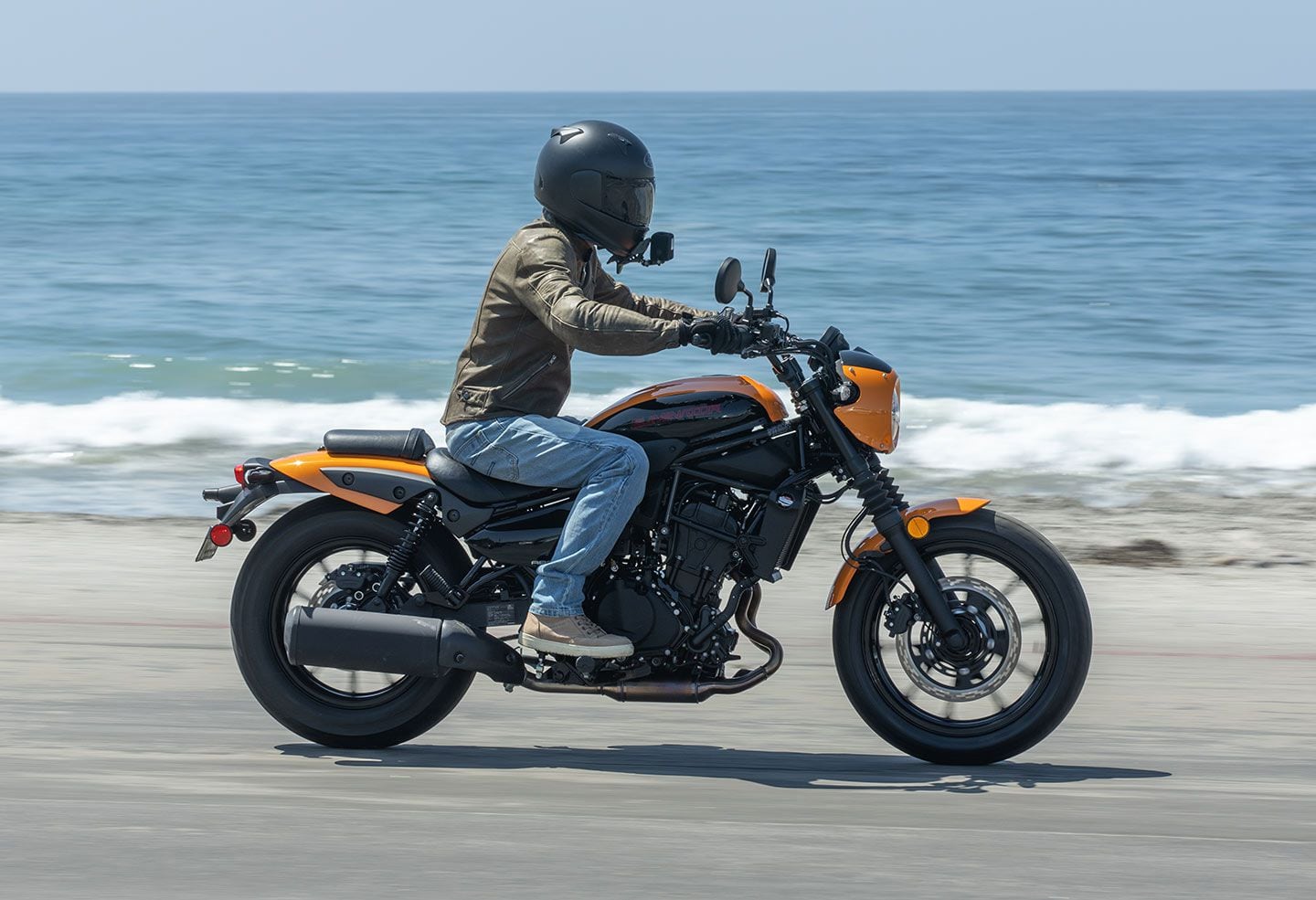
Feeling the ocean breeze on the 2024 Kawasaki Eliminator. (Kevin Wing/)Power delivery is extremely smooth and predictable. Utilizing throttle-by-wire, the system is precise and intuitive; even the tiniest throttle adjustments are reciprocated at the rear wheel. In the twisties, it’s evident this bike is derived from a Ninja 400. Rev the Eliminator out high into the rpm range and it continues to put the power down. Its quick-revving nature makes the bike sporty and willing to attack corners. Neutral ergonomics further enhance its agile chassis on twisty pavement. But, because of a low stance, ground clearance becomes an issue if the Eliminator is leaned too far over.
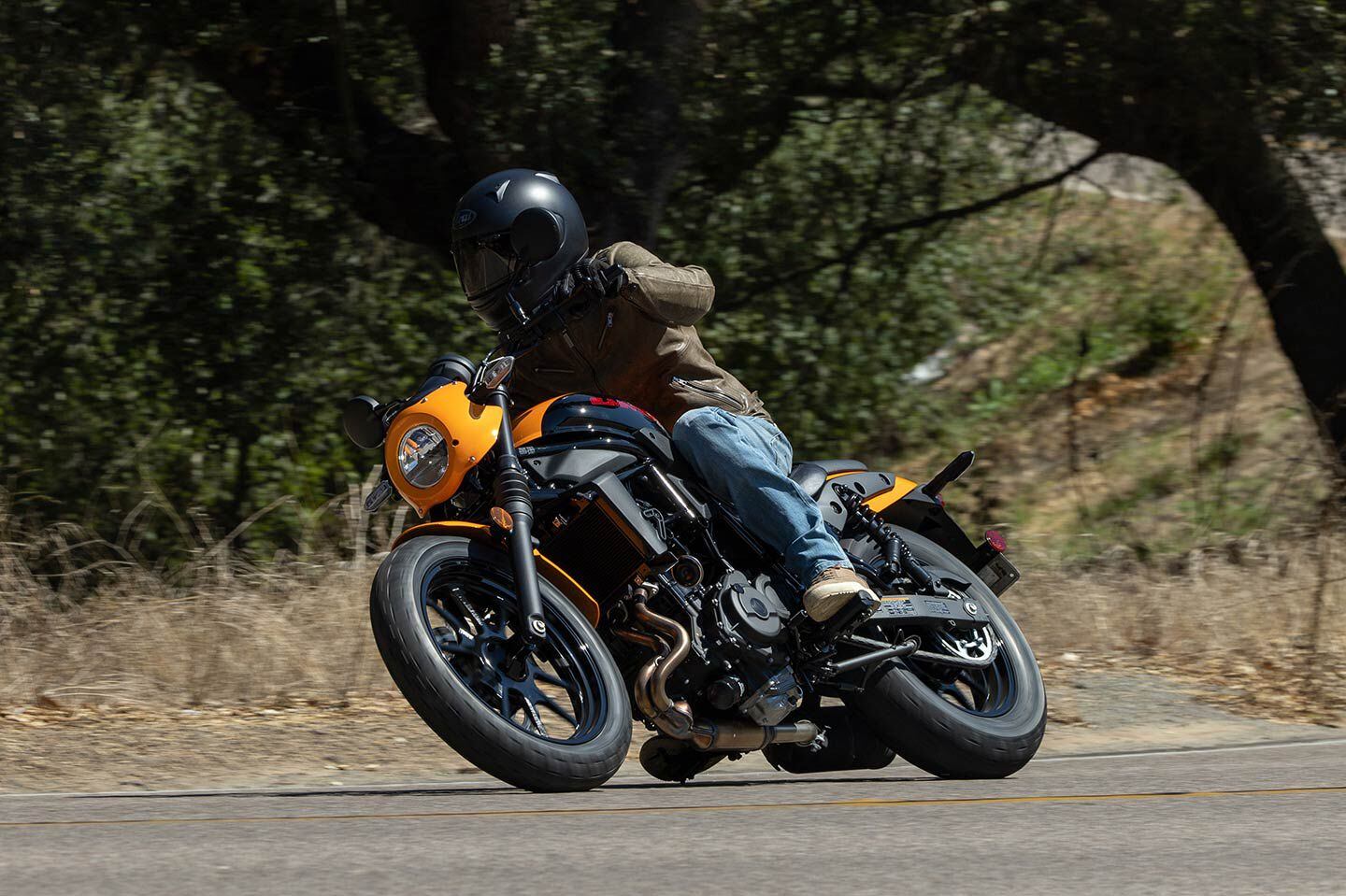
As sporty as the Eliminator is on canyon roads, its low ground clearance can hold it back if ridden too aggressively. (Kevin Wing/)The Eliminator has a claimed curb weight of 390 pounds (SE ABS model), but feels even lighter in motion. Cutting through traffic or carving up backroads, the 2024 Kawasaki Eliminator requires minimal handlebar input to initiate lean angle and stays planted and controlled on the side of the tire. Suspension is balanced and offers the perfect combination of comfort and performance. At my weight of 125 pounds, the suspension components managed to absorb the bumps and holes on the road while still providing plenty of holdup on fast corners or under hard braking. Of course, a large bump or crater can get the bike unsettled, but let’s remember, this is a cruiser. And not once, despite a few large imperfections on the surfaces traveled, did the twin shocks bottom out.
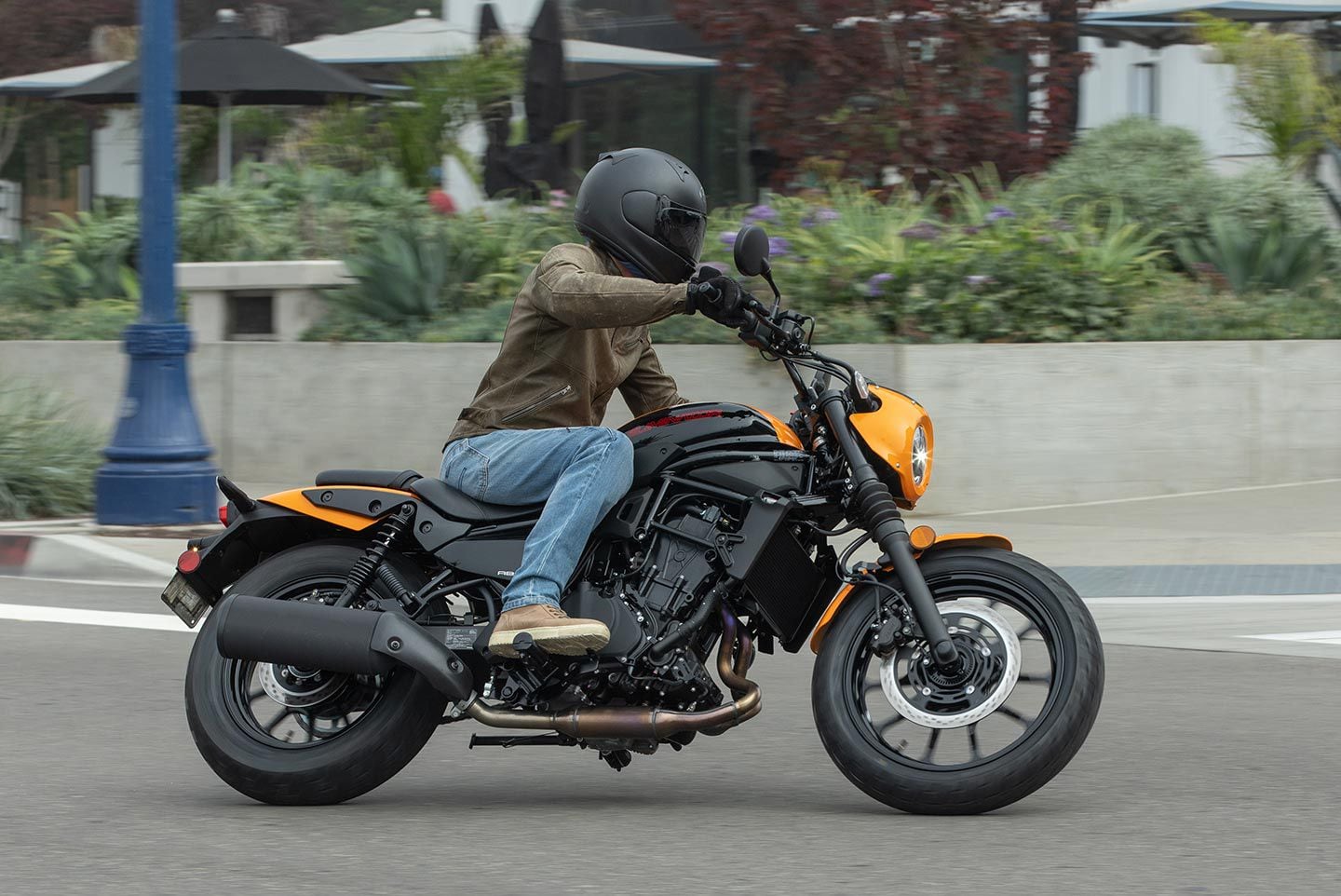
Headed for the hills on the 2024 Kawasaki Eliminator SE. (Kevin Wing/)Hopping back and forth from urban landscapes to winding backroads, the Kawasaki Eliminator’s performance remains constant. The only component that shows any weakness in the twisties is the front brake. Getting a little too ambitious on the binders coming into corners reminds you that this is a cruiser. Leave plenty of space to slow down and flow from corner to corner; the brakes provided ample stopping distance at slower speeds.
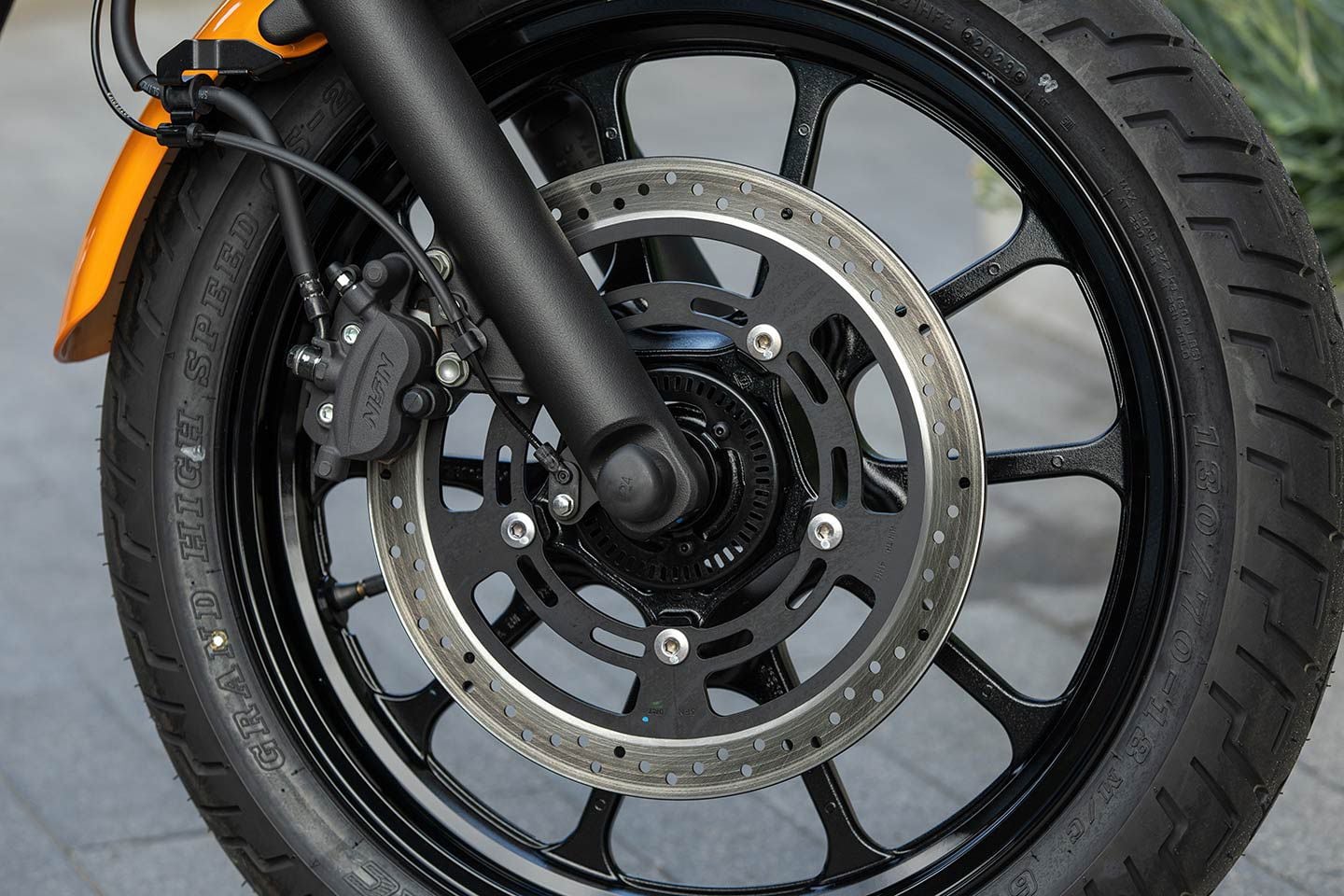
A single 310mm disc and dual-piston caliper handles braking on the front end. The 2024 Kawasaki Eliminator is available with or without ABS in Pearl Robotic White and Pearl Storm Gray. (Kevin Wing/)Banging gears up and down on backroads was a good test of the six-speed transmission. The gearbox is exceptional. A very short throw enhances the riding experience when shifting up or down, and the Eliminator seamlessly goes from one gear to the next without any stickiness or resistance. The Kawasaki Eliminator’s transmission features an easy neutral finder system that does not allow the bike to shift from first to second at a stop. This makes putting the bike in neutral at a stop effortless without fail and is something beginners will adore and experienced riders will appreciate.
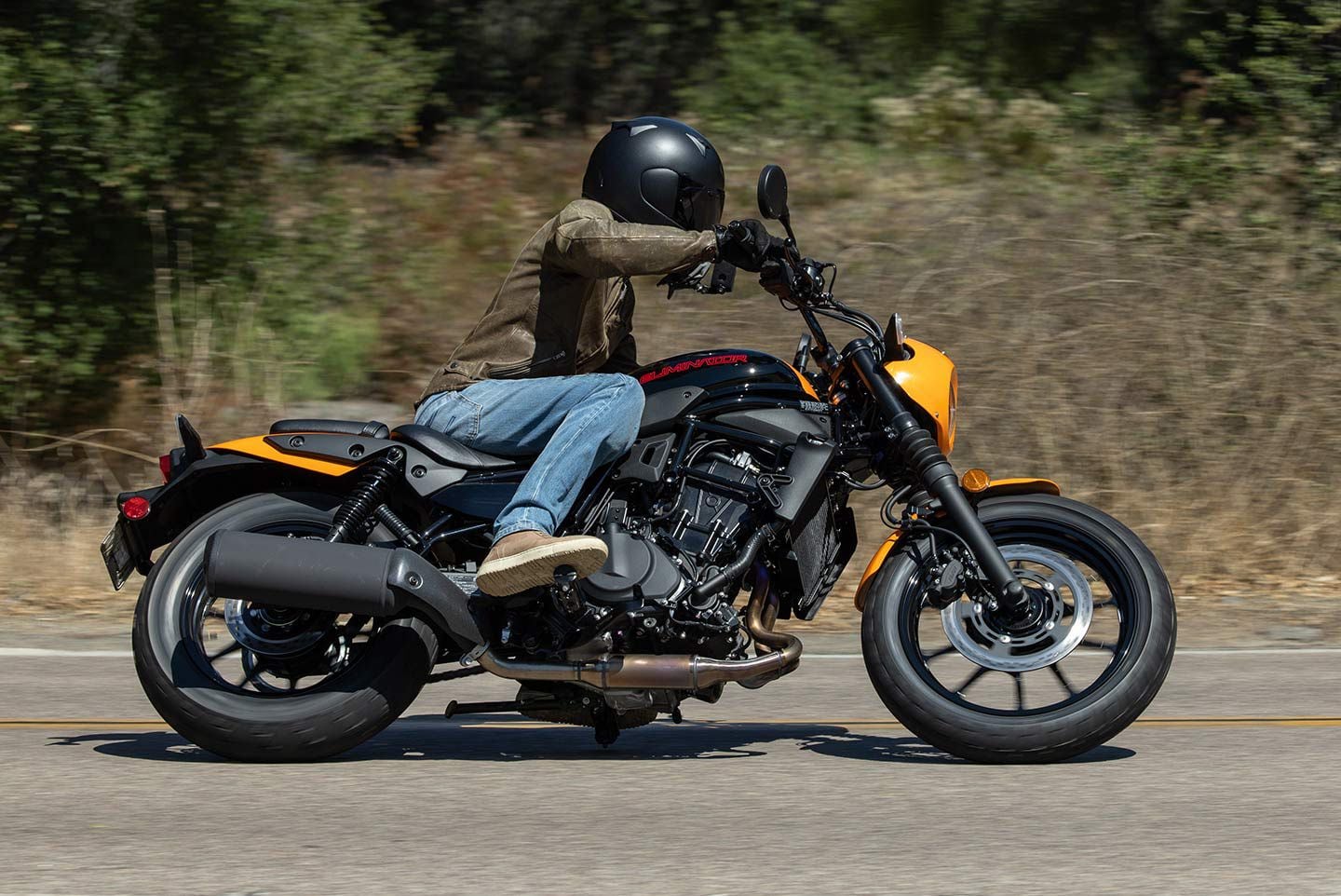
The IRC Grand High Speed GS-23F tires provided excellent grip on the roads traveled. (Kevin Wing/)Further illustrating the Eliminator is a standard in cruiser clothing, Kawasaki says the rider triangle of its Z400 is nearly identical to that of the Eliminator. The Eliminator has a slightly lower seating position, a higher handlebar, and a similar footpeg location. All these attributes make the 2024 Kawasaki Eliminator comfortable for all-day riding. At 5 feet, 8 inches, I never felt the need to get off the bike and stretch my legs. For those taller or shorter, Kawasaki Genuine Accessories offers two additional seat options: high seat (30.1 inches) and low seat (28.1 inches). Standard seat height is 28.9 inches.
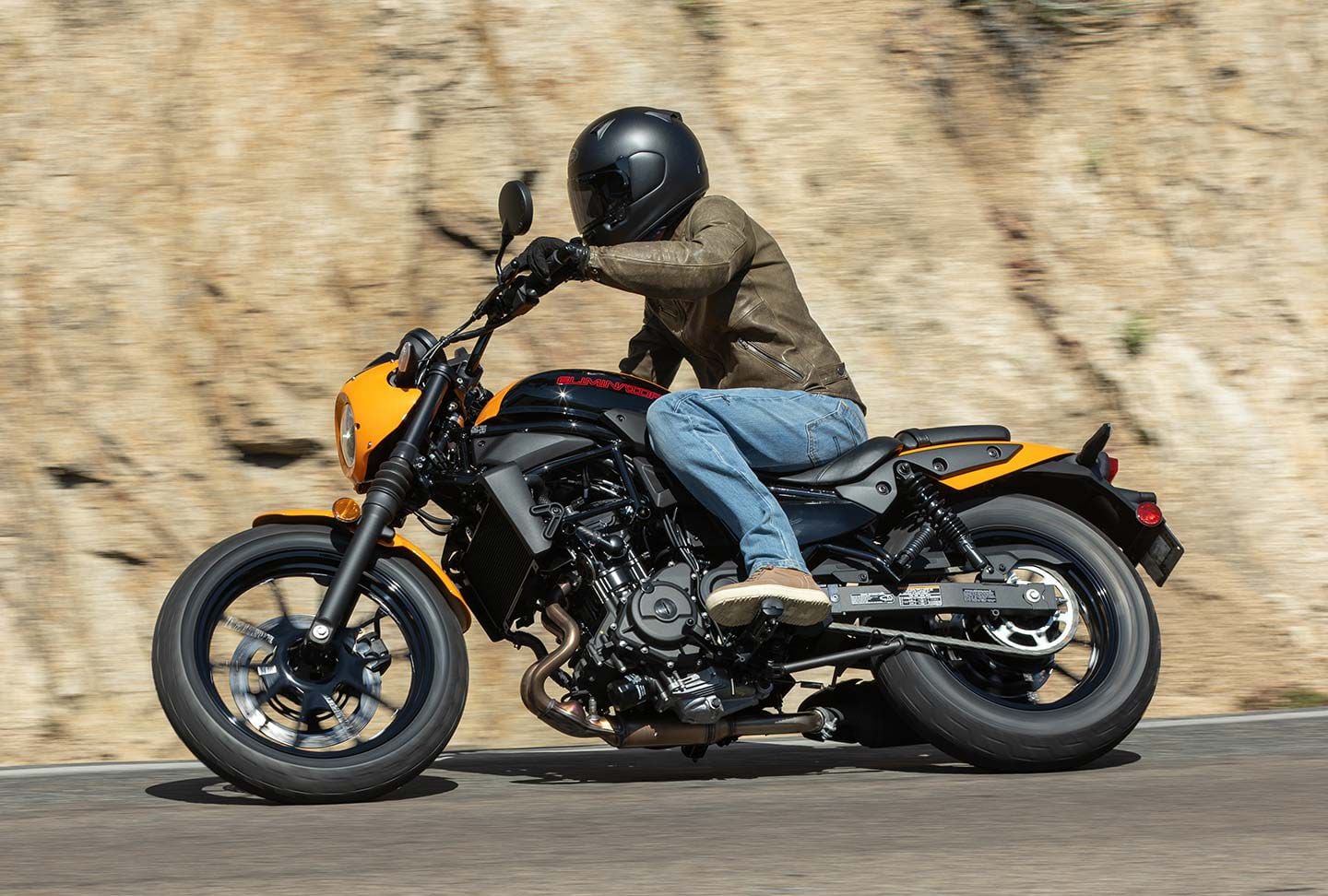
The Eliminator’s neutral riding position pays dividends in the twisties. (Kevin Wing/)The Kawasaki Eliminator SE builds on the standard Eliminator with Candy Steel Furnace Orange/Ebony two-tone paint, a color-matched headlight cowl, a two-pattern stitched seat, fork boots, and a waterproof USB-C outlet. The 2024 Kawasaki Eliminator SE ($7,249) is only available with ABS.
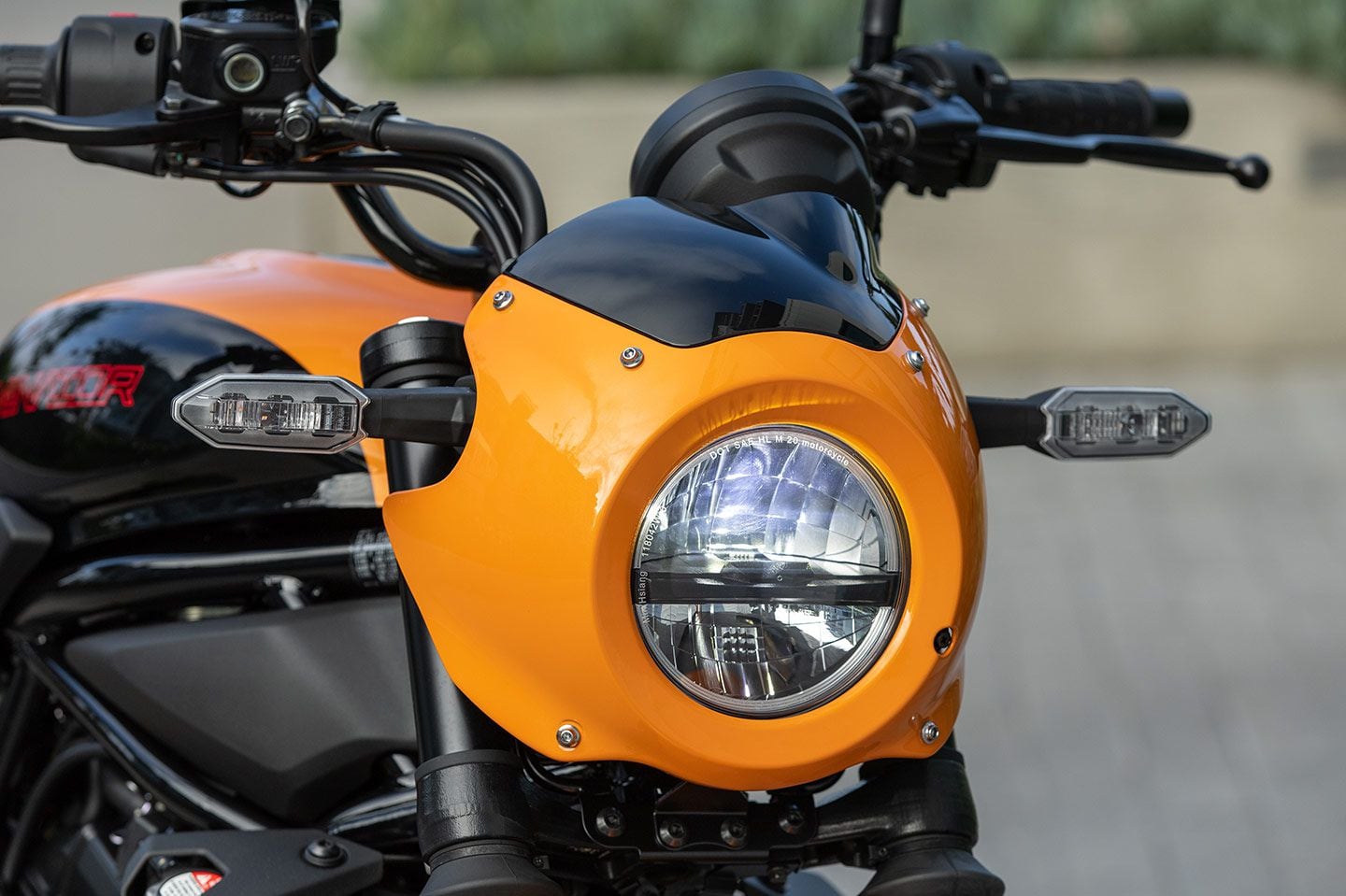
A 130mm LED headlight is fitted on all three Eliminator models. The upscale SE model features a color-matched headlight cowl. (Kevin Wing/)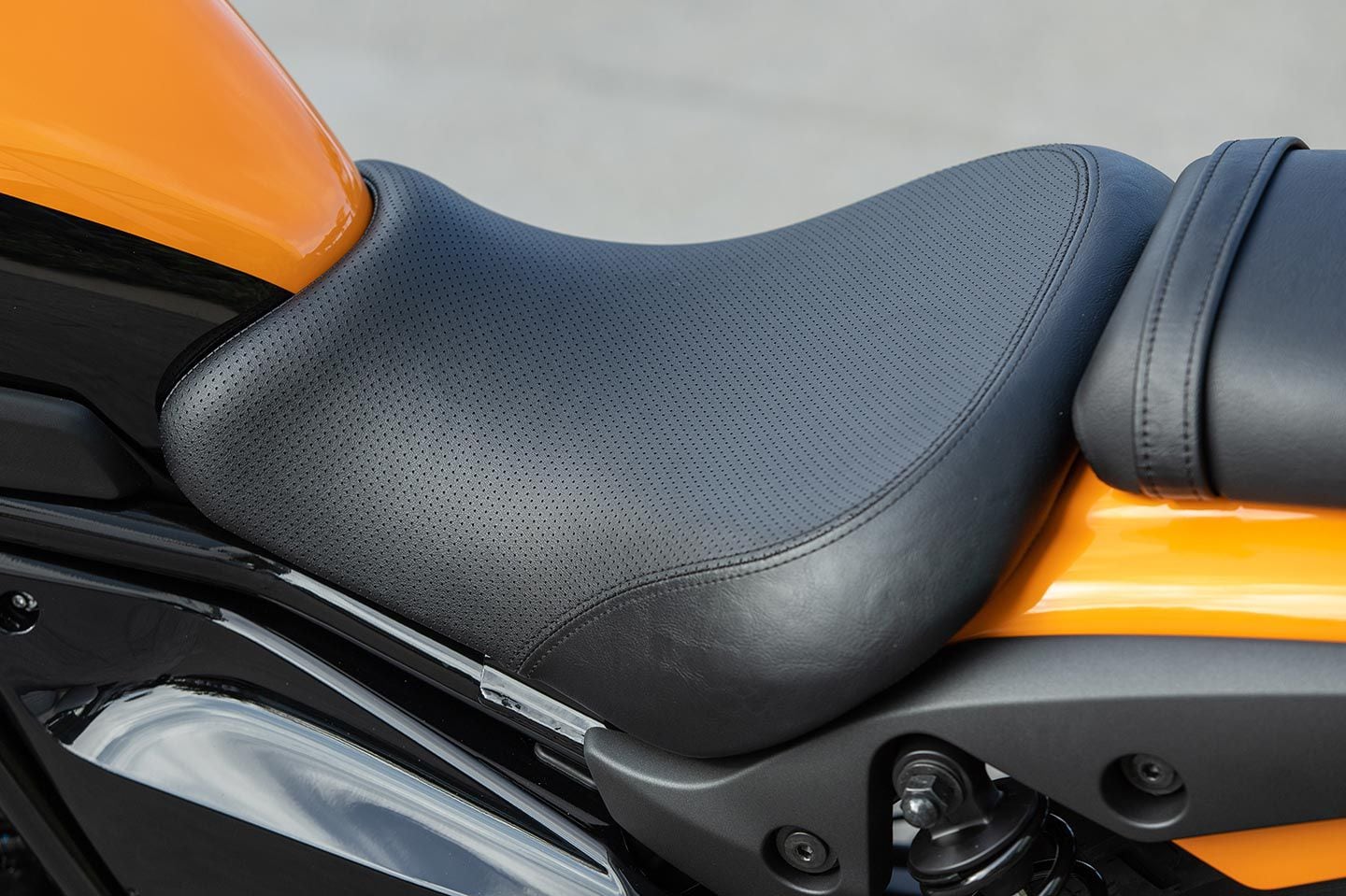
Specific to the Eliminator SE is a two-pattern leather seat with top-edge stitching. (Kevin Wing/)Kawasaki took its already existing Ninja 400 and Z400 streetbike platform and reworked it for customers wanting cruiser styling while infusing new-rider approachability. As the 2024 Kawasaki Eliminator enters the market, it is sure to compete with models such as the Honda Rebel 500 and Royal Enfield Meteor 350. Its flexible engine, agile chassis, approachable seat height, and accessible price point make the Eliminator a strong contender in the lightweight cruiser class.
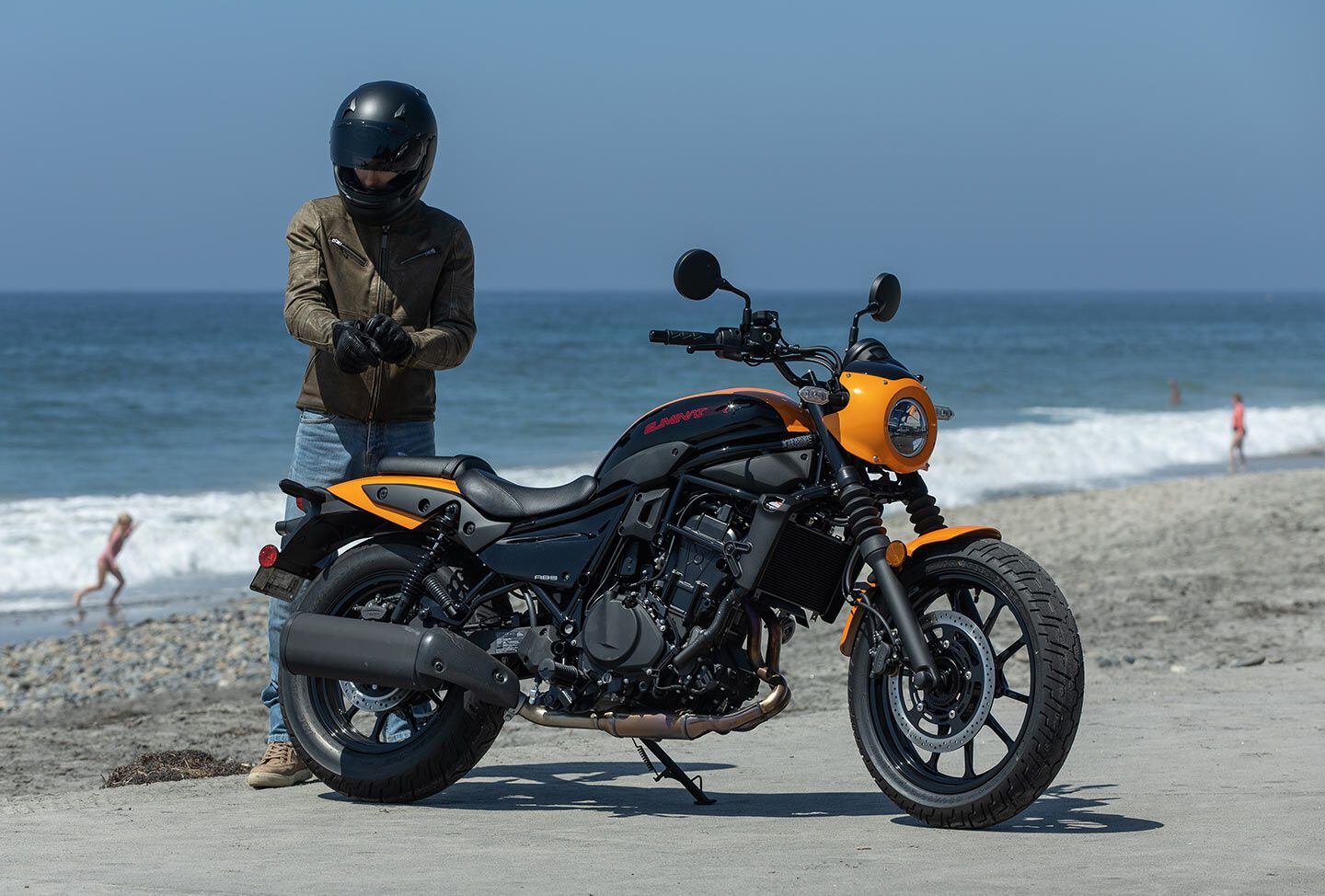
A quick stop to check the waves and we were on our way. (Kevin Wing/)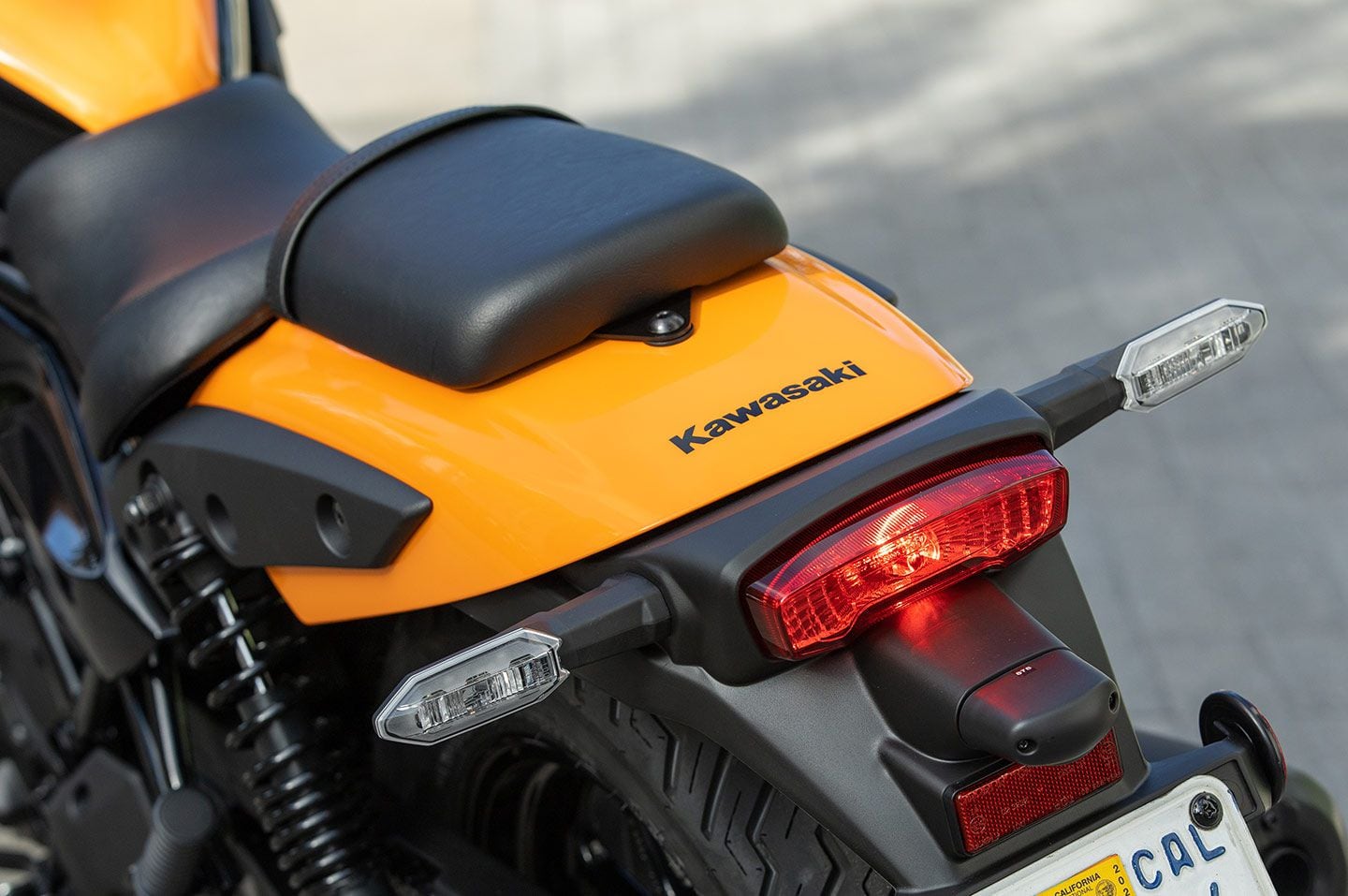
Maintaining the long and low styling of a cruiser, Kawasaki designed the tailsection to pay homage to the Eliminator lineage. (Kevin Wing/)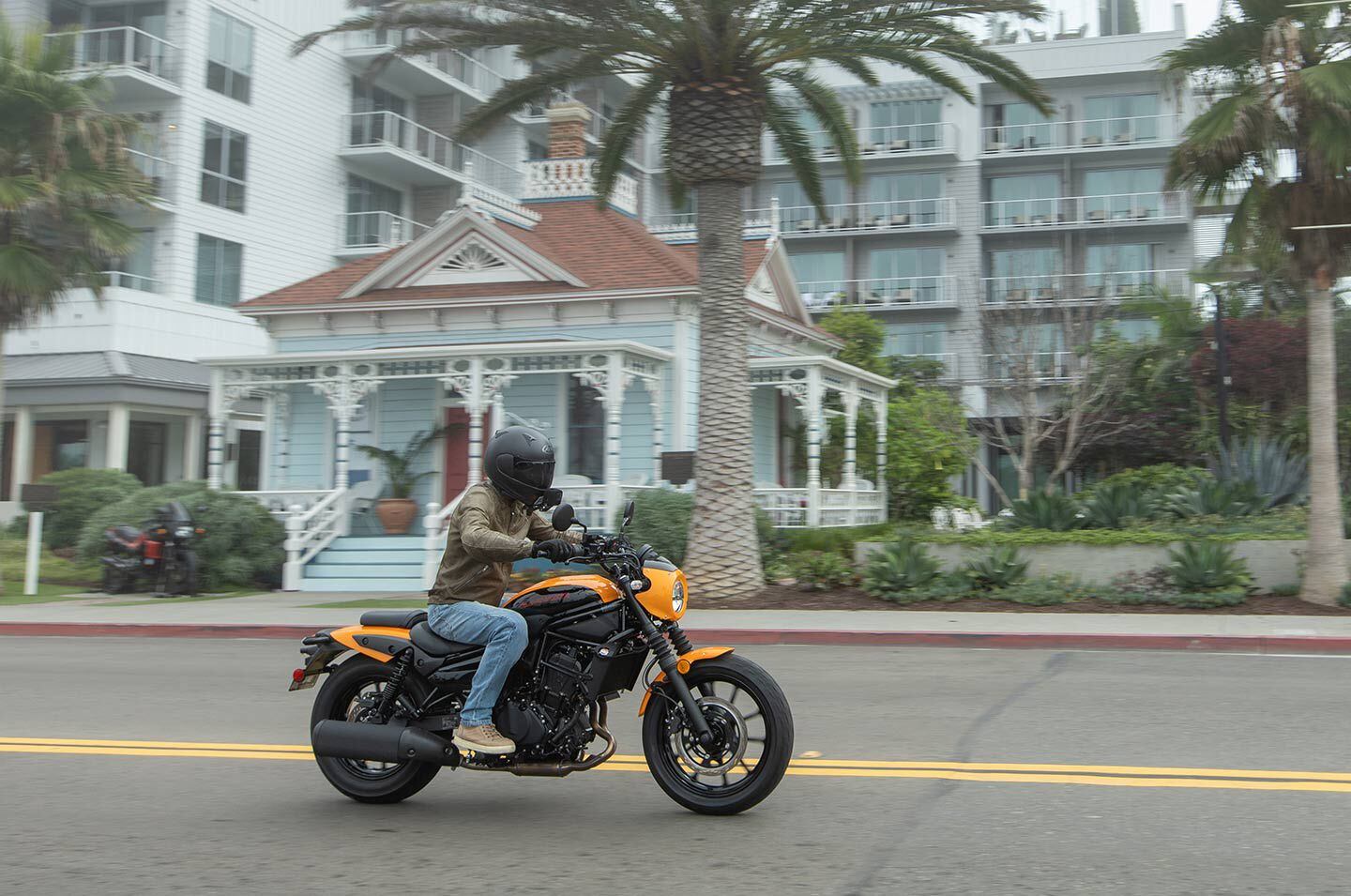
It was fitting to have the 2024 Kawasaki Eliminator launch at the Mission Pacific Hotel in Oceanside, California. In the background you can see an exact replica of Maverick’s Kawasaki ZX900 parked next to the original <i>Top Gun</i> house from the 1986 film. (Kevin Wing/)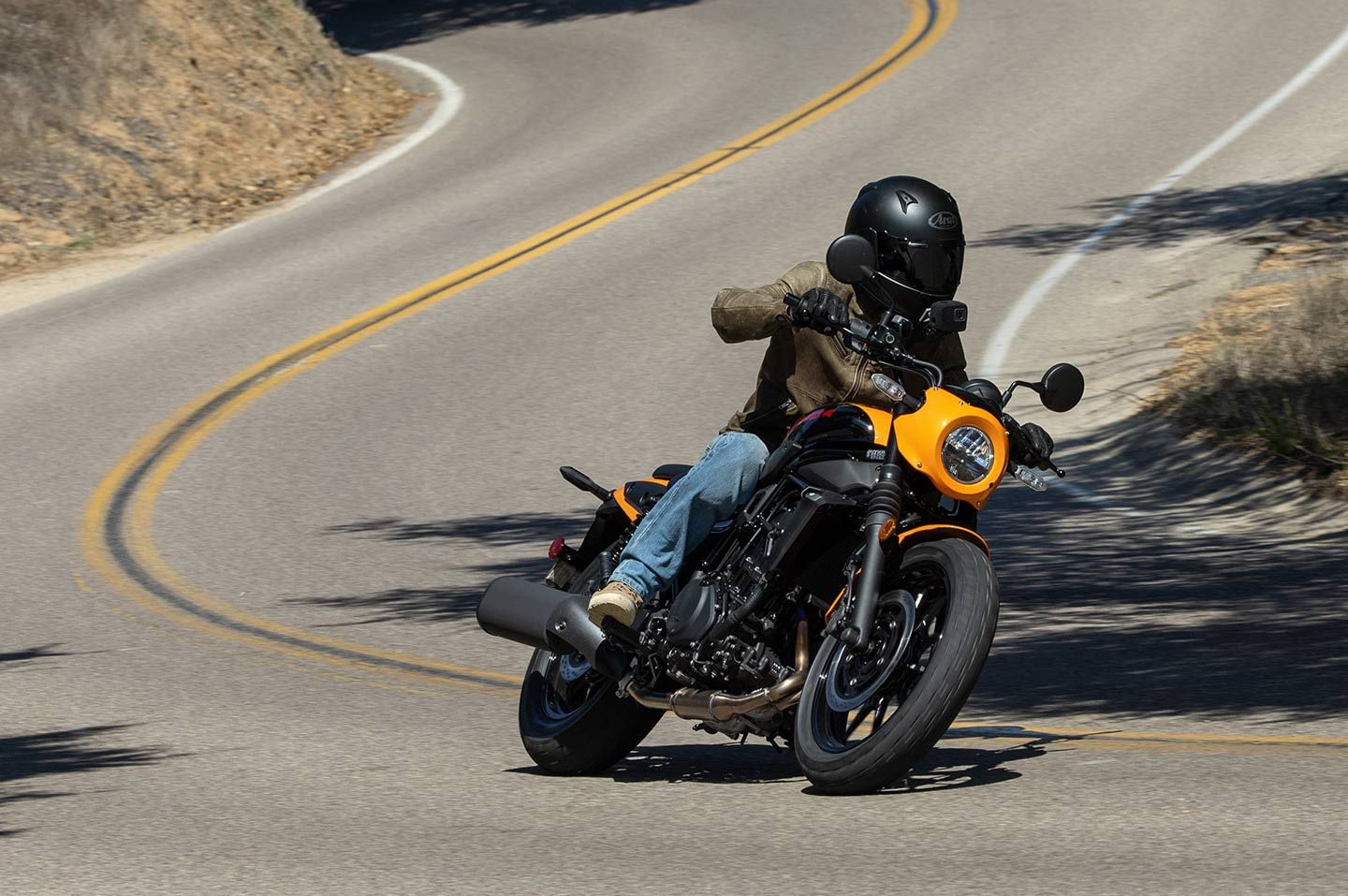
Whether the roads are straight and slow or twisty and fast, the 2024 Kawasaki Eliminator is a blast. (Kevin Wing/)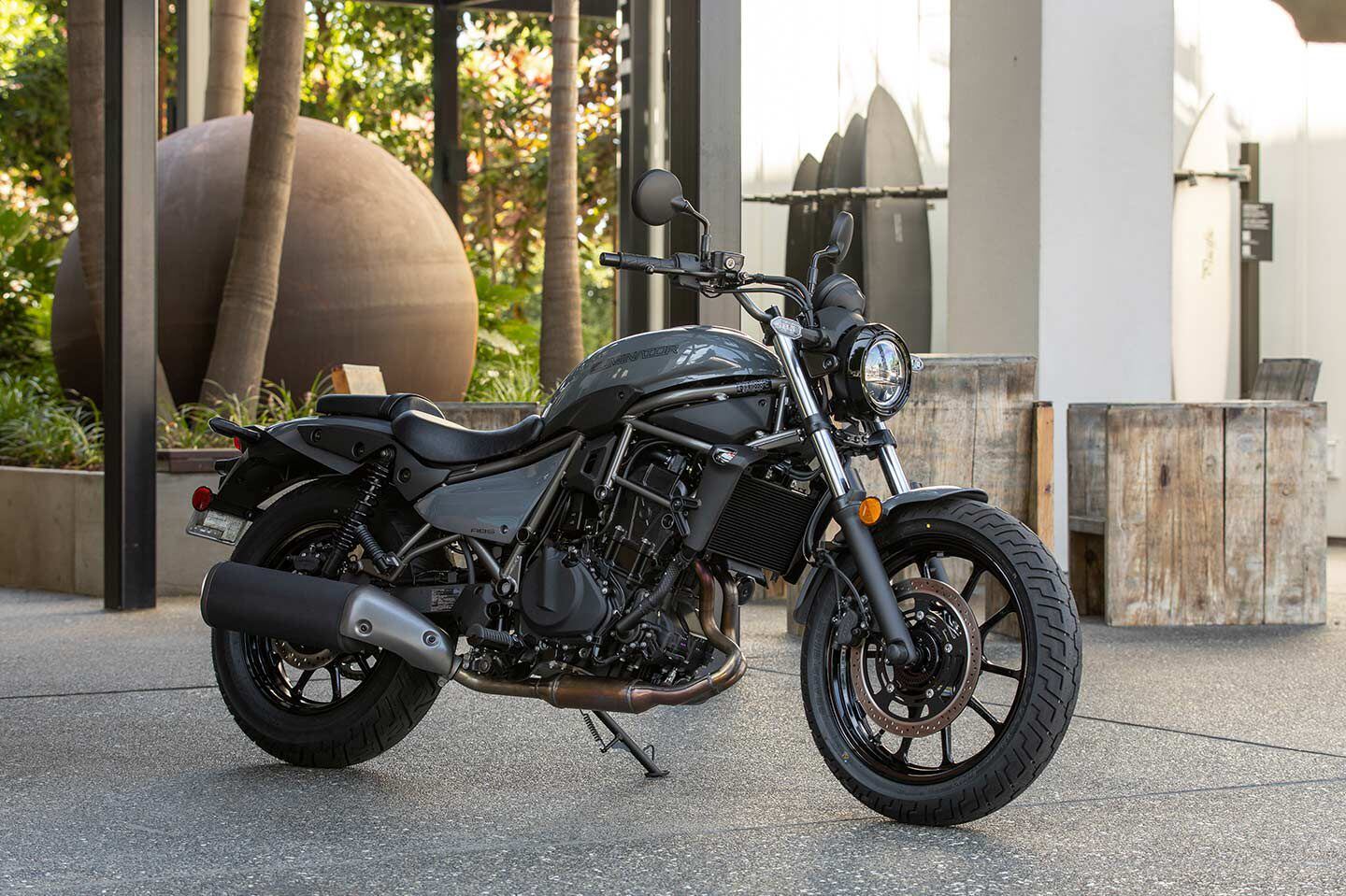
The 2024 Kawasaki Eliminator in Pearl Storm Gray starts at $6,649. (Kevin Wing/)2024 Kawasaki Eliminator Specs
MSRP: $6,649–$7,249 Engine: DOHC, liquid-cooled, 4-stroke parallel twin Displacement: 451cc Bore x Stroke: 70.0 x 58.6mm Compression Ratio: 11.3:1 Transmission/Final Drive: 6-speed, return shift/sealed chain Claimed Horsepower: N/A Claimed Torque: 31.7 lb.-ft. Fuel System: DFI w/ 32mm throttle bodies Clutch: Wet, multiplate slipper/assist Engine Management/Ignition: TCBI w/ Digital Advance Frame: Trellis, high-tensile steel Front Suspension: 41mm telescopic fork; 4.7 in. travel Rear Suspension: Twin shocks, spring preload adjustable; 3.1 in. travel Front Brake: 2-piston caliper, 310mm disc (w/ ABS) Rear Brake: 1-piston caliper, 220mm disc (w/ ABS) Wheels, Front/Rear: 10-spoke; 18 in./16 in. Tires, Front/Rear: 130/70-18 / 150/80-16 Rake/Trail: 30.0°/4.8 in. Wheelbase: 59.8 in. Ground Clearance: 5.9 in. Seat Height: 28.9 in. Fuel Capacity: 3.4 gal. Claimed Weight: 386 lb. (non-ABS) / 388 lb. (ABS) / 390 lb (SE ABS) Contact: kawasaki.com Gearbox
Helmet: Arai Regent-X
Jacket: Spidi Garage
Gloves: Spidi Garage
Pants: Spidi J-Tracker Denim Pants
Boots: Rev’It Grand Shoes
-
With the three-cylinder 9.5 greenlit and almost ready for launch, the 5.5 has been put on hold.
-
The Dakar-bred machine is street legal and boasts a respectable 52 horsepower.
-

The 2023 Rebel 1100T DCT in Bordeaux Red Metallic ($11,299). A windscreen, standard Dual Clutch Transmission (DCT), and hard saddlebags make the 1100T the top of the Rebel food chain. (Honda/)Ups
- Hard bags and a windscreen add comfort, versatility, and style
- Adjustable power delivery, traction control, and engine-braking enable riders to tailor performance to their preference. And there’s a lot of performance to be had!
- Relatively light weight and affordable price tag make it an anomaly in the bagger category
Downs
- Only available with automatic DCT transmission
- Cramped rider triangle
- 35 liters of luggage capacity is tiny
Verdict
The bagger-style Honda Rebel 1100T DCT fills out Honda’s Rebel lineup, adding style and versatility to an already great platform. Thanks to a lightweight design and affordable price tag, the bike opens up the bagger world to a larger segment of riders.
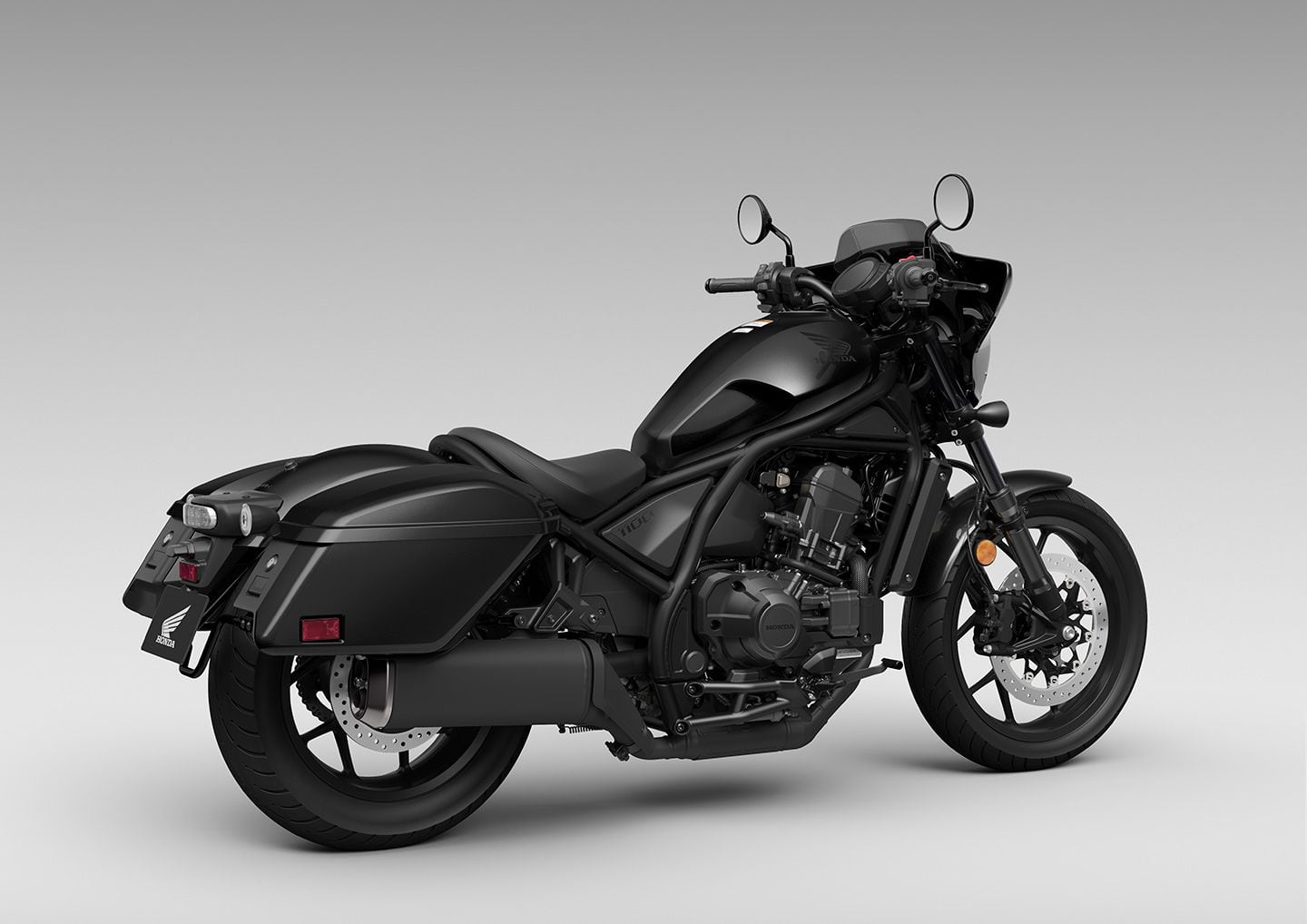
Honda Rebel 1100T DCT in Metallic Black. Notice all of the blacked-out components Honda has incorporated into the design. (Honda/)Overview
If the Rebel 1100 is the reinvention of the metric cruiser, then the Rebel 1100T DCT is the reinterpretation of the bagger. While most baggers weigh in excess of 800 pounds and cost north of $20,000—often way north—the 1100T weighs a claimed 524 pounds and costs $11,299.
The 1100T DCT differentiates itself from the Rebel 1100 DCT with hard saddlebags and a fairing/windscreen. And that’s about it. It’s a pretty no-frills model for a category that often has from-the-factory “custom” paint and integrated speakers in the saddlebags. But that’s part of the Rebel T’s appeal. For decades, many of the Big Four’s cruiser offerings were chromed-out imitations of America’s highest-selling motorcycles. Often, they were reliable, finely engineered machines catering to a certain segment of the market that didn’t care—or at least claimed they didn’t care—what badge was on the tank. For many of today’s consumers, however, perceived authenticity is a firmly held value, and a “Harley clone,” no matter how well-made, is anything but authentic.

Color-matched fairing and saddlebags add to the overall look. (Honda/)Honda’s revamped Rebel lineup and the Rebel 1100T DCT take a different approach. Rather than imitate some other brand’s schtick, Honda gave the 1100T its own identity, right down to the parallel-twin engine derived from the company’s Africa Twin adventure bike.
While the 59.8-inch wheelbase, 28-degree-raked front-end, and mid-controls immediately announce “cruiser,” Honda’s DNA shines through; the1100T has electronic rider aids, ABS, a sweet-handling chassis, and an automatic transmission.
Think of the Rebel 1100T DCT as an affordable alternative to a Harley or Indian, but the keyword here is alternative. It offers its own unique take on what a bagger can be. For some, that makes it authentically, proudly subversive. To others, it’s just a good motorcycle at a good price. No matter how you look at it, it’s a whole lot more accessible than big V-twin baggers.
Updates for 2023
The Rebel 1100T DCT was a new addition to Honda’s lineup for 2023. It’s available in Metallic Black or Bordeaux Red Metallic.
Pricing and Variants
The Rebel 1100T DCT is available for $11,299. For comparison, the standard Honda Rebel 1100 is available for $9,499, while the DCT-equipped version is $10,099.
Competition
The Rebel 1100T DCT is sort of in a class of its own. While the standard Rebel models compete with the Harley-Davidson Nightster ($13,499) and the Indian Scout Rogue ($12,749), neither of those models come in bagger variations. Mind you, both of those bikes are an accessory windscreen and saddlebags away from similar functionality.
The Harley-Davidson and Indian both have modern V-twin engines and more true-to-type—though still forward-looking—cruiser styling. The Rebel’s parallel-twin engine and trellis frame help it step out of the shadow of Harley and Indian, allowing it to wear its Honda wing badge with pride. Of the three, the Rebel 1100T is the only one that includes an automatic transmission.

Tweaked and modified to suit the cruiser vibe, the Rebel’s engine has unique engine mapping, a 20 percent larger flywheel for increased inertia, and revised camshaft profiles that give what Honda calls “power pulses,” as though to further mimic the feel of a V-twin. (Honda/)Powertrain: Engine, Transmission, and Performance
The Rebel 1100T is powered by a liquid-cooled 1,083cc Unicam parallel twin derived from the Honda Africa Twin. Tweaked and modified to suit the cruiser vibe, the Rebel’s engine has unique engine mapping, a 20 percent larger flywheel for increased inertia, and revised camshaft profiles that give what Honda calls “power pulses,” as though to mimic the feel of a V-twin. On the Cycle World dyno, the standard Rebel 1100 produced 81 hp at 7,000 rpm and 67.9 lb.-ft. of torque at 5,000 rpm.
Power delivery is smooth and strong and the engine is well balanced. But even with that flywheel it doesn’t have the classic cruiser pulse. Or, for that matter, an exhaust note that makes you want to blip the throttle at a red light. Three programmed modes alter power delivery, engine-braking, traction control, and shift points. Even with so much technology between the right hand and rear wheel, riding the Rebel is uncomplicated and pure. Twist the throttle and it goes; focus on what’s ahead, not what it takes to get there.
The Rebel 1100T’s automatic Dual Clutch Transmission (DCT) eliminates the clutch lever and the need to manually shift gears. Naturally, it also prevents the possibility of stalling. A manual setting allows the rider to use paddle shifters to take back some control. It’s a nice touch on the Rebel, especially for less experienced riders.

Power delivery is smooth and strong and the engine is well balanced. But even with that flywheel it doesn’t have the classic cruiser pulse. Or, for that matter, an exhaust note that makes you want to blip the throttle at a red light. The Rebel 1100T’s automatic Dual Clutch Transmission (DCT) eliminates the need to ever use a clutch lever. Riders can use paddle shifters if they choose. (Honda/)Chassis/Handling
The Rebel 1100T uses a steel tube trellis frame with a nonadjustable fork and preload-adjustable shocks, both from Showa.
Handling, as we’ve come to expect from Honda, is delightfully neutral and inspires particular confidence at low speeds. Thanks largely to the engine placement’s effect on weight distribution, the 524-pound Rebel 1100T feels incredibly well balanced and nimble. The chassis feels planted, with no pitching aft as you accelerate out of one corner and brake hard into another. Even leaned over, carrying speed through a turn, the chassis provides excellent feedback and allows for midcorner inputs without the worry of losing composure.

The Rebel 1100T uses a steel tube trellis frame with a nonadjustable fork and preload-adjustable shocks, both from Showa. It uses a dual-piston Nissin caliper up front, and a Tokico four-piston caliper in the rear. (Honda/)Brakes
The 1100T stops with a Nissin dual-piston caliper on a 256mm disc in the rear and a single radially mounted Tokico four-piston caliper on a 330mm rotor in front. Brakes are responsive with good feel through the adjustable lever, allowing for precise application to help explore the limits of the front suspension and the OE-fitted Dunlop D428 tires. ABS is standard.
Fuel Economy and Real-World MPG
Cycle World-measured fuel economy on the non-T Rebel 1100 is 37.6 mpg.

LED lights are standard. Unfortunately, the 1100T’s saddlebags have a combined capacity of only 35 liters. Long-distance hauls will require additional luggage options. (Honda/)Ergonomics: Comfort and Utility
The Rebel 1100T has a 27.5-inch seat height and shares a similar ergonomic configuration to siblings. The standard Rebel’s ergonomics are somewhat cramped for taller riders. Mid-mounted footpegs sit high on the frame and put riders in sort of a cannonball position, which can be uncomfortable on longer stretches of highway. This peg positioning is reflected in the Rebel’s 35 degrees of claimed lean angle—significantly greater than its competitors—but testers unanimously agree they’d trade some lean angle for cruising comfort.
Cruise control and ABS are standard. Other nice features include 3 liters of underseat storage and a USB-C charging port.
The 1100T brings a windscreen and fairing to the party as well as hard saddlebags. Unfortunately, with a combined capacity of 35 liters (the Harley-Davidson Low Rider ST’s luggage capacity is nearly 54 liters), long-distance hauls will require additional luggage options.

The Rebel’s simple LCD dash is basic but straight-forward to use, allowing riders quick adjustment of various settings. Note: cruise control and the left bar-mounted paddle shifters. (Honda/)Electronics
The Rebel 1100T has three riding modes (Rain, Sport, Tour) that preselect power delivery, engine-braking, and traction control, while a fourth User mode allows riders to customize the settings. The Rebel 1100 also gets full-LED lighting and a basic LCD display to relay all pertinent riding information. ABS comes standard.
Warranty and Maintenance Coverage
Honda offers a one-year, transferable, unlimited-mileage limited warranty for the Rebel 1100T.
Quality
The Rebel 1100T feels well engineered and boasts some high performance for what is otherwise a friendly cruiser. Plastic paneling and an excess of wires and exposed plumbing rob it of top-notch aesthetics. Still, blacked-out finishes, clean welds on the frame, high-quality metalflake paint, full-LED lighting, and other touches exude Honda quality. The 1100T is clearly built to a very high standard and without much flash or glitz to distract. Honda has found its own style with the Rebel line, rather than mimic American cruisers.
2023 Honda Rebel 1100T DCT Claimed Specs
MSRP: $11,299 Engine: 1,083cc, SOHC, liquid-cooled Unicam parallel twin; 4-valve/cyl. Bore x Stroke: 92.0 x 81.5mm Transmission/Final Drive: 6-speed/chain Fuel Delivery: PGM-FI electronic fuel injection w/ 46mm throttle bodies Clutch: Wet, multiplate Engine Management/Ignition: Ride-by-wire/full transistorized ignition Frame: Steel-tube trellis construction Front Suspension: 43mm telescopic fork w/ dark titanium oxide coating, spring preload adjustable; 4.8 in. travel Rear Suspension: Dual Showa shocks w/ 12.5mm shafts, piggyback pressurized reservoirs, spring preload adjustable; 3.7 in. travel Front Brake: 4-piston monoblock, radial-mount hydraulic caliper, floating 330mm disc w/ ABS Rear Brake: 1-piston hydraulic caliper, 256mm disc w/ ABS Wheels, Front/Rear: Cast; 18 in. / 16 in. Tires, Front/Rear: Dunlop D428; 130/70-18 / 180/65-16 Rake/Trail: 28.0°/4.3 in. Wheelbase: 59.8 in. Ground Clearance: 4.7 in. Seat Height: 27.5 in. Fuel Capacity: 3.6 gal. Wet Weight: 524 lb. Contact: powersports.honda.com -
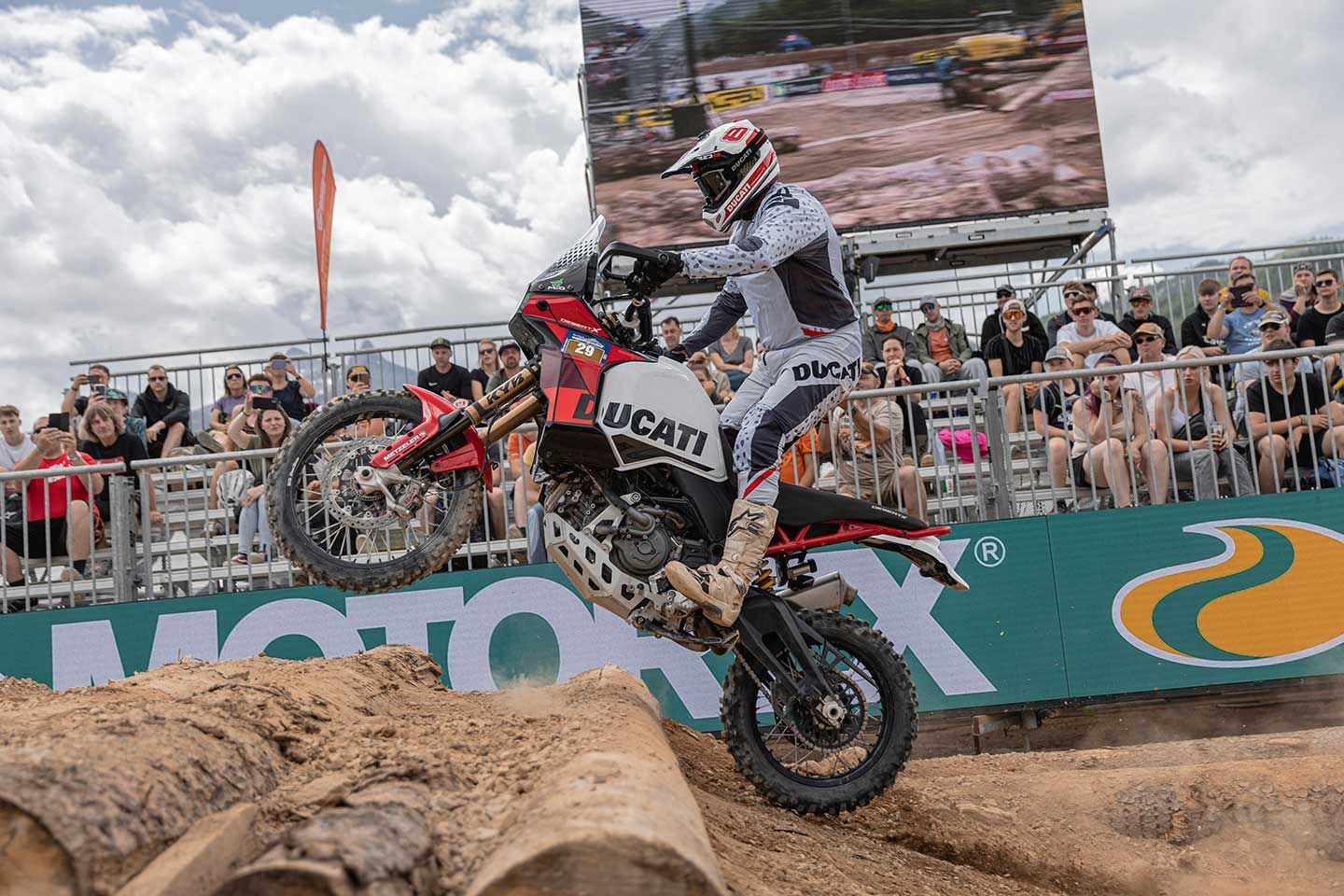
Antoine Méo rode a modified DesertX at the Erzberg Rodeo, one which we believe closely resembles the new DesertX Rally. (Ducati/)Ducati has adopted a staggered new-model-release strategy over the last few years with a series of consecutive “episodes” spread over a couple of months. The company’s 2024 launches have already started with the new Monster 30th Anniversary but another is now confirmed with the name “DesertX Rally” appearing multiple times in new EPA filings.
The DesertX Rally appears under the same certification that already includes the standard DesertX and the DesertX DP (Ducati Performance). The bike’s name also shows up in paperwork from the California Air Resources Board (CARB) for models passing California’s more stringent emissions rules. All the documents agree that the engine is unaltered—it’s the same 937cc Testastretta 11° that’s used in the Hypermotard 950, Monster, and Supersport 950, and in the DesertX Rally it puts out 108 hp and 68 lb.-ft. of torque.
There’s no significant change to the weight, either. Both the EPA and CARB documents use a figure for Estimated Inertial Mass (EIM), intended to represent the mass of the bike, rider, and luggage, rather than the dry or wet weights that we’re used to seeing on a bike’s specs, but the DesertX Rally’s EIM of 320 kilograms (705 pounds) is identical to that of the standard DesertX.
That leaves the question hanging over what exactly does change to differentiate the Rally from the stock DesertX, and the answer surely lies in the bike’s name. Back in June, Antoine Méo rode a modified DesertX to victory in the twin-cylinder class of the Iron Road Prologue at the Erzberg Rodeo, becoming the only twin to qualify for the final. Modifications to his bike, backed by Ducati Austria, included a larger-diameter 48mm Kayaba fork, up from 46mm, and a new shock, with suspension travel at both ends increased compared to the standard model. Narrower wheels—21-incher at the front, 18-incher at the rear wear Metzeler Six Days Extreme tires—and a stronger bash plate under the engine completed the changes along with a Termignoni exhaust. All tweaks that suit the “Rally” suffix of the new DesertX model. Méo’s bike even wore a paint designed by Centro Stile Ducati at the factory, so there’s a strong chance the DesertX Rally will have a similar color scheme.
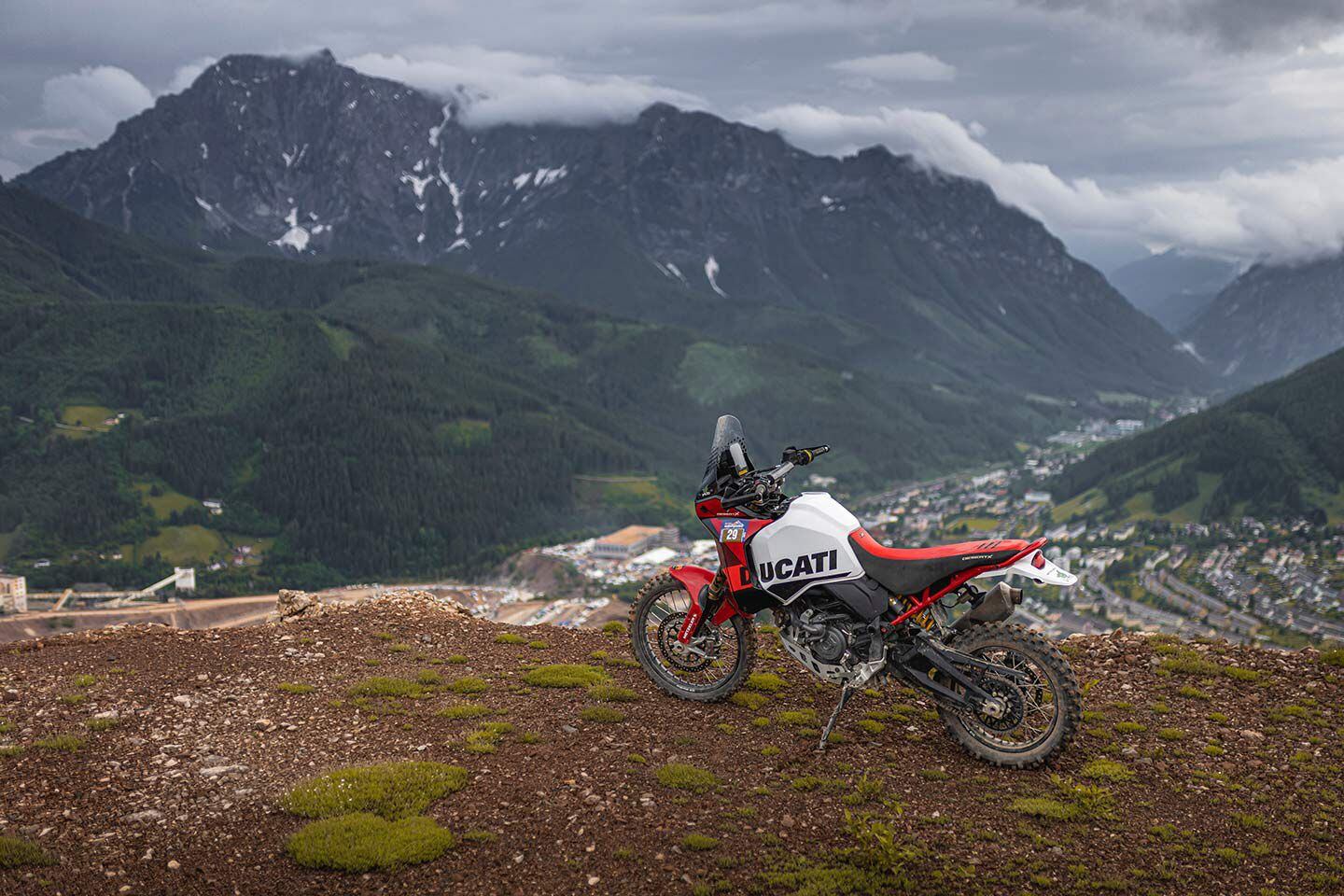
Antoine Méo’s prologue-winning DesertX. (Ducati/)Given the relatively minor changes expected to create the DesertX Rally, it’s likely to appear in one of the earlier “episodes” of Ducati’s 2024 model launches. The next is due on September 19, with additional bikes being unveiled on October 3, October 19, November 2, and November 7. The only other model that’s already guaranteed to be updated for 2024 is the Multistrada; it’s marking its 20th anniversary this year and Ducati has already confirmed it will be the subject of one of the new model episodes in the coming weeks.
-
The ECE-approved slip-on systems accentuate the bikes’ burly 270-degree crankshaft configuration.
-
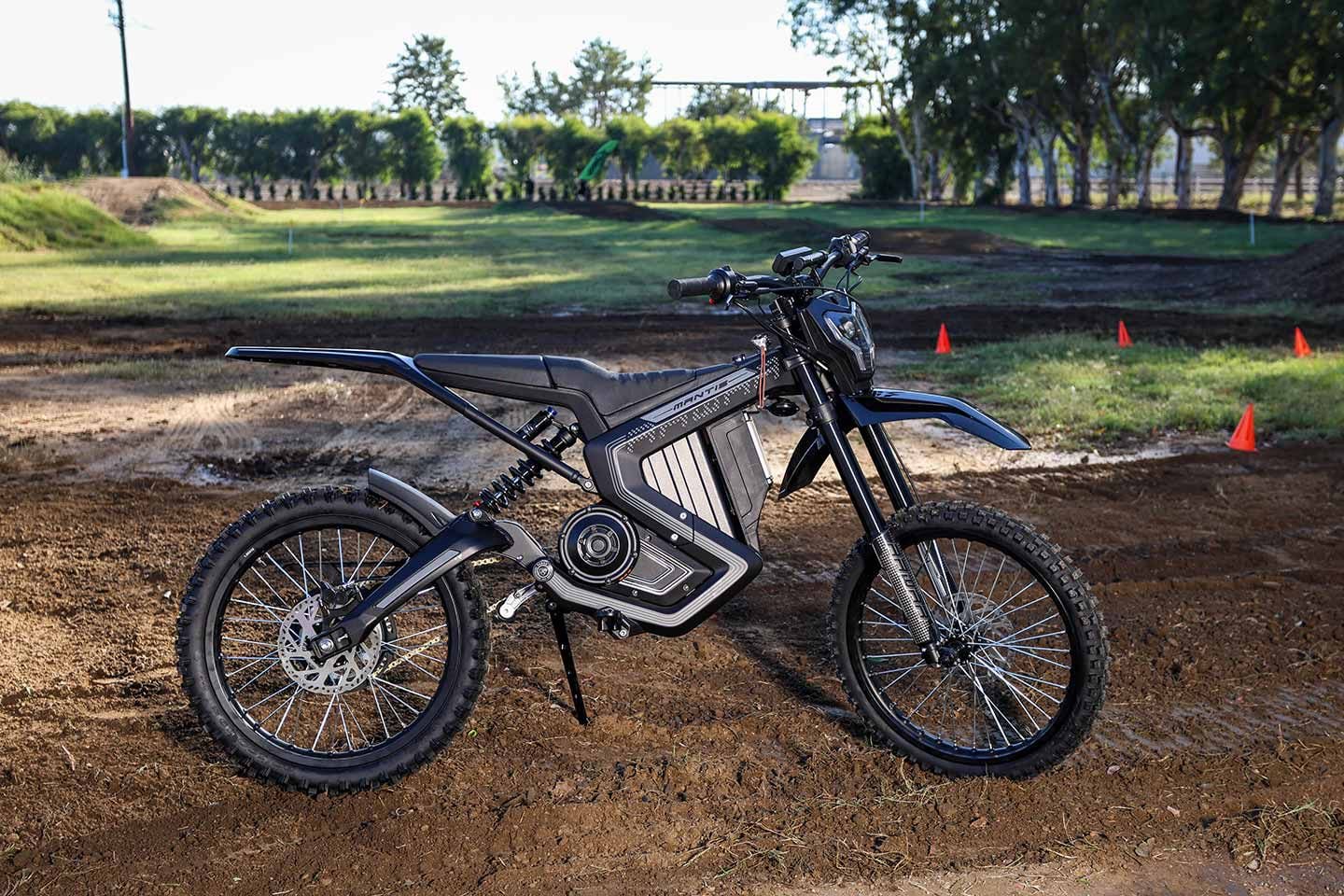
The Rawrr Mantis is available in black and silver. (Rawrr/)E-motos are two-wheelers that appear to either be overgrown downhill mountain bikes that lost their pedals, or shrunken-down enduros with electric motors. No matter how you want to look at it, they’re blowing up in the market. These bikes are light, quick, relatively fast to charge, and super fun because they hit a unique mission: There’s basically no burden of practicality. They’re usually off-road-only so you’re just meant to hop on and rip or cruise while having fun. They’re also typically affordable and low-maintenance.
The $4,999 Rawrr Mantis 72V is one of these all-electric playbikes. Its 33.5-inch seat height and narrow, light chassis/motor combo (claimed 165 pounds with the 72V battery) make it very easy to ride for people new to throttle-powered two-wheelers, and easy to master for those with more experience. Rawrr is definitely easy to ride slow, but I also came here to find out how it rides fast. “Here” is Blackmore Ranch in Menifee, California, a supercool privately owned motorcycle complex that is dirt heaven.
Rawrr is a young Los Angeles–based company with a design team in Italy and R&D in China, where the bikes are manufactured. The founder was described by the US team as a former Chinese national motocross competitor, and the desire was to build an e-moto that was more motorcycle-like than competitors, while still being easy and fun to ride. The Mantis is in its second year of production and the big news this year is more power: The 2024 Mantis is equipped with a Samsung 72V 35Ah battery that boosts electric motor output to 7,500 watts. It is also said to increase torque output by 19 percent versus the 60V.
Further, throttle-control mapping is updated to its seventh version to give a more natural, predictable feel for experienced riders, and they even fixed a few reliability concerns including a new kickstand switch. If you already bought a Mantis 60V, the 72V battery is a drop-in replacement and you’ll get the same benefit. The company says a smartphone app is on the way and will allow users to tune within certain parameters the max power, torque, and brake regen, as well as write their own throttle map. It will also offer over-the-air updates.
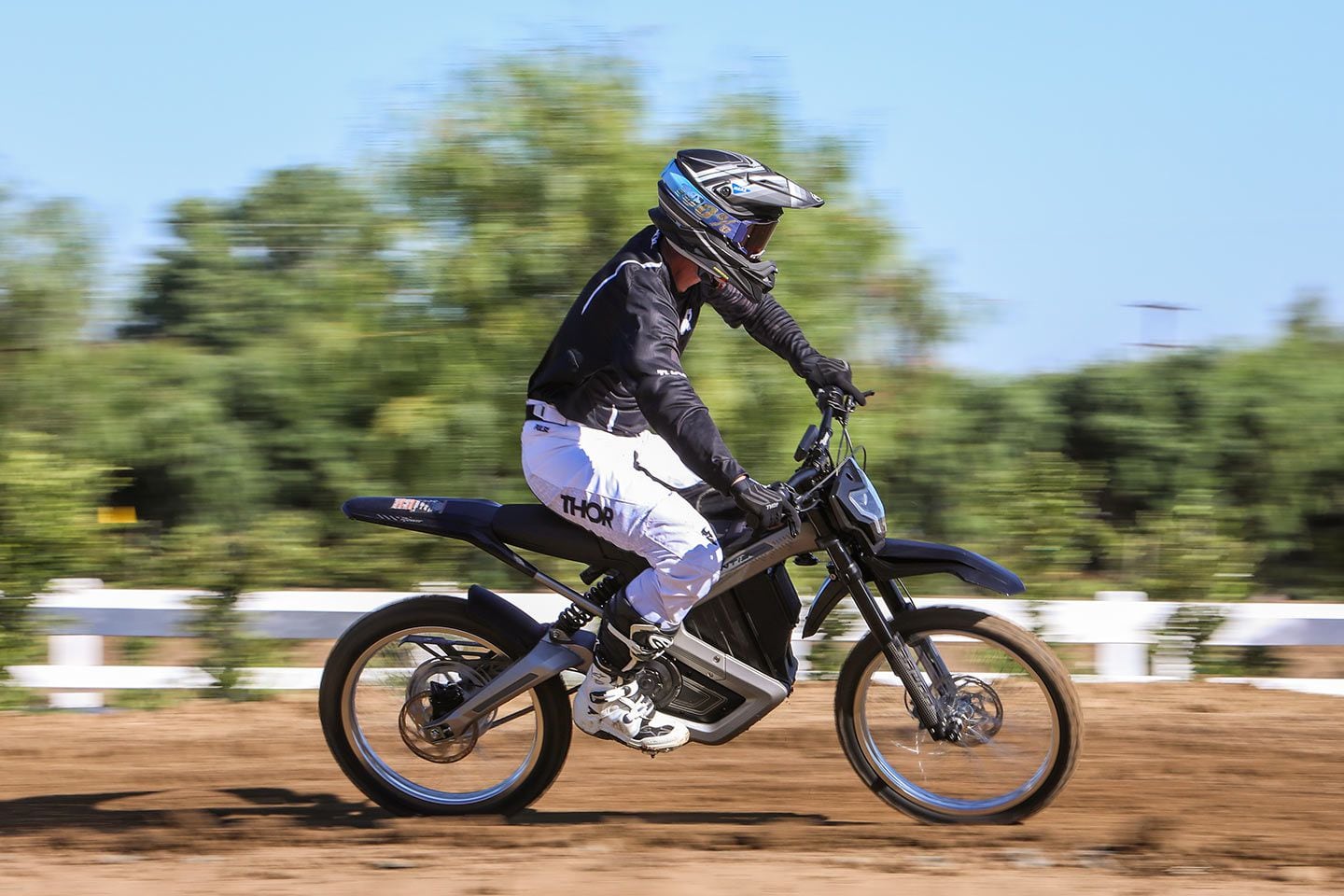
Riding the Rawrr Mantis 72V at the Blackmore Ranch in Menifee, California. (Rawrr/)2024 Rawrr Mantis 72V Motor
The Rawrr Mantis electric powerplants claimed maximum of 7,500 watts is equal to 10.1 hp. It’s a solid horsepower number with the size and mission of the bike, but the fun begins when you find out the motor produces a claimed 37 lb.-ft. of torque right from zero rpm. For comparison, the KTM 450 XCF-W we dyno tested made 31.4 lb.-ft. of torque at 6,800 rpm. So while the Rawrr in Sport mode pushed an adult up to 50 mph, it got there in a hurry. There is an enclosed-chain, oil-lubricated reduction system between the motor output shaft and chain final drive.

The motor produces 7,500 watts of power and has an internal gear reduction system. (Rawrr/)Four different power modes tune throttle response and motor output, truly changing the character of the bike. Eco 1 is the perfect mode for first-time riders, offering soft throttle response and 20 mph top-speed limit. It is also ideal for loading and unloading with a little power assist. Eco 2 pumps it up a little in throttle response to give beginners learning to ride a fun but mellow space to explore the Mantis’ performance, while also offering top speed. Eco 3 adds more throttle response and full top speed, but is still designed to maximize battery life. Sport mode is full power with maximum acceleration and top speed. This mode is for experienced riders who are not concerned about range or battery life.
One unique feature: The Rawrr Mantis has reverse.
2024 Rawrr Mantis 72V Suspension
The Rawrr Mantis utilizes KKE suspension, a brand and type that’s been used on downhill mountain bikes and also Sur-Ron and other e-motos. New on the 72V is that the inverted fork uses a metal spring in the left leg and air springing on the right. So the rider can vary air pressure as well as adjust the metal-spring preload. Rebound-damping adjustment keeps it in check. The shock is fully adjustable, and preload is tweaked using a threaded collar. The Rawrr comes with a mini tool chest to make these adjustments and other work on the bike easy.
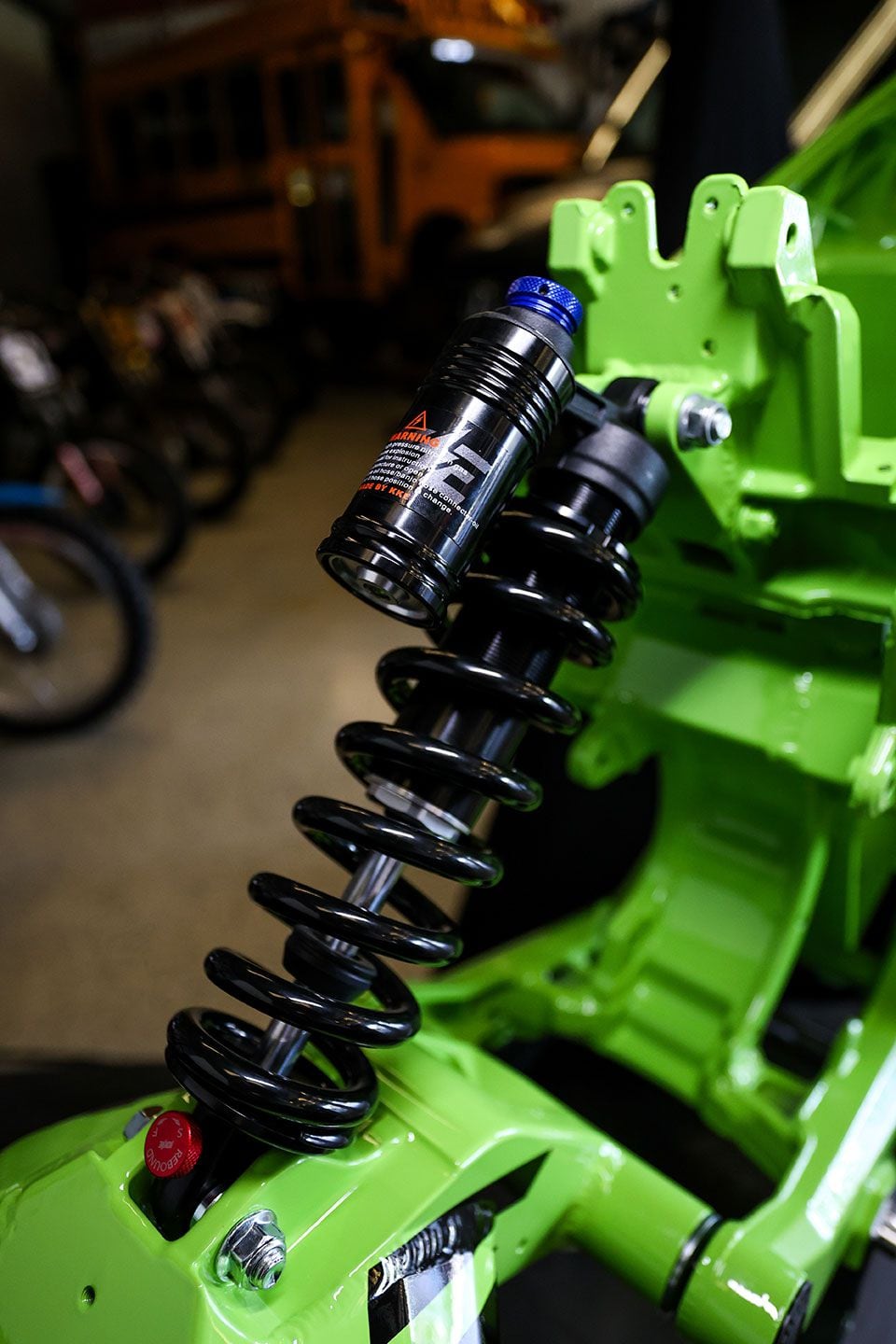
Rawrr’s Mantis 72V features a fully adjustable rear shock. (Rawrr/)Rawrr specs the suspension with all-steel internals versus the aluminum used in some applications. While this does add a little weight, Rawrr believes the added strength and reduced failures are worth the trade-off. The suspension does have more of a motorcycle feel than a mountain bike feel.
2024 Rawrr Mantis 72V Chassis and Handling
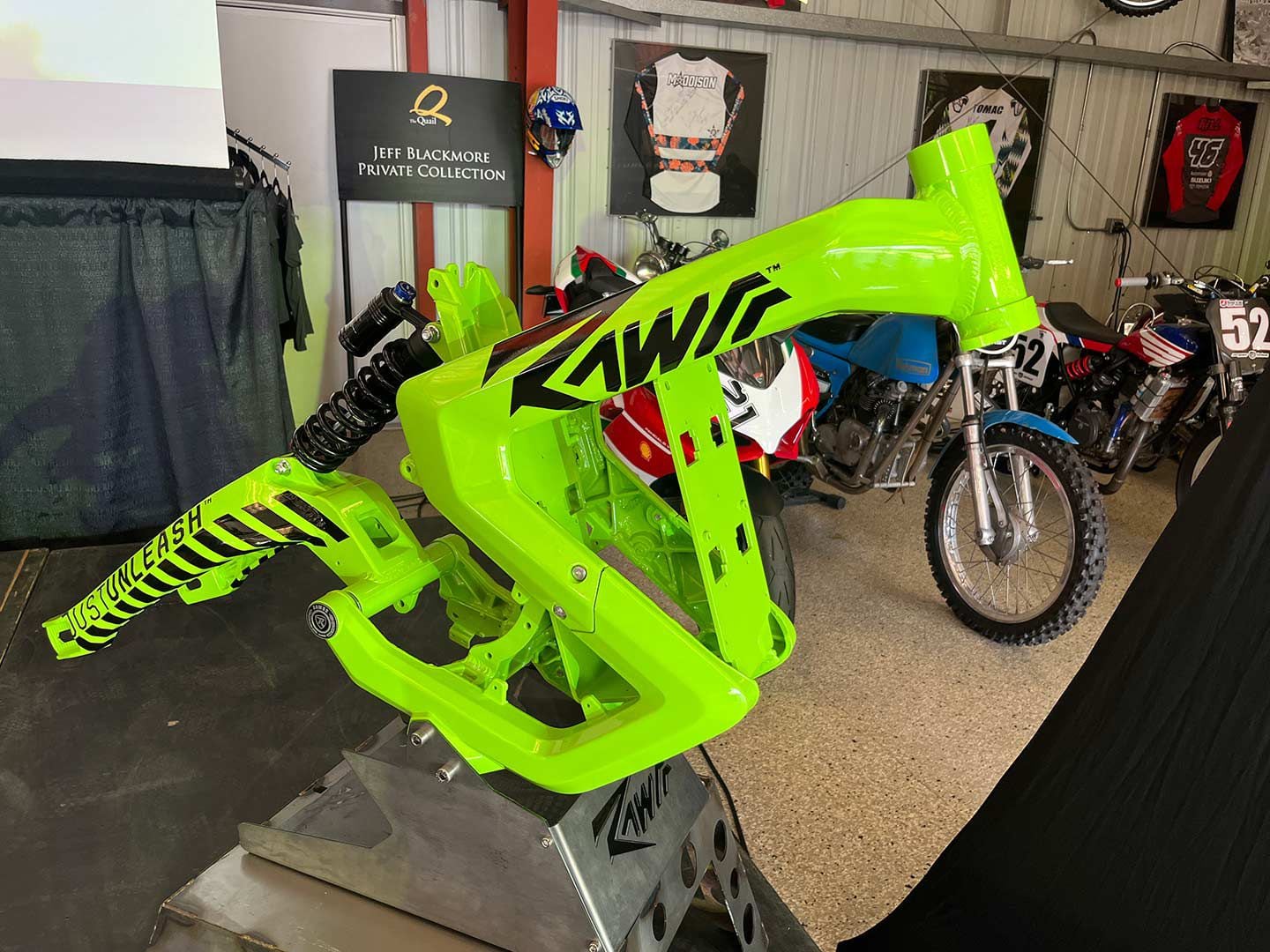
Mantis: The world’s smallest apex predator. The frame is the same shape as the front claws of the Mantis. (Rawrr/)The Rawrr Mantis is built for fun, but this is not a toy. It is designed with a stout aluminum frame and swingarm. The subframe is also designed with off-road riding in mind and allows for a more extended rear fender for added protection from roost/rocks, mud, and water.

This is with the optional bar risers for taller riders. (Rawrr/)Rider ergonomics were very much tuned to give a motorcycle feel. It uses a motorcycle-style stem with three different bar positions fore/aft and optional bar risers for taller riders.
The battery is placed low and in front of the motor to keep the center of gravity down and allow for a lower seat height and increased ground clearance. The 33.5-inch seat height is achieved in part by a cutdown section near the front that makes for a noticeable step between there and the rear part of the seat. Essentially, theory here is full-size humans will end up sitting on the tall part, and the cutout part allows shorter riders to get feet planted on pavement when stopped.
2024 Rawrr Mantis 72V Overall Impression

With a 175-pound rider a 25-to-30 minute moto is possible on a full charge. (Rawrr/)The previous version of the Rawrr Mantis was said to be slightly underpowered. It is not underpowered with the larger 72V battery. Acceleration was quick and top speed has increased to an actual 50 mph with a fully charged battery.
In Sport mode, power loss only becomes noticeable below 50 percent charge. With a 175-pound pilot riding at full power, we found that you can expect 25 to 30 minutes out of a charge in Sport mode. On the other end of the spectrum, in the mellow Eco 1 mode, range is said to be approximately 75 miles at 20 mph. We didn’t get a chance to test that in this first ride but intend to get a 72V for a more thorough evaluation.
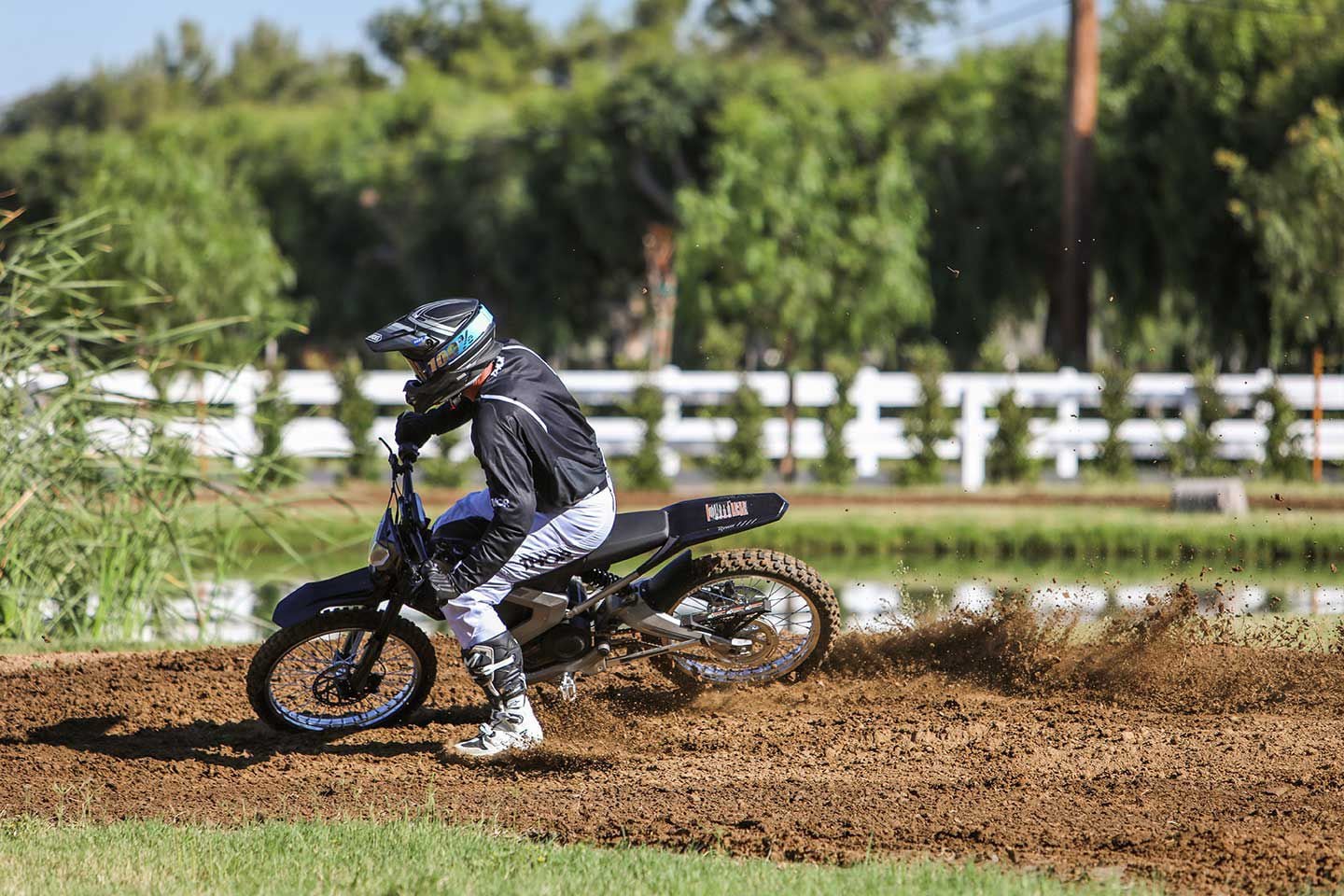
With a full battery, the Rawrr Mantis 72V has enough power to build some berms. (Rawrr/)The suspension is surprisingly capable. While it is not motorcycle suspension in the truest sense of the word, it can handle decent hits. Bottoming is very noticeable but not painful.
The brakes are adequate but not strong. There is some brake fade under heavy, race-oriented use. With the Rawrr’s newly added battery weight, additional braking power and fade resistance would be nice. But, hey, I was riding this at a max pace. For anything but full race mode the bike is a lot of fun and very predictable, with nice control feel and good damping.
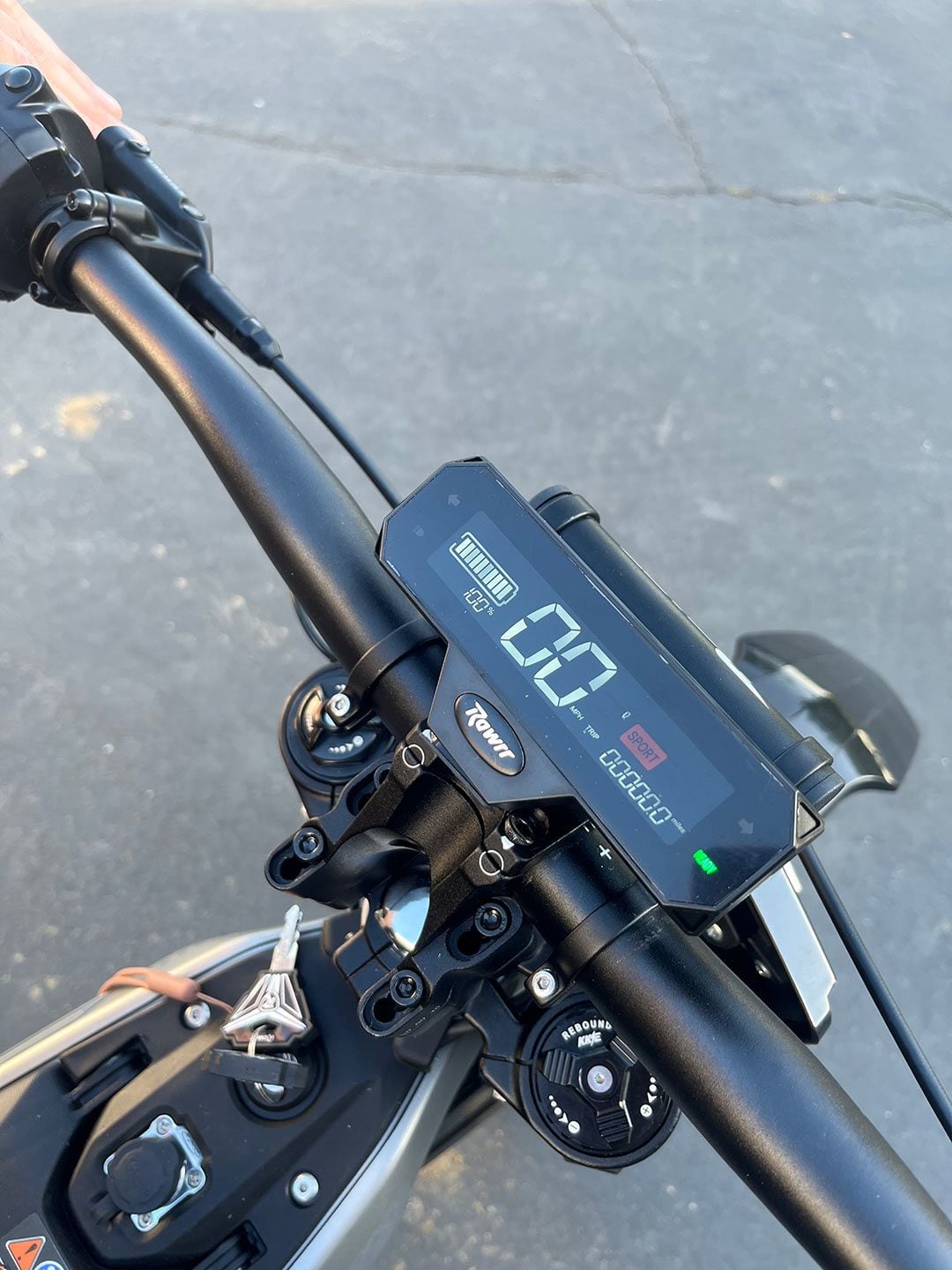
The Rawrr has a simple-to-use, easy-to-read display with battery life, speed, riding mode, and an odometer. (Rawrr/)At 5-foot-10, I found the Rawrr’s ergos to be good, except for that stepped seat. When riding, the drop in the middle is far too low. A flat seat front to back would allow the rider to move around much easier. Rawrr representatives acknowledged this and said a new flat seat option would be available shortly and would be standard in 2024. Another accessory soon to arrive is a 21-inch front wheel. While a 19-incher is fine for most, hardcore riders are asking for a 21.
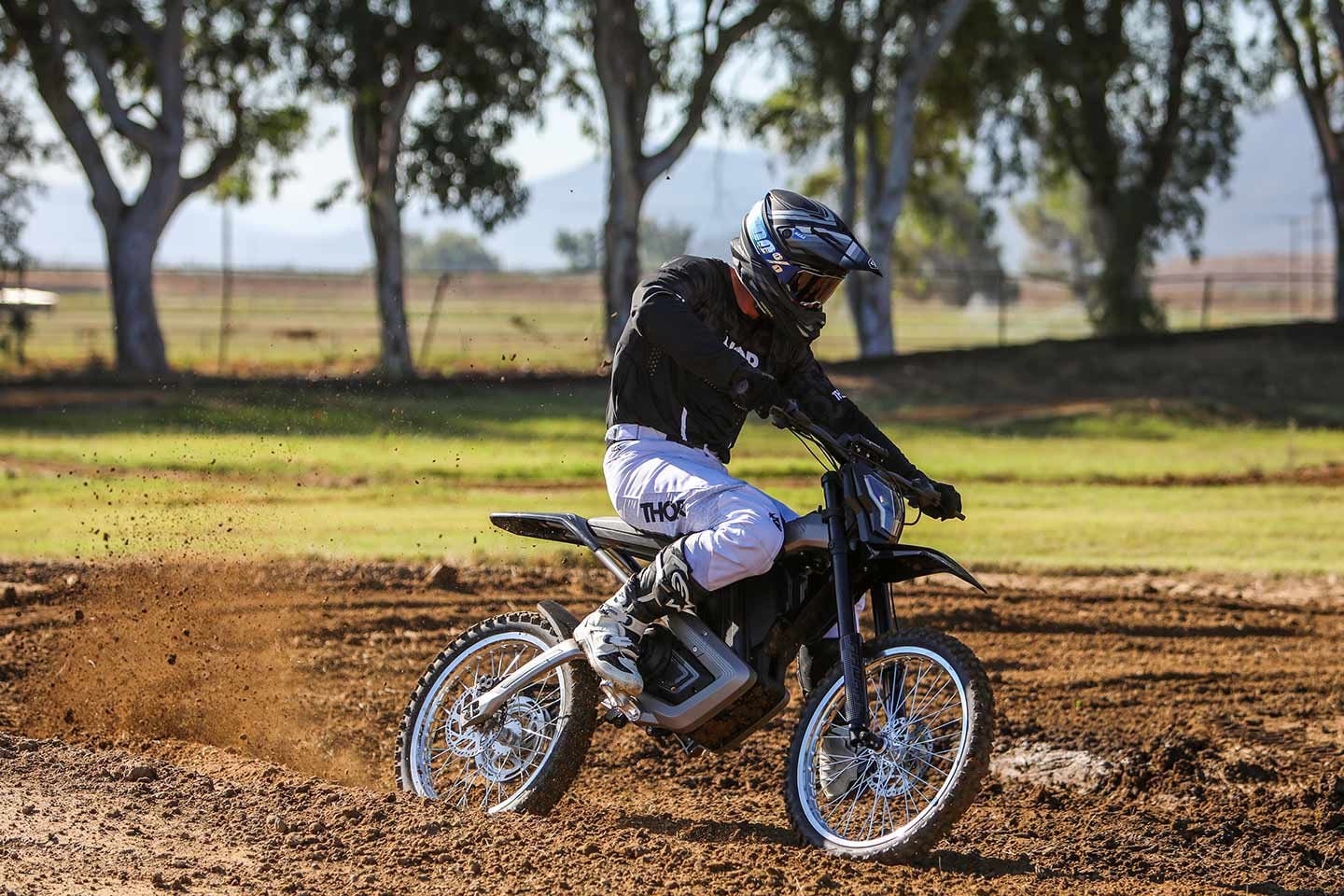
The Rawrr Mantis is small enough for small guys yet big enough for adults to ride. (Rawrr/)Overall, the Rawrr Mantis is an absolute blast to ride. It feels and handles much more like a motorcycle than other e-moto bikes we’ve tested. It’s small enough to be easy to handle but big enough for a pro-level adult to hammer on it. Its very low noise makes it unobtrusive to neighbors if you have room for a backyard moto, and is priced half of some high-end e-mountain bikes. The Mantis is perfect for off-road and light trail riding, and can even cross over into low-key track riding.

Rawrr’s founder wanted a name that represented youthful and aggressive enthusiasm. His daughter walked through the meeting room with her stuffed dinosaurs and went, “Rawrr!” And that was it. (Rawrr/)Sur-Ron has become a pretty big name in the space and the Mantis compares favorably on paper as the Sur-Ron offers a 60-volt battery and 5,000-watt motor and costs $4,400. Yes, the Rawrr 72V is 160 pounds compared to the 120 or so of the Sur-Ron, but there’s just more juice and we’d take that every time. We’d still love to ride these bikes (and a few more) back to back to see just how much fun a new generation of riders will have getting on two wheels, and how far a group of more experienced testers can push them. If that sounds like fun, expect this segment of light e-moto to keep growing.
2023 Rawrr Mantis 72V Specs
MSRP: $4,999 Motor: PMSM (Permanent Magnet Synchronous Motors) Rated Capacity: N/A Maximum Power: 7,500W Maximum Torque: 50 Nm (36.9 lb.-ft.) Maximum Speed: 50 mph Battery: Swappable Samsung lithium 35Ah Voltage: 72V Charging: AC90/264V Charge Time: 3–6 hours Transmission: 1-speed, internal, motorcycle-style gears Frame: Aluminum alloy Front Suspension: Inverted fork, rebound and preload adjustable; 7.9 in. (200mm) travel Rear Suspension: Monoshock, rebound, compression, and spring preload adjustable; 3.0 in. (75mm) travel Front Brake: Hydraulic w/ 203mm disc Rear Brake: Hydraulic w/ 203mm disc Wheels, Front/Rear: 19 in./19 in. Tires, Front/Rear: 70/100-19 / 80/100-19 Steering Head Angle/Trail: N/A Wheelbase: 50.8 in. (1,290mm) Ground Clearance: 12.2 in. (310mm) Claimed Seat Height: 33.5 in. (850mm) Claimed Wet Weight: 165 lb. Contact: riderawrr.com -
A few tweaks here and there turn the dual sport into a more road-focused machine.
-

Kevin Cameron has been writing about motorcycles for nearly 50 years, first for <em>Cycle magazine</em> and, since 1992, for <em>Cycle World</em>. (Robert Martin/)Reader “Odal” has written to deplore the lack of passing in MotoGP, to speculate that abolishing aero devices might restore passing, and to say how much more enjoyable Moto3 is to watch. Many would agree. In conversations at club races (Loudon, New Hampshire) I’ve often been told by fans that they like the Novice races best—lots of “misadventures.” By comparison, the Expert events were “a snore.”
How could it be any other way? The Experts have learned they must finish, that trying is not as effective as knowing how, and that they must maintain a margin to achieve winning consistency. The Novices, at lower levels of maturity, are obliged to guess and so are often wrong.
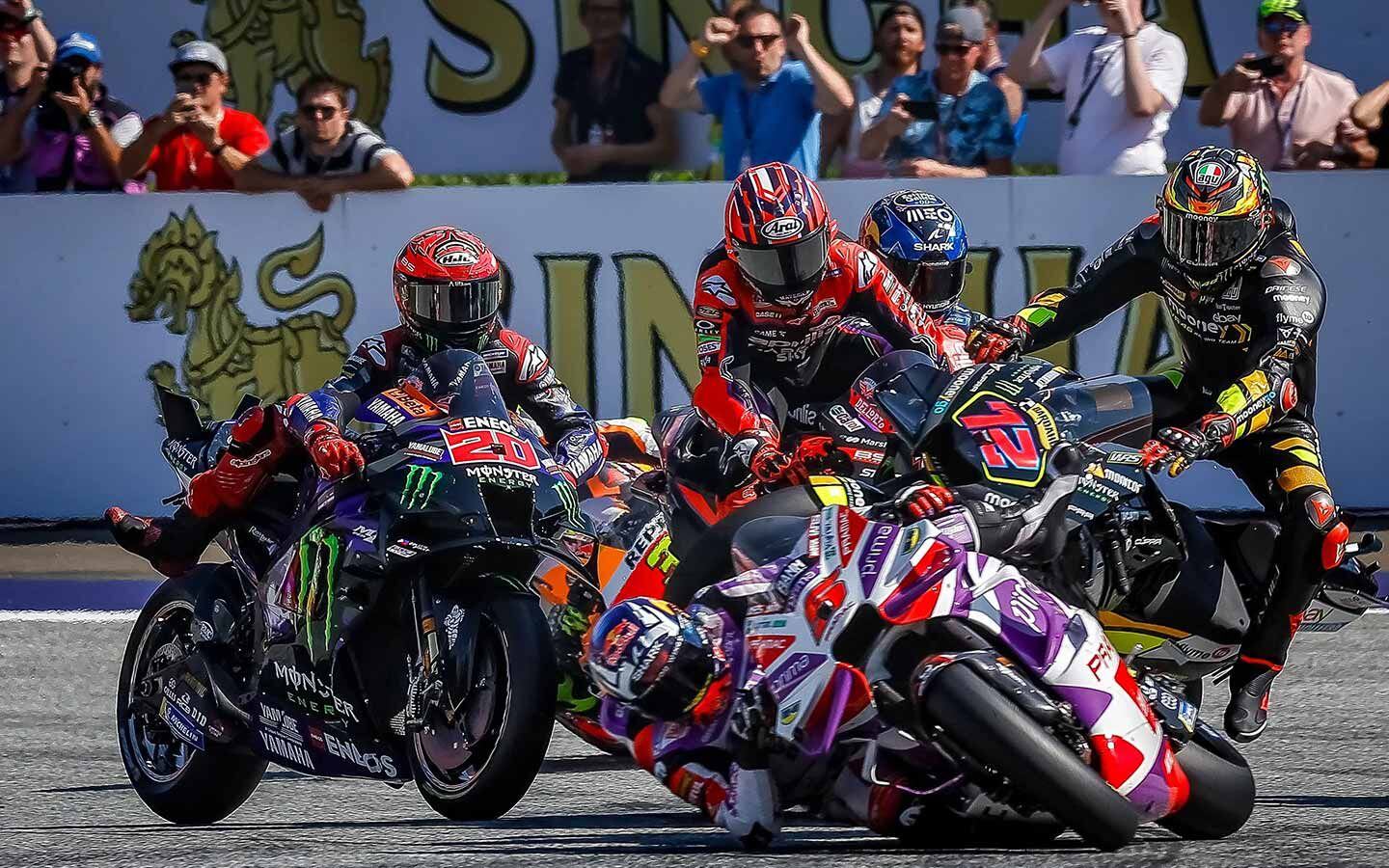
Even the experts get it wrong… (MotoGP/)Back in the days of two-stroke GP racing there were always many more rider errors and crashes in the 125 class, and this has carried over into today’s Moto3 class.
Also, it must be admitted that people’s ideas of what constitutes entertainment may vary. Years ago, during the 1970s era of the Yamaha TZ750, one of the top riders brought a friend to a race weekend (at Mosport, west of Toronto). When the friend asked about good places to watch, he recommended Moss Corner as the place to see intense braking contests.
“Nah, nah,” the friend said. “Just tell me where I can see the best accidents.”
Related: Technologies That Revolutionized Modern Motorcycling, Chapter 3
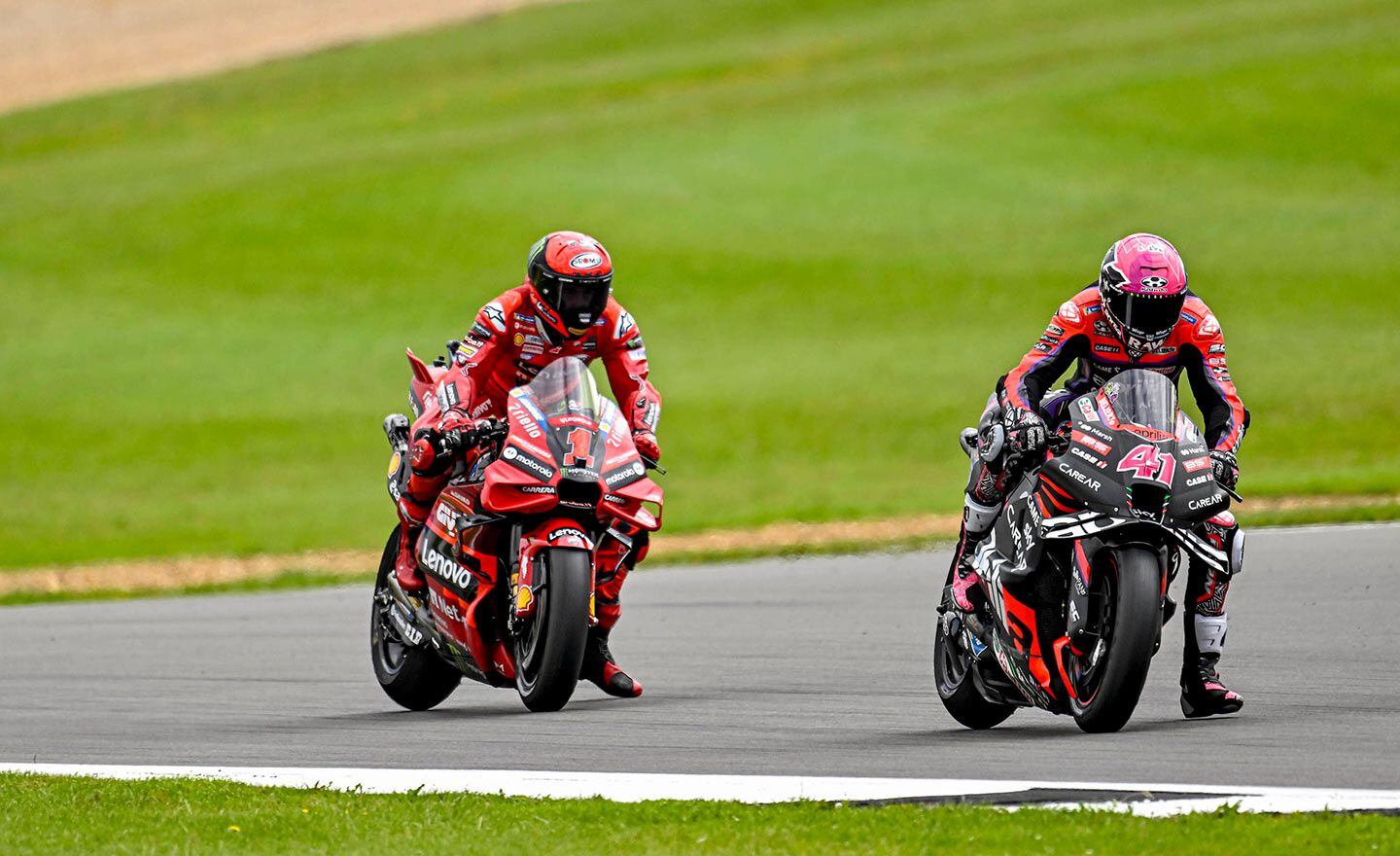
Passing has become more difficult, but not just because of the aero packages and heat saturation of tires in the draft. Racers have become better at anticipating the actions of the riders behind them. (Aprilia/)If indeed there is less passing now than in some previous time, I would suggest that the uniformly high level of rider skill and equipment is the cause. MotoGP riders themselves have commented that the 10–12 top riders are so equally matched and all on factory-engineered racebikes, the person you are trying to overtake is just as skilled at anticipating and blocking your moves as you are at planning and making them.
Banning effective technologies risks turning racing into a vintage activity that falls behind the production bikes for sale in showrooms.
-
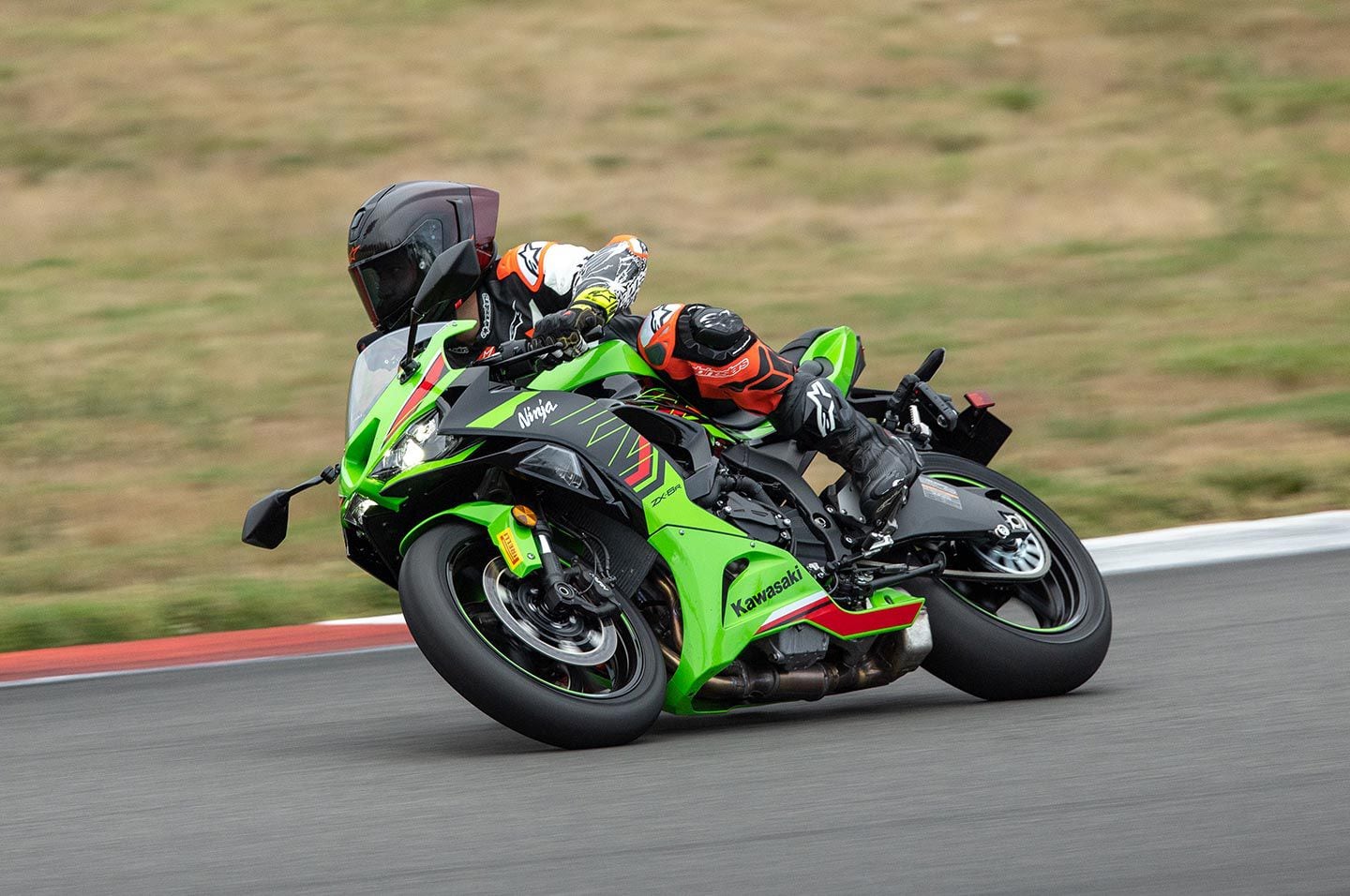
The 2024 Kawasaki ZX-6R. Through subtle updates, Kawasaki is looking to give riders a modern, but still affordable, middleweight supersport option. (Kevin Wing/)Imagine, for a moment, that you’re ready to buy a new bike. You spent the last few years getting up to speed on a Ninja 400. It’s lightweight, flickable, and fun. You’ve done a few trackdays on it and are in the canyons every other weekend. But you’ve outgrown the bike. It’s time to move on. Where to now?
Enter the Kawasaki ZX-6R, a bike that Kawasaki says is integral to its lineup, not because of the racing success it once brought to Team Green, but because of the steppingstone that it offers today’s street riders.
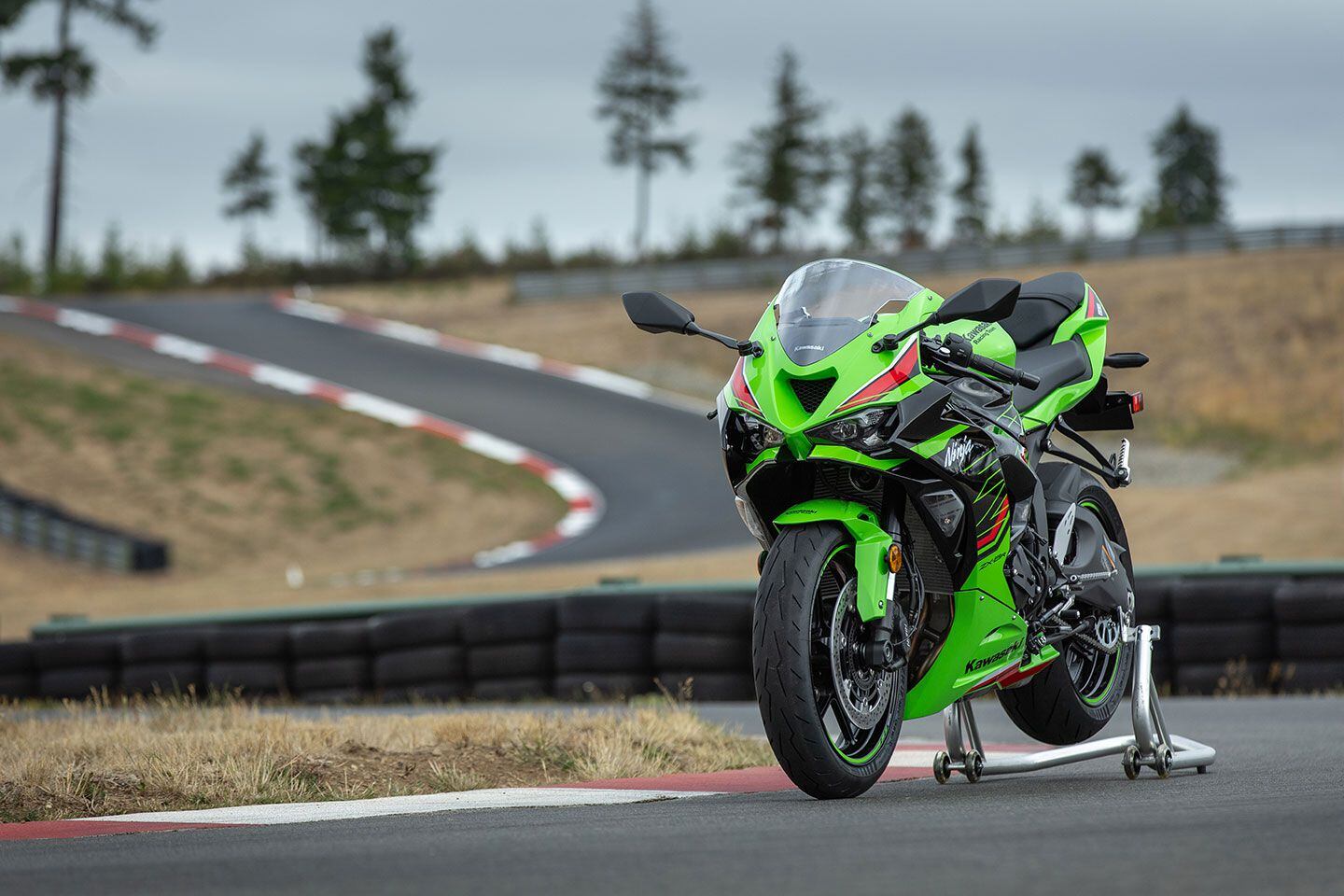
The ZX-6R gets a new look, courtesy of restyled front and side cowls. (Kevin Wing/)There are still plenty of sportbike enthusiasts out there, Kawasaki suggests, and while their ultimate goal is to be on a literbike, most aren’t in a hurry to make that leap. If Kawasaki wants to sell ZX-10Rs to the rider who started on a Ninja 400, then it’s best to have a 600 that keeps them in the family. The only thing more important than earning new customers is retaining the ones you have—for as long as you can.
About the Bike
Kawasaki didn’t need to reinvent the wheel when it came time to update the ZX-6R, given that the only genuine middleweight competition is the Suzuki GSX-R600 ($11,899) and US-spec Honda CBR600RR ($12,099), both of which had already fallen behind the ZX-6R from a technological standpoint. That doesn’t mean customers couldn’t go elsewhere, which is why Kawasaki felt the need to invest at least some resources into the platform. Looks sell, after all.
Related: 9 Middleweight Sportbikes You Can Buy in 2023
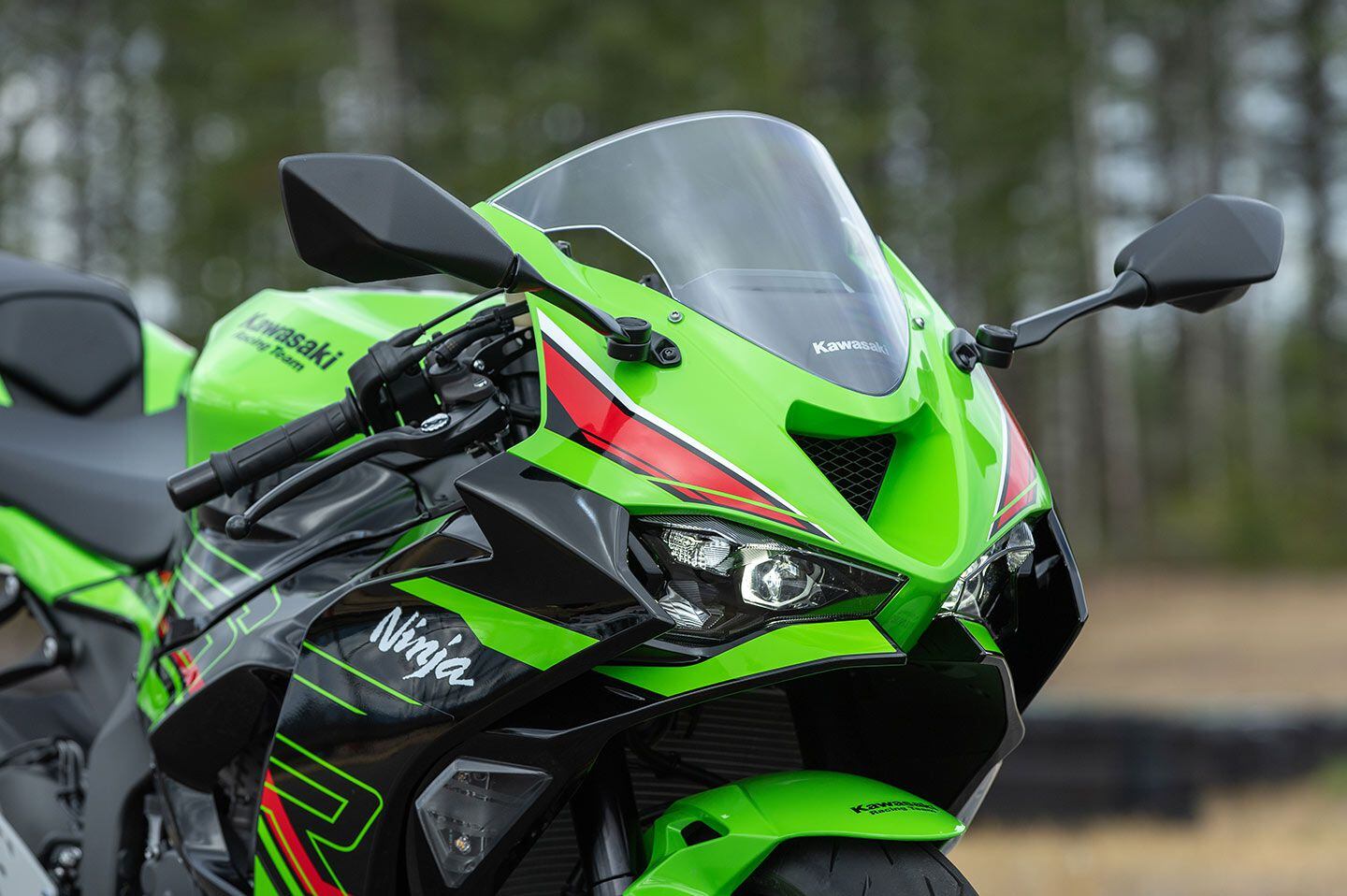
Closer look at the ZX-6R’s new face. Kawasaki says the holes in the windscreen relieve pressure buildup behind the screen to help reduce buffeting. (Kevin Wing/)The updated design is inspired by the ZX-10R, and distinguishes itself from the outgoing ZX-6R through a combination of new front and side cowls. The fairings are mostly intended to sharpen the look, but provide a very small aerodynamic advantage, according to Kawasaki representatives. Keen eyes will notice the updated windscreen, new LED lights, and blacked-out engine covers. The tank, seat, and tailsection are unchanged.
Throw a leg over the ZX-6R and you’ll notice the next addition: a 4.3-inch full-color TFT display that’s simple in design, but an obvious upgrade over the LCD display and analog tachometer found on the previous-generation ZX-6R. Nothing can date a bike more than an antiquated dash (it’s the thing you’re constantly looking at as you ride!), and given that TFTs have already made their way into the entry-level, small-displacement category, it only makes sense to have one here. The wait was worth it, as the dash gives the new ZX-6R a more modern look.
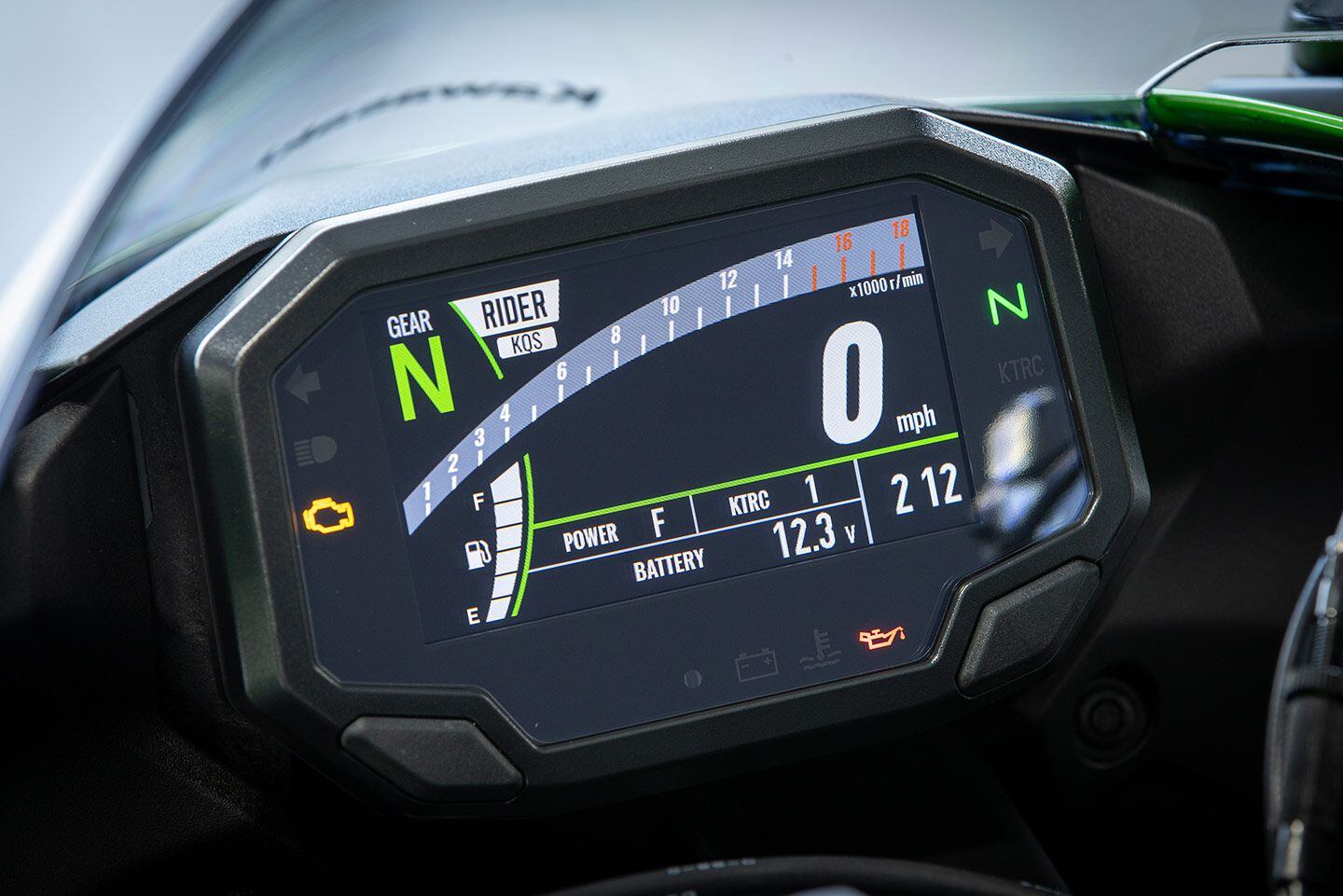
The 4.3-inch TFT display gives the ZX-6R a modern look with bright colors and bold fonts. Notice the Power and KTRC setting options, which can be adjusted only when in the (shown) Rider mode. (Kevin Wing/)In another effort to modernize the ZX-6R, Kawasaki added three preset ride modes (Sport, Road, and Rain), each with a dedicated setting for traction control and power (Full or Low). There are three traction control levels in total; Sport mode uses TC level 1, Road TC level 2, and Rain TC level 3.
A fourth mode, Rider, is customizable and allows you to select the traction control and power settings of your choice, just as you could on last year’s bike. Important to mention is that, while integrated ride modes are new, the traction control, power modes, and electronic quickshifter software are identical to the systems found on last year’s bike.
While looks and features are important, Kawasaki had to take Euro 5 emissions standards into consideration when building the new ZX-6R. The previous model met Euro 4 standards and couldn’t be sold in Europe. The solution? New header pipes and updated cam profiles with less lift and duration, which helps with smooth running at lower rpm, but certainly won’t do anything to help top-end performance. Less aggressive cams are one strategy among many used to comply with current emissions standards.
The power curve is further manipulated by increasing the length of the middle two intake funnels by roughly 20mm, which boosts midrange performance.
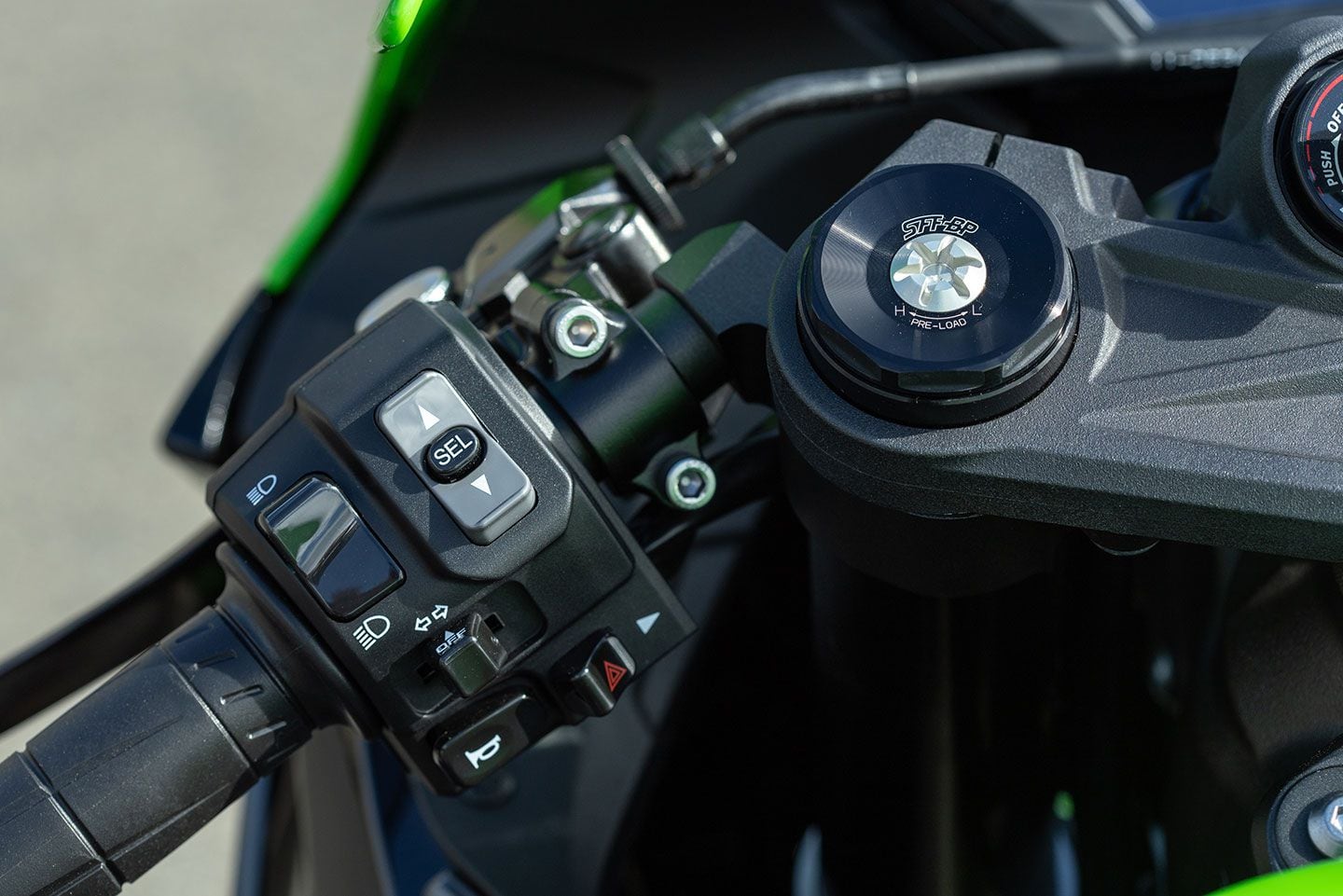
The 2024 ZX-6R uses the same switch cluster as before. An extended press down or up changes ride modes. Quick presses are for scrolling through information screens. It’s a simple but effective system. (Kevin Wing/)Midrange performance has always been a key focus for Kawasaki, who unveiled the current-generation 636cc ZX-6R in 2013 and always claimed this was a bike meant for the street rider, just as much as it was the racer or trackday enthusiast. The extra midrange grunt from that 37cc solidifies that claim.
Not a lot has changed from a chassis perspective over the years, and that continues to be the case for 2024, the new ZX-6R rolling on the same twin-spar aluminum frame as before—a design that seemingly works for Kawasaki. Given the costs associated with designing, testing, and manufacturing an entirely new frame, this comes as little surprise; added costs must be passed through to the consumer, and in the 600 class greater emphasis is placed on an affordable MSRP. A moderately more capable bike does not guarantee more sales, especially if it comes at a higher price tag.
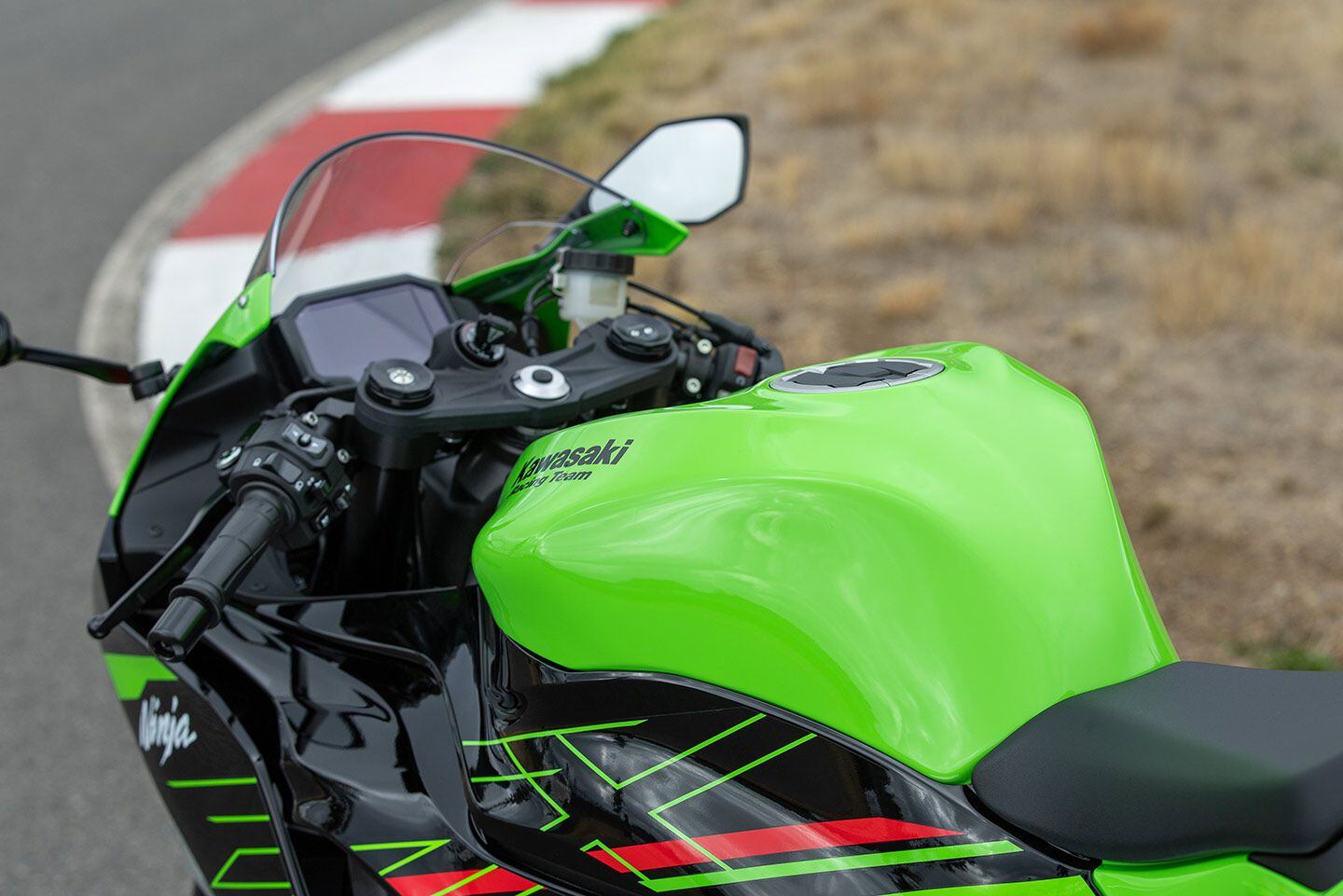
The riding position is typical for a sportbike. Tank, seat, and clip-on position are as they were before. (Kevin Wing/)Further evidence of Kawasaki’s efforts to only invest in what’s needed, the 2024 ZX-6R uses the same Showa Separate Function Fork - Big Piston (SFF-BP) fork and shock as before. It does, however, get new, 310mm round front brake discs (versus petal type) and rolls on Pirelli Diablo Rosso IV tires.
Riding Impressions
Admittedly, the ZX-6Rs that greeted us at Ridge Motorsports Park in Shelton, Washington, were shod with Pirelli Diablo Superbike Slicks rather than the Pirelli Diablo Rosso IV tires that come stock. Needed? Maybe not, but seeing a ZX-6R parked in a trackside garage, with slicks wrapped in tire warmers, just feels right. Kawasaki might have built the ZX-6R with the street rider in mind, but there’s no denying that this really is where a middleweight supersport bike looks most at home.
A supersport, of course, means aggressive rider triangle, and that’s very much the case here; a tight footpeg-to-seat gap and low-mounted, heavily angled clip-ons are great for a tucked-in riding position, but also a reminder that this bike was not designed with riders over 6 feet in mind. This only becomes a problem when adjusting your body at corner exit so that you can grab an upshift, or when trying to tuck behind the bubble down a long front straight. The same is true for Honda’s CBR600RR, but Suzuki’s GSX-R600, which we also tested recently, is more relaxed and spacious.
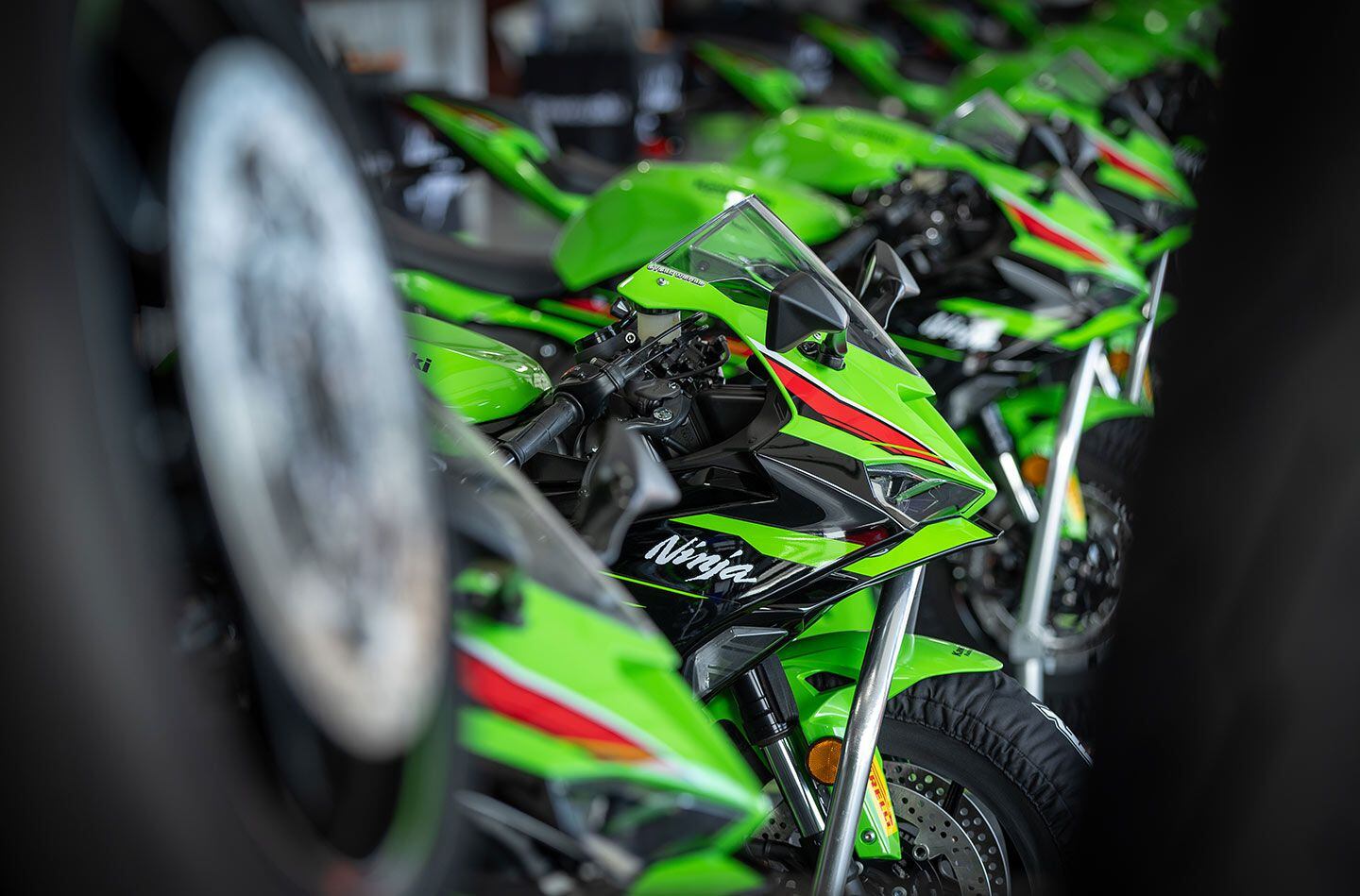
Few sights are as good as a sportbike on warmers, ready to hit the track. (Kevin Wing/)What the ZX-6R gives up in terms of “comfort,” it makes up for with that added 37cc displacement, which proved to be massively beneficial when testing a 2023 ZX-6R on the street earlier this year and is equally as beneficial at the track. It’s hard to detect the “increased” midrange performance that Kawasaki says it’s found for 2024, but the added grunt that this bike has, when compared to a more traditional, 599cc inline-four supersport, is immediately recognizable. Drive off corners is not dependent on your being pinpoint accurate with the throttle at the apex, nor do you have to be as focused on rpm. The ZX-6R is a less mentally demanding bike to ride.
Stand the bike up, aim it down a long front straight, and you’ll be greeted by the sweet sound of an inline-four rapidly building rpm. Although, admittedly, peak power arrives 500 rpm earlier than in years past, and that brings the party to a relatively sudden halt as you reach the top-end of each gear. You feel the effects of the new cam profiles at the upper limit, as the bike simply stops pulling. Fortunately, this will be less of a factor on the street.
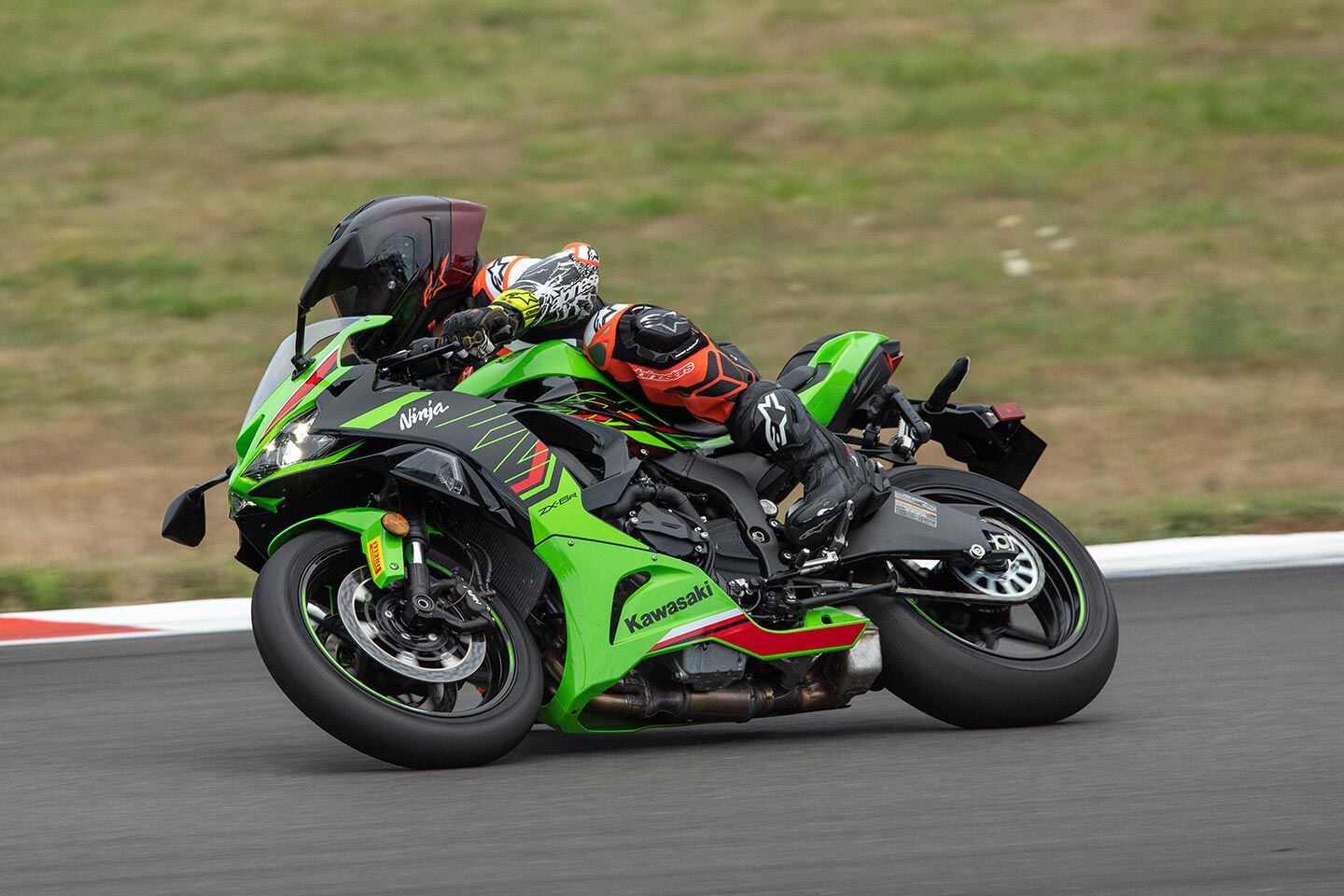
The ZX-6R frame has been carried over, because, well, it simply works. Showa suspension is best when stiffened up for track riding and works well enough for a fast trackday pace. (Kevin Wing/)A proper middleweight supersport is one that allows you to develop as a rider. You’re not fighting the budget-conscious chassis of a small-displacement bike, or having to manage 180 hp, which allows you to be more aggressive and focus on carrying good corner speed. The ZX-6R allows you to do that thanks, in part, to the well-balanced chassis that remains planted at full lean, while offering great feedback to the rider.
If there’s any shortcoming, it’s in the Showa suspension, which needs to be stiffened up for track riding, and never really feels as composed as you’d like it when really being pushed. Kawasaki reminds us that this is something it has to consider when building a suspension setup for a bike that will spend a lot of time on the street, and that there are some great aftermarket options for the serious trackday rider or racer.
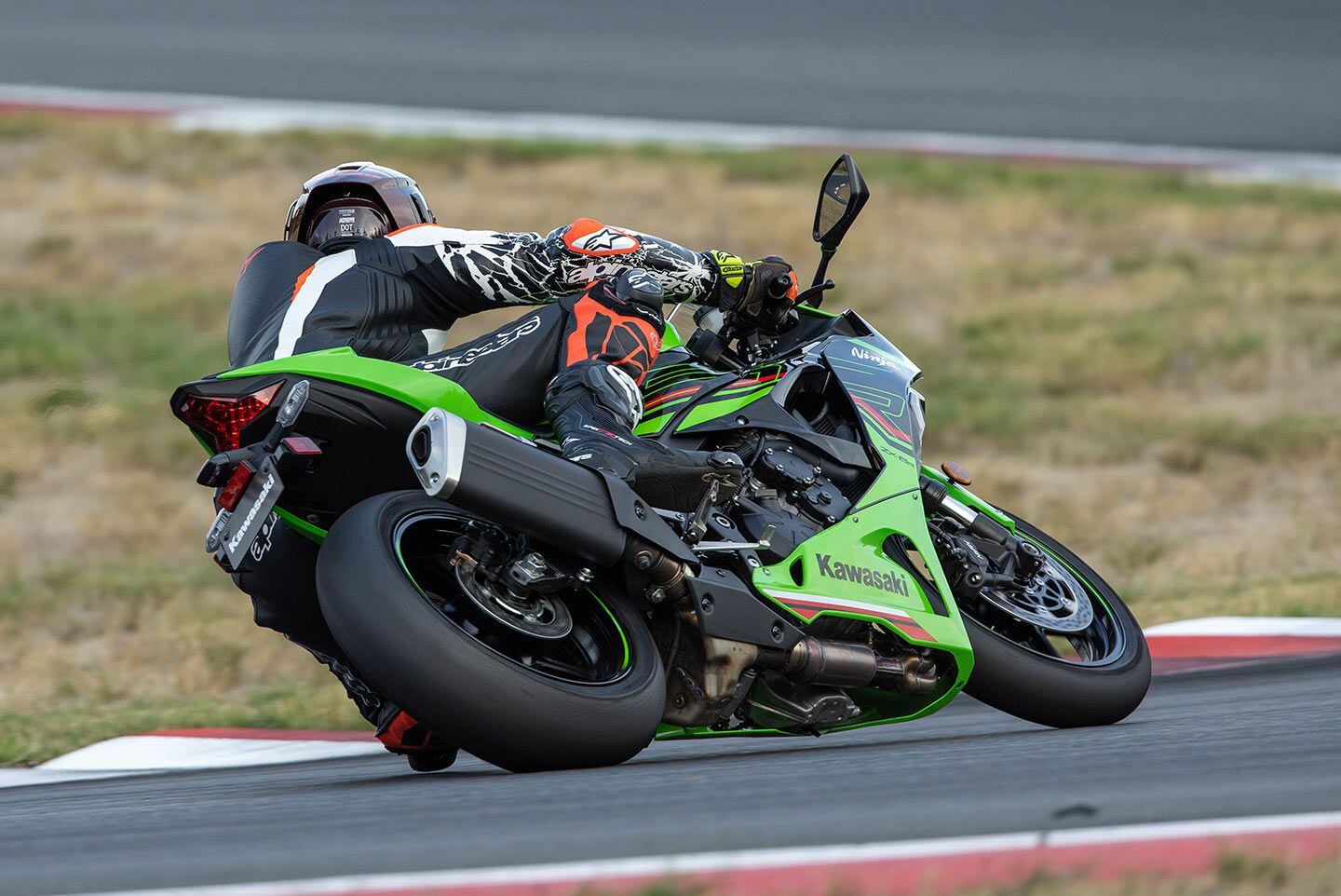
Just visible is the ZX-6R’s new header pipe, one of a handful of changes intended to help the bike meet Euro 5 emissions standards. Additional changes include new camshafts and updated intake funnels. (Kevin Wing/)We might also recommend upgraded brake pads for the trackday rider or racer, as the stock brake package doesn’t have an abundance of bite in the initial part of the pull, nor a significant amount of power as you squeeze the lever. You’ll get stopped, but you can’t help but feel like, at the track especially, a little more braking performance would be useful.
Small suspension and brake qualms aside, it’s amazing how hard you can push the ZX-6R around a racetrack, with only a few clicker adjustments. Even at a fast pace, on the undulating Ridge Motorsports Park, the bike never stepped out, or warned that we were remotely near its limits. This is a bike you can go to the track with and hone your skills as a rider.
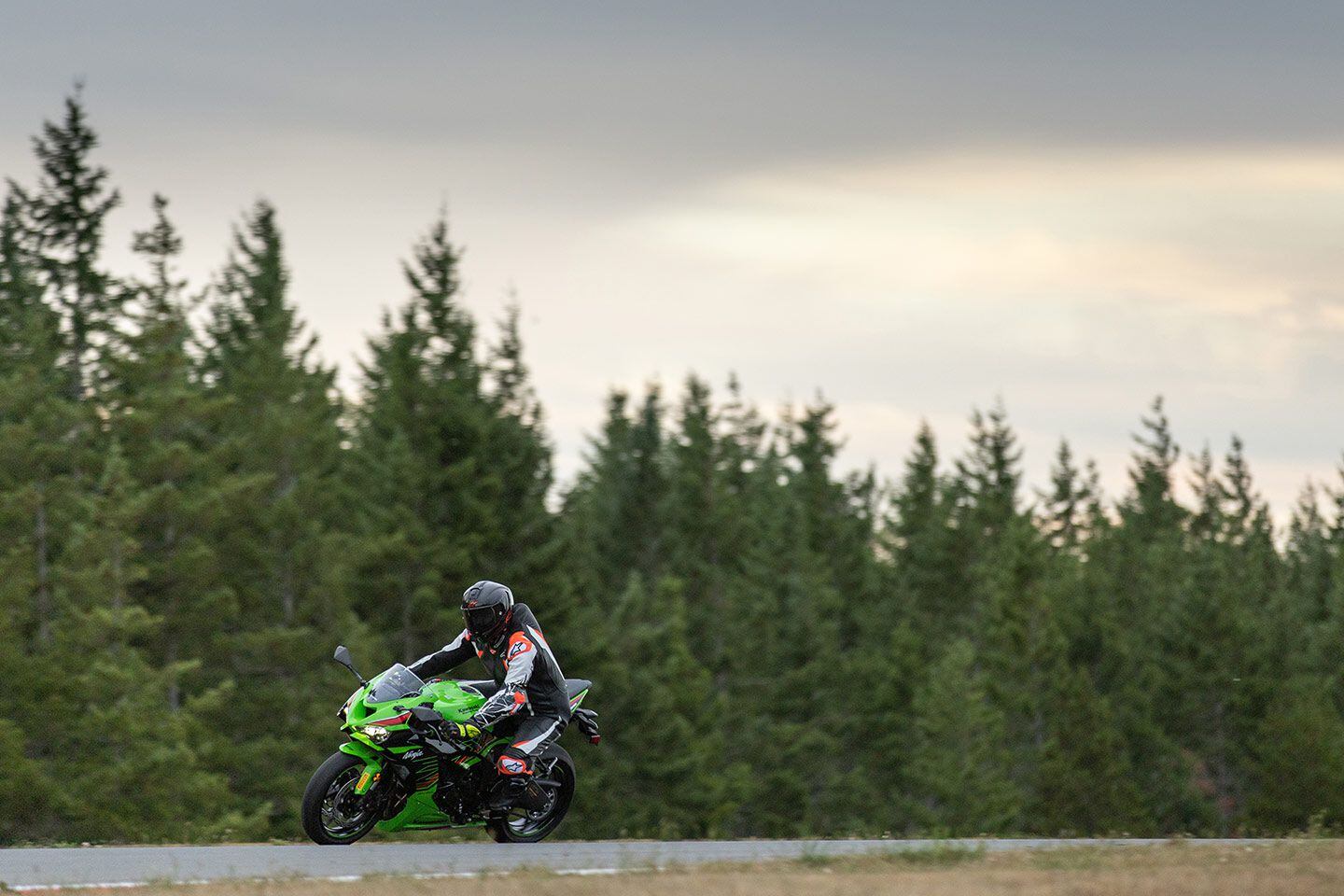
No major changes to the ZX-6R brakes for 2024, hold for round front brake discs (versus wave type). The braking package gets the job done, but doesn’t have the awe-inspiring stopping power some as newer braking packages elsewhere in the sportbike world. (Kevin Wing/)Electronics play a role in keeping the ZX-6R in line, but are about as simple as you’d like—no wheelie, slide, or engine-brake control here. There are no IMUs either; traction control relies on front and rear wheel speed, rpm, throttle position, and gear position data to get a real-time picture of traction and adapt accordingly. And it works, stepping in with short but effective cuts in power as you’re driving off tight corners and trying to put the power down. In level 2, the cut comes in earlier and lasts a moment longer, but doesn’t excessively hinder drive. So, no, it’s not the latest and greatest system, but it’s a useful safety net.
Also worth mentioning is that the ZX-6R now has Bluetooth technology built into the instrument panel, which allows riders to connect to their phone using Kawasaki’s Rideology app. Setup is relatively easy, though given the narrow scope of the electronics package, there’s not a lot to see or do in the app. Owners might like being able to access vehicle info or log their rides, however. Plus, you can get phone notices (call or email) sent to the dash. How many ZX-6R riders will benefit from getting email notifications sent to their dash? We’re not sure.
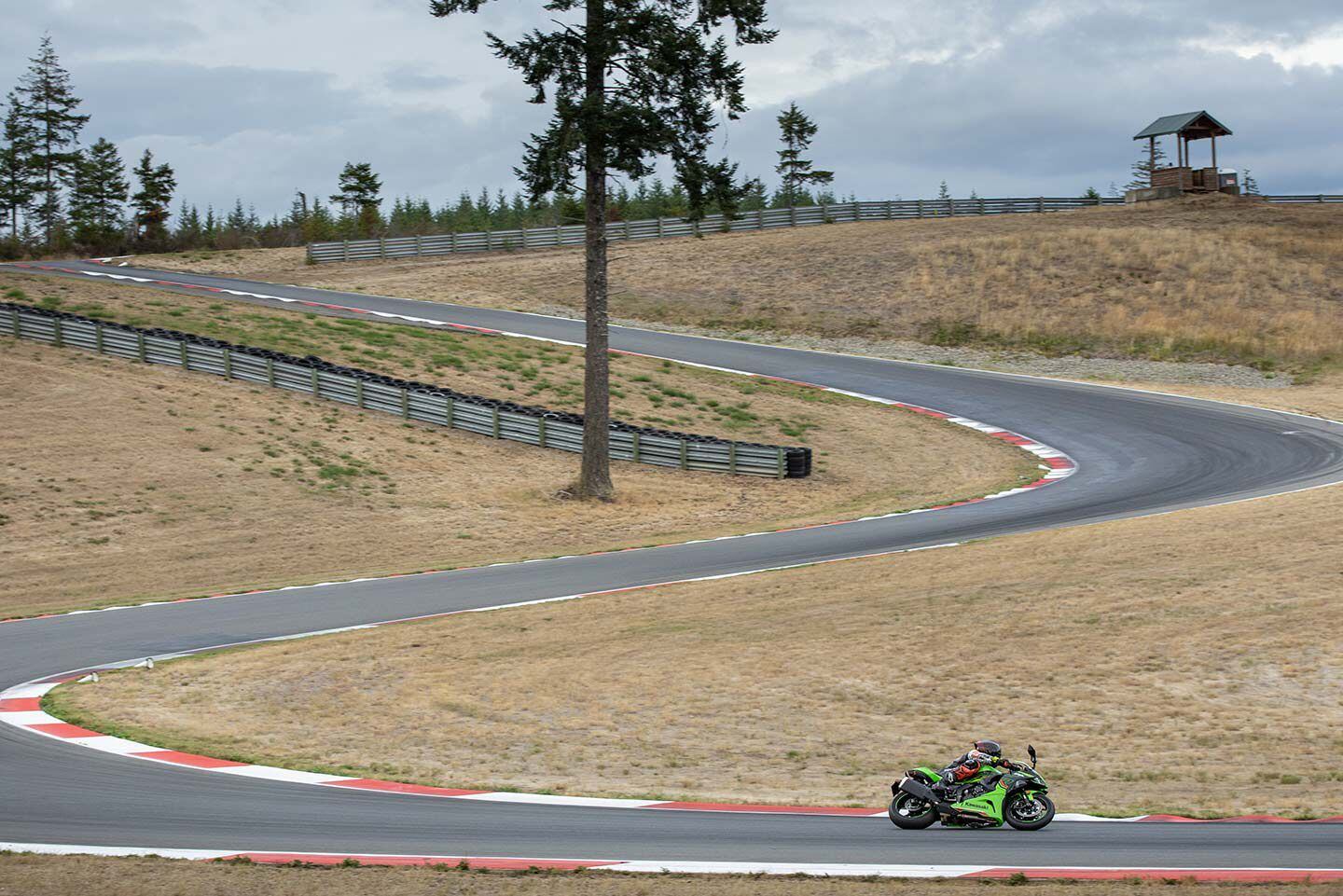
A middleweight supersport bike is the perfect tool for a technical track like Ridge Motorsports Park. (Kevin Wing/)Final Thoughts
In many ways, the ZX-6R’s electronics package is a representation of the bike as a whole; this is not the most advanced motorcycle on the market, but there’s beauty in its simplicity and in its ability to get the job done. It’s fun, still plenty fast, and has enough performance to enable riders to grow their skill set—on the street or at the racetrack.
For those shopping for a middleweight sportbike, there’s also the very important, 37cc displacement advantage to consider; small as that might seem on paper, the added midrange this offers up makes a noticeable difference in your experience.
Kawasaki hopes, of course, that this advantage, along with the new styling and modern look, will keep customers coming back for more. Given that the ZX-6R offers all of this at essentially the same price as the competition, we can’t see why that wouldn’t be the case. Consider it the most sensible option for the rider looking to take the next step in their sportbike journey.
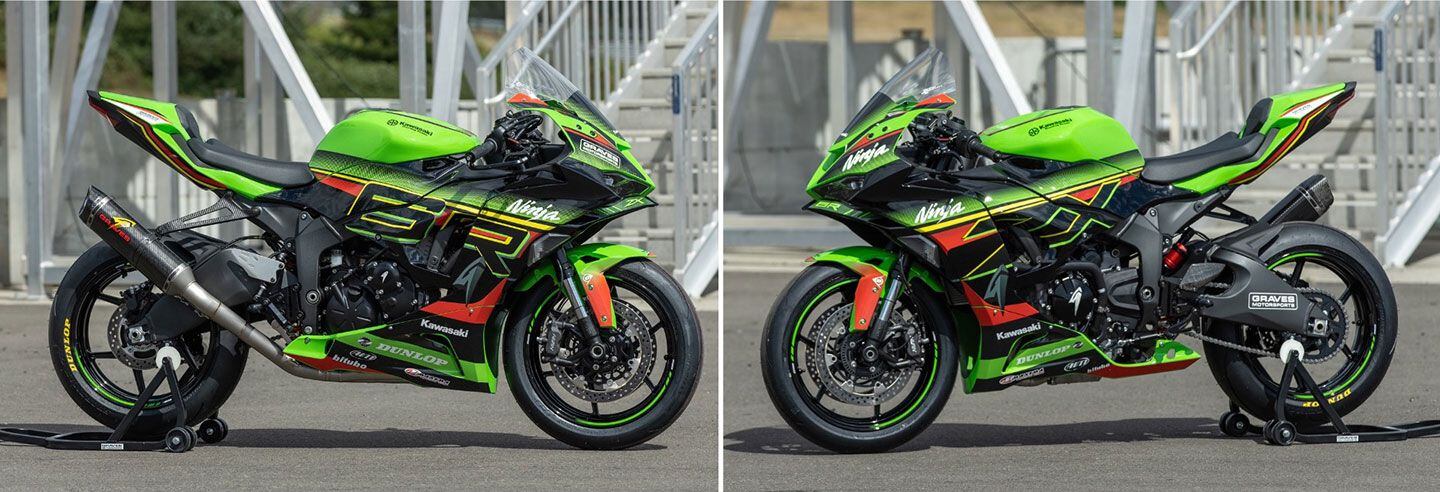
Wonder what a 2024 ZX-6R “trackday supersport” build would look like? Wonder no more, thanks to Graves Motorsports. (Kevin Wing/)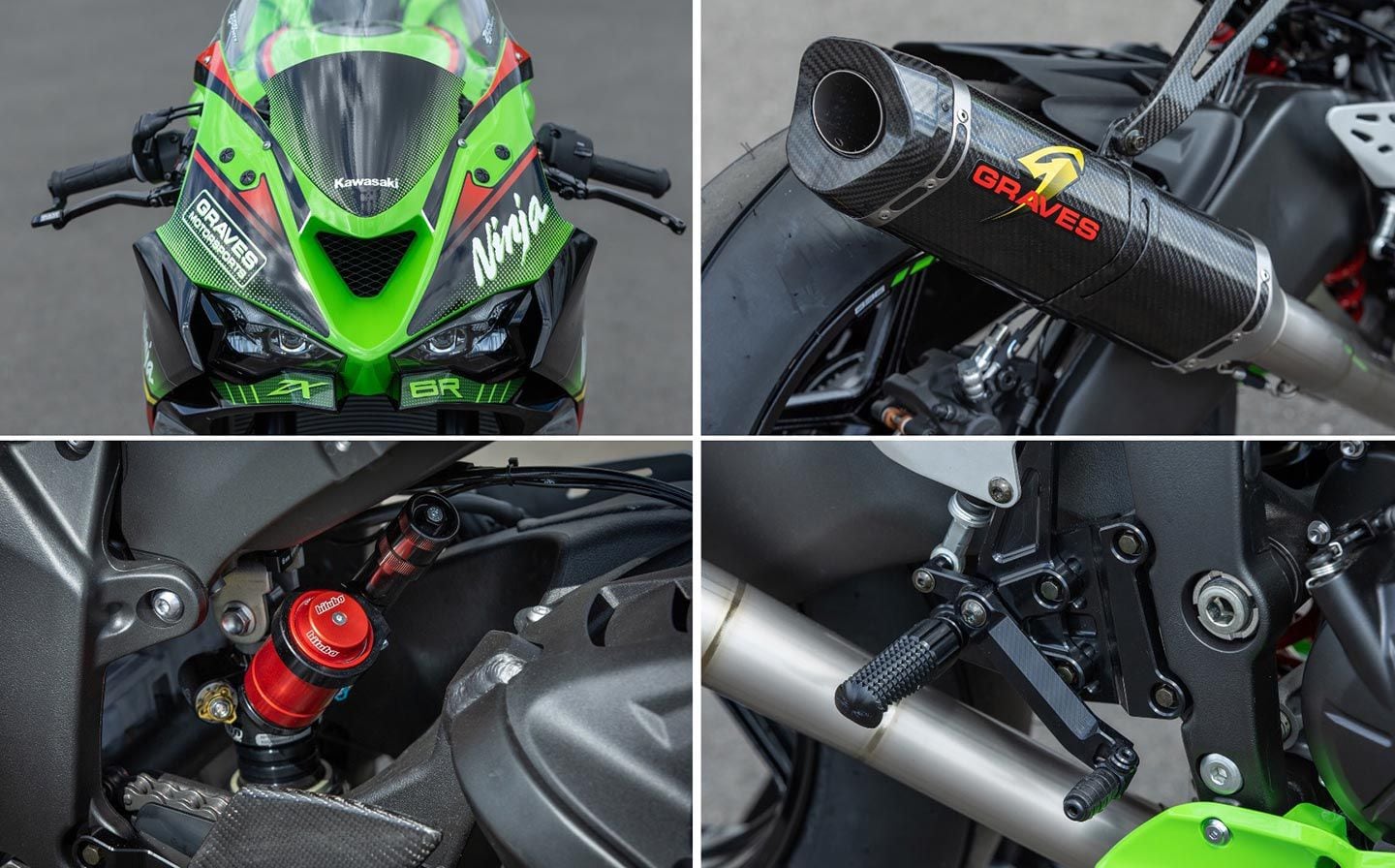
A closer look at some of the hardware on the Graves Motorsports ZX-6R build. (Kevin Wing/)2024 Kawasaki ZX-6R ABS Specs
MSRP: $11,299 (non-ABS) / $12,299 (ABS) Engine: DOHC, liquid-cooled inline-4; 4 valves/cyl. Displacement: 636cc Bore x Stroke: 67.0 x 45.1mm Compression Ratio: 12.9:1 Transmission/Final Drive: 6-speed/chain Fuel System: DFI w/ 38mm Keihin throttle bodies (4) Clutch: FCC slipper/assist Engine Management/Ignition: TCBI w/ electronic advance Frame: Twin-spar aluminum Front Suspension: 41mm inverted Showa SFF-BP fork, rebound, compression damping, spring preload adjustable; 4.7 in. travel Rear Suspension: Bottom-link Uni-Trak w/ gas-charged shock, piggyback reservoir, compression, rebound damping, spring preload adjustable; 5.9 in. travel Front Brake: Nissin radial-mount 4-piston calipers, semi-floating 310mm discs w/ ABS Rear Brake: 1-piston caliper, 220mm petal disc w/ ABS Wheels, Front/Rear: Cast aluminum Tires, Front/Rear: Pirelli Diablo Rosso IV; 120/70-17 / 180/55-17 Rake/Trail: 23.5°/4.0 in. Wheelbase: 55.1 in. Ground Clearance: 5.1 in. Seat Height: 32.7 in. Fuel Capacity: 4.5 gal. Claimed Wet Weight: 437 lb. (ABS) / 432 lb. (non-ABS) Contact: kawasaki.com 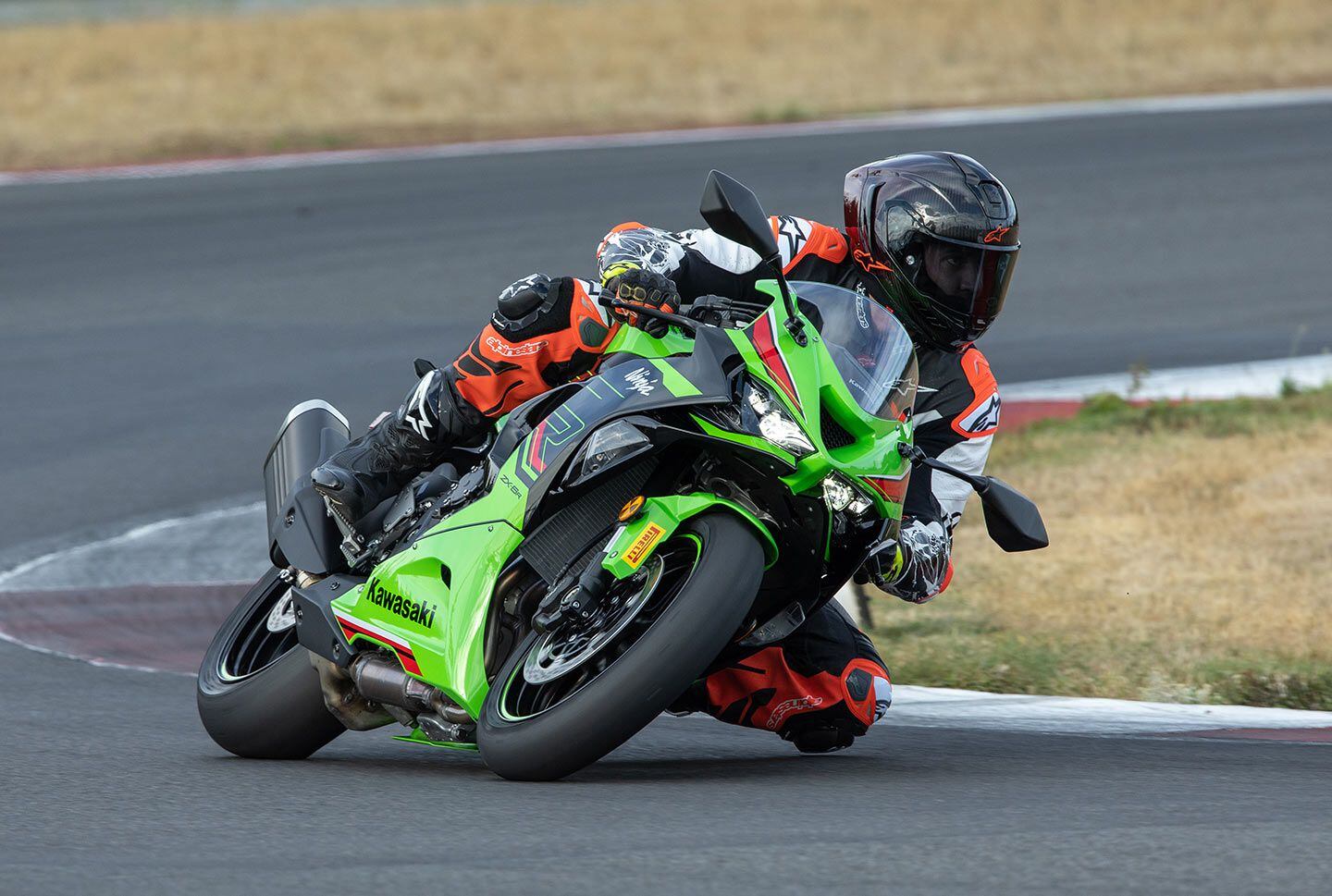
2024 Kawasaki ZX-6R. (Kevin Wing/)Gearbox
Helmet: Alpinestars Supertech R10
Suit: Alpinestars Racing Absolute V2 Leather Suit
Gloves: Alpinestars GP Tech V2
Boots: Alpinestars Supertech R
-
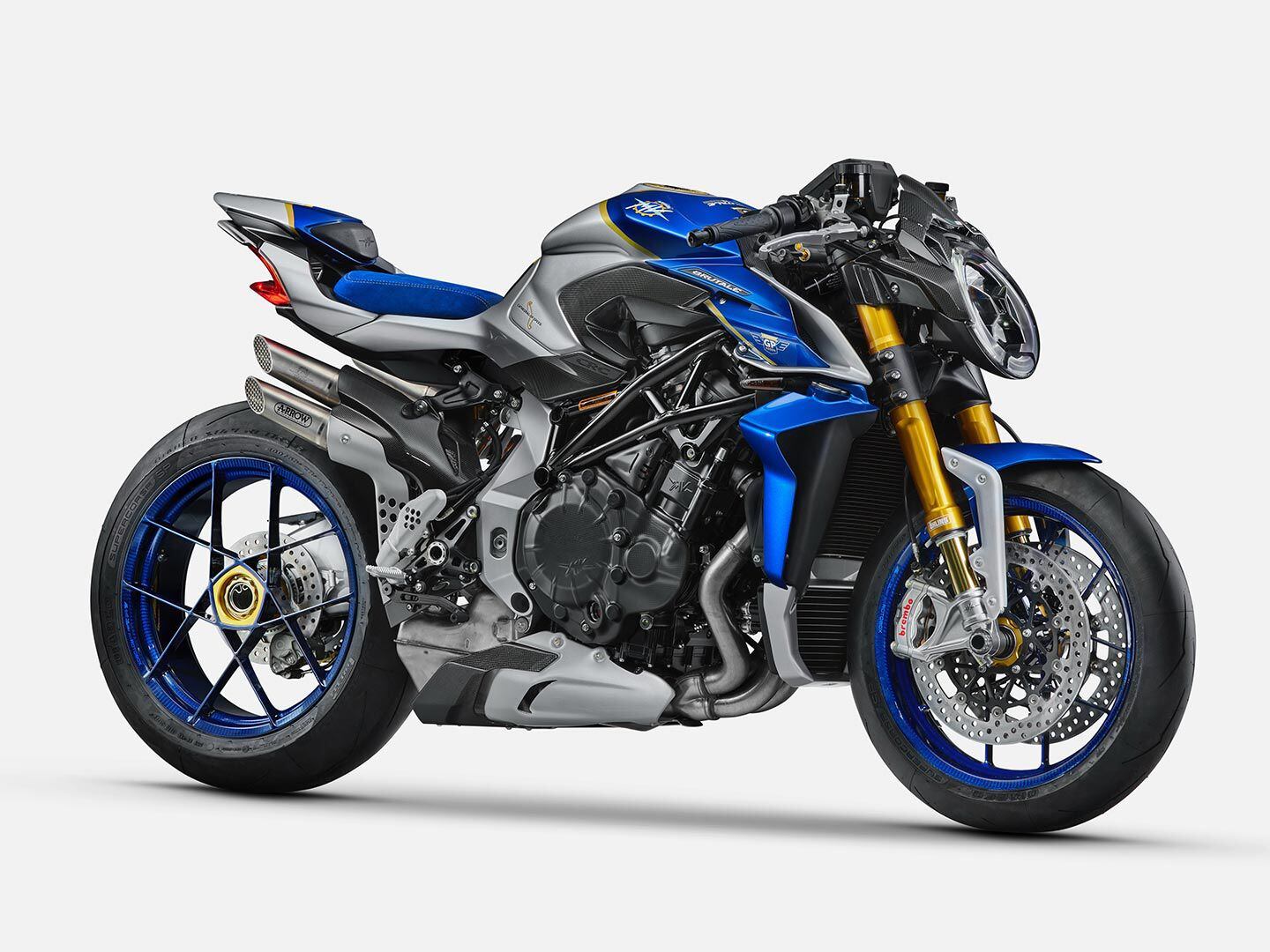
MV Agusta’s Brutale 1000 RR Assen celebrates the brand’s history at the European racing circuit. (MV Agusta/)Special editions of top performance models are one of the smartest ways to keep interest high on models that are seeing a shrinking audience. And MV Agusta has gathered a lot of experience in that game. After all, the brand has an infinite number of opportunities to celebrate by giving life to limited editions tied to its glorious story in the sport of motorcycle racing.
On this occasion, MV Agusta celebrates its relationship with Assen, a track with an impressive number of MV victories: 35. The last of which was conquered almost 50 years ago, in 1976, by Giacomo Agostini in the 350 GP class. MV Agusta top marketing management found that the magic implicit in these glorious numbers would be worth being translated into a limited number edition of the hottest model in its line: the Brutale 1000 RR. Enter the MV Agusta Brutale 1000 RR Assen.
Related: MV Agusta Reveals 2022-23 Reparto Corse Models
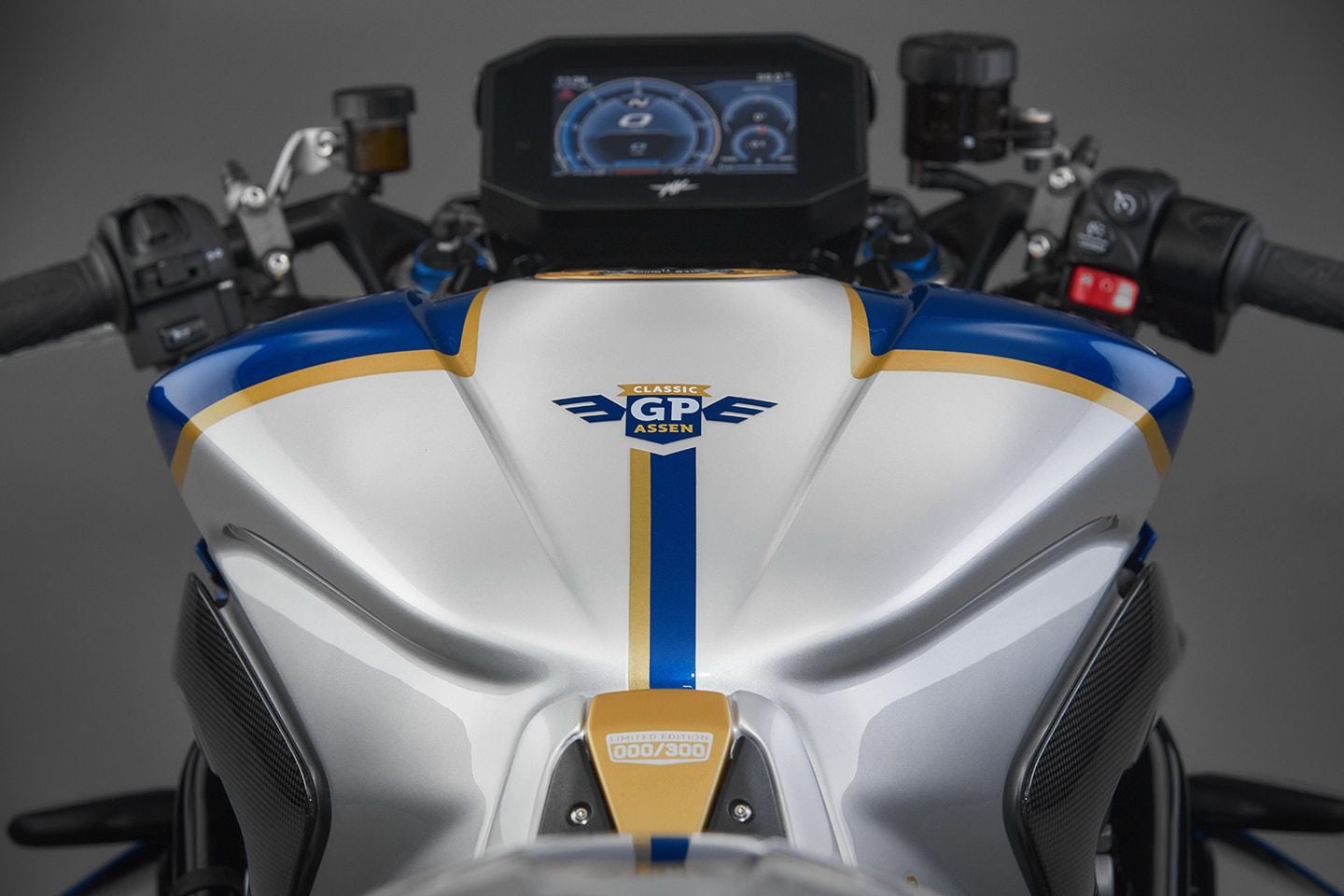
Special paint and carbon fiber add exclusivity to the already capable MV Agusta Brutale 1000 RR Assen. (MV Agusta/)As we have seen before from the Schiranna-based manufacturer, the special edition primarily consists of a highly refined level of execution and splendid graphics, while most of the technical details remain standard. Here, standard means no less than a claimed 208 hp from its 1,000cc DOHC inline-four that has been constantly evolved to comply with Euro 5 emission standards while improving torque delivery characteristics and smoothness of throttle response.
Talking of technical evolution, the MV Agusta DOHC inline-four has come a long way from the days of the relatively weak and less-than-reliable 750cc to the present 1,000cc powerhouse that is one of the strongest engines in the class. The highly oversquare unit (79mm bore by 50.9mm stroke) delivers that 208 hp at 13,000 rpm and 86 lb.-ft. of peak torque at 11,000 rpm. It features four-valve hemi heads that prove very efficient and worth their extra machining costs as the Euro homologation standards tightened over the years.
An improved exhaust system featuring a huge under-engine silencer that incorporates a larger and more efficient catalytic converter creates less back pressure, for an improved engine response through the rev range. The main technical novelty in the powertrain department is represented by the drastic evolution of the software and of the hardware of the electronic gearbox—now much quicker, more precise, and smoother.
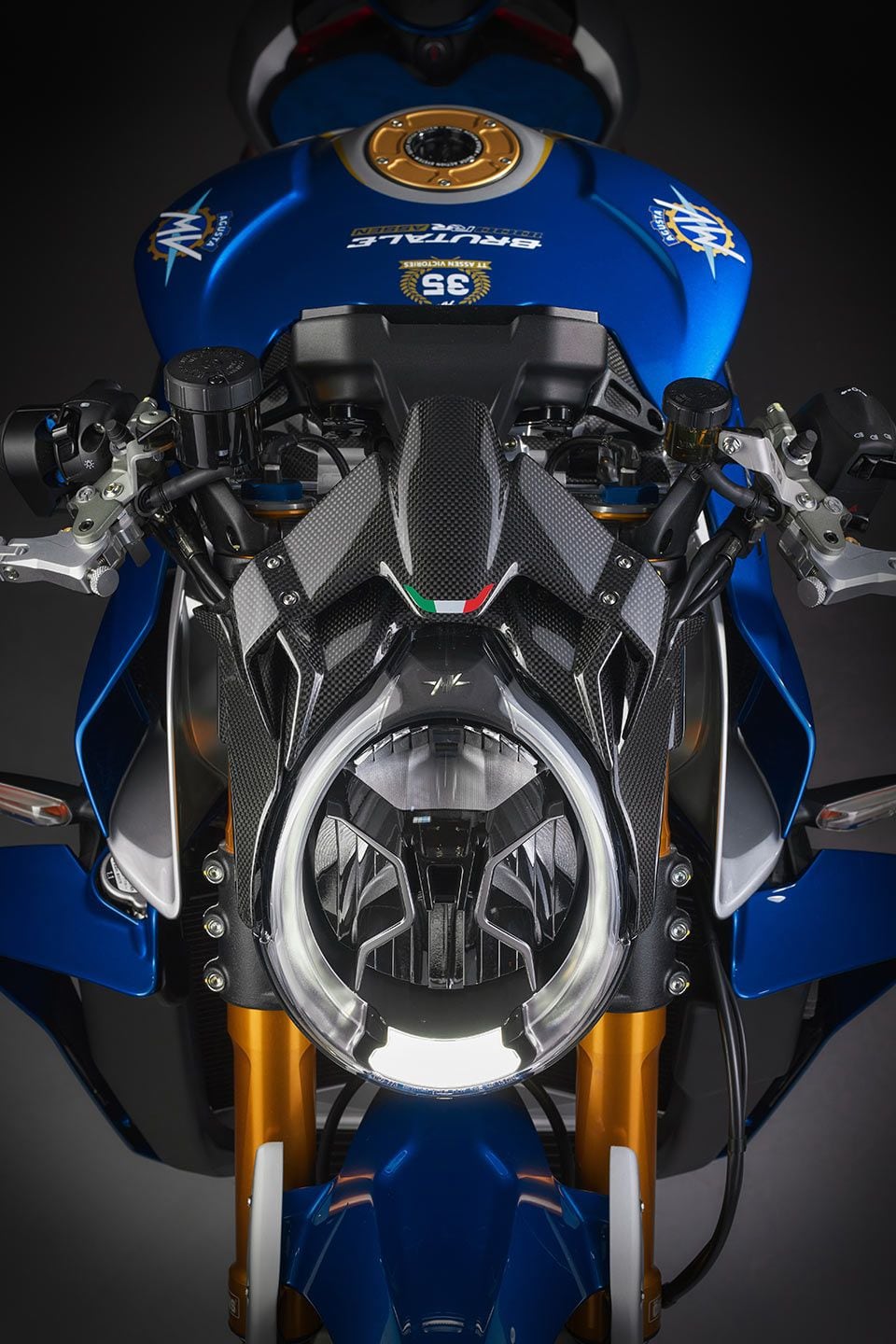
Only 300 examples of the Brutale 1000 RR Assen are available. (MV Agusta/)As with previous special editions, the graphics take the front stage with a combination of light metallic blue and silver. No Italian red, just a combination of cool colors that send a message of fresh northern winds and strong seas. To complete the great graphic effect, the aluminum plates that clamp the rear engine mounts and locate the single side arm swingarm are painted in the same grade of gray. The seat is dressed in Alcantara trim.
Carbon fiber elements have been adopted for the passenger seat cover, the tank side covers, and the headlight cowl, but the most impressive carbon fiber parts are the wheels by Rotobox, adding an extra touch of sportiness and speed. Ten interconnected spokes use a proprietary “forged technology” that obtains maximum rigidity and structural solidity from elements thinner than ones in aluminum.
Related: 80th Anniversary of MV on Two Wheels
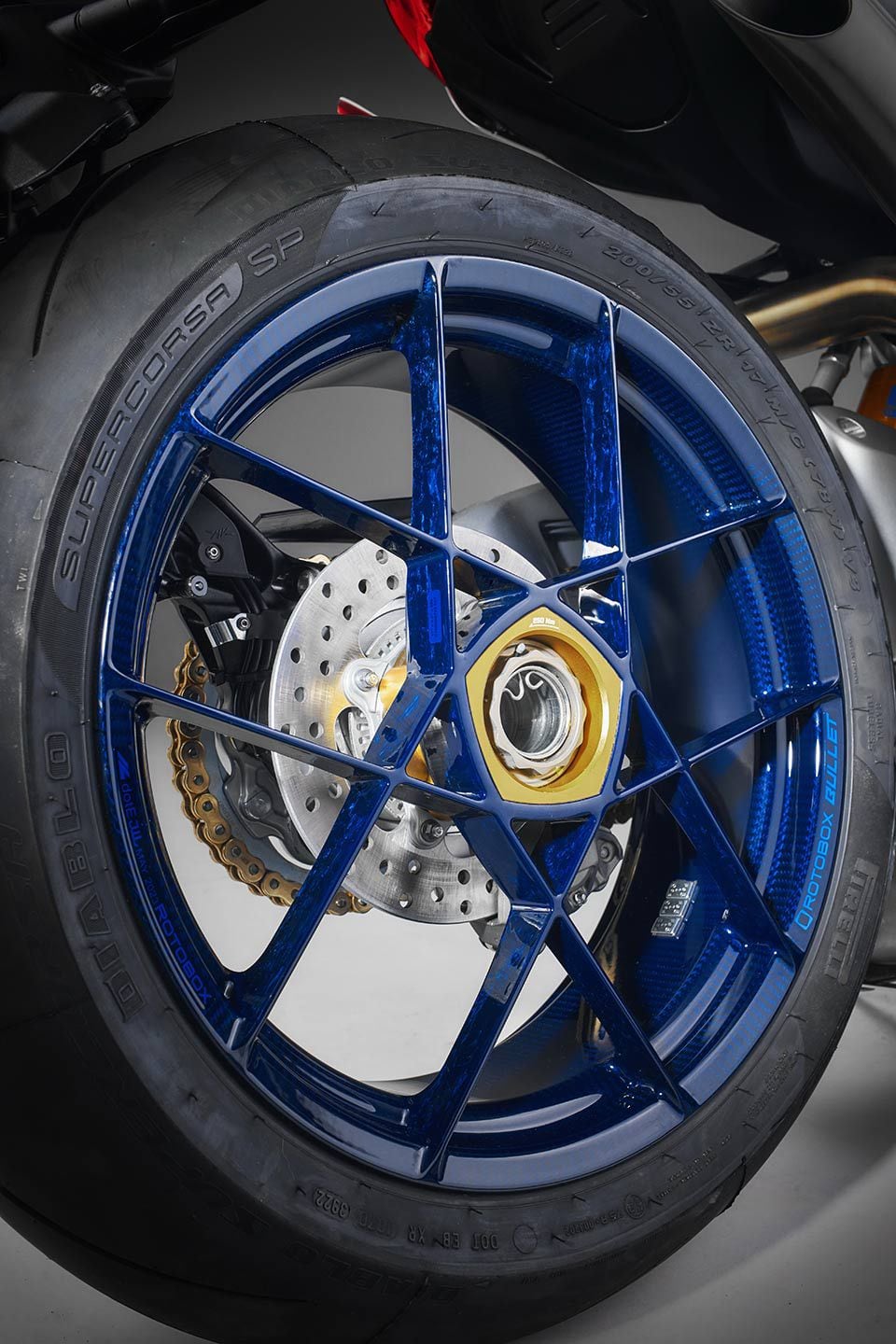
Rotobox carbon fiber wheels could be the most impressive part of the Brutale 1000 RR Assen. (MV Agusta/)Fork clamps and most of the levers are from machined aluminum billet, with the machined tank cap coming in two graphics. As in many MV Agusta models, a racing kit is offered, the main element of which is the sport exhaust system by Arrow and featuring high-flow titanium tail pipes. A dedicated ECU comes with the sport exhaust system to fully exploit the superior breathing ability of the Arrow exhaust that bumps peak power up to 212 hp at 13,800 rpm.
-
The 2023 Honda XR150L is one of the newest editions to the American Honda US lineup. This lightweight dual sport was originally introduced in 2003 to Asian and Latin America markets, but was never brought stateside. Now, 20 years later, the Honda XR150L has arrived in North America.
Honda’s XR150L utilizes a 149cc air-cooled single with a 22mm carburetor and a five-speed transmission. The chassis features a 31mm telescopic fork with 7.1 inches of travel and a Pro-Link shock providing 5.9 inches of travel. Its MSRP of $2,971 makes the XR150L one of the most affordable motorcycles on the market. In Honda’s street lineup, only the Navi, Metropolitan, and Ruckus have lower sticker prices—all minimoto/scooters.
Related: Top 10 Beginner Bikes 2023
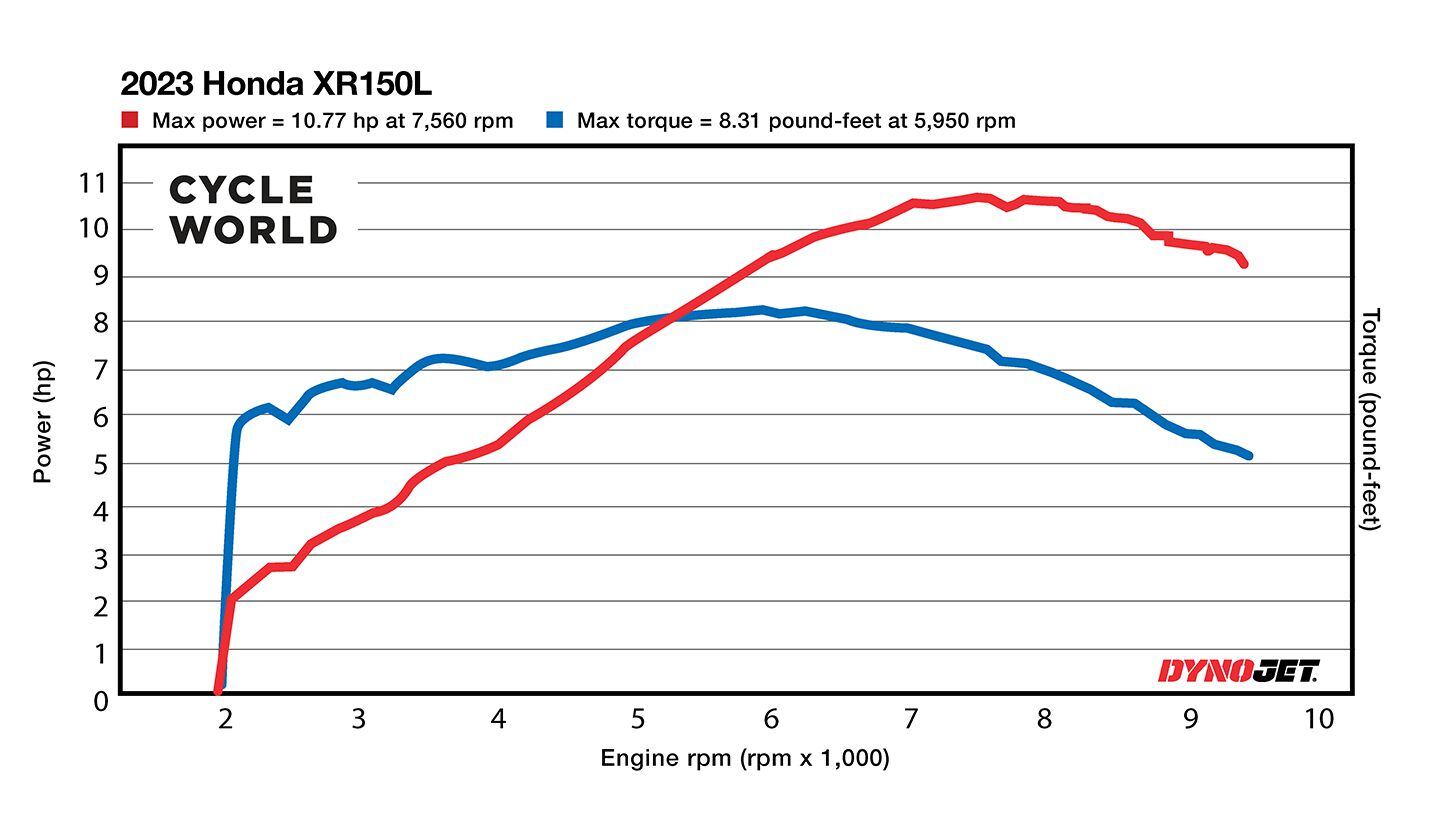
2023 Honda XR150L Dyno Chart. (Robert Martin/)On the Cycle World inhouse Dynojet 250i dynamometer, the 2023 Honda XR150L, weighing 283 pounds on our automotive scales, produced 10.8 hp at 7,600 rpm and 8.3 lb.-ft. of torque at 6,000 rpm. Its linear power delivery and flat torque curve further enhance the XR150L’s flexibility. This lightweight dual sport appeals as much to beginner riders as it does to experienced ones due to its usability, accessibility, and Honda’s proven reliability.
-
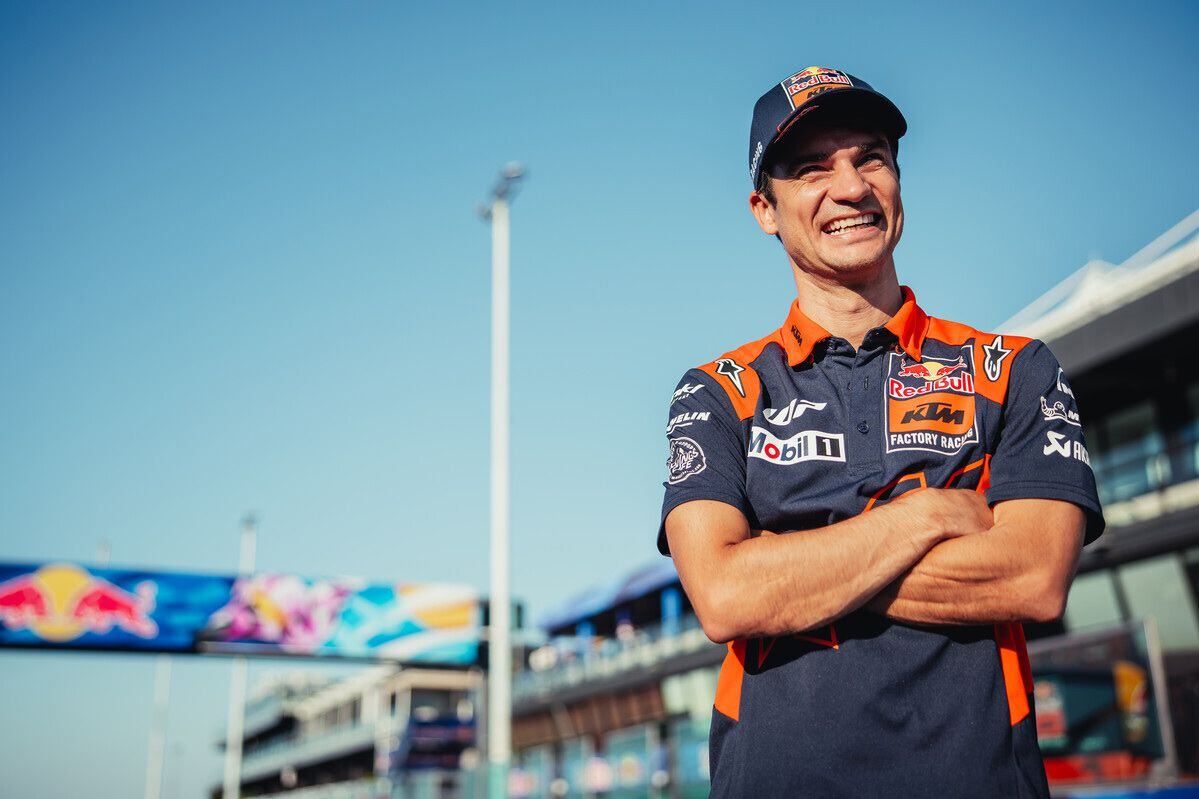
Dani Pedrosa had plenty to smile about at Misano. (KTM/)Sunday morning at Misano World Circuit Marco Simoncelli, the butterflies in his stomach are the same—even if you are a three-time world champion and you have nothing to prove. MotoGP legend Dani Pedrosa—the Samurai—at nearly 38 years old, continues to impress.
“I have fulfilled my dream of becoming a racer,” the Repsol Honda rider said in 2018 when he decided to retire after a successful career crowned with three titles, 298 GP starts, 54 wins, and 153 podium finishes. Five years later, Pedrosa made another dream come true: fighting for the podium with the new KTM machine that he is developing for the Red Bull KTM. We almost had the chance to say, “154!” this weekend in Misano.
As a wild card in Misano, he made a superb performance finishing just off the podium (fourth) in Saturday’s Tissot Sprint and in Sunday’s GP with his signature clean style. Humble, fast, and more relaxed than ever, Pedrosa remains a legend in the history of motorcycle grand prix racing.
Related: Was the San Marino GP Really a Snoozer?
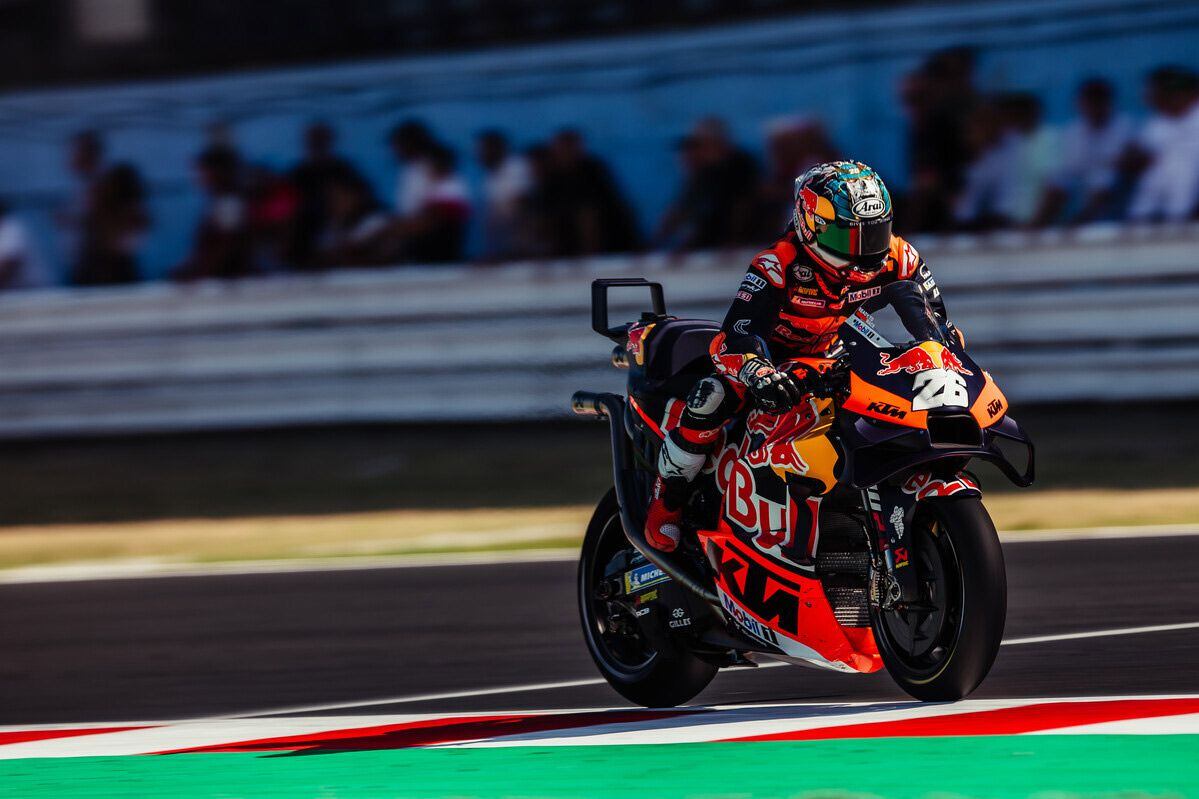
Pedrosa’s smooth riding style is celebrated by many riders his junior. (KTM/)His Red Bull KTM Factory Racing teammate Brad Binder, who finished behind Pedrosa, said, “It’s amazing to see how clean he rides. He never put the wheels outside the ideal line. He is doing a fantastic job, and this is amazing for us as he is setting the basis for our future. I’m not surprised by his performance—he is a phenomenal racer.”
His former teammate Marc Márquez added: “It’s amazing to ride behind Dani. His riding style is the cleanest of all of us. When I made my debut in MotoGP in 2013, I used to follow him a lot to learn as much as possible, and that year I won the world title!”
“His riding style is so clean as if his bike was on rails,” 2023 MotoGP point leader Francesco Bagnaia said.
Congratulations, Dani, for this superb race weekend.
The race was physically demanding, but I’m really satisfied with the result. I have never been so happy in my career for a fourth place! I tried to keep the pace of the three front-runners, and we fought with Pecco Bagnaia for the podium.
You impressed already in the sprint.
Saturday has become a hectic and long day with the qualifying and the sprint race, where you cannot make mistakes. In the sprint, I made a good start and I put myself in a good position. I was surprised by the impressive rhythm set by Jorge Martín, especially in the first laps. I did my pace, and I could catch Pecco who was in third position. I tried to overtake him, but he was very good at closing all the doors. He was braking very late, so we didn’t have a lot of margin, even though I had a better pace. It’s a pity as we arrived very close to the podium.
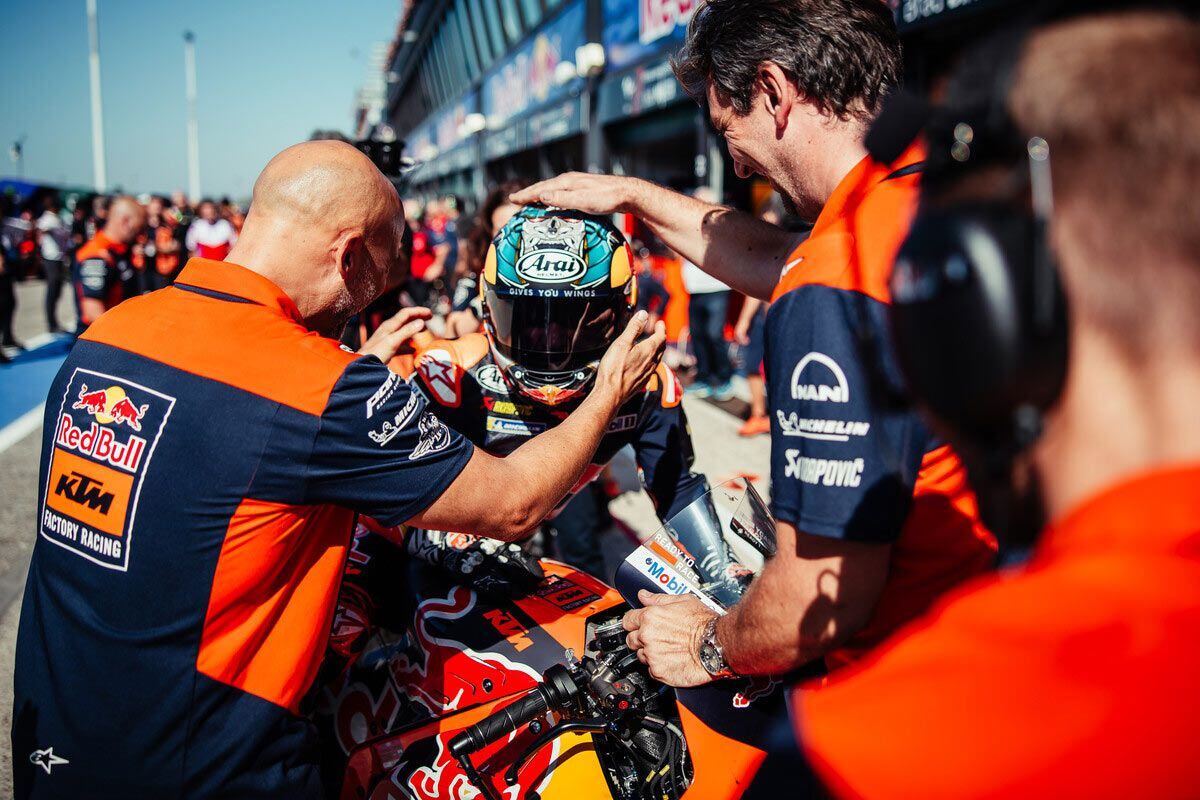
Pedrosa’s performance was clearly above the expectations of the team—and the competition. (KTM/)After finishing fourth in the sprint, were you aiming at the podium on Sunday?
I took the start very motivated, I tried, but we had a problem with the tire pressure, that makes overtaking more difficult. I also have to say that when you are a test rider you lap mainly alone.
How did you feel on Sunday?
I felt more of the familiar feelings related to the race on Sunday. Sincerely, at the end of the 23 laps, I thought, ‘This is a proper race!’ The sprint is an important result, it can give you motivation, but the real race is on Sunday; it’s long and you need to be strategic. You need to know how to manage the machine, your energies, and the race dynamics.
Aged almost 38 and with all your experience, do you still feel butterflies in your stomach before the start?
Yes (he smiles). On Sunday morning I was more nervous compared to Saturday when I felt more relaxed. My stomach was closed, maybe because we were going to use the medium tire. But I have to say that I really enjoyed the race.
What mark would you give to yourself for this fantastic race weekend?
I am quite happy with my performance. I would give a very good mark to the team because they adapted very well to the schedule, the rhythm of the sprint race and the long race. From my side, I tried to help them as much as possible, avoiding crashing and making mistakes that could have complicated the weekend.

Pre-race butterflies don’t go away so easily, even when the pressure is less than the days Pedrosa was expected to battle for the win. (KTM/)You looked more like a racer than a test rider. Would you like to return to racing?
This is not in my plans (he laughs). There are more available riders than bikes on the grid, so I don’t want to create more mess.
Would you return just for the sake of racing, without all the commitments with the media and the sponsors?
I really had fun this race weekend, but I think everything has a time. I really enjoyed my era, and now it’s the time for the younger generations. Despite two fantastic race weekends in Jerez and here in Misano, I’m happy as I am. I am also enjoying the race more and more with this perspective from the outside.
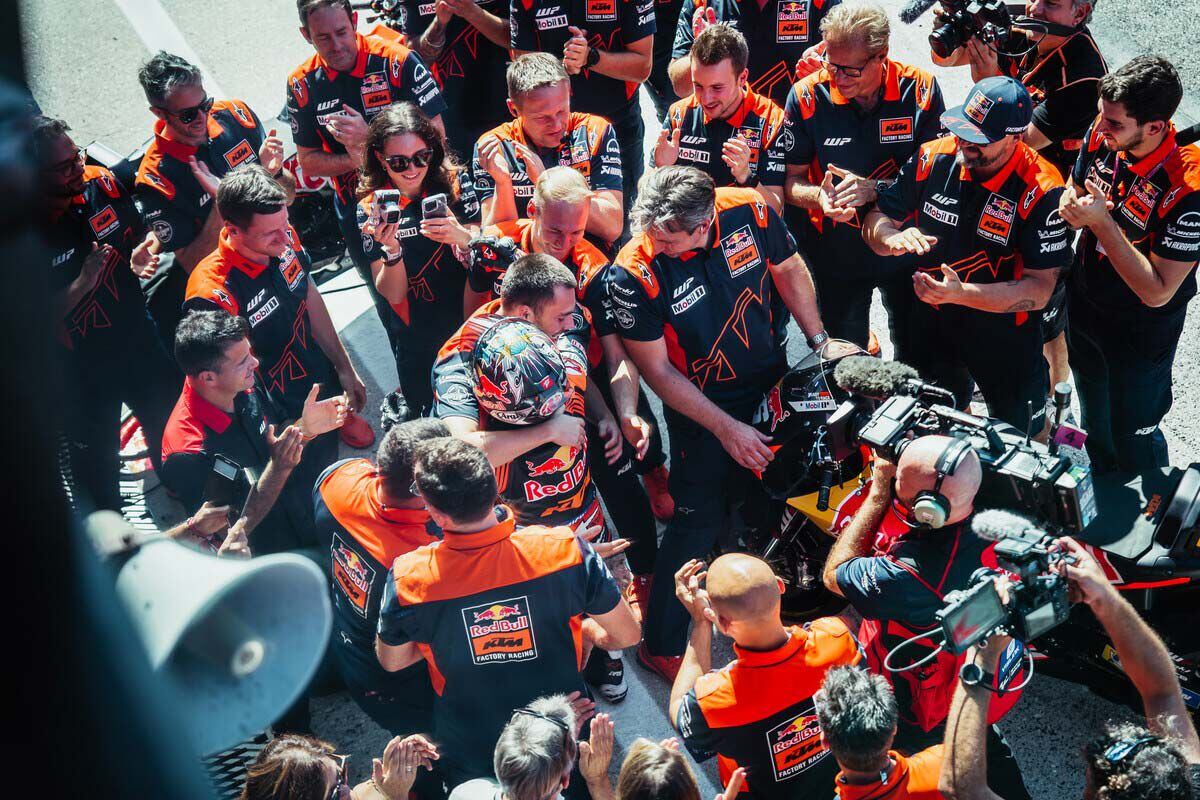
Pedrosa’s role as a test rider is vital to Red Bull KTM Factory Racing’s success. (KTM/)Why did you decide to retire?
Because you get to a point when you feel that it’s time to leave the scene to the young people. Now I understand even more clearly the incredible efforts that Valentino Rossi or Loris Capirossi put in when they won their last race. When I was young, I took this for granted as they have always been fast and talented riders—but now, at my age, I can better understand the incredible value of their victories.
Looking at the difficult situation in Honda, maybe they need your help.
I haven’t received any call yet (he laughs). I think Honda has a lot of work to do! I’m doing my best for KTM, and I already have a contract with them for the 2024 season.
There are a lot of rumors around Marc Márquez as he hasn’t announced yet his plans for the future. What would you do in his place?
It’s very difficult to answer. Firstly, because I’m not Marc. We need to consider that he has a long history with Honda, with Repsol, and I don’t know how things really went in the last years, so he is the only one who can take this decision. I know that it is a difficult decision considering that he is 30 years old, but I think he will find the way to steer his future in the right direction.
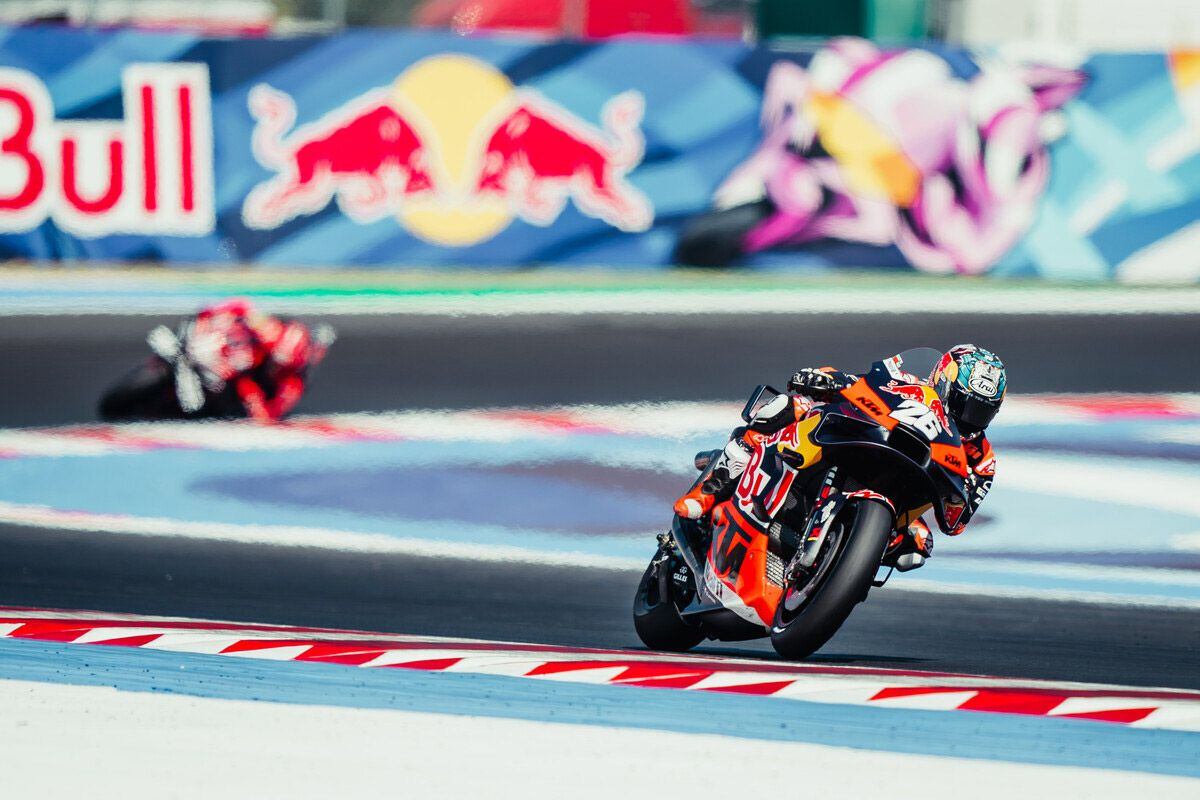
Pedrosa doesn’t feel the need to return to racing full time. (KTM/)Looking back, what do you see in the mirror?
I’m very happy as in my career I have achieved more than what I could have imagined. I have also learned a lot from the difficult moments. When something tough happens, you can decide to remain upset or try to understand and see what you can learn for the future. I have gone through several incidents, lots of injuries, moments when you are down or you touch the sky—and I’m still learning day after day.
-
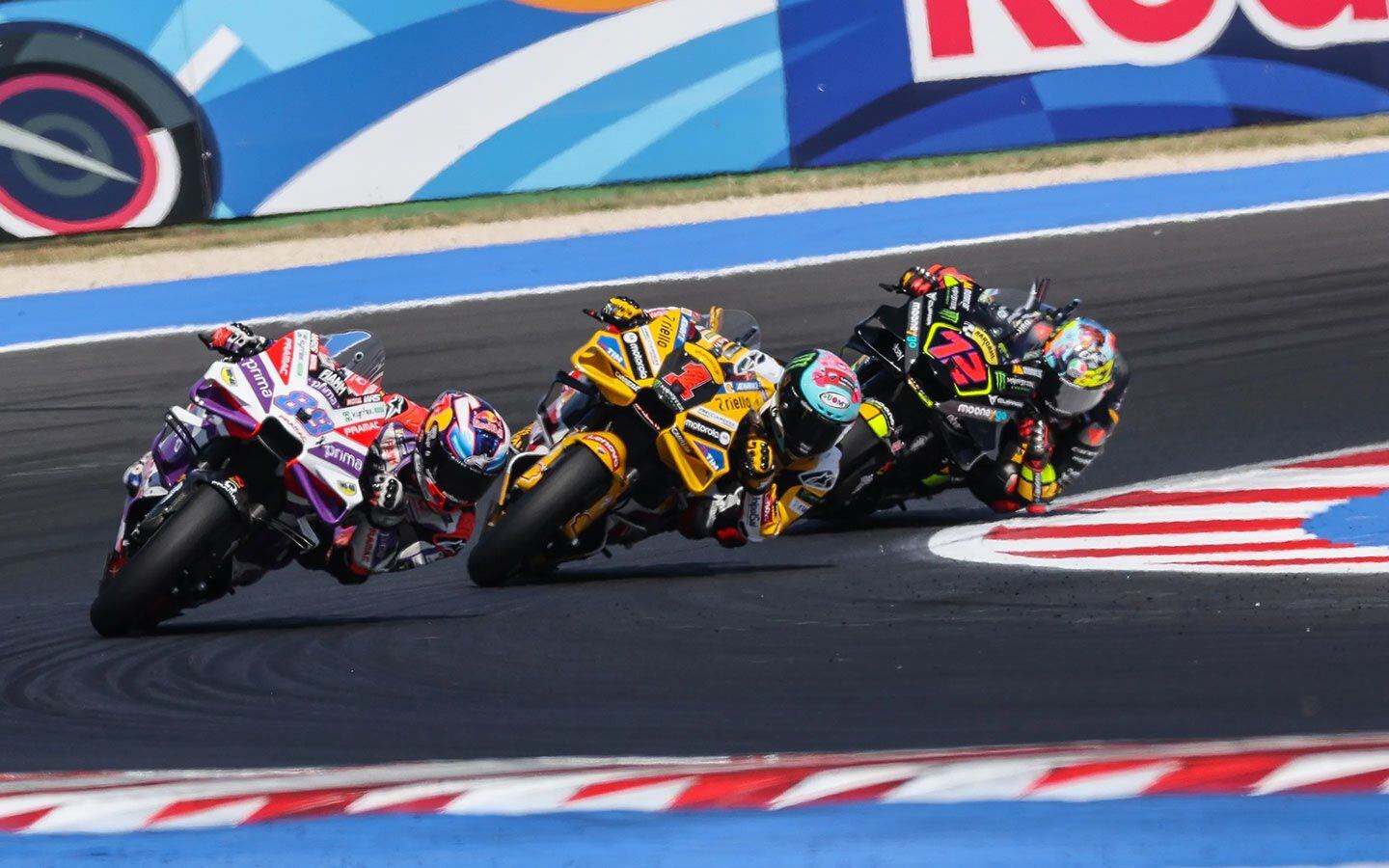
Jorge Martín led every single lap in Misano on Saturday and Sunday. (MotoGP/)“Not a very exciting race” was a common comment Sunday afternoon. Jorge Martín, long respected for fast single laps through practice and qualifying, lapped at impressively constant 1:32s on Misano’s high-grip asphalt. He was opposed by injured men with a lot to lose—Francesco Bagnaia, the point leader (now it’s Bagnaia with 283 points versus Martín at 247 and Marco Bezzecchi third with 218), rode into third with a painful leg hematoma and other evidence of last week’s crash. Also managing pain and limited energy was Bezzecchi, second.
On Bagnaia’s heels and working hard to displace him from the podium was Dani Pedrosa, age 37, considerably unsung in his racing years but now a test rider for KTM. Just get out there on that promising-but-untried rad new carbon chassis and put that model into the top five against men 10 and more years your junior. Aprilia’s Maverick Viñales was fifth.
Martín said, “…I felt a lot of pressure from the Italian riders…
“I was hearing their engines but I was calm.
“We were not pushing a lot on the first laps—I was trying to keep some margin…to keep the body fresh.
“As soon as I saw 0.3 [on my board] then I started to push, full gas, like quali, risking a lot on the braking and a lot of front lock[ing], but it was worth it as I was [soon] up to 2.3.”
Riders have found that adhering to Michelin’s tire pressure rule (a minimum of 1.88 bar [27.6 psi] for the front tire) can lead to grip loss whose first symptom is front wheel locking during braking.
Bagnaia’s hope was to make top five in both sprint and race, so as to limit loss of championship points. “I tried to stay with Martín for as long as possible, but…the fact that I was riding only with my arms—and the front tire pressure—didn’t allow me to do it.
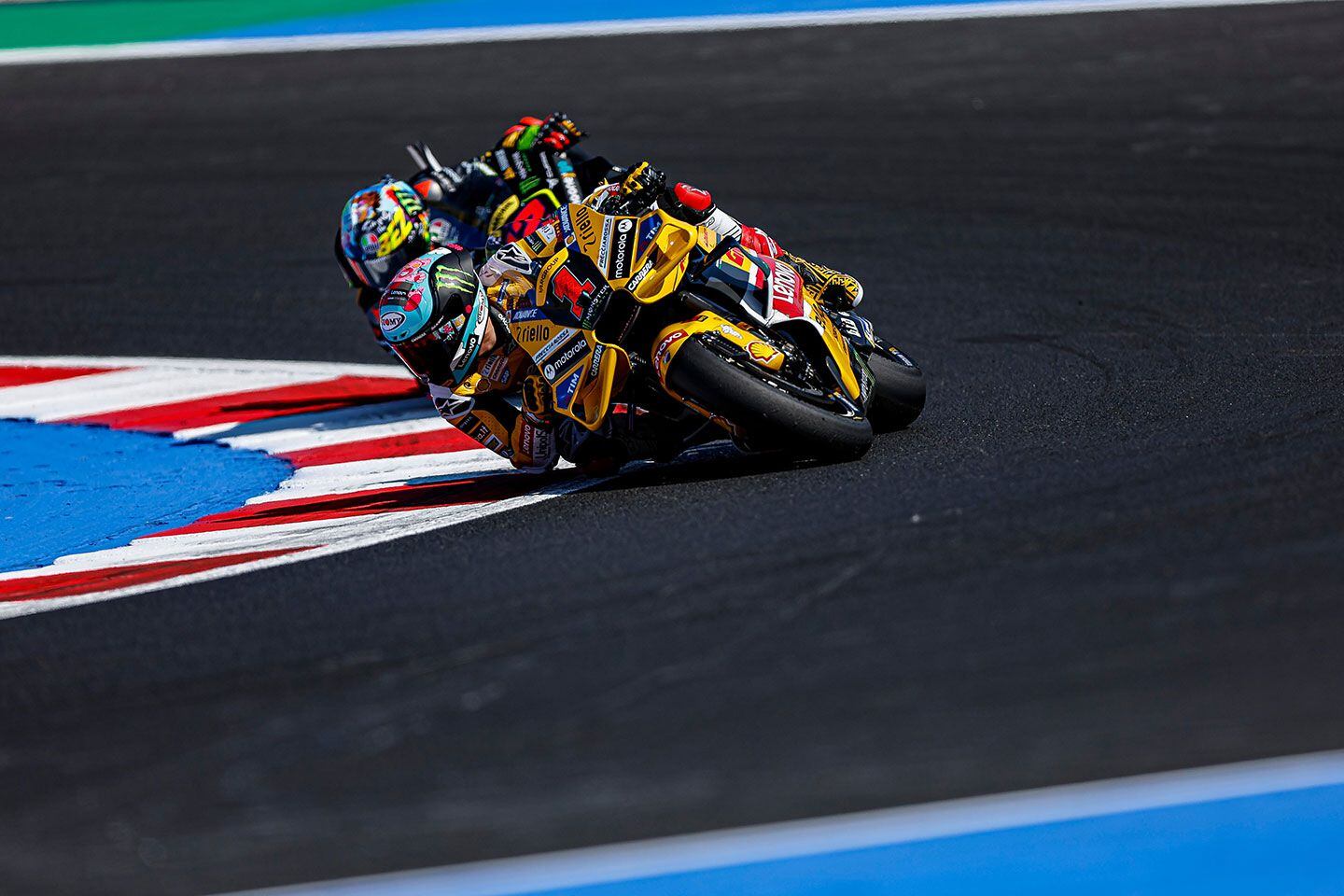
Francesco Bagnaia kept the point loss to a minimum at Misano. (Ducati/)He described saving himself: “I just tried to breathe a bit and have a bonus of performance in the last two or three laps so as not to give a chance to Pedrosa to overtake me.
“I only lost 14 points instead of a possible 37.”
Not exciting?
Bezzecchi said, “I tried, but Jorge was very fast. I started well and I was then in the slipstream for a long time.”
Slipstreaming another bike exposes your front tire to the heat plume from its 280 hp exhaust gas plus the hot air from its coolers—in effect you are behind a 500 hp furnace.
He continued: “I struggled on the front tire and the bike became very physical to handle.
“I overtook Pecco and perhaps the adrenaline effect ended there (hand pain had become a hard distraction).”
On Saturday the sprint finish order previewed Sunday’s top four. Bezzecchi had said, “At the beginning I felt incredible. With the adrenaline from the start, the painkillers…
“I felt great and was catching Jorge.
“I started to have a bit of pain, especially in the change of direction (which at speed requires maximum muscular effort on the bars).”
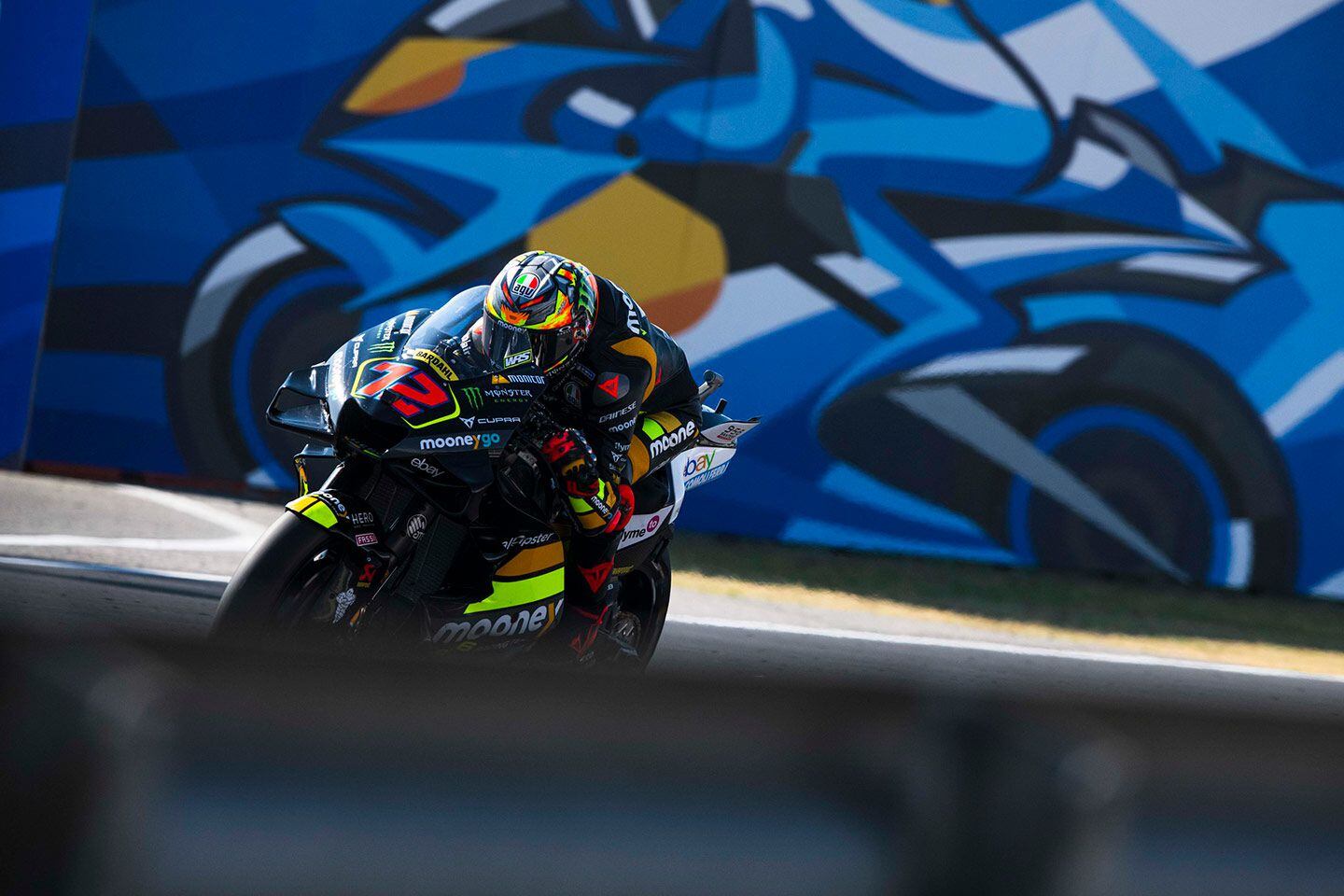
Marco Bezzecchi also had to race through pain, finishing second. (Mooney VR46/)Bagnaia after the sprint was realistic: “Jorge has an advantage from every point of view. He is very fast, has great consistency, and is not injured. He is at a higher level and it will be difficult to beat him (on Sunday).
“I struggled in the right-hand corners and on this circuit they all turn that way (10 rights, six lefts).
“Furthermore when the bike started to shake it was difficult for me to stop those movements.”
Several riders noted problems with front-rear balance on Misano’s high-grip surface—so different from the week before at Barcelona. Indeed Bagnaia suggested requiring a specified level of grip: “What I’d say to the Safety Commission? There must be a mandatory level of grip.
“Barcelona is a disaster.
“It’s unsafe. A little mistake: you crash.”
Martín’s consistency at speed has made him second in the championship, but the grid is heavy with men who have won races and will again, on bikes that can take them there. Contrast this with the 500 two-stroke GP era, when there were one, two, or at very most three riders who might win—a series in which Mick Doohan was champion five years in a row. Winners of the 500 class were hailed as supermen, uniquely able to ride what were realistically very bad motorcycles in the terms of the present era. Their explosive torque delivery—even with torque-smoothing devices such as variable exhaust timing, water injection, and electronic torque controls—prevented mortals from riding them well.
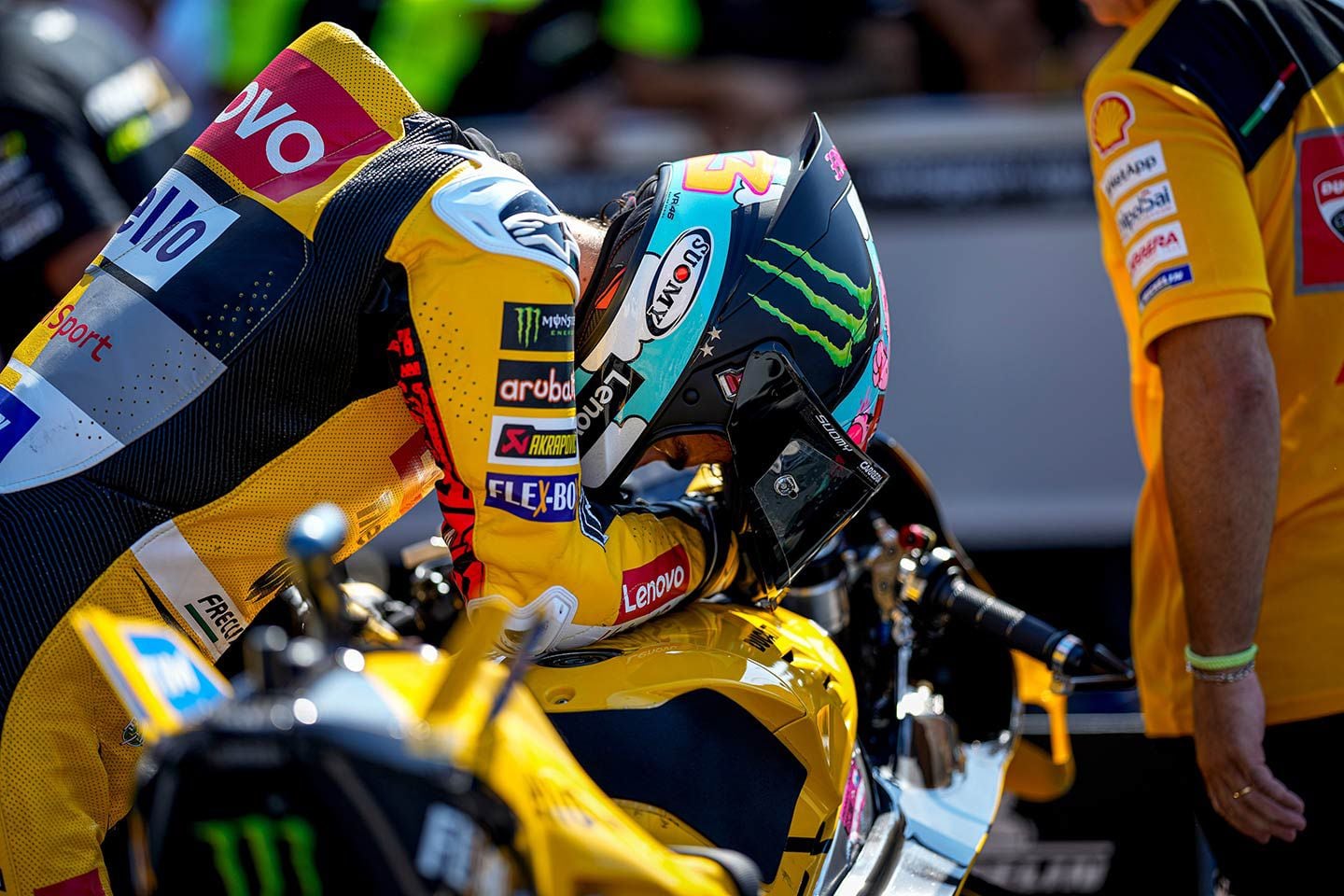
Bagnaia’s body language clearly showed how he felt at Misano. (Ducati/)Today, by contrast, we have 10 or 12 “supermen,” all capable of winning, all on factory-engineered racebikes.
Some call for rules to shape racing into what fans imagine it to be: Daredevils oblivious to danger, ignoring the need for championship points, outbraking, trading paint, carving under from flag to flag.
Radicals cautiously imply that mandating bad tires or requiring brakes to fade out after 15 or 20 laps can magically bring the fussy position-changing fans feel they are owed. Yet having achieved this long-sought parity of talent and equipment outbraking has become less common precisely because skills are so equal. Especially if rising front tire pressure is making wheel locking more frequent. Riders, knowing that contract renewal depends on championship results, must manage risk.
This makes overtaking others more difficult, and riders know it even if fans and brand managers do not. That’s why riders make such efforts to qualify on the front row and to be first into turn 1 in sprint and final. Rider after rider speaks of being stuck downfield in a group after a bad-luck shunt at the start, and having to waste laps getting free—laps during which the leader or leaders may move out of reach.
It was grand to see Dani Pedrosa, immune to time and retirement, in the lead group. It was grand to see that innovation (in the form of the KTM carbon composite chassis Pedrosa rode) continues to originate from more than one European constructor. In the Monday test following the Misano final, Aleix Espargaró rode Aprilia’s new carbon chassis.
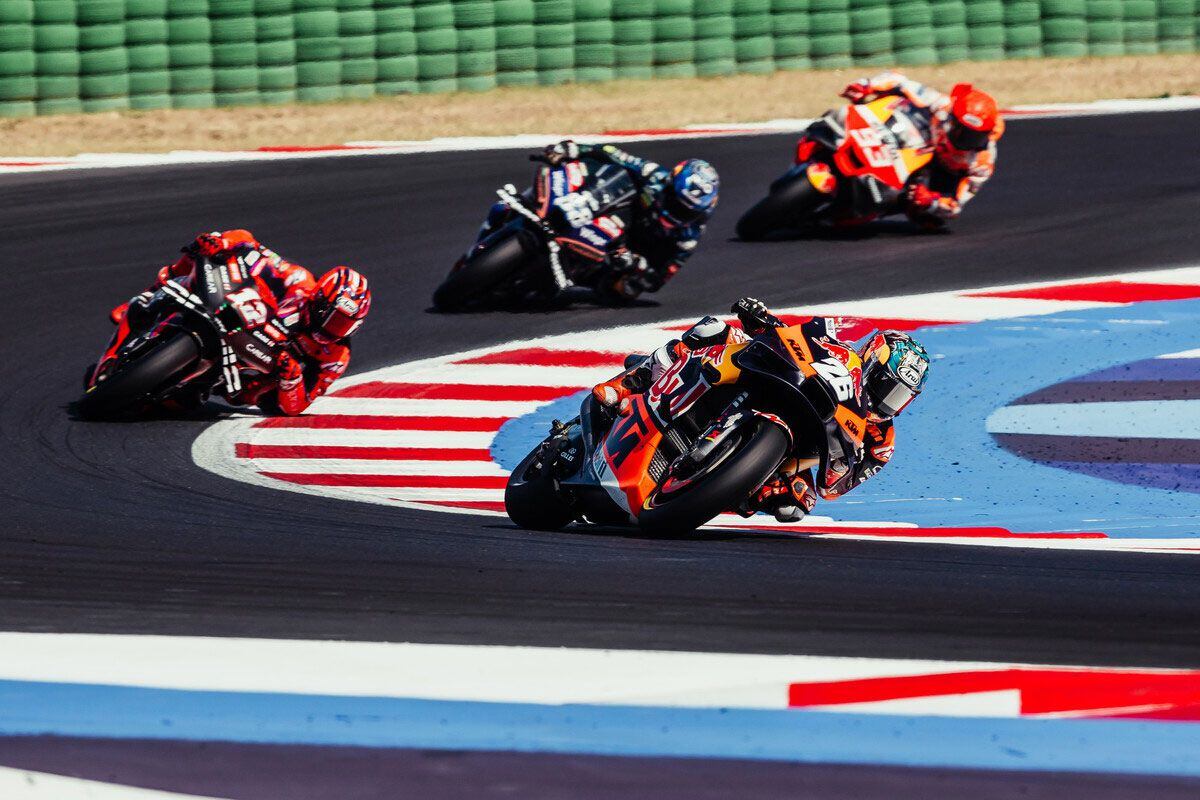
Dani Perdrosa was the people’s champ at Misano. (KTM/)He said, “It’s really, really different.
“I’m not sure if I’m allowed to say but that the new frame is lighter and I felt also that it is a bit more flexible, more soft, which is not really what the engineers were trying to do.”
Ideally, since carbon fibers are a directional material, it should be practicable to design in flex in directions where it is wanted, and forbid it in other directions. The difficulty of separating desirable from undesirable flex has made it challenging to design one bike that can be ridden well by both corner-speed and point-and-shoot riders. The chassis stiffness P&S riders need for braking stability and instant turn-in conflicts with the suppleness required to keep tires in contact with pavement in long, fast corners. The softness that generates mechanical grip for corner-speed riders confuses point-and-shootists, making them feel the front end is “moving around” and about to close.
It has surely occurred to anyone who works with these bikes that lateral movement of the steering head and its supporting structure could be switched on or off by coupling it to the engine’s cylinder head through a small hydraulic damper. Its motion could be permitted or forbidden by a valve closed by front brake line pressure. You can be sure the Europeans have no shortage of ideas or willingness to build and test them.
Pedrosa was issued a front tire pressure warning for having ridden more than 50 percent of a lap with pressure below 1.88 bar.
He said, “Maybe because I was riding on my own I didn’t bring up enough pressure. Because yesterday I was higher and actually the feeling was better yesterday than today.”
Part of the decision as to what pressure to put into the tires depends upon whether the rider is more likely to be on his own or in a hot drafting group.
Speaking of the rear tire in the final, Pedrosa also said, “I had a few problems in the first laps because the rear tire wasn’t heating up quick enough for me, especially on the left side, and I had a few scares.”
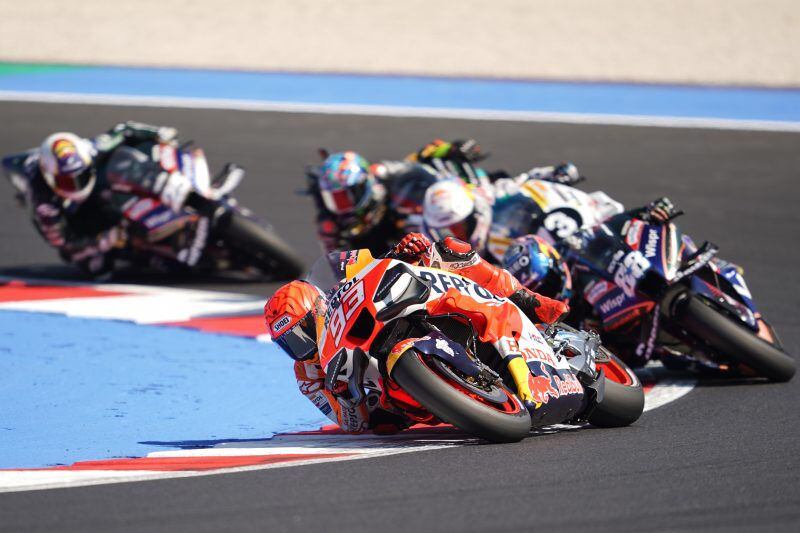
Marc Márquez rode a more measured race and scored his highest finish of the season. (Repsol Honda/)Marc Márquez’s new method of riding at less than desperation level bore fruit this time as a seventh-place finish. He asked, “How do you tame a beast? If it’s a wild beast, maybe you can try it with blows. They tamed me with blows—a bone, another bone, a rib.
“I was doing something wrong and what I was doing wrong was that I was taking too many risks.”
In the Monday Misano test both Márquez and Fabio Quartararo tried new bikes from Honda and Yamaha, respectively. Nothing revolutionary was revealed. For what it’s worth, in those Monday sessions Quartararo was sixth quickest and Márquez 14th.
Next come the flyaway events, beginning with the Indian round in two weeks.
-
The Philippines is the first country outside of Europe with proud new owners of the adventure scooter.
-
A brother and sister riding duo’s adventure headed to Utah for some riding and hiking.
-
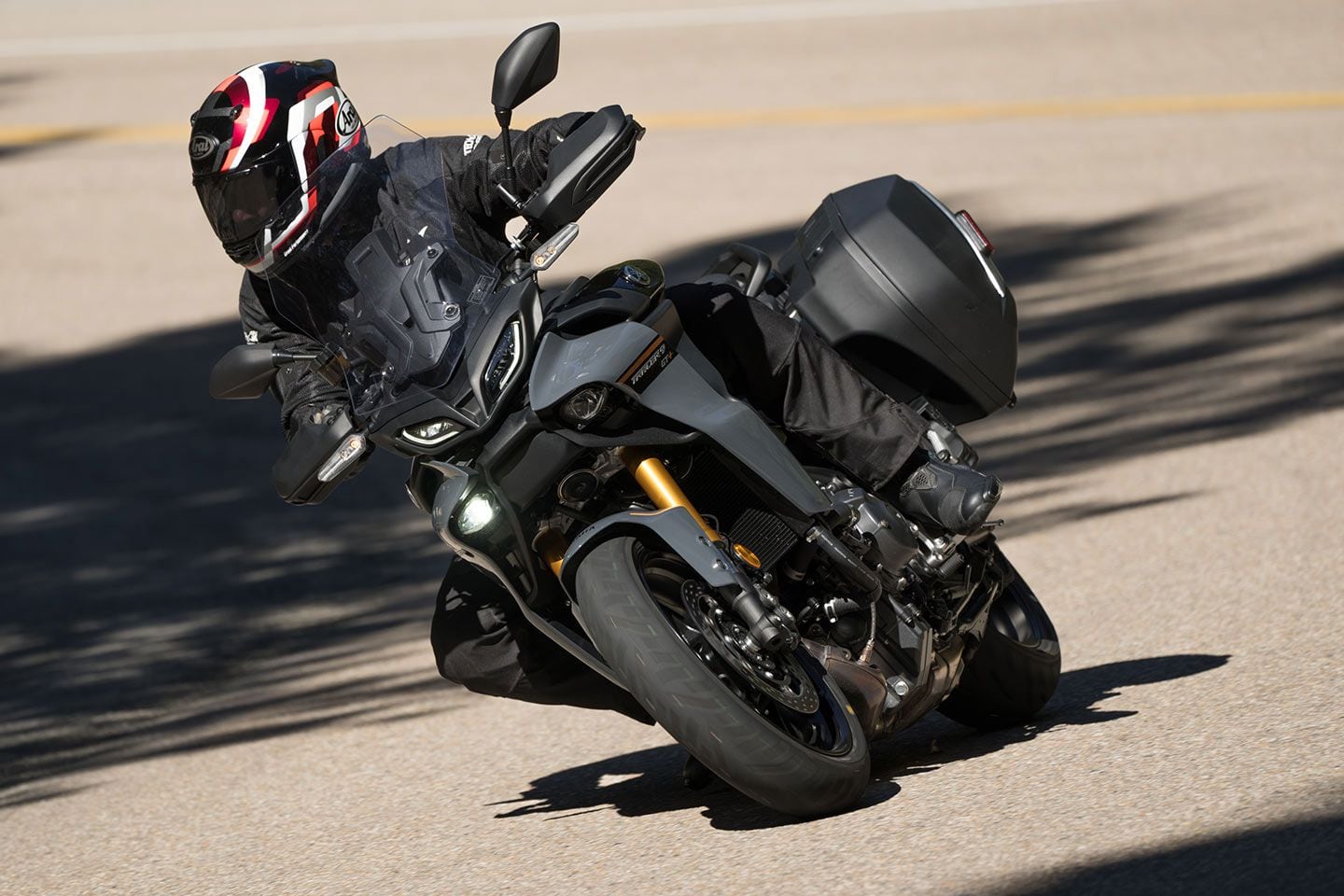
Yamaha’s 2024 Tracer 9 GT+. (Joseph Agustin/)The definition of a sport-touring bike has always been a moving target. We may never know if the original intent was to build a sportbike with better touring capabilities, or a touring bike with more sporting intentions. At Cycle World, we first acknowledged sport-touring in our Ten Best categories back in 1999, and that overlap between classes has generated a ton of great motorcycles over the years.
But like everything in motorcycling, the goal posts have moved as sport-touring has become ever more specialized. For years there were traditional models like Yamaha’s own FJR1300ES, but now you could argue that street-biased adventure-tourers like the Super Ténéré ES fill a similar role. Add to this a new breed like the Tracer 9 GT+ (an evolution of the Tracer 9 GT) that continues to prove that less with more can be better.
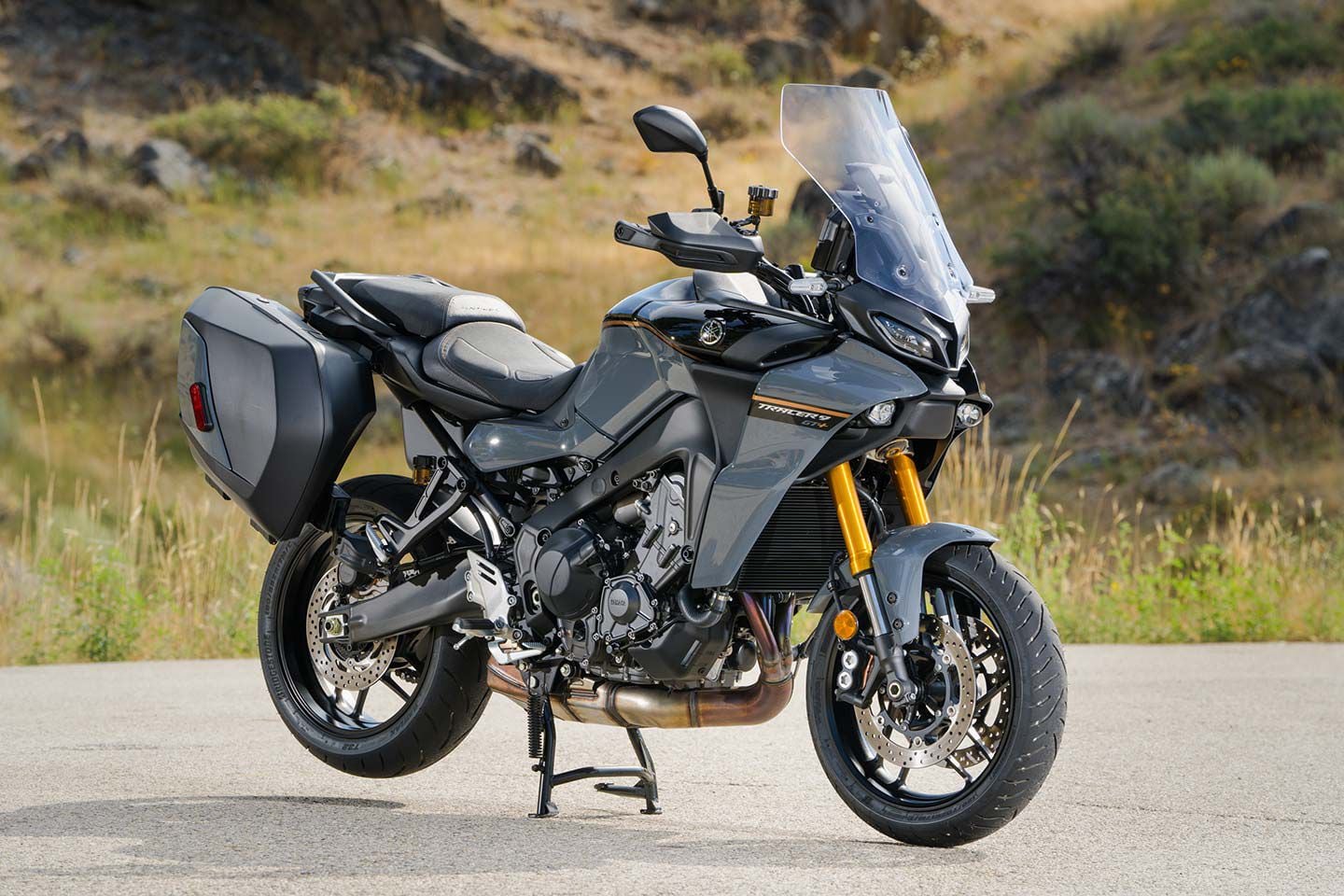
Yamaha’s 2024 Tracer 9 GT+ is packed with high-tech features not offered in the price range normally. (Joseph Agustin/)Less weight compared to open-class models plus more technology and better balanced performance were clearly the goals for the new 9 GT+. There is no question that Yamaha achieved the first two, on paper at least. The GT+ weighs a whopping 150 pounds less than the FJR1300ES, and comes packed with a comprehensive suite of electronics, including an industry-first use of Radar-linked Unified Braking System. As for the goal of achieving better balanced performance, we’re here to find out, spending a day riding the bike in the mountains around Boise, Idaho.
Here’s a quick rundown of some of the standout new features that put the plus in GT+. One of the most significant additions is the Adaptive Cruise Control that utilizes front-facing millimeter wave radar to actively maintain a preset distance to the vehicle in front of you. Also utilizing the radar is the industry-first Radar-linked Unified Brake System that can help aid the rider in certain braking situations by optimizing braking force and or bias front to rear. More obvious from the saddle is the new 7-inch full-color TFT display and new control pods for navigation of menus. The KYB electronic suspension has been updated to work in unison with the radar/cruise features, while a more sophisticated quickshifter rounds out major updates.
Engine
The Tracer 9 GT+’s engine is a liquid-cooled 890cc inline-triple with twin overhead cams and four valves per cylinder. Bore and stroke measure 78 x 62.1mm with forged aluminum pistons sliding in direct-plated ceramic-composite cylinder bores. The compression ratio is 11.5:1. The last time we had a Tracer 9 GT on the Cycle World dyno it produced a healthy 104.2 hp at 9,900 rpm and 62.2 lb.-ft. of peak torque at 6,990 rpm at the rear wheel.
The throttle bodies are managed by Yamaha’s Chip Controlled Throttle (YCC-T) that also incorporates the Accelerator Position Sensor Grip (ASPG) ride-by-wire system. The triple’s intake ducts have different lengths which not only help efficiency, but give the CP3 engine a unique sound.
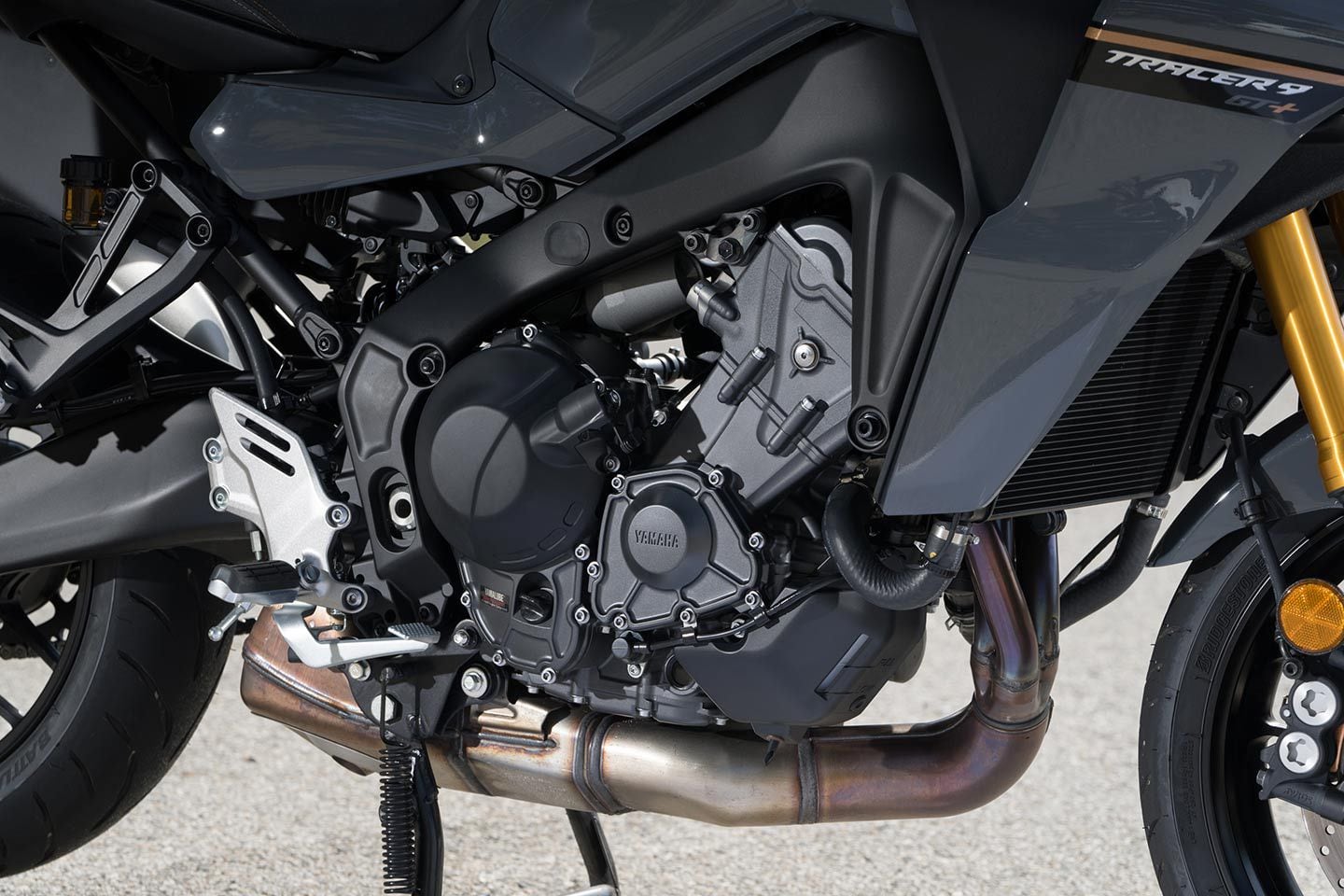
Yamaha’s CP3 inline-triple offers balanced performance for the Tracer 9 GT+. (Joseph Agustin/)Power is routed through an assist and slipper clutch that offers a light pull at the lever and then also provides slipper functionality. The six-speed transmission sends power to a chain final drive, which helps keep weight to a minimum at the expense of a little bit more maintenance compared to the FJR’s shaft final drive.
Traditionalists will argue that a sub-900cc sport-tourer just doesn’t have the oomph for the task at hand, but we beg to differ. The Tracer 9 GT+ is definitely leaning more toward the sporty side of the spectrum and the very nature of the triple delivers a flat torque curve and linear power delivery across the rev range. Weighing less than 500 pounds with a full tank of gas, the GT+ promises to deliver good performance.
Electronics
Yamaha’s Tracer 9 GT+ is a tech junkie’s dream. This bike is packed with a suite of electronics that rivals anything that European brands like BMW, Ducati, Triumph, and KTM, have set the standard with.
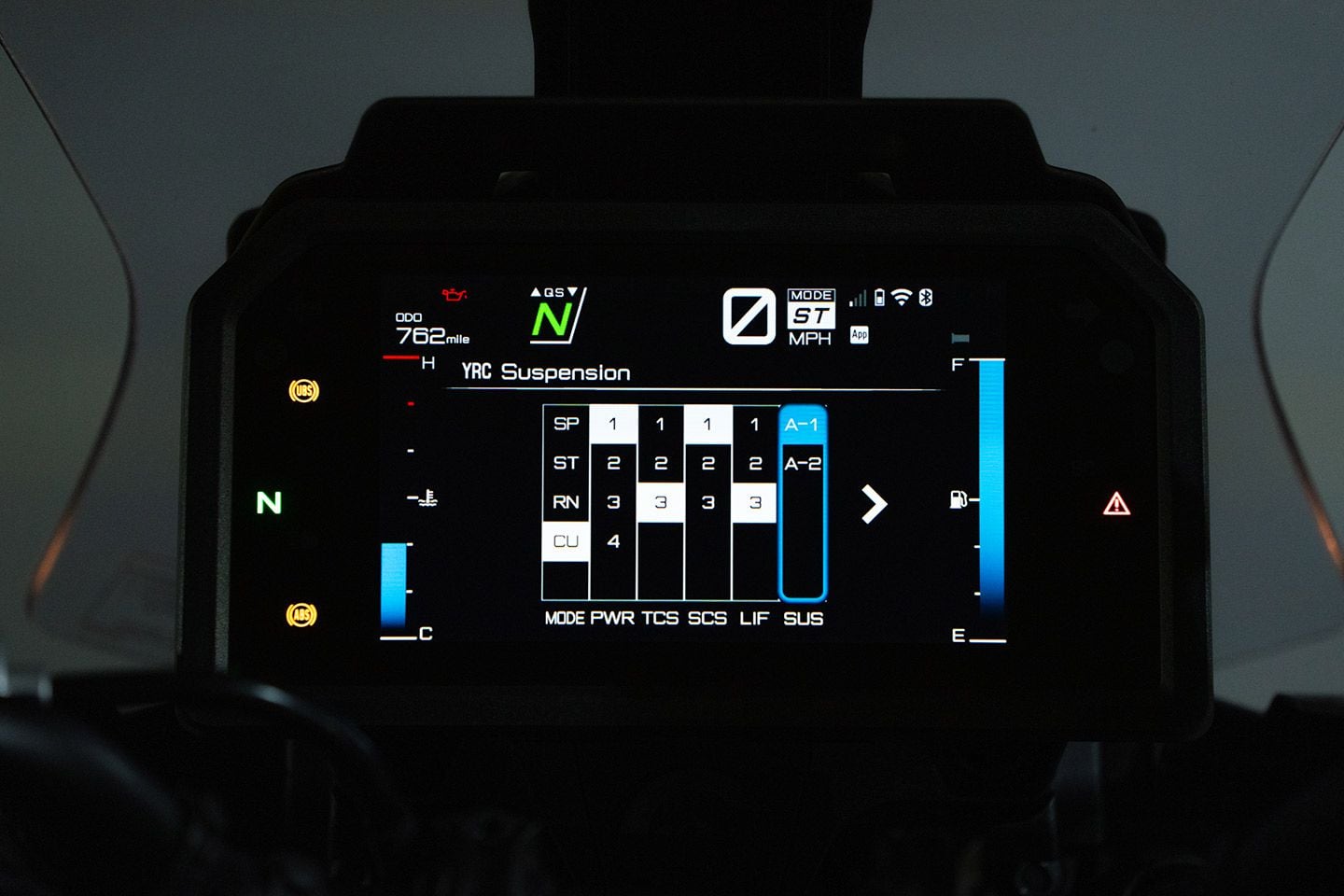
The GT+’s modes and rider aids are easy to alter with the new interface. (Joseph Agustin/)Starting with the traditional rider aids, at the core is a six-axis IMU that gives the GT+ the ability to provide lean-sensitive intervention for many features. These aids have preset levels associated with the three ride modes: Sport, Street, and Rain. A fourth Custom mode allows the user to set up the parameters to preference. Inside of those Integrated Ride Modes are four settings for Power, three traction-control choices, three slide control (SCS) settings, three wheelie-control (LIF) options, in addition to Off, and two semi-active suspension choices (addressed further below). The new third-gen quickshifter can also be set to only help with upshifts, only downshifts, both, or shut off completely.
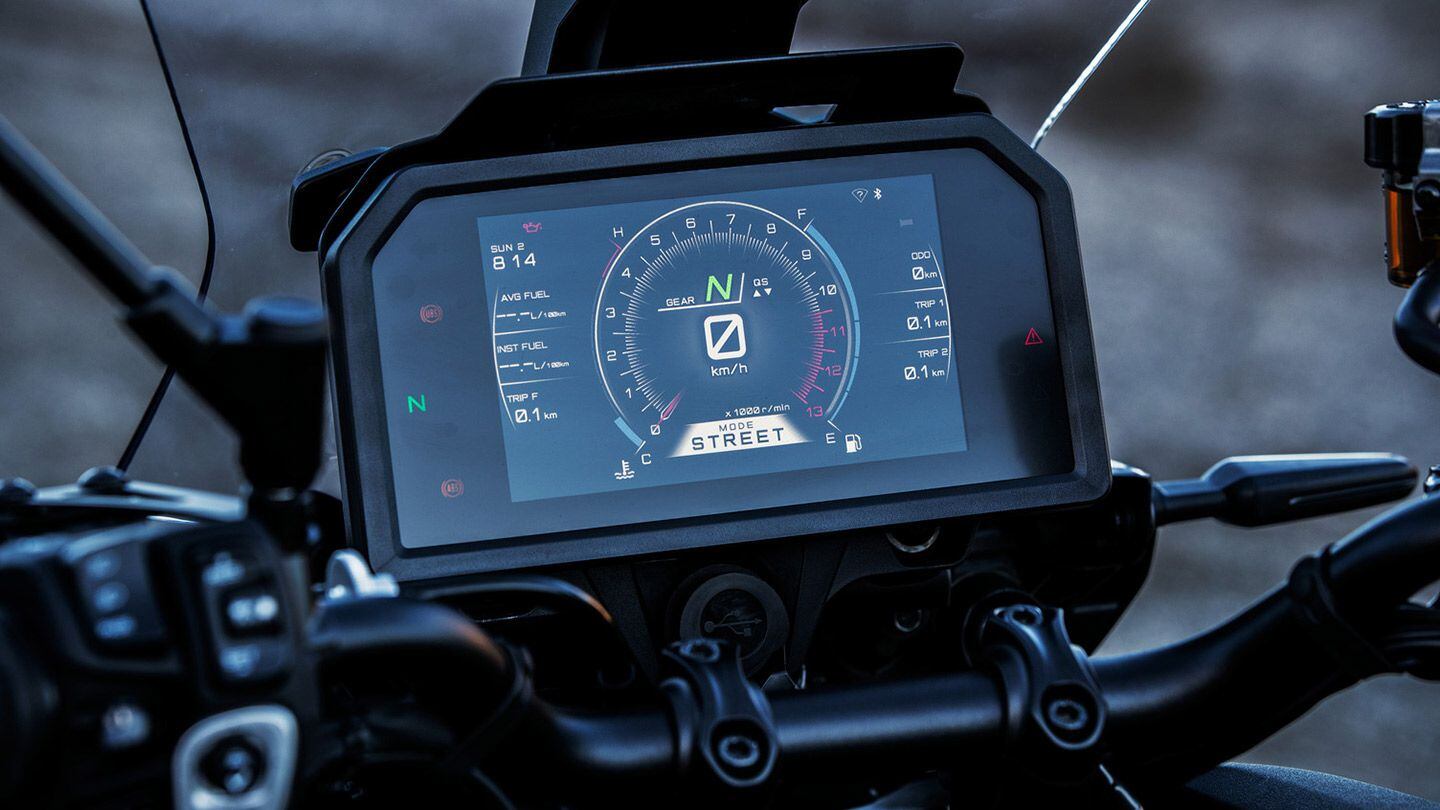
The brand-new 7-inch TFT display offers abundant info, and offers multiple view options. (Joseph Agustin/)Gone are the former twin info screens of the previous model, which are replaced by a beautiful 7-inch full-color TFT display. This screen blows away anything offered on any other current Yamaha. Not only is it bright and easy to read (helped in part by an anti-glare coating) but it has options for three display styles. From a functionality standpoint, the new handlebar control pods make menu navigation much better than the click wheel of old, which has been replaced with a joystick similar to the one on the new Ducati Multistrada that we’ve raved about.
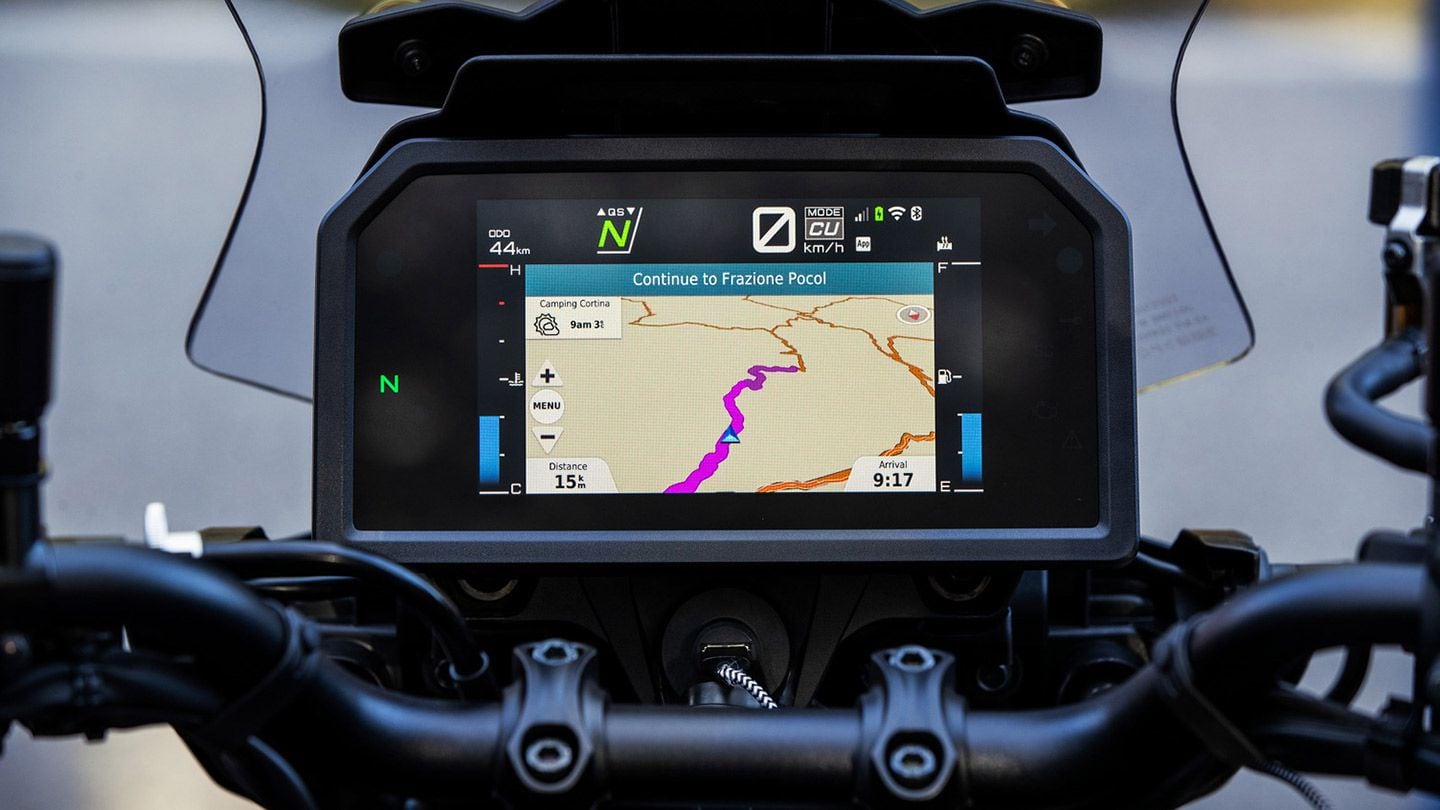
Bluetooth connectivity allows users to tether smartphones to the dash for music, calls, texts. While Garmin’s Motorize app provides on-screen navigation. (Joseph Agustin/)You can now connect your smartphone via Bluetooth without having to use a third-party app, which allows you to connect a helmet communication system and control music, as well as place and receive calls. For those who want a bit more the Yamaha MyRide app can be downloaded, which also allows you to utilize the Garmin Motorize app for on-screen navigation functionality.
Two major new electronic features are associated with the millimeter-wave radar unit mounted under the headlights. Adaptive Cruise Control is the most significant of the pair, allowing modern automotive-style control to the Tracer 9 GT+. The system allows the rider to set desired speed between 20 and 99 mph in any gear. And the new quickshifter won’t interrupt the cruise control, allowing you to shift while it’s set without disengagement.
Following gap has four settings, which the bike maintains via information from the radar unit, then uses engine-braking (first), and brake application (second) to maintain the gap. Like similar systems, if you’re approaching a vehicle ahead, the bike will slow to maintain the set distance, then when you pull out to pass it will utilize all of the electronic systems (lean angle, suspension) to smoothly accelerate back up to your set speed. In order for cruise to be activated TCS, SCS, and LIF must be on.
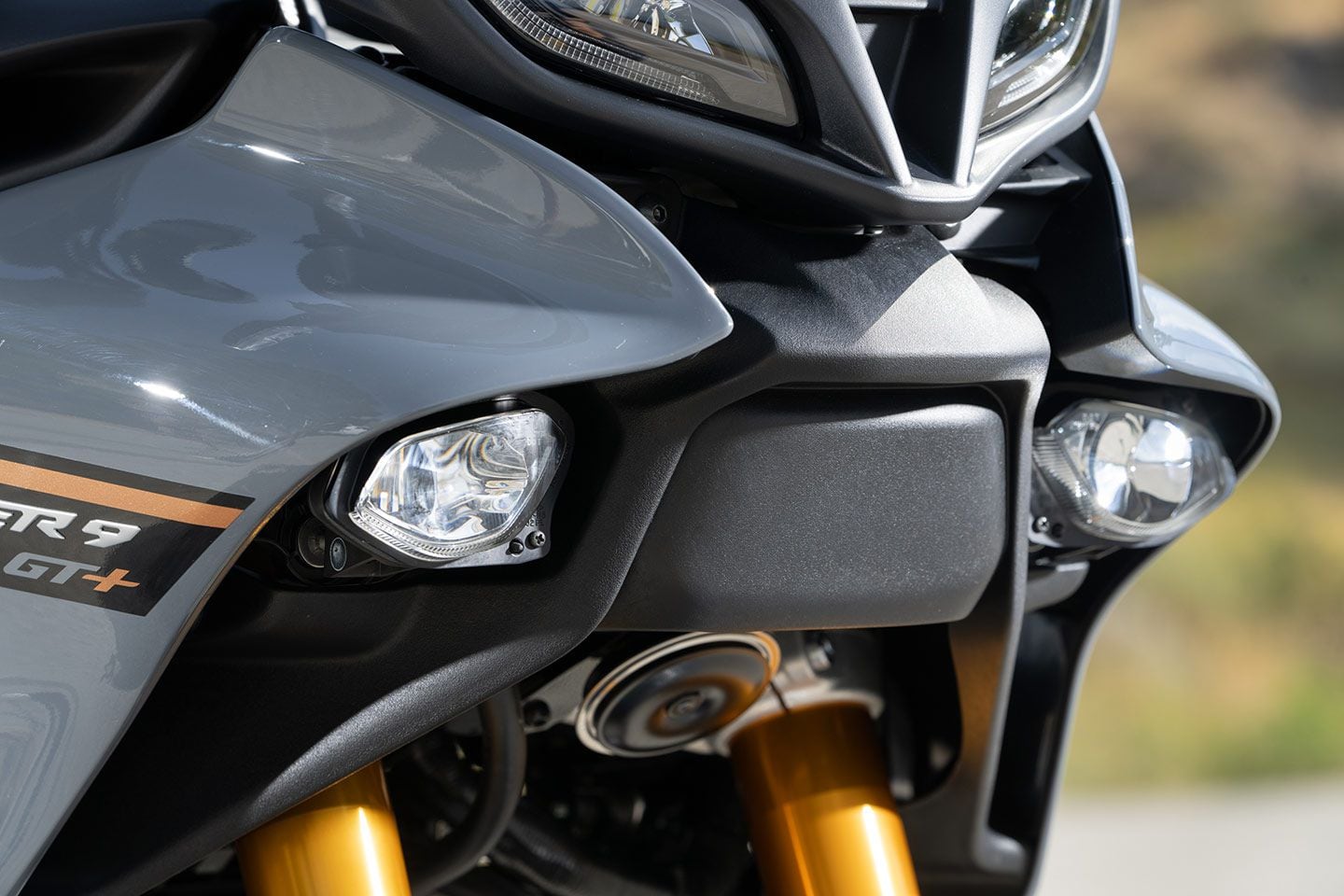
In between the cornering beam lights resides the millimeter wave radar unit. (Joseph Agustin/)Yamaha says that its new Radar-linked Unified Braking System is an industry first. In short, it’s a system that can help the bike achieve more efficient and safe braking in certain situations. Yamaha is quick to point out that it isn’t a collision-avoidance system; what it’s designed to do is to aid the rider when braking if the radar detects an object in the bike’s path. If the system is on and the rider is already actively braking and it picks up an object/vehicle in the road, it can aid the rider by applying additional braking pressure to either the front, rear, or both brakes to help the bike stop as quickly as possible. The six-axis IMU knows the bike’s lean angle so it can manage the ABS accordingly. Additionally, it can add compression damping to the front suspension to keep the fork from diving excessively. The goal is to allow the bike to brake with maximum efficiency even if the rider’s inputs aren’t optimal.
New LED cornering lights will be appreciated by all. When the IMU detects a lean angle greater than seven degrees, the lights automatically illuminate the inside of the corner, regardless of whether high or low beam is selected.
Chassis
The anchor for all things chassis is the control-filled aluminum-diecast frame and aluminum swingarm. The lightweight chassis helps keep the Tracer 9 GT+ under 500 pounds at a claimed 492 (up from 485) with a full tank of fuel. Wheelbase spans 59.1 inches (which for reference is about 1-3/4 inches shorter than the FJR1300ES), while rake and trail measure 25 degrees and 4.3 inches, the former of which is a full degree steeper than the FJR. Yes, we are comparing apples to oranges, but it’s interesting to note the contrast between the OG Yamaha sport-tourer and the newest kid in the corral.
Geometry numbers are informative, but it’s really the GT+’s suspension that defines how the chassis performs. Like the previous model, this generation has KYB electronically controlled KADS suspension (KYB Actimatic Damper System). The key difference here is that the suspension is not only tethered to the six-axis IMU, but then linked to the two new radar features, the Adaptive Cruise Control and Unified Braking System, to allow the aforementioned damping adjustments; this required new algorithms for the software.
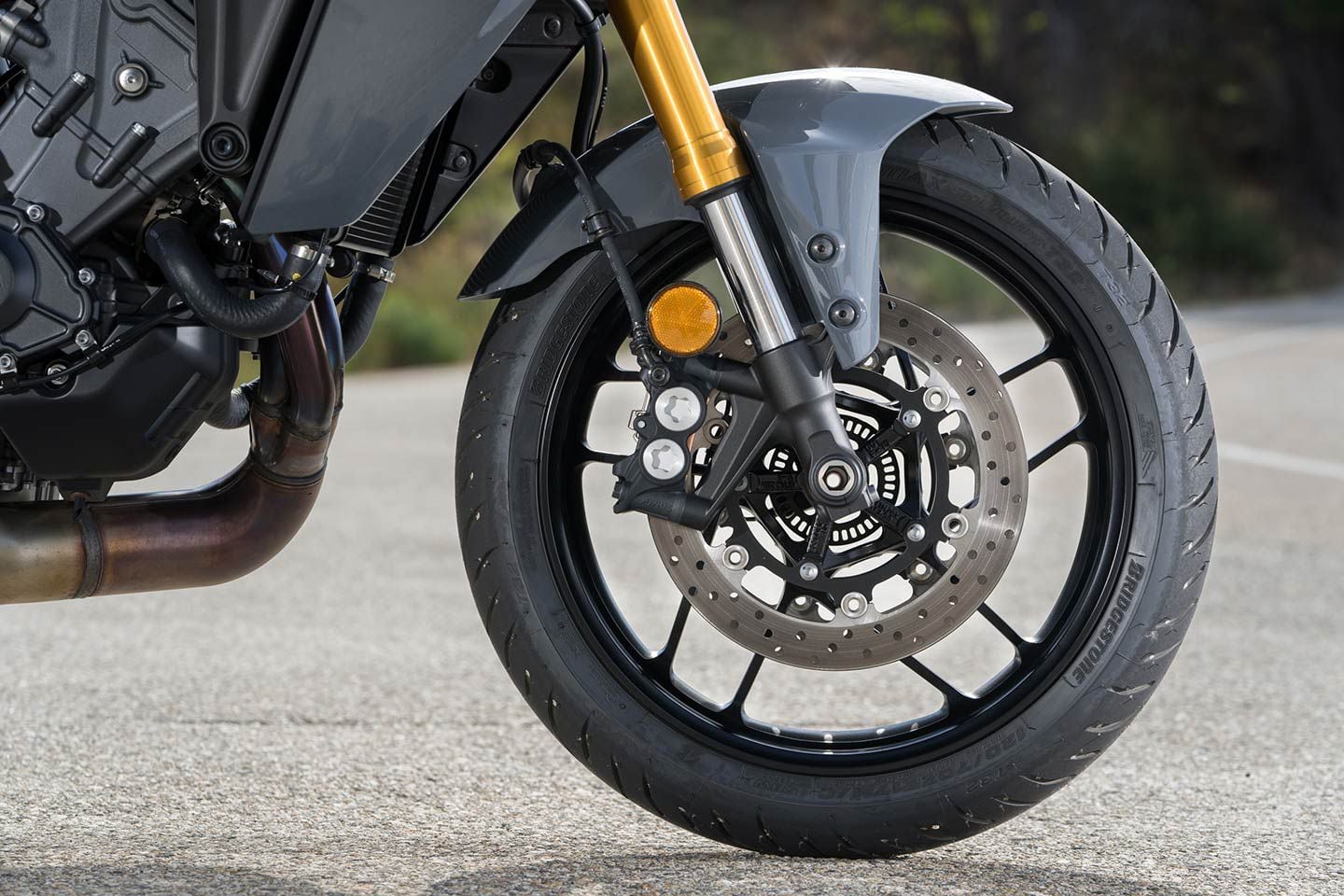
KYB semi-active suspension is also connected to the two new radar features to keep the front end from diving under braking when the cruise control or the Unified Brake System intervene. (Joseph Agustin/)There are two suspension-damping modes on the GT+; A-1 is the sportiest setting and A-2 is the comfort setting. Unlike other models like the MT-10 SP where damping settings can be manually altered, these are locked. However there are clickers for preload adjustment on the fork and there is an easy-to-access remote preload adjuster for the shock to help you compensate for extra loads such as a passenger and/or full luggage.
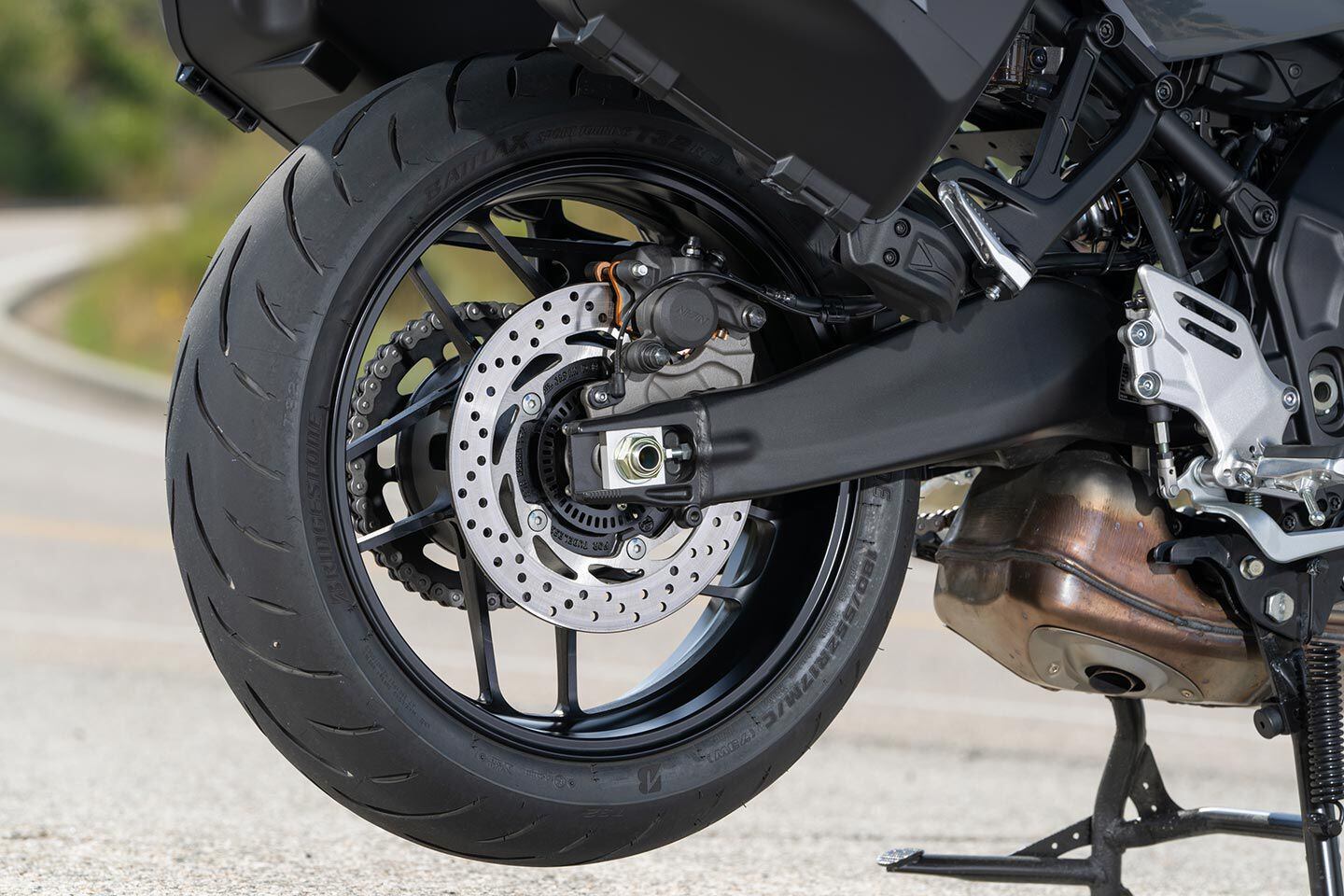
A larger 267mm rear disc is used because the Unified Brake System will likely depend on the rear brake more than most users would on their own. (Joseph Agustin/)We’ve already covered the electronic aspects of the Unified Braking System, but the hardware consists of a pair of four-piston radial-mount calipers up front, pinching a pair of 298mm discs and fed by a Nissin radial master cylinder. Out back is a 267mm disc (up from 245) that was increased in diameter because the Unified Braking System will likely use the rear brake more frequently than the user might do on their own.
Lightweight Spin-Forged Aluminum wheels are mounted with Bridgestone Battlax Sport Touring T32 tires in 120/70-17 front and 180/55-17 rear sizes.
Ergonomics/Touring Features
Comfort is a high priority on any sport-touring model, so Yamaha made sure that the Tracer 9 GT+ could accommodate a wide variety of riders. The revised seat has a new shape with softer foam and can be adjusted to two standard positions (32.3 or 32.9 inches). Furthermore, the footpegs can be adjusted to two different heights (the secondary position is 14mm higher and 4mm back), while the handlebar can be moved 9mm forward and 4mm higher in its secondary position. The touring windscreen is adjustable with an easy-to-reach lever above the instrument stack that can be done on the fly.
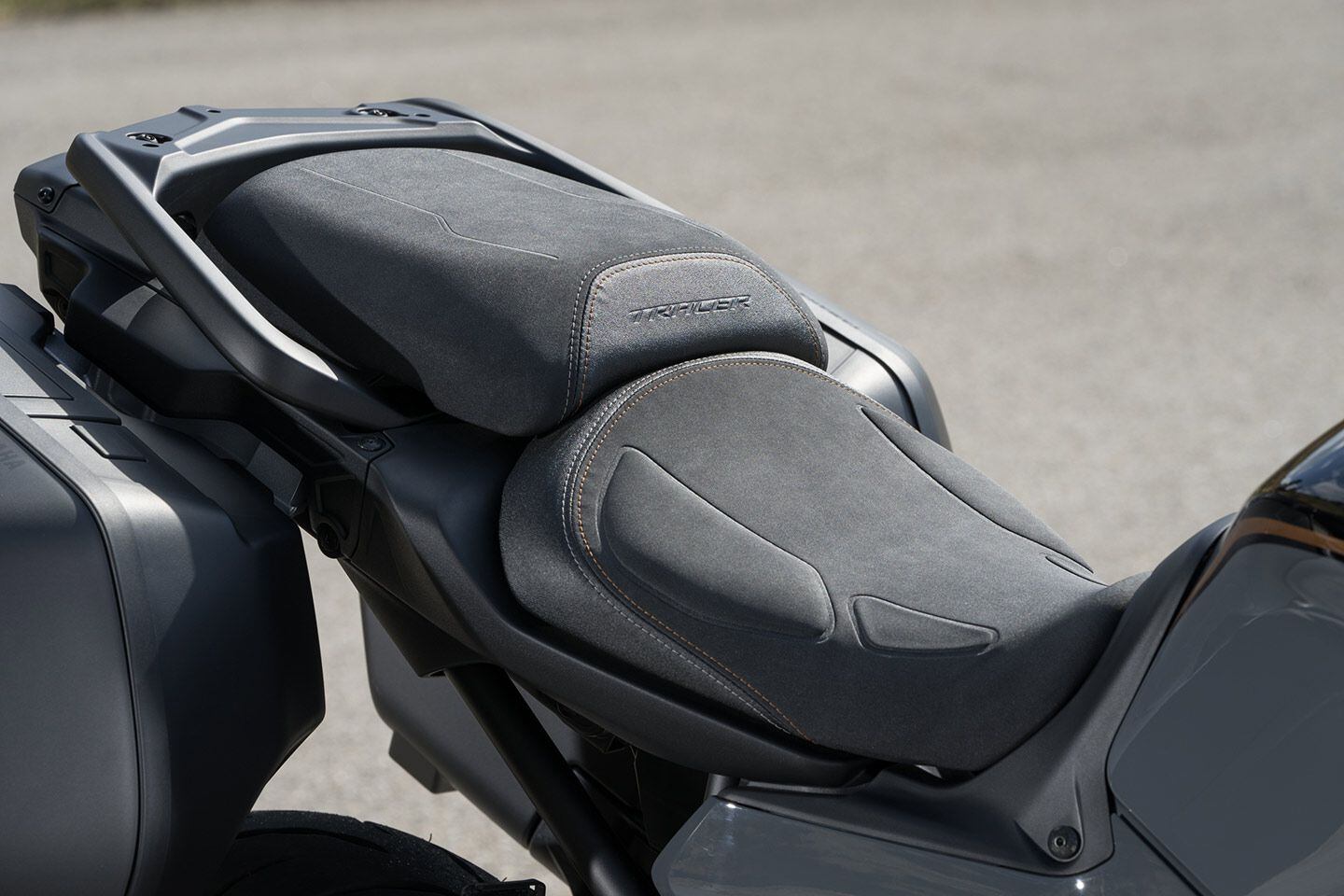
The newly shaped seat has two heights, 32.3 and 32.9 inches. A heated unit is available as an accessory. (Joseph Agustin/)Creature comforts include standard 10-stage adjustable heated grips while a heated seat is offered as an accessory. Other features included are a centerstand and the included rubber-damped, lockable side cases that offer 30 liters of storage each. An optional top case is available.
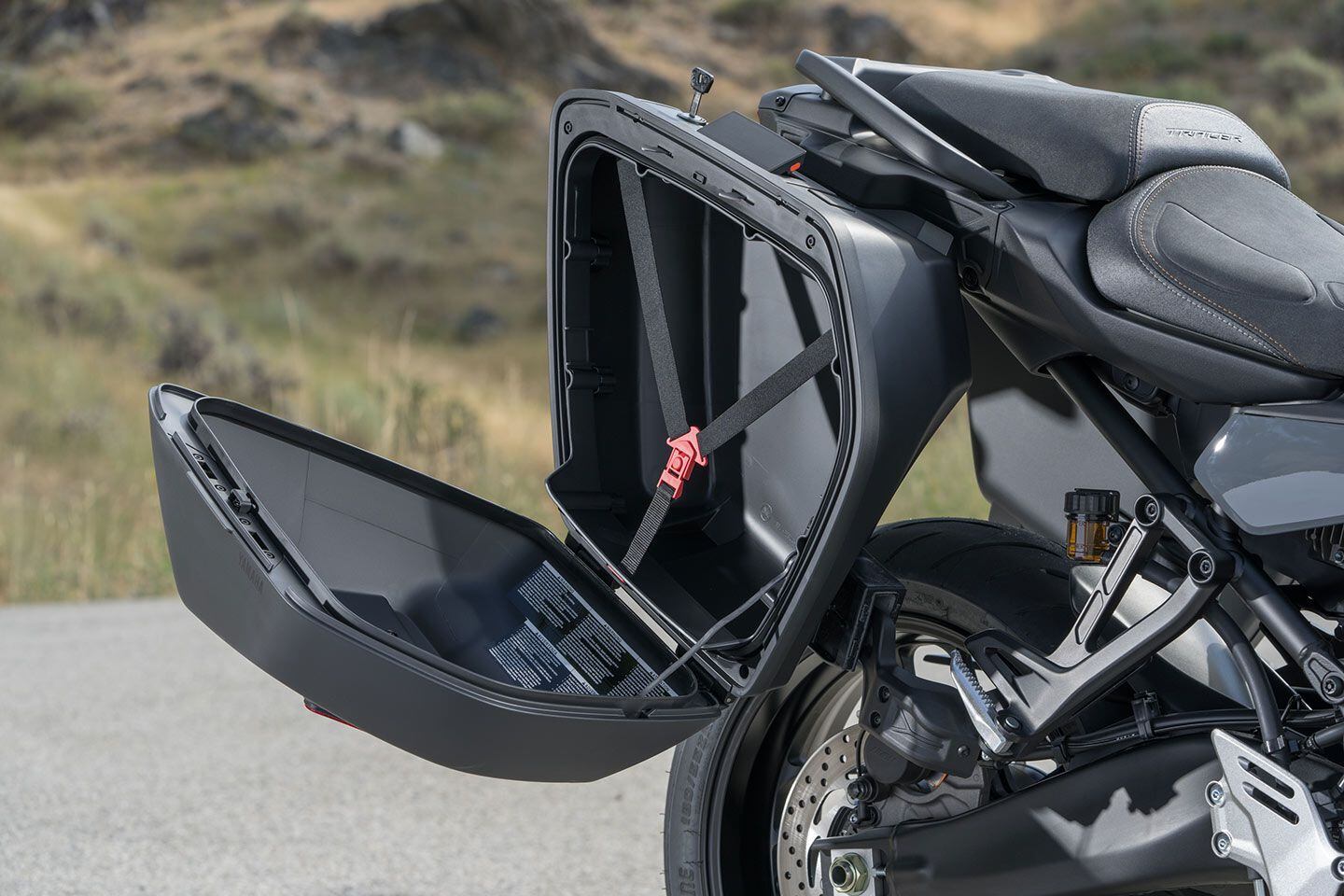
The 30-liter-capacity side cases have rubber dampers to keep bag contents from getting scrambled. (Joseph Agustin/)Riding Impression
Our day testing the bike in Idaho included everything from big sweeping curves along the Payette River to the tight mountain roads heading up to Bogus Basin ski area, plus a variety of highway and urban riding.
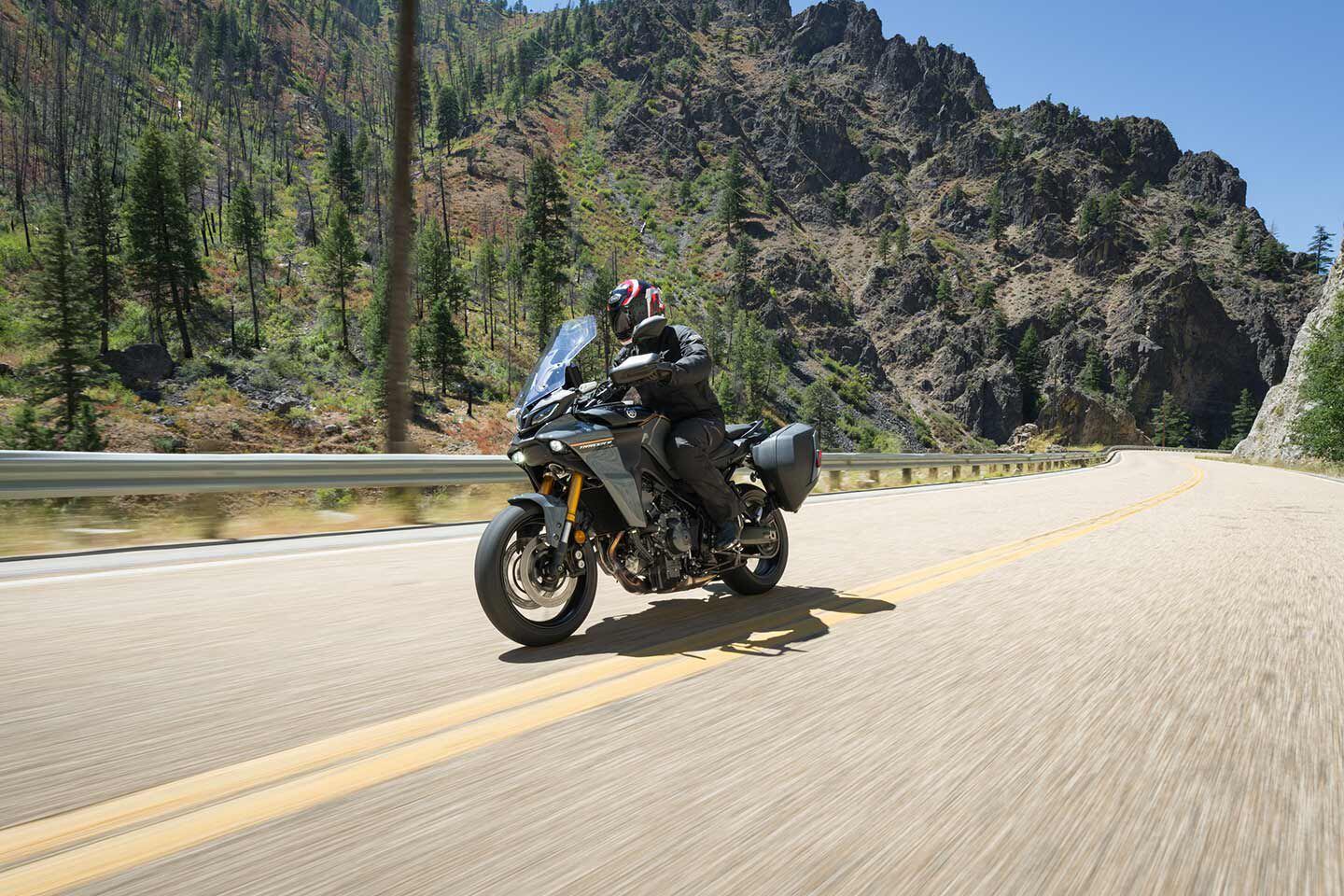
The fast sweepers along the Payette River near Boise, Idaho, were a blast on the GT+. (Joseph Agustin/)Rolling out of town for the mountains is one situation where the engine proves how versatile it is. In an urban setting, the low-end torque and smooth delivery make negotiating stop-and-go traffic no big deal. Easy getaways from stoplights are aided by a crisp clutch, while the updated quickshifter has been improved to better handle shifts while on the throttle or while decelerating. Response and shift-lever action are really good, with less notchiness than some other systems we’ve recently tried. It has good timing regardless of engine rpm.
Heading up the twisties to Bogus Basin is where the triple really shines. Ample bottom-to-midrange torque allows you to choose between a couple of gears for corner exits with second and third usually providing good drive for a fun and spirited pace. The Sport ride mode was selected to start the day to get a feel for the engine performance and rider aids. Overall, this is really the go-to setting we’d use most frequently, providing good response and the safety net of knowing the rider aids have your back.
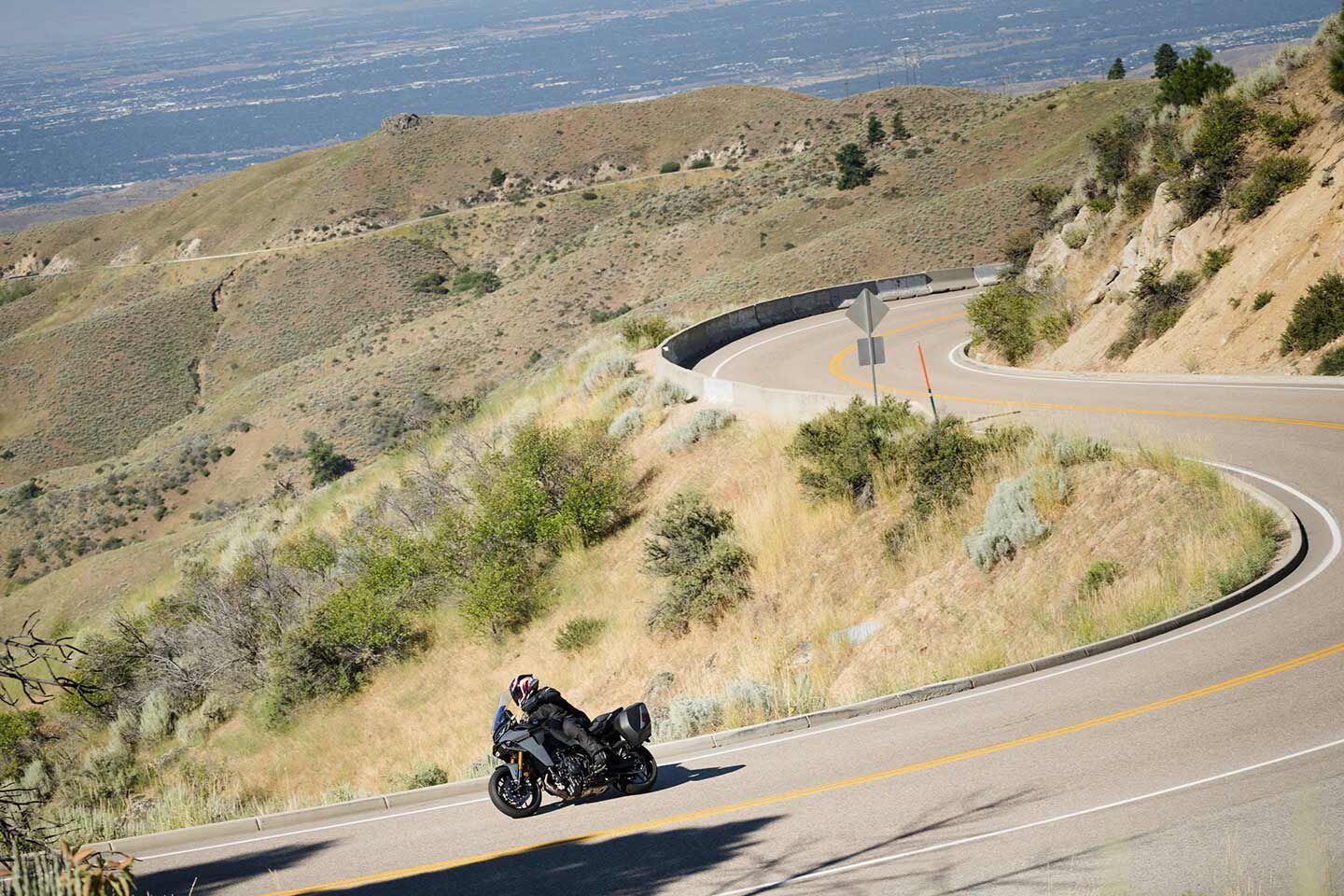
The Tracer 9 GT+ is in its element on a tight twisty road. (Joseph Agustin/)We also set up a Custom mode to get a sense of what the engine is like with TC and LIF turned off, and maybe see how the Tracer 9 GT+ is in the wheelie department. After confirming that it’s perfectly happy on the rear tire, we used Sport or Street for most of the day. The primary reason is that we wanted to try out the new Adaptive Cruise Control, and as mentioned TCS, SCS, and LIF must be active for the system to work.
Handling is quite good, with a really sporty and agile turn-in and lots of composure delivered with the electronic suspension midcorner and over rough asphalt. Despite weighing just shy of 500 pounds, the Tracer carries that weight well, and in no way is ever heavy steering through transitions or into tight carousel hairpins.
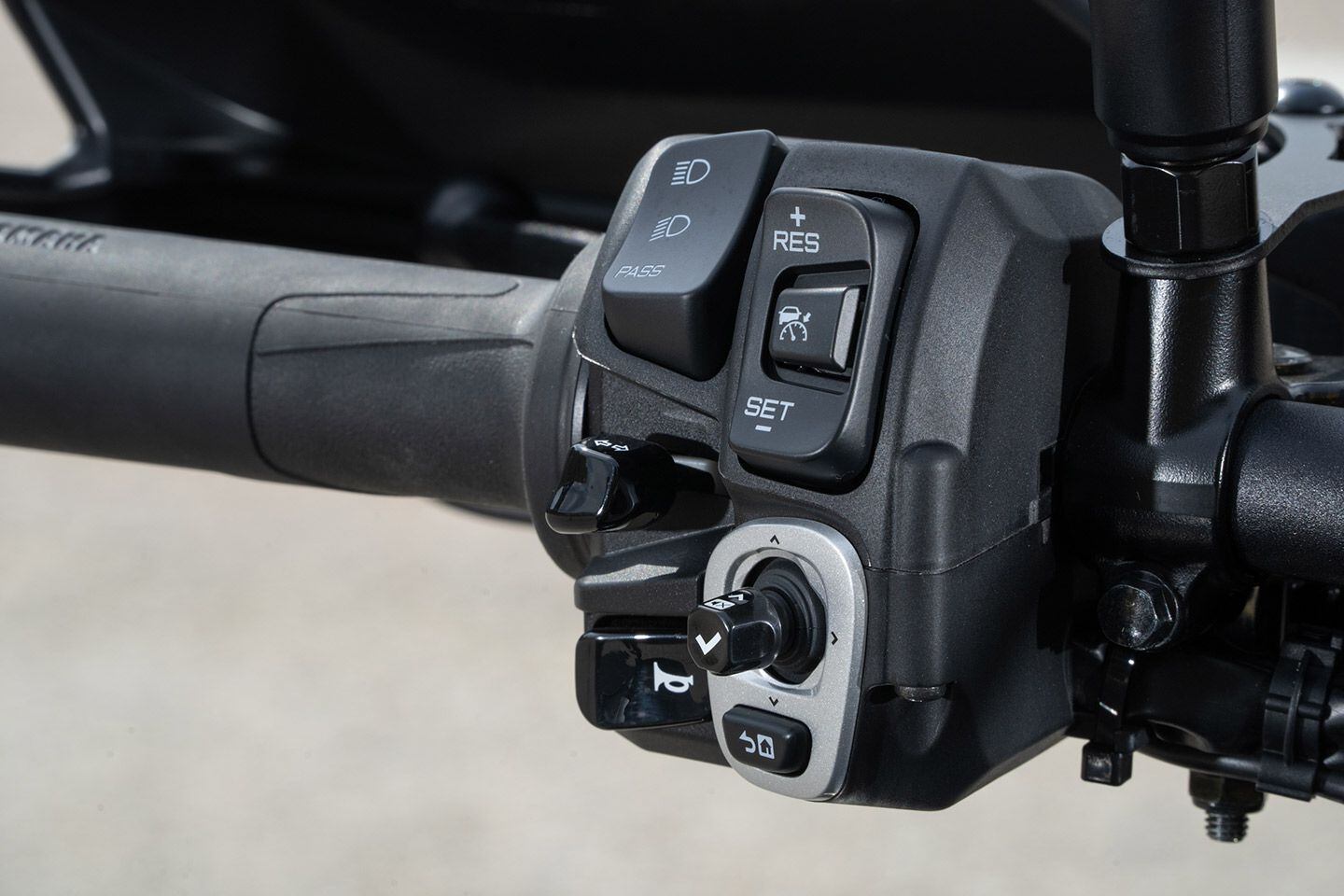
Yamaha’s new joystick and revised left-bar-mounted control pod greatly simplify menu navigation. (Joseph Agustin/)Perhaps one of the most obvious changes to the Tracer is the new 7-inch TFT display. This screen is excellent, offering lots of real estate for all the necessary information, but also allowing easy navigation with the new joystick to change settings. Perhaps a bit on the gimmicky side, one of the new display options turns the tach “needle” into a lightning show, with colored arcs following the needle’s path and changing colors. It’s kind of cool and different so we stuck with it.
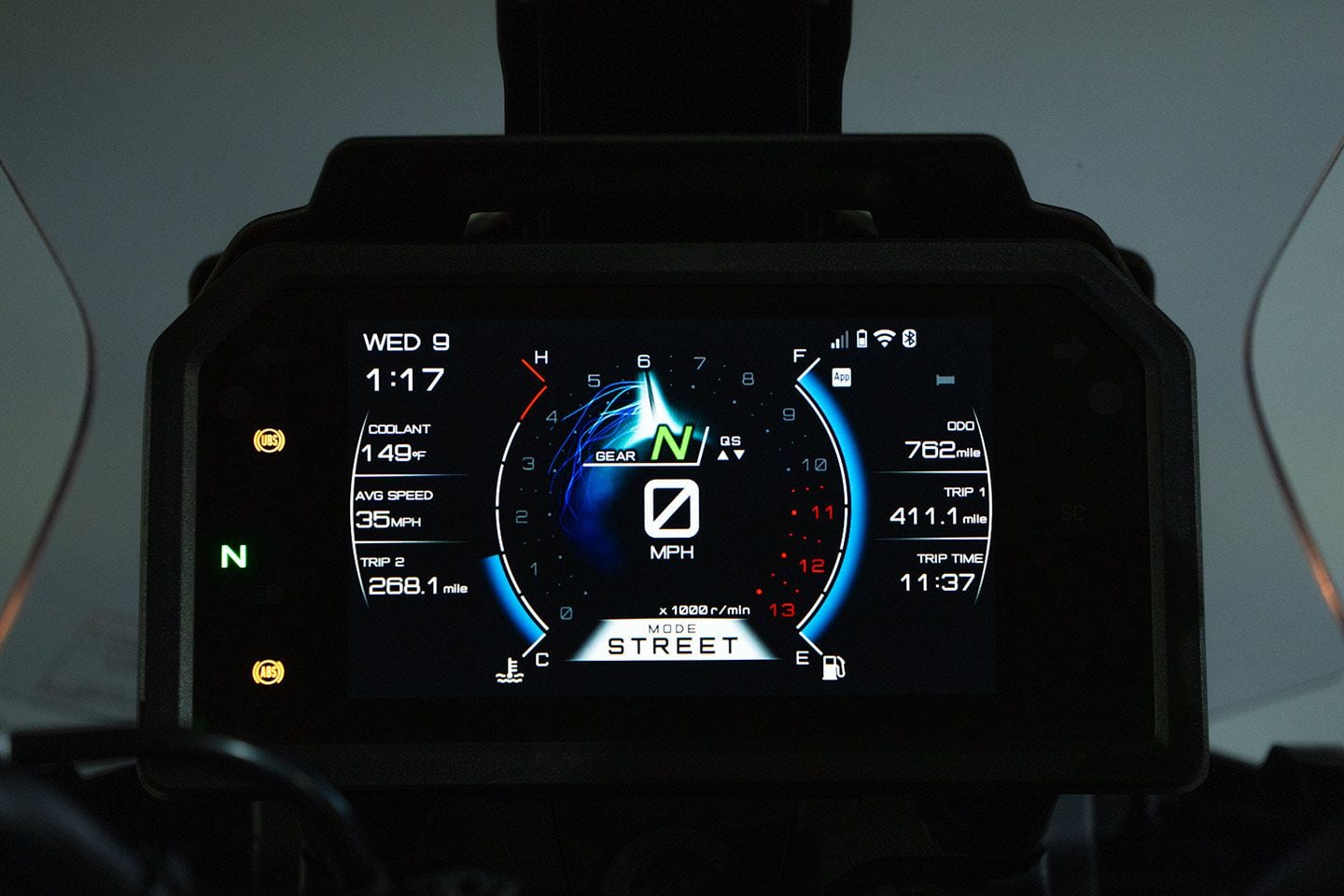
Maybe a bit on the kitschy side, but we thought this display option with the lightning bolts tach was fun. (Joseph Agustin/)Between our morning photo stops heading up to Bogus Basin and lunch, we hit some highway and were able to try out the cruise control. Activating, setting the speed, then setting the distance to the vehicle in front of you is very intuitive. Like the few other motorcycles that we recently tried with this feature, namely the much more expensive Ducati Multistrada and KTM 1290 Super Adventure, the Tracer 9 GT+’s system works really well in most situations. The only Chinese in its armor that we discovered was when riding in a group of motorcycles in a staggered formation, the radar wouldn’t always see the bike at an angle in front of you, and instead was picking up the bike another layer ahead directly in front of you. This would sometimes confuse the system and make it struggle to recognize when to start slowing down.
Outside of that single scenario, it works great, and never failed to recognize a car or four-wheeled vehicle and maintain the distance. When you’re ready to pull out and pass, the system accelerates back up to your preset speed in a smooth manner without upsetting the chassis. Having just ridden across the country on a bike without this advanced type of cruise control we can say we wish we’d been on the Tracer. Just the fact that you don’t have to set and then disengage your setting every time you come up on another vehicle, and then reset it once you’ve made a pass, makes you wonder how you’ve ever lived with more rudimentary systems.
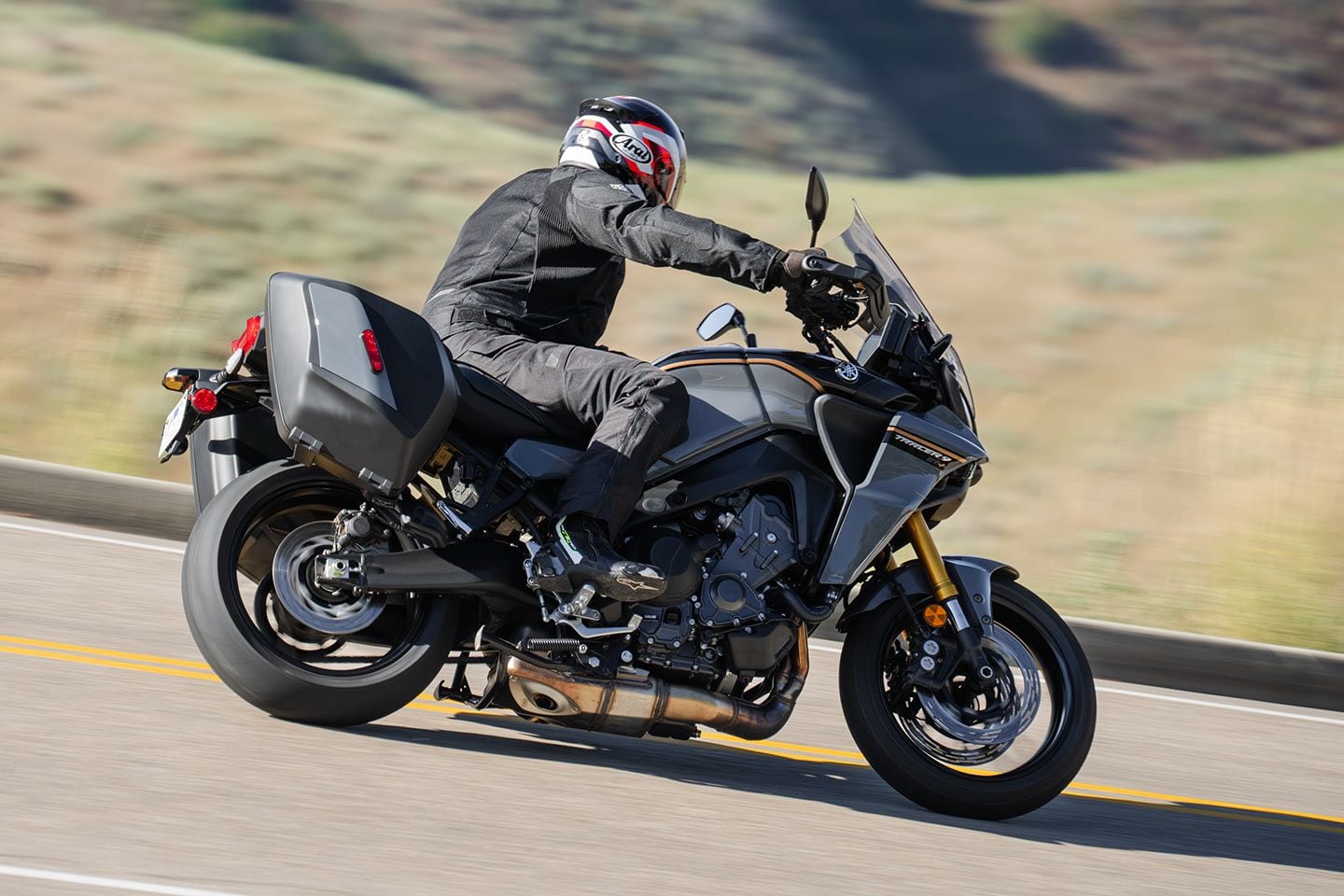
The Tracer 9 GT+ is just as happy on tight mountain roads as it is on the open highway, and that’s what a sport-touring model is all about. (Joseph Agustin/)If one was to ride across the country, the 9 GT+ would be an excellent choice. The ergonomics are sporty enough for spirited riding, but the rider triangle is relaxed and comfortable enough for long stints in the well-cushioned saddle. In the low seat setting, knees are just a bit past 90 degrees for this 5-foot-11 tester, but on a longer ride raising the seat to the high setting would give all-day comfort. Bar position is really good in the stock setting, with arms falling to a dead level plane, but as mentioned can be changed to preference. The tall touring windscreen allows a good clear view when riding in the tight twisties, and also provides a lot of wind protection and will definitely keep you in a nice bubble in the rain. The adjustable lever is easy to use in most circumstances, but at high speeds, wind pressure on the screen made it hard to move up and down.
We never faced a situation where we detected the Unified Braking System in action. We either never were in a situation that triggered it, or in the situation where we did, its intervention was smooth and undetectable. We’ll test this further when we get a testbike back at HQ.
Conclusion
If the Tracer 9 GT+ is Yamaha’s vision of sport-touring for the foreseeable future, we like it. This bike is all about balance between power, weight, and features. By keeping the weight down, Yamaha is able to use the lightweight CP3 engine and provide solid engine performance. Overall, we think the triple is a great fit in this machine, providing a fun and torquey power delivery and yet is smooth and relaxed for long-distance rides. Compared to the big-bore offerings on the market, we really didn’t feel like the Tracer 9 GT+ is missing out in the engine department.
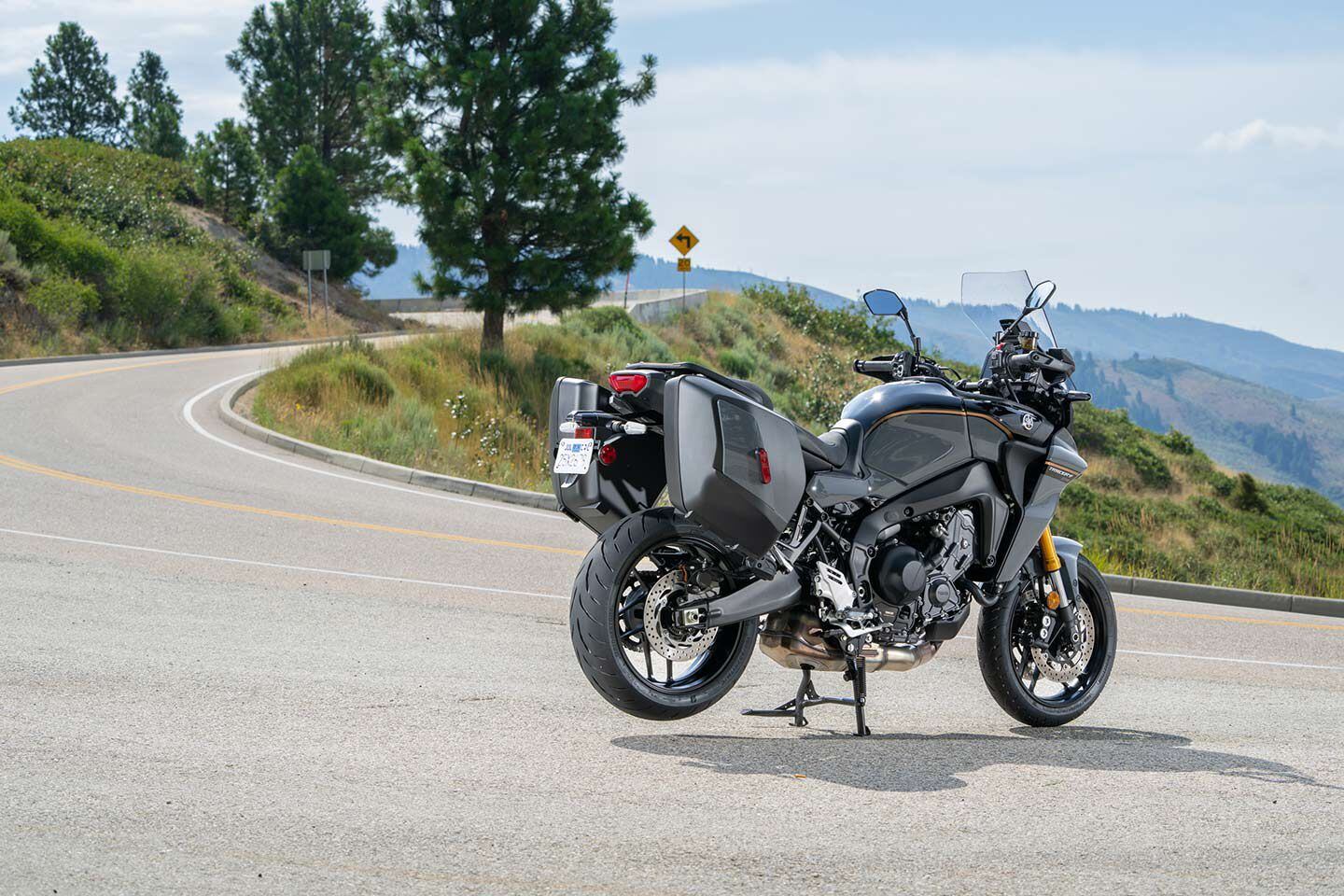
The Tracer 9 GT+ represents a good value as there aren’t too many other bikes—if any—in its price range with as strong of a technical package. (Joseph Agustin/)When it comes to electronics, there simply isn’t anything else in the middleweight class with this level of technology, let alone at such a reasonable price. Yamaha pulled a rabbit out of the hat when it included the two new radar-related features, electronic suspension, and top-notch rider-interface display and was still able to keep the price at $16,499. Most of the other bikes on the market with similar features are pushing $30,000. Sure, those models have open-class V-twins and V-4s, but those looking for all the technological bells and whistles who don’t want to spend a fortune or deal with larger, heavier bikes, the Yamaha Tracer 9 GT+ must be considered.
Back to the point of a balanced package, the Tracer 9 GT+ has light and flickable handling which addresses the sport side of the equation, but the long list of touring amenities and adjustable ergonomics account for the touring side. Overall, there is very little to fault with the 9 GT+, just a few little things like the windscreen not being super easy to adjust on the fly, we’d love some improved mirrors that offer a better rearward view, and it would be nice to be able to get in and manually alter some of the damping settings. But that’s about it with the faults of the bike. If slaying miles and miles of twisty roads on the way to a far off destination is your goal, the Tracer 9 GT+ checks all the boxes.
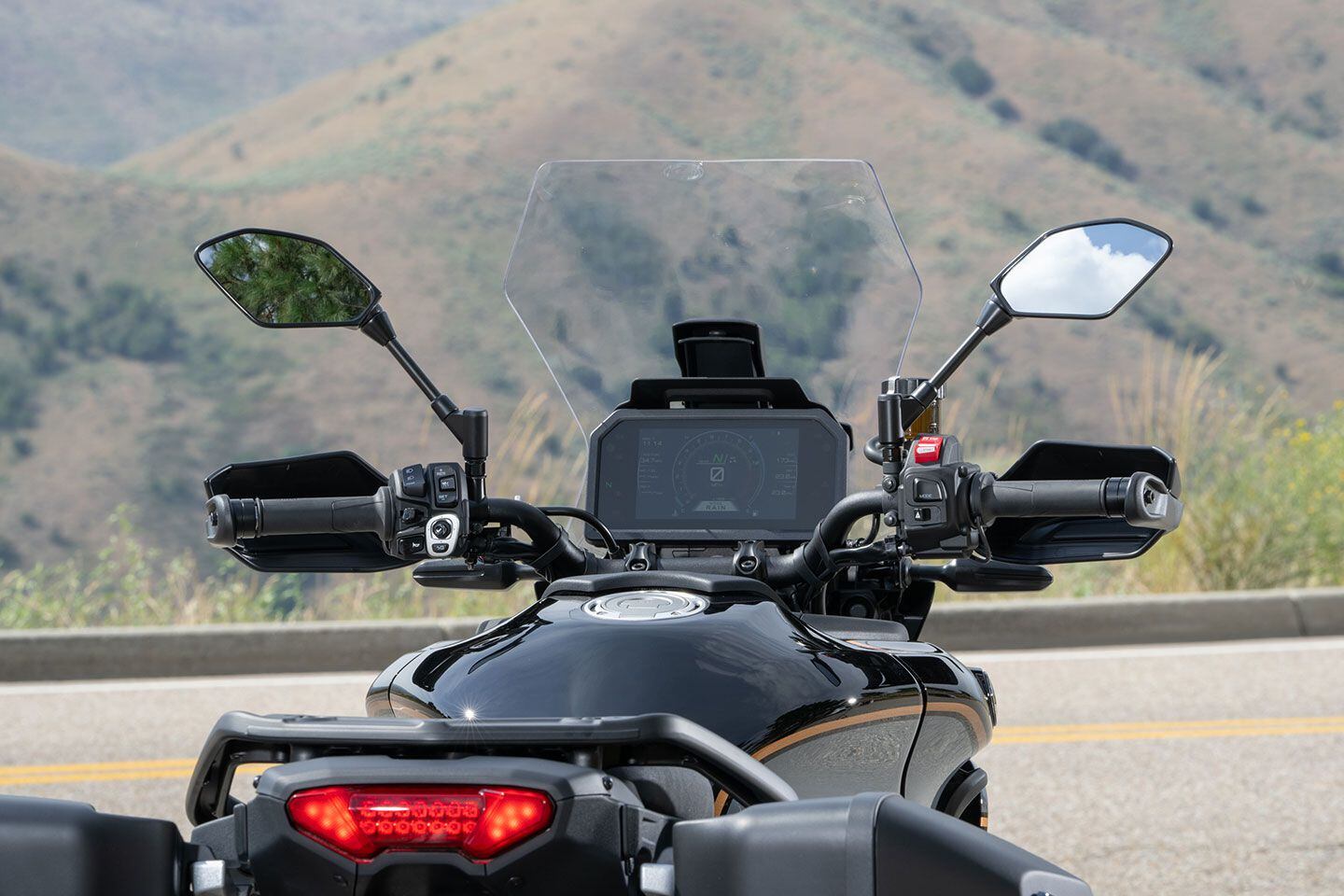
About the only thing we can fault in this cockpit are the mirrors, which could use slightly longer stalks. (Joseph Agustin/)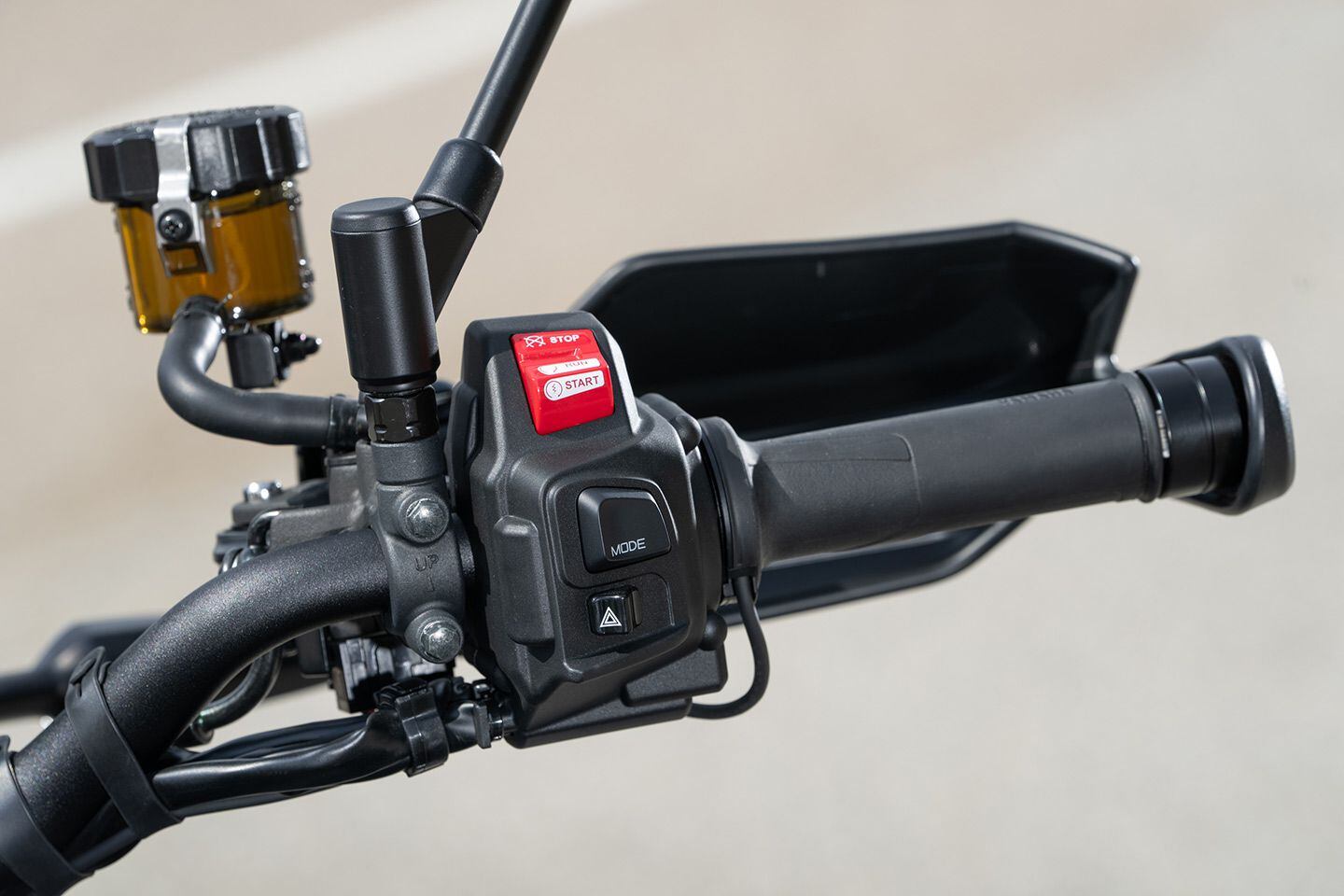
Mode changes can quickly be made on the fly from the right bar control pod. (Joseph Agustin/)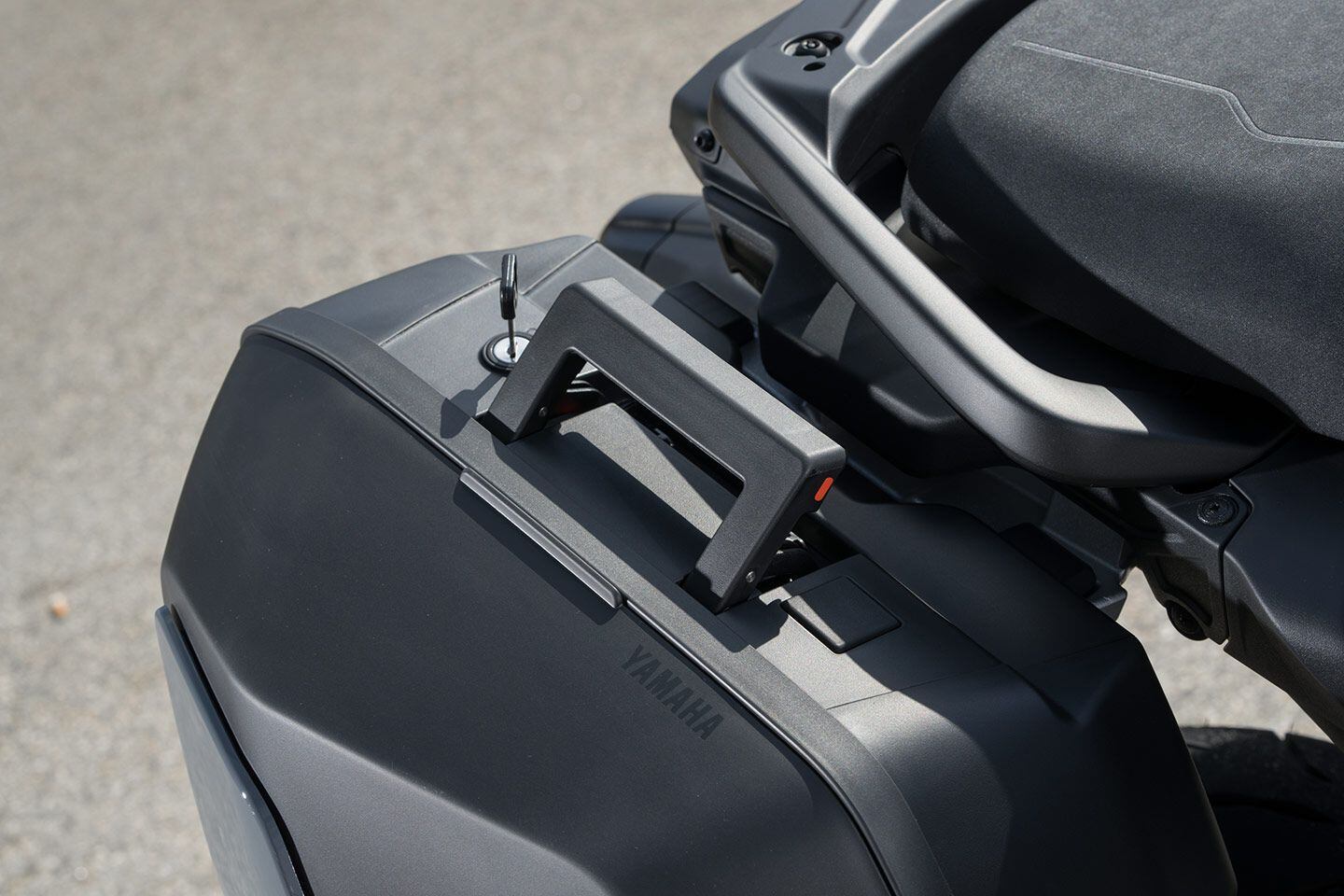
Lockable side cases use the same key as the ignition. (Joseph Agustin/)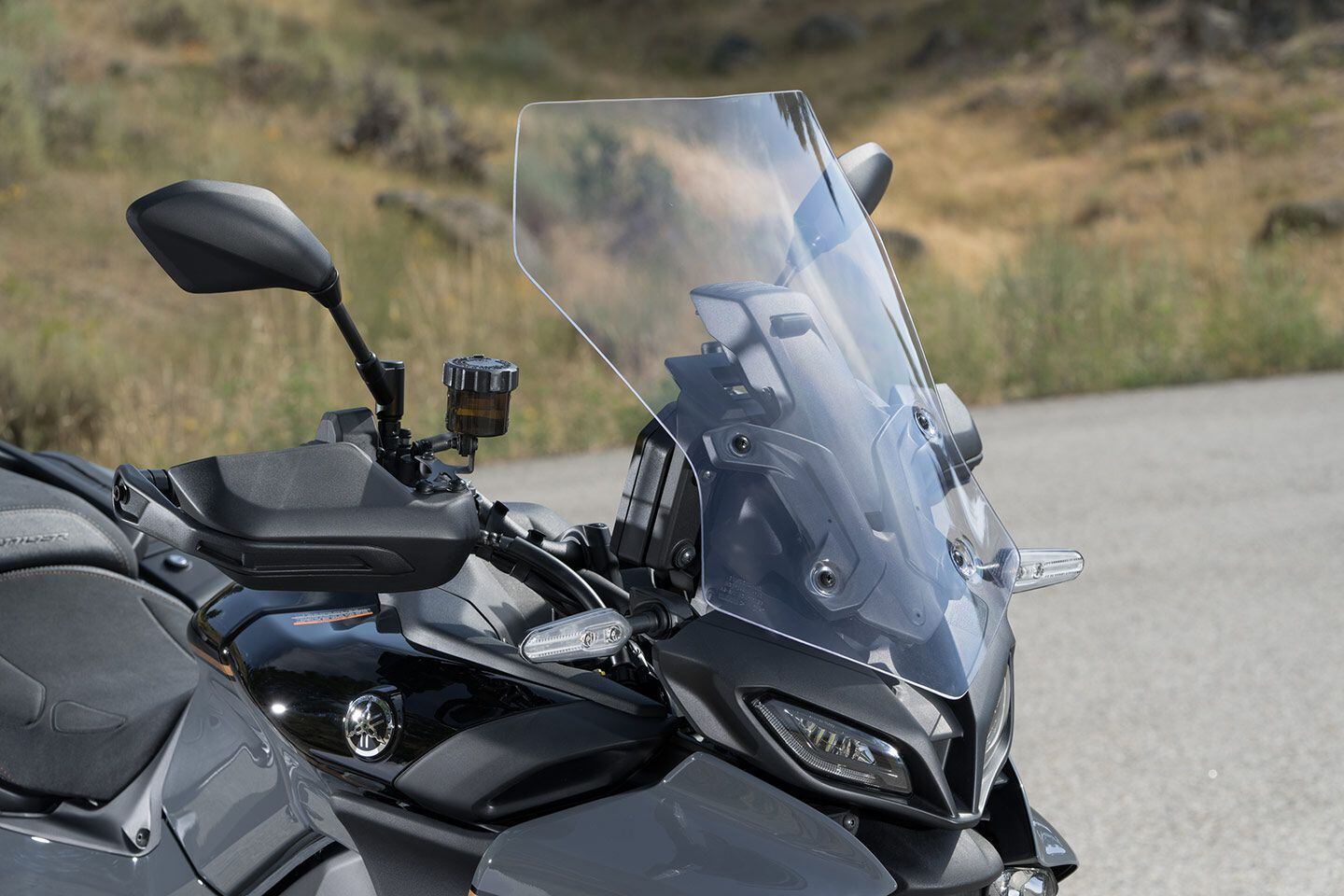
The windscreen can be adjusted with a lever above the dash on the fly. (Joseph Agustin/)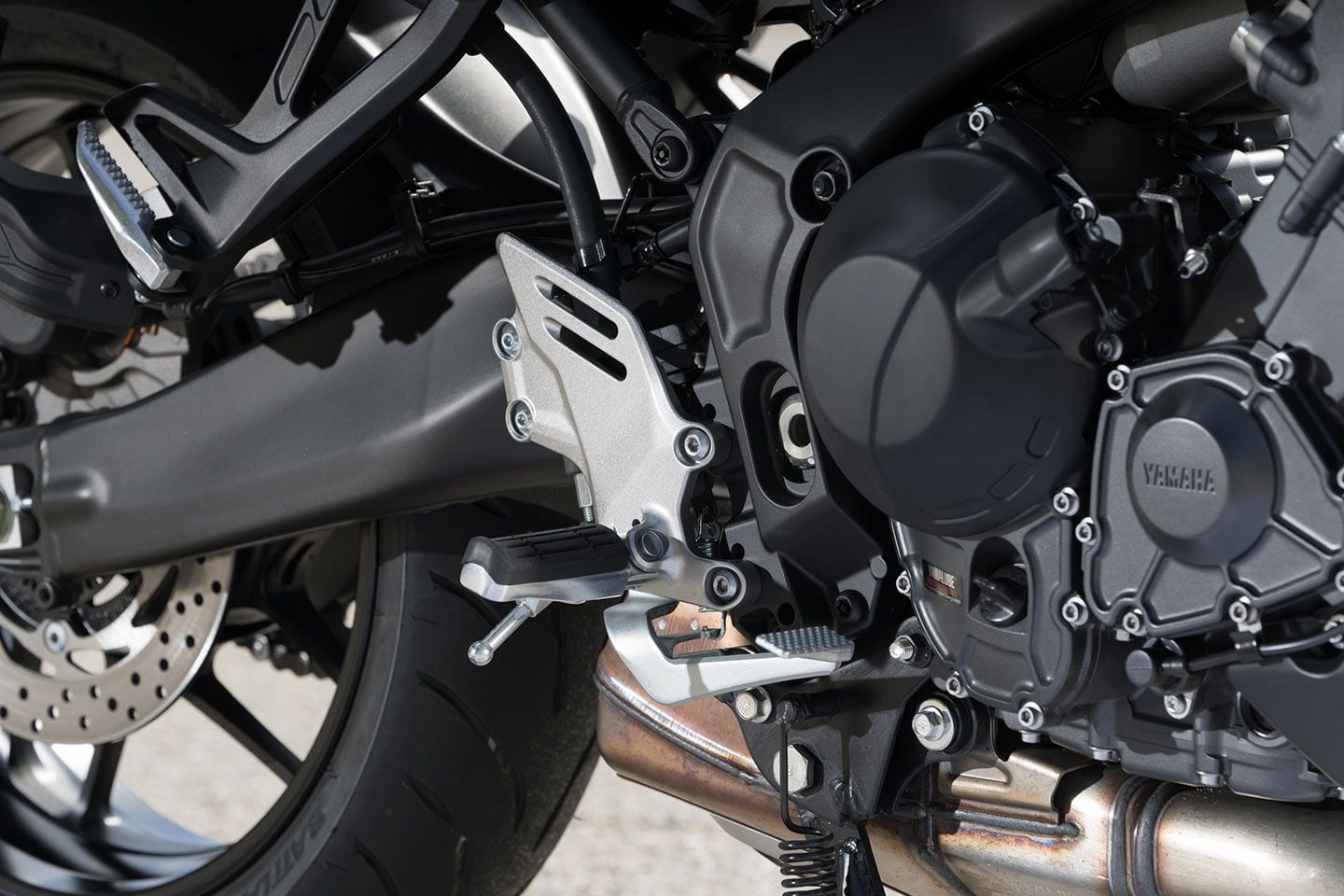
Adjustable footpegs allow two settings, a high and low position. (Joseph Agustin/)2024 Yamaha Tracer 9 GT+ Specs
MSRP: $16,499 Engine: DOHC, liquid-cooled inline 3-cylinder; 4 valves/cyl. Displacement: 890cc Bore x Stroke: 78.0 x 62.1mm Compression Ratio: 11.5:1 Transmission/Final Drive: 6-speed/chain Fuel System: Fuel injection w/ YCC-T ride-by-wire Clutch: Wet, multiplate slipper/assist Engine Management/Ignition: TCI (Transistor Controlled Ignition) Frame: Cast aluminum Front Suspension: KYB 41mm fork, adjustable spring preload, electronically adjustable compression and rebound damping; 5.1 in. travel Rear Suspension: KYB shock, adjustable spring preload, electronically adjustable rebound damping; 5.4 in. travel Front Brake: Advics 4-piston calipers, dual 298mm discs w/ cornering ABS Rear Brake: 1-piston caliper, 267mm disc w/ ABS Tires, Front/Rear: Bridgestone Battlax Sport Touring T32; 120/70-17 / 180/55-17 Rake/Trail: 25.0°/4.3 in. Wheelbase: 59.1 in. Ground Clearance: 5.3 in. Seat Height: 32.3 in./32.9 in. Fuel Capacity: 5.0 gal. Claimed Wet Weight: 492 lb. Contact: yamahamotorsports.com GEARBOX
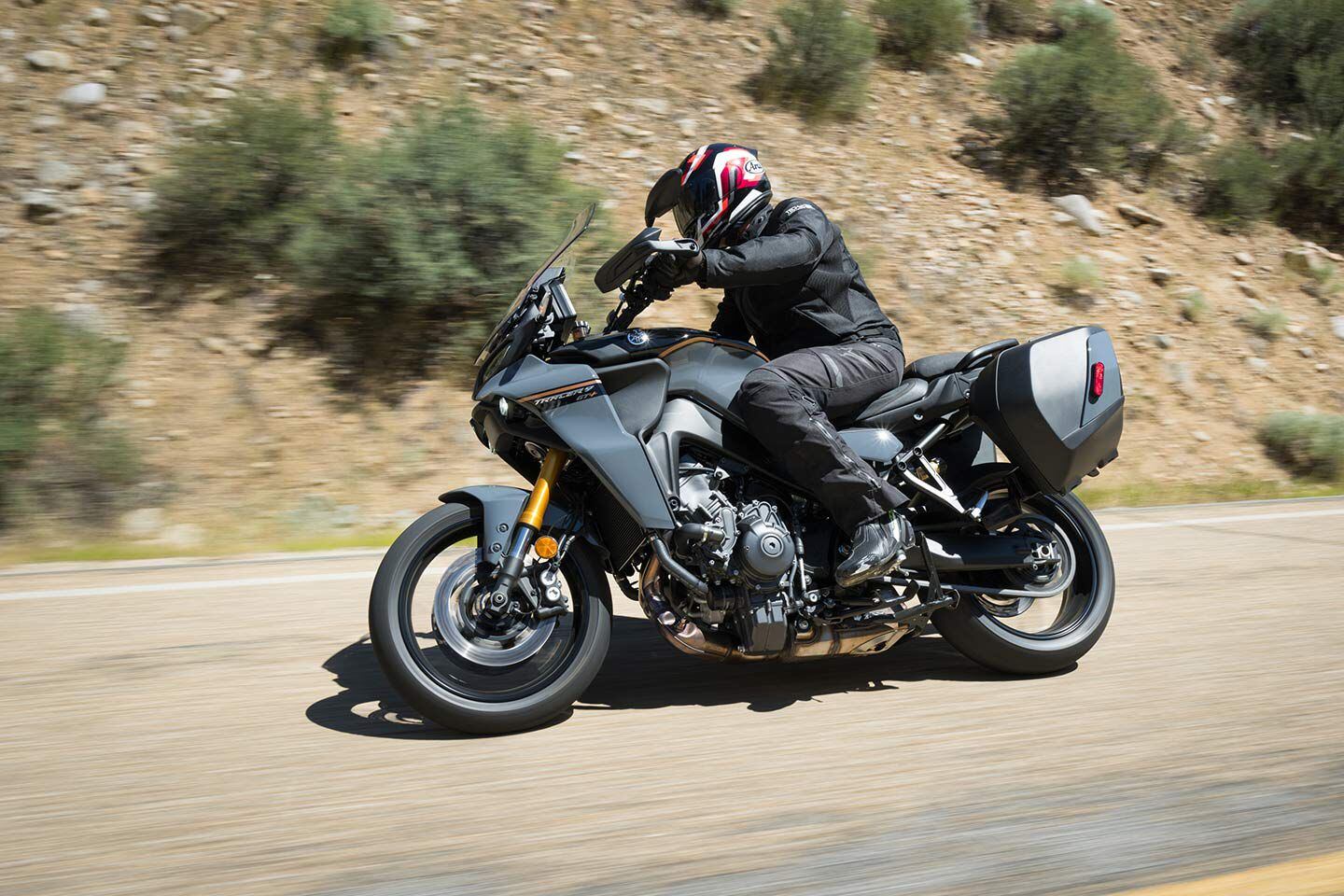
2024 Yamaha Tracer 9 GT+ (Joseph Agustin/)Helmet: Arai Contour-X
Jacket: Alpinestars Tailwind Air
Pant: Alpinestars Monteira Drystar XF
Gloves: Alpinestars Halo Leather
Boots: Alpinestars Supertech R
Airbag: Alpinestars Tech-Air 5 System
-
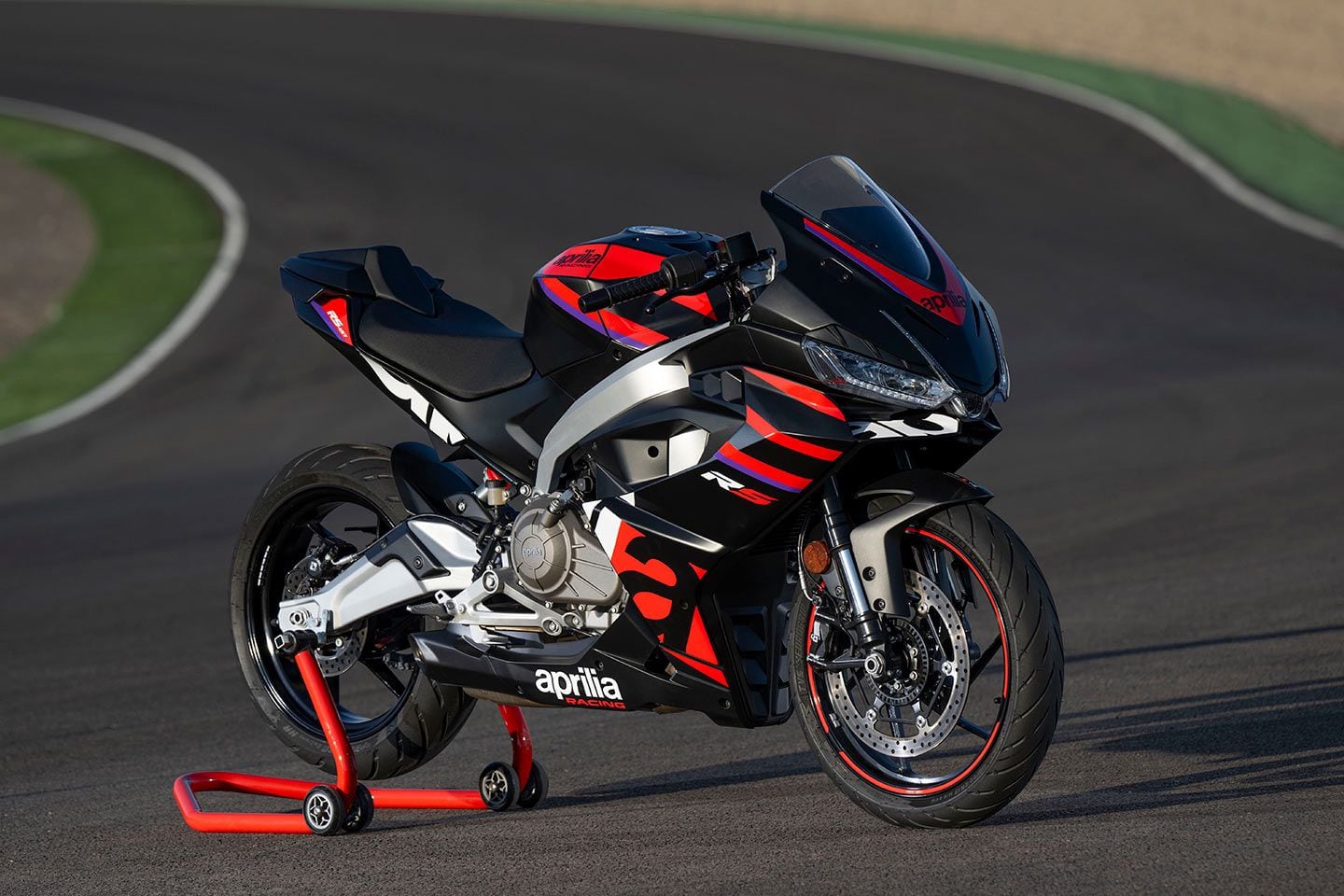
Pricing and availability have not been announced yet for Aprilia’s 2024 RS 457. (Aprilia/)The RS 660 represented a pivotal factor in the evolution of the Aprilia motorcycle. Right now, the RS 660 is the bestselling sportbike in Europe, underlining the very fine balance that the bike incorporates in terms of performance, handling, and styling.
From the original fully dressed sportbike, the RS 660 has grown into a range of three models with the addition of the naked Tuono and of the Tuareg adventure bike. All share the same liquid-cooled DOHC four-valve 660cc parallel twin, properly responding to the expectations of a new generation of motorcycle enthusiasts. Riders who were driven away from the extreme world of high-powered superbikes but still want a lean and aggressive styling, a high level of tech, and manageable power.
Starting with data gathered from the RS 660 experience, Piaggio Group made an analysis of the potential that might hide in the crowd of younger riders, who seem to be more interested in their smartphones than in throwing a leg over the seat of a bike. They took all the ingredients that granted the RS 660 its great success and condensed them into a totally new, slim, and compact sportbike displacing 457cc, aimed at lighting the fire in the guts of a generation that has missed out on the pleasure produced by a sportbike.
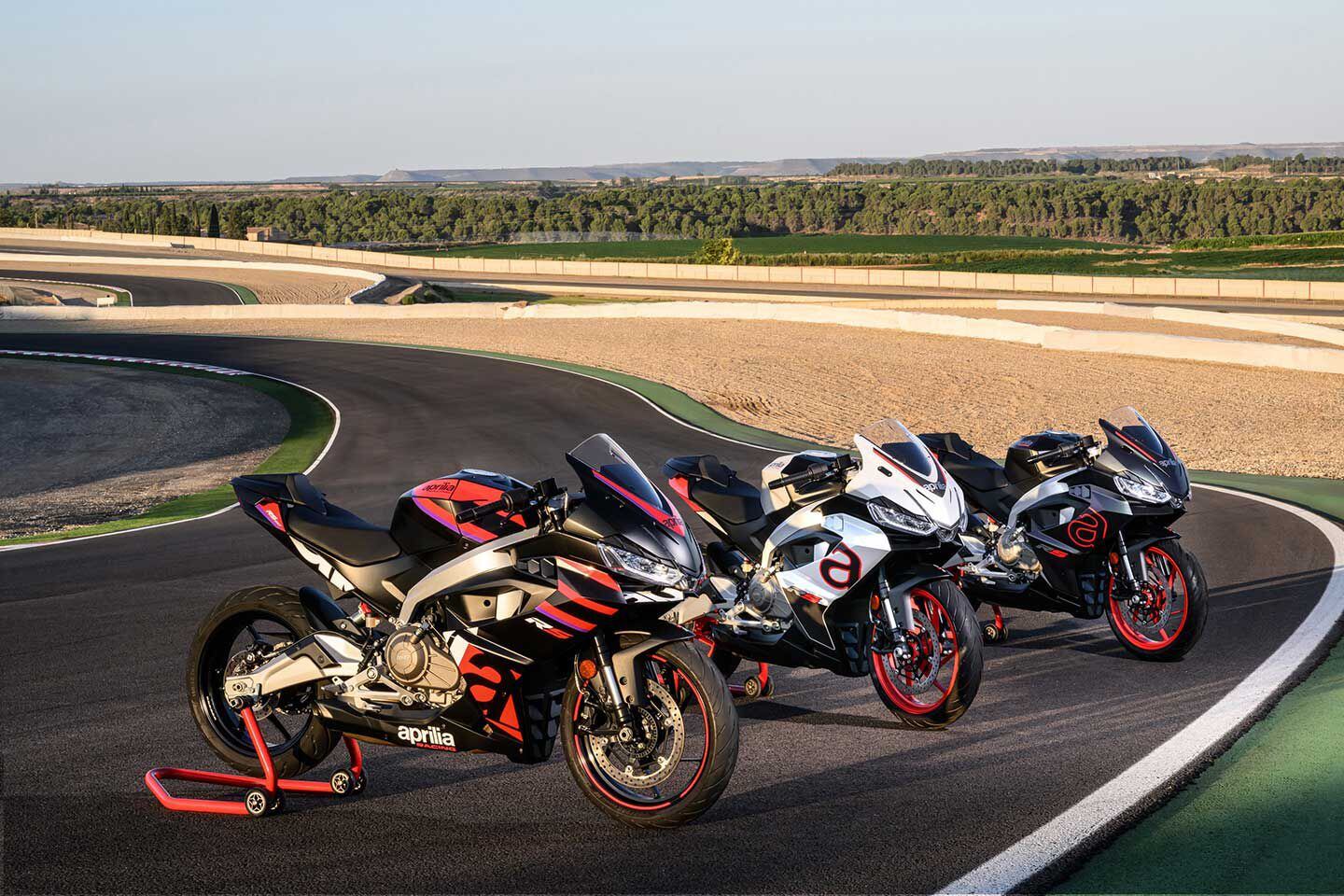
Aprilia’s RS 457 will be available in the three color schemes. (Aprilia/)Daring styling, sporty handling, and ample safety margins promise to make the open road an experience to be remembered. Aprilia’s new RS 457 is totally RS, from the aggressively sleek fairing to the aluminum frame to the liquid-cooled DOHC four-valve parallel twin.
Its claimed 47 hp should be more than adequate to propel the very light RS 457 to a good top speed with excellent acceleration. Thanks to a refined execution, the new RS 457 weighs in at 350 pounds dry and 385 pounds ready to go with a full tank.
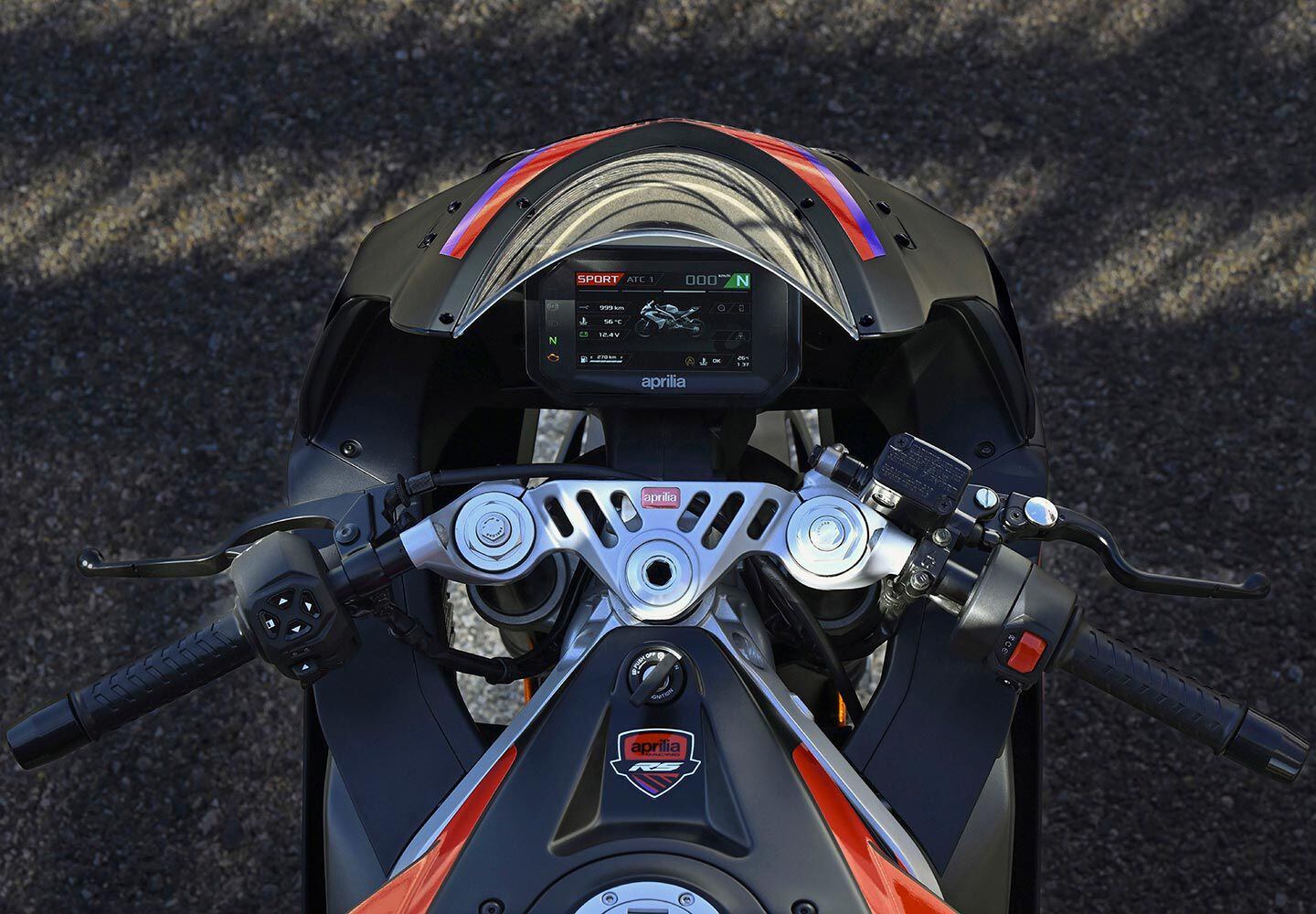
A 5-inch TFT display and backlit handlebar switch gear give big-bike vibes. (Aprilia/)The chassis is based on a state-of-the-art—and unique to the class—aluminum twin-spar frame with the compact parallel twin acting as stressed member for maximum rigidity and minimum weight. Suspension is a 41mm fork and cantilevered rear shock absorber—both adjustable in preload. The front wheel travels through 4.7 inches while the steel rear swingarm has 5.1 inches.
The cast aluminum wheels have a very elegant and light design and are shod by 110/70-17 and 150/60-17 radials. A single 320mm rotor teamed to a radially mounted four-piston caliper, by Brembo, does the front braking duty. At the rear a 220mm rotor is teamed to a floating two-piston caliper. The braking system is controlled by a twin-channel ABS system with two settings: both ends on and front brake only.
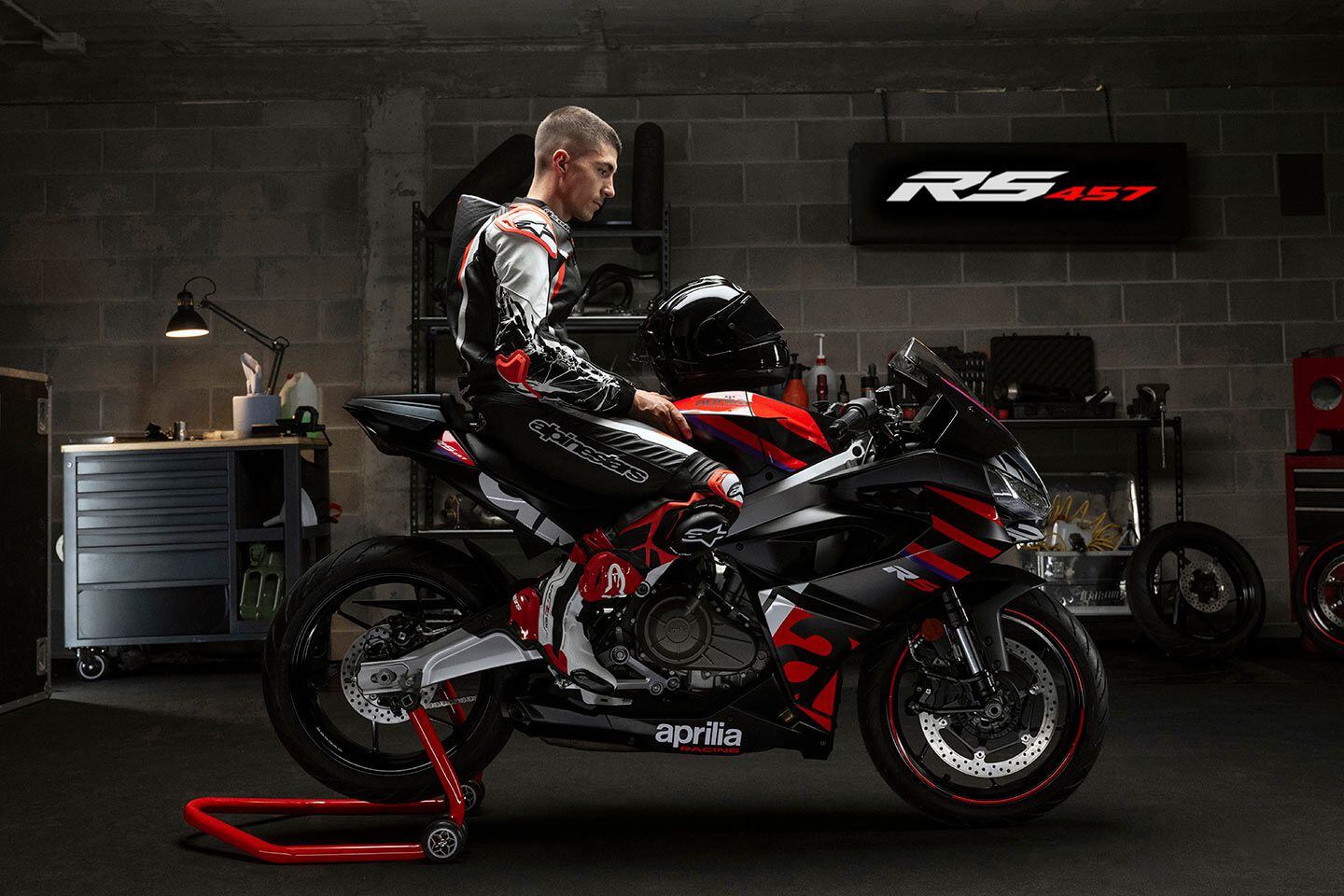
Maverick Viñales helped unveil the bike on the Thursday evening before the Misano round of MotoGP. (Aprilia/)The electronics suite includes a ride-by-wire throttle that offers three riding modes and within that system there are three levels of traction control. A quickshifer is available as an accessory. The instrumentation uses a 5-inch TFT color screen while the entire lighting system is based on LED technology.
Thanks to the engine power limited to 47 hp, the RS 457 can be legally ridden by beginners in Europe and is a sweet spot with enough power to thrill without being overwhelming. This quality should attract more youngsters especially from the vast reserve of enthusiasts in relatively new markets around the world. The great look and sporty allure should light the fire together with a solid overall quality and excellent finishing. Aprilia’s racing image, especially WorldSBK and now in MotoGP, should also attract a new throng of buyers. The RS 457 very appropriately fills an empty spot at the bottom of the lineup, and we look forward to a full on-road and track test in the future.
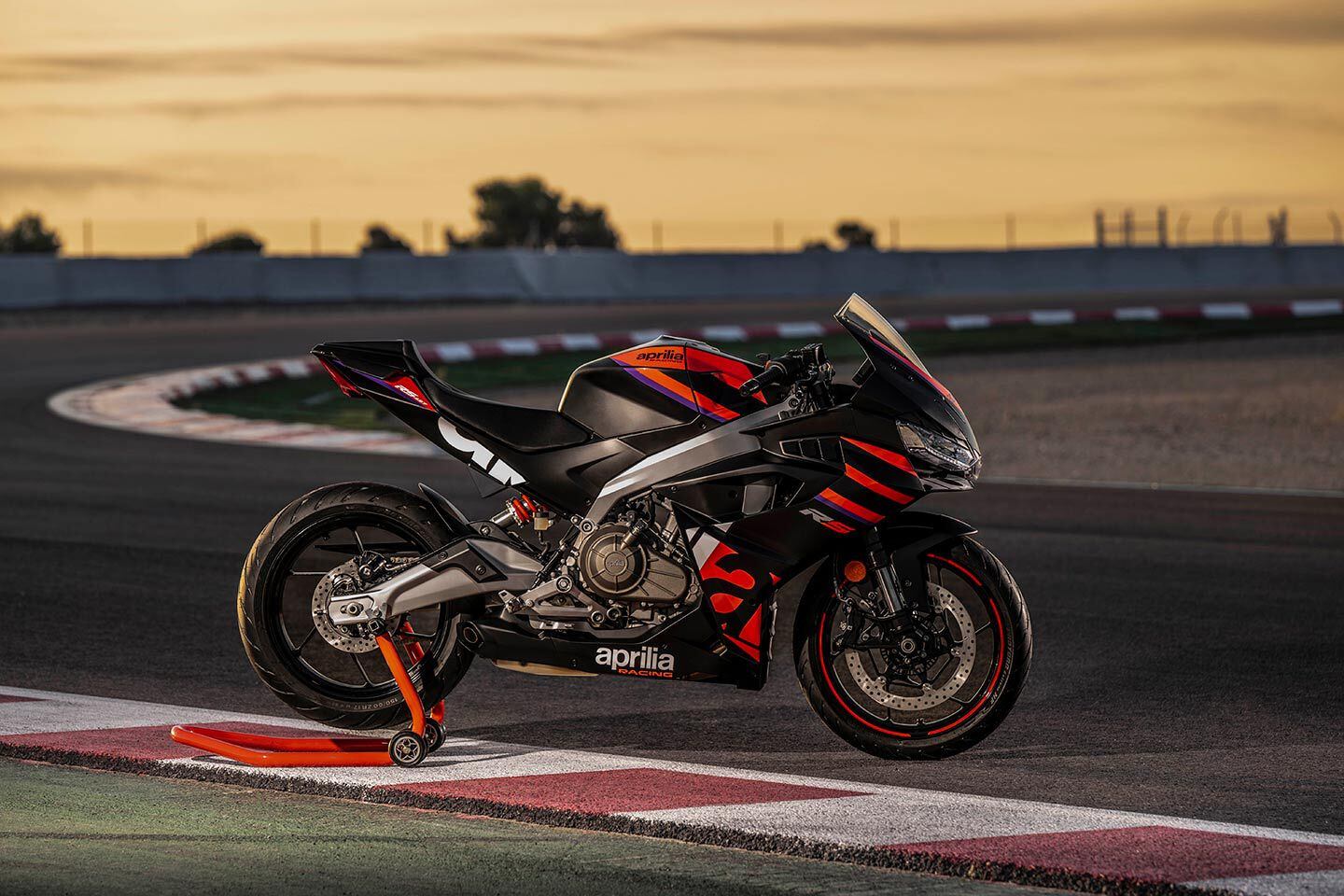
Smaller-displacement bikes have become an important piece of the lineup for manufacturers, and Aprili’s RS 457 has the potential to once again redefine the Italian brand’s sales success. (Aprilia/)Pricing, specifications, and on-sale date have not been announced.

Honda Refreshes CB200X For 2023 Model-Year In India
in Motorbike news
Posted

The small-displacement adventure bike is now OBD-2-compliant, and equipped with a slipper clutch.View the full article